SIMPLE PROFIT
Derek White is achieving top sheep fertility and growth at Waiouru, p40
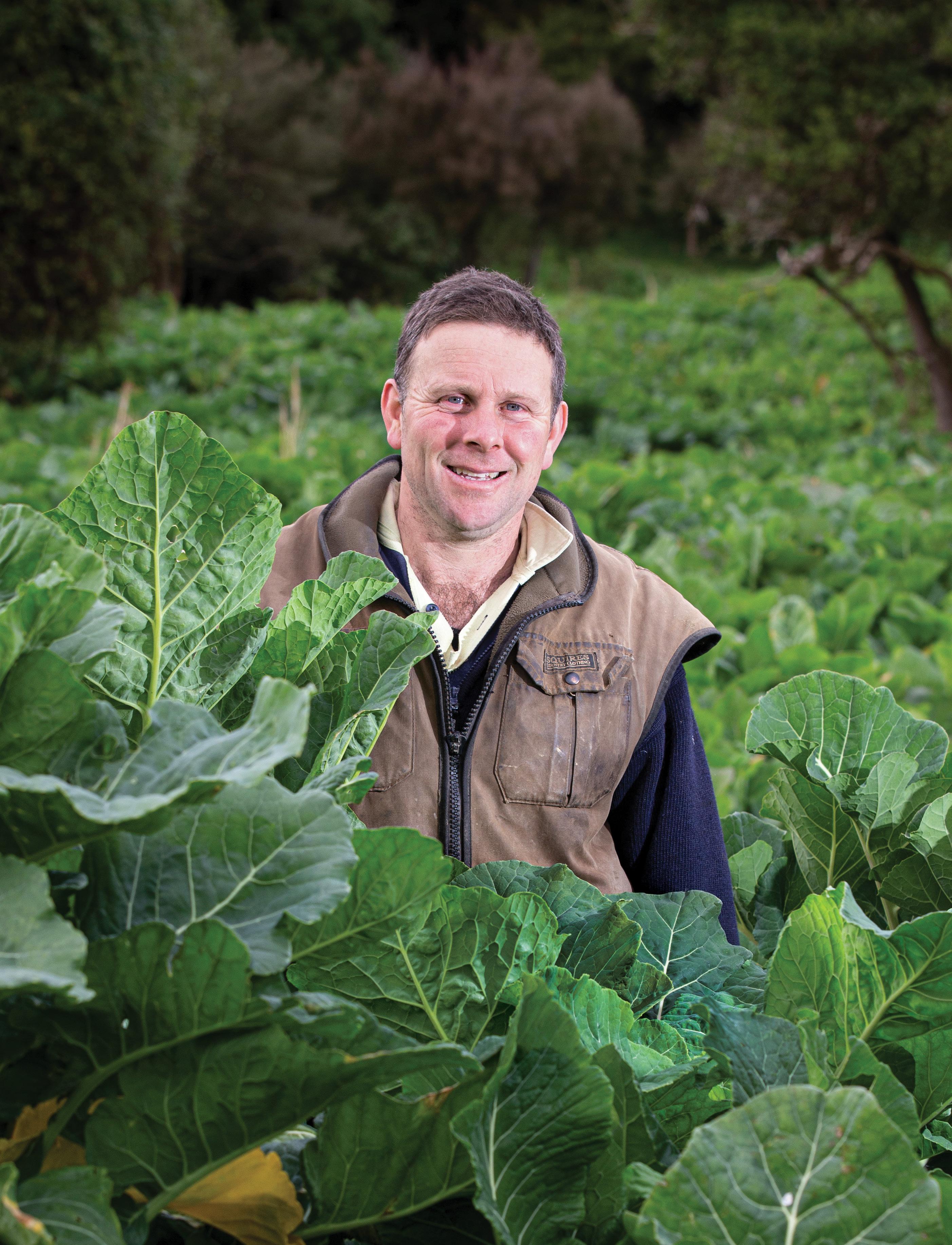
Election: The parties' platforms
Crop & Forage 2023 special
Landcorp: Will it survive after the election?
$12.95 incl gst AUGUST/SEPTEMBER 2023
2 Country-Wide | AUGUST/SEPTEMBER 2023
Every farm is unique, even if they’re neighbours. That’s why you need a vaccination programme that fits your farm’s unique requirements.
Two tried and proven vaccine options for pre-lamb and beyond.
The only specialised 5-in-1 pre-lamb vaccine that provides up to 4 months protection for lambs.


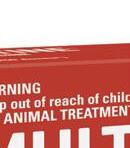


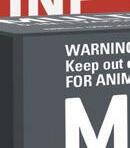


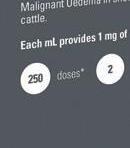



New Zealand’s leading 5-in-1 vaccine range with multiple options for supplementation1.
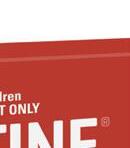

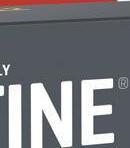
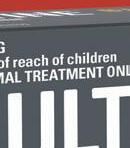








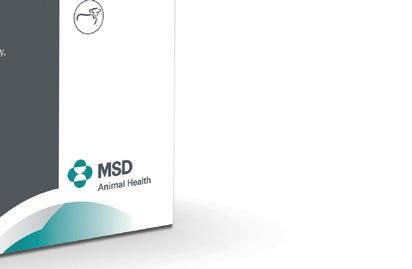



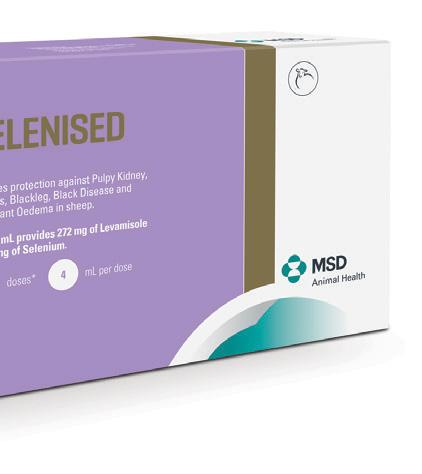
Every sheep farm is unique, so when it comes to vaccination, you need a programme that fi ts your way of getting things done.
NILVAX is the only pre-lamb vaccine that provides up to 4 months protection for lambs. This gives you the flexibility to vaccinate your ewes earlier to avoid sleepy sickness*, or vaccinate your lambs later due to the longer duration of protection provided via their mother’s colostrum. MULTINE gives you multiple options for supplementation of Vitamin B12 or selenium in combination with New Zealand farmers favourite 5-in-1. This means you can get everything you need and nothing you don’t.

NILVAX and MULTINE. Two tried and proven pre-lamb vaccine options made right here in New Zealand, that give you flexibility and effectiveness for your farm.
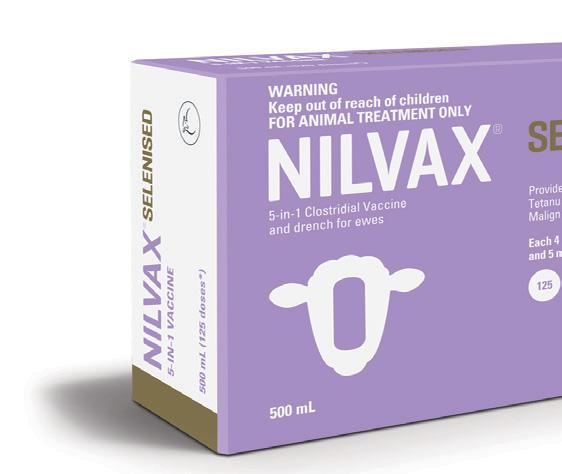
Country-Wide | AUGUST/SEPTEMBER 2023 3 ACVM No’s A3977, A934, A935, A11311, A11766. Schering-Plough Animal Health Ltd. Phone: 0800 800 543. www.msd-animal-health.co.nz NZ-NLV-220400001 © 2023 Intervet International B.V. All Rights Reserved. 1.Baron Audit Data. March 2022. *Vaccinating ewes earlier at pre-lamb helps avoid stress associated with yarding which has been identified as a predisposing factor for sleepy sickness. Beef + Lamb NZ. Metabolic Diseases in Ewes Fact Sheet July 2019. NILVAX®
and MULTINE® .
Never
COUNTRY-WIDE SUBSCRIBER BENEFITS:
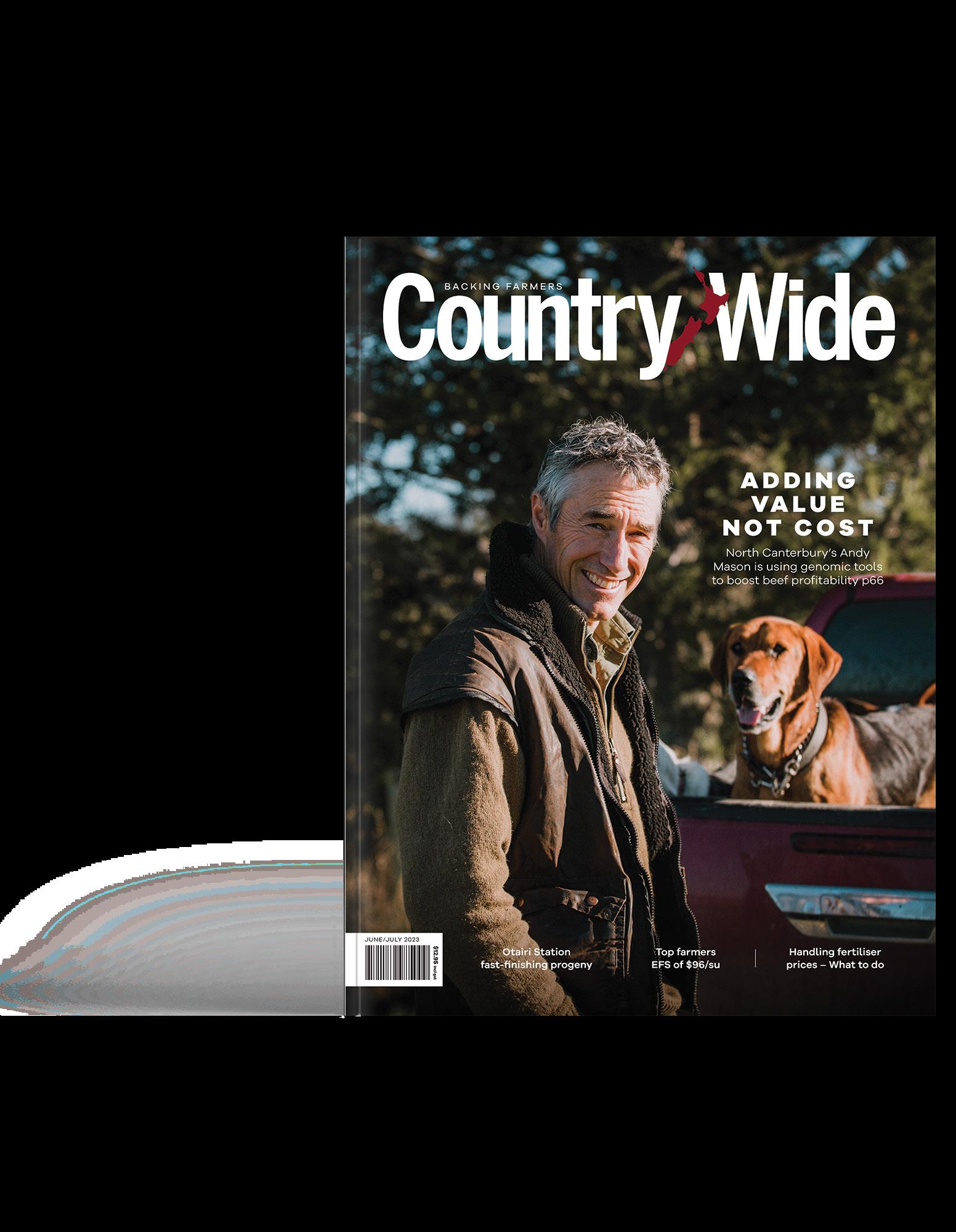
• Choose from print or digital subscription options
• Six issues each year, plus our regular special Beef and Sheep publications
• Subscribers save between 17% and 22% off the cover price, depending on your subscription term

• Share your magazines with team members to grow their knowledge or subscribe them all and each have a copy
• A great reference tool to refer back to time and time again
• Your subscription is a tax deductible farm working expense

• Entry into regular subscriber-only competitions and giveaways


• Access to years of archive content on our website

12 months – $129
24 months – $252
Use RuralcoFarmlandsyouror card to SAVE 10%
782
• www.country-wide.co.nz
0800 224
subs@nzfarmlife.co.nz
DEEPER. BETTER. INDISPENSABLE
miss an issue!
3* and 6-month subscription terms are available, visit our website for details. *credit card payment only
TRANSPARENCY NEEDED
CORRUPTION AND MISMANAGEMENT is more difficult when there is transparency.
Transparency is needed if there is to be accountability.
Back in 2017 Prime Minister Jacinda Arden promised New Zealand’s most open and transparent Government.
What NZ got from the Government over the next six years was the most money spent on communication staff, media minders and spin doctors. A cast of thousands.
Incapable ministers and staff busy trying to hide their mistakes to bury the truth. Journalists have complained how hard it was to get information out of government departments and agencies.
Public servants seem to have been poorly managed by ministers and followed their own agendas. Why else was the environment legislation so anti-farming and unworkable. Hard to believe a minister would have directed that. Or was it just total ignorance of farming and science?
The Greens and Greenpeace have vehemently opposed efficient farming. A conspiracy theorist would say there was an international goal to reduce the world population through malnutrition and starvation.
An impervious bubble seems to have descended upon Wellington that obscures reality. Policy makers are hopelessly out of touch with what people need and want.
Huge sums of money have been wasted on ill-conceived vanity projects and unnecessary reviews. Or necessary reviews poorly carried out like the Resource Management Act (RMA).
The Labour-Greens Government has created a

lot of enemies and it is hard to believe the polls are so close. It is still about three months to the election and the economy is likely to worsen, not improve, so there is likely to be some greater movement in the polls.
I agree with Sir Robert Jones, it will be a landslide victory to National and ACT. Such is the level of frustration and anger that I am hearing from urban and rural contacts, many intend to vote for ACT. Pollster David Farrar is reporting the party has 30% support in some rural areas.
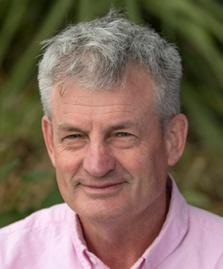
Friends who used to be staunch Labour supporters are lost and not sure who to vote for. They felt let down by the Labour-Greens Government.
Nobody can predict the future but everyone is entitled to a prediction. At the start of the year I predicted to a friend, 38 National, ACT 24. I see no reason to change it.
TERRY BROSNAHAN
terry.brosnahan@nzfarmlife.co.nz
Ph: 03 471 5272
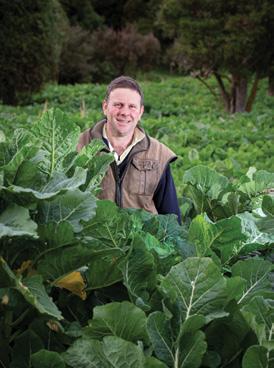
Country-Wide | AUGUST/SEPTEMBER 2023 5 EDITOR'S NOTE
@CountryWideEd
COUNTRY-WIDE SHEEP
SHEEP
COVER PHOTO BY SARAH HORROCKS
NEXT ISSUE:
SPECIAL 2023
CONTENTS
56
WINNING AWARDS
AT WAYTEMORE
Big strides are being made at an integrated sheep and beef farm south of Auckland.
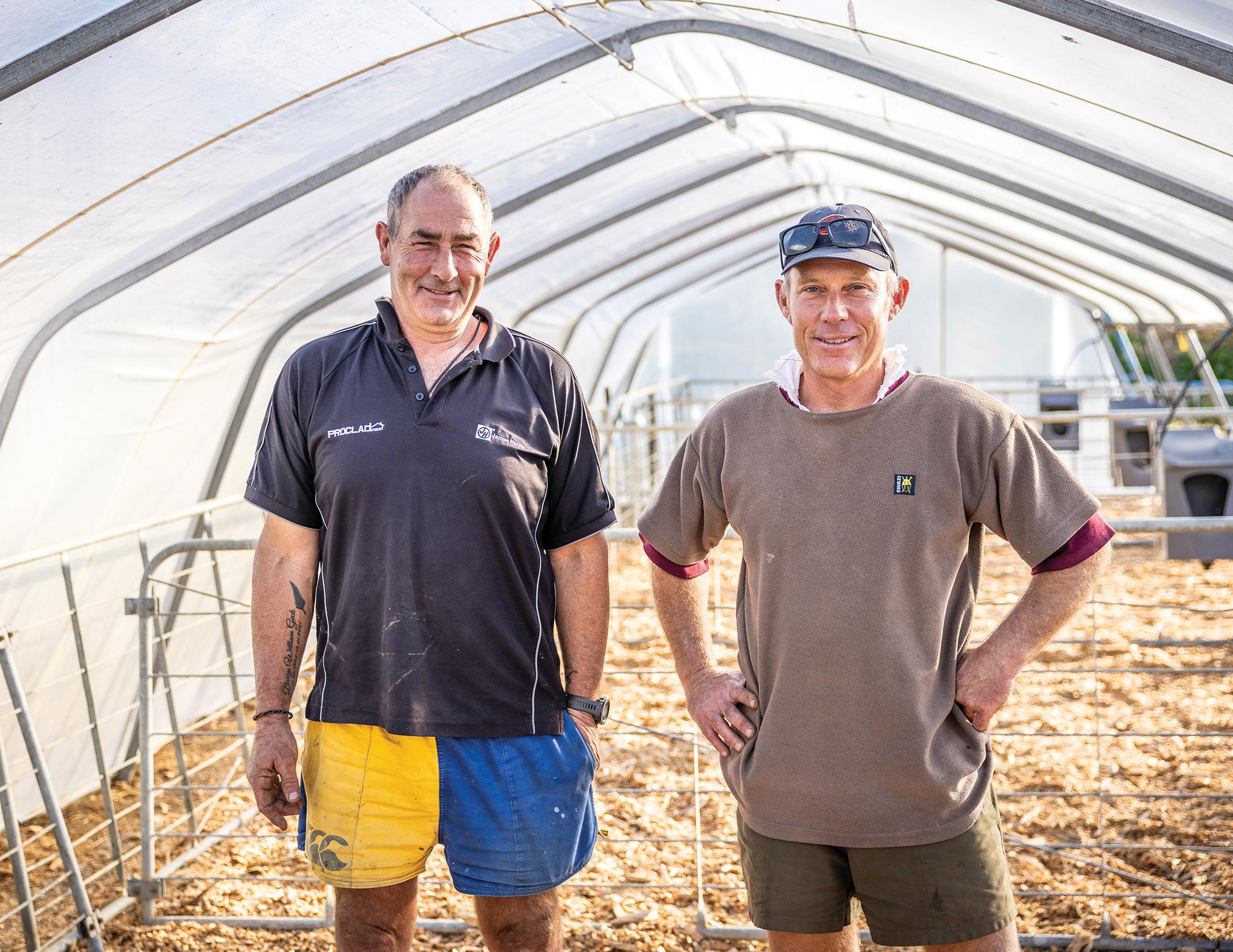
BUSINESS
14 Jo Cuttance reviews the parties election offerings
17 Opinion: Red tide or blue wave?
18 Dennis Wesselbaum: Ambitious growth policy needed after election
22 Derek and Leanne White have a simple system with high profits
24 Increasing productivity without adding costs
FEATURE: LANDCORP
28 The outlook for Landcorp
33 Post-election options
34 Warren Parker defends Landcorp
37 A close look at the SOE's results
LIVESTOCK
40 Top sheep fertility and growth rates at Waiouru
52 Dealing with sick calves
56 Onfarm: Award winners at Waytemore
66 Trevor Cook sees a disconnect between farmers and those making the rules
CROP AND FORAGE
68 Pastoral farmers urged to tread carefully with crops
70 The case for gene editing
78 Realising catch crops’ potential
80 Doug Edmeades charts the rocky road for RPR fertilisers
82 Jacqueline Rowarth: Ignoring science is not worth the risk
86 Pros and cons for integrating livestock and arable production
92 Simon Glennie checks out the cereal game
96 The Taggarts are spreading the risk in North Canterbury
ENVIRONMENT
104 James Hoban summarises recent changes to rules and regs
108 Young farmers want to be part of the solution
GENETICS
112 Coveting intramuscular fat
REGULARS
9 BOUNDARIES
10 HOME BLOCK
27 AUNT THISTLEDOWN
116 SOCIAL
120 SOLUTIONS
122 FARMING IN FOCUS
6 Country-Wide | AUGUST/SEPTEMBER 2023
AUGUST/SEPTEMBER 2023 @COUNTRYWIDENZ
Published by NZ Farm Life Media PO Box 218, Feilding 4740 Toll free 0800 224 782 www.country-wide.co.nz
Editor Terry Brosnahan 03 471 5272 | 027 249 0200 terry.brosnahan@nzfarmlife.co.nz

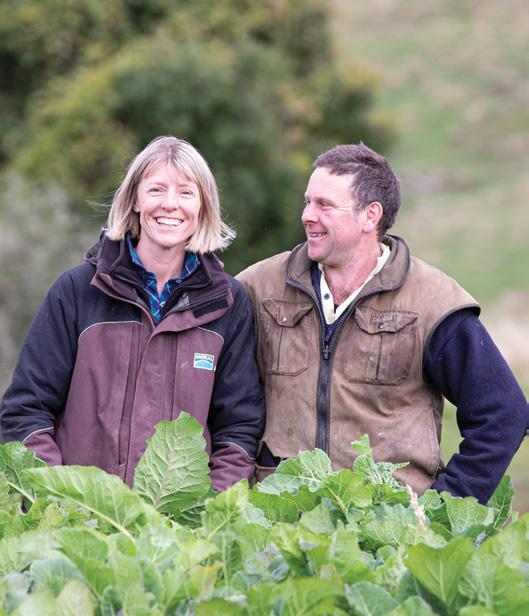
Publisher Tony Leggett 06 280 3162 | 0274 746 093 tony.leggett@nzfarmlife.co.nz
Sub editors Andy Maciver 06 280 3166 andy.maciver@nzfarmlife.co.nz















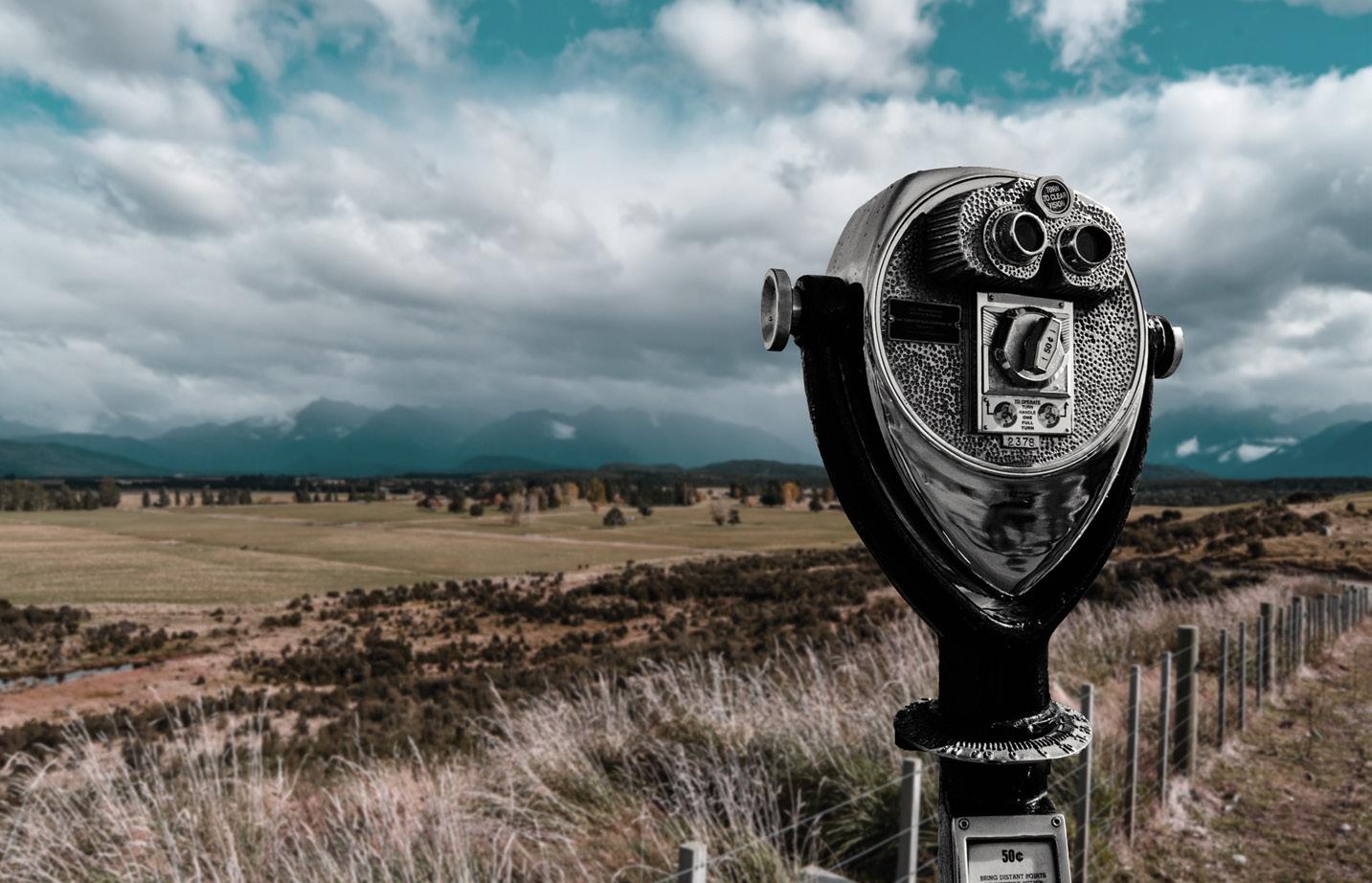
Alison Robertson
Designer Emily Rees 06 280 3167 emily.rees@nzfarmlife.co.nz
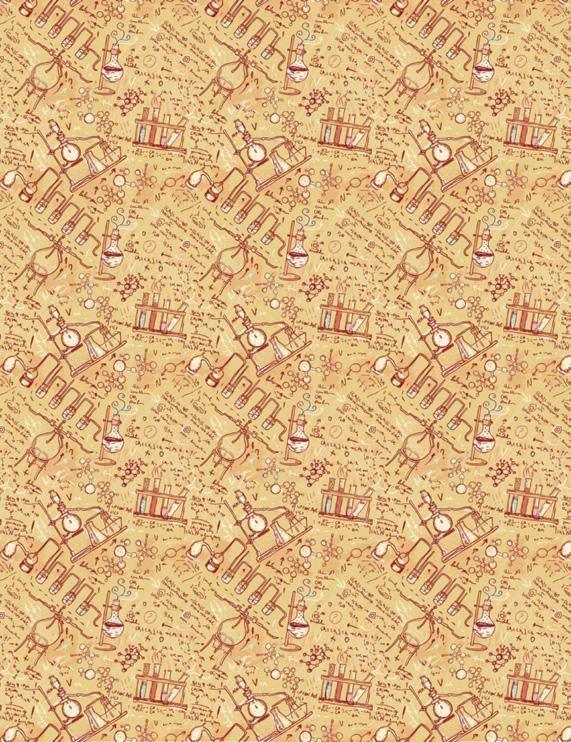

Production
Jo Hannam 06 280 3168

Writers
Anne Hardie 03 540 3635
Sandra Taylor 021 151 8685
James Hoban 027 251 1986







Jo Cuttance 03 976 5599
Joanna Grigg 027 275 4031
Glenys Christian 027 434 7803
Annabelle Latz 027 808 6469
Louise Savage 027 260 2750
Sarah Horrocks 027 555 7941
Partnership Managers
Janine Aish | Auckland, Waikato, BOP 027 890 0015 janine.aish@nzfarmlife.co.nz





Angus Kebbell | South Island, Lower North Island, Livestock 022 052 3268 angus.kebbell@nzfarmlife.co.nz
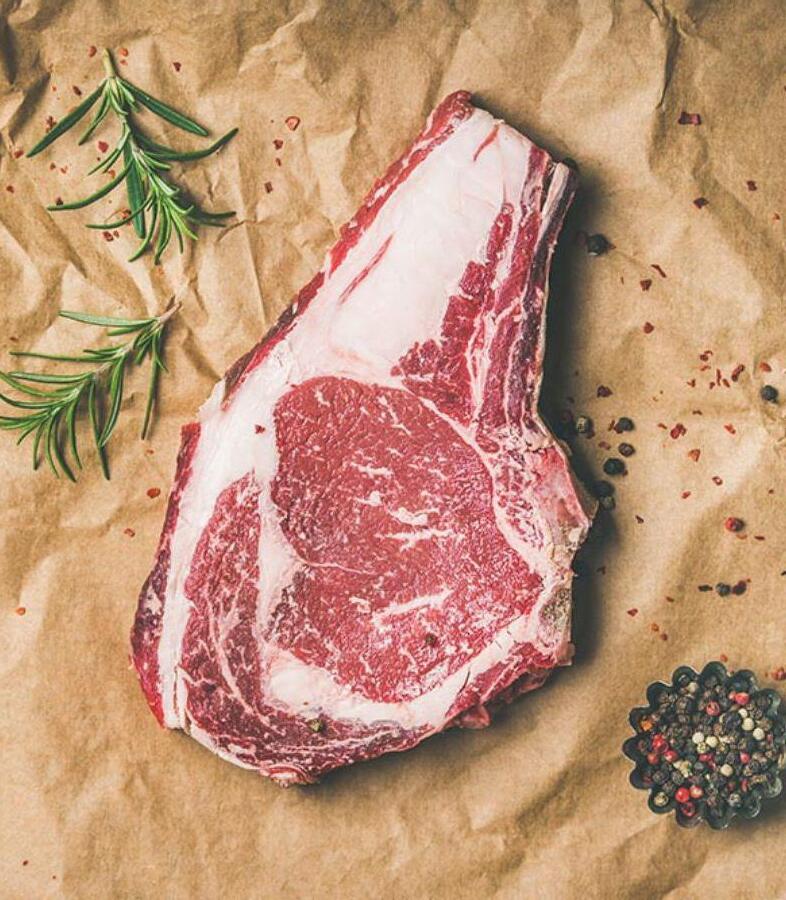
Tony Leggett | International 027 474 6093 tony.leggett@nzfarmlife.co.nz
Subscriptions
country-wide.co.nz/shop 0800 224 782 subs@nzfarmlife.co.nz
Printed by Blue Star, Petone
ISSN 1179-9854 (Print) ISSN 2253-2307 (Online)
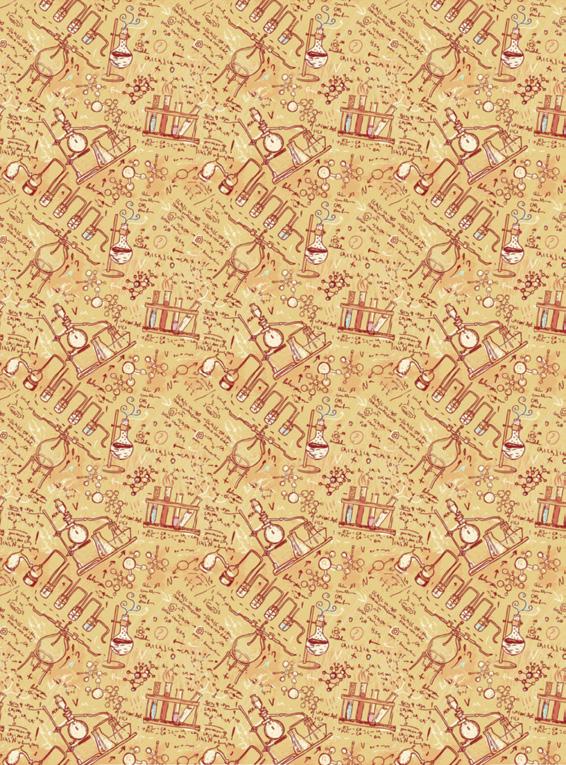

Country-Wide | AUGUST/SEPTEMBER 2023 7 Is there a future in public ownership for Landcorp Farming? 28 THE OUTLOOK FOR LANDCORP 112 Building blocks of IMF 82 Ignoring science is not worth the risk 14 A review of the parties 22 Simple system with high profits
COUNTRY-WIDE.CO.NZ
HEALTH FUELS PERFORMANCE
ROYALCANIN® ENERGY4800

Givethemthefueltheyneedtodotheirjobwell. Withaproteincontentof32%,Energy4800 contributestomaintainingmusclemassaswellas bloodcapacity,todeliveroxygentomusclesand helpsustainactivityoverlongperiodsoftime.
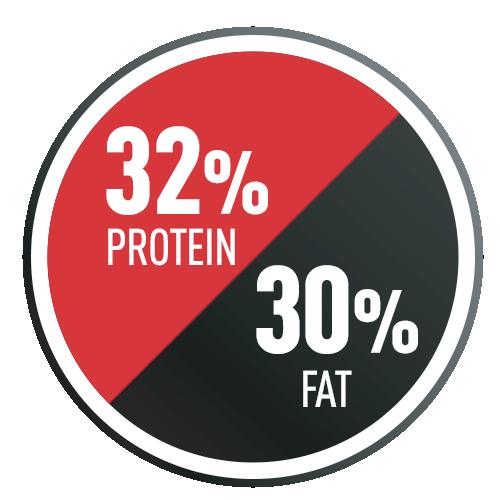
SpeaktoyourvetclinicaboutROYALCANIN® Energy4800.
royalcanin.com/nz

8 Country-Wide | AUGUST/SEPTEMBER 2023 TEAM8358
DID YOU KNOW?
GOOD WORMS
Would you be prepared to have worms if they helped you feel better?
Hookworms could be an exciting new accessory for humans with colitis. Clinical trials by the Malaghan Institute have shown that hookworms may be helpful for managing severe inflammatory and allergic diseases in humans. In the year-long study, half the patients in remission with ulcerative colitis were infected with a controlled dose of hookworm larvae. The other half were given a placebo.
Early 1900 French knife grinders would work on their stomachs in order to save their backs from being hunched all day. They were also encouraged to bring their dogs to work to keep them company and also act as mini heaters by having them rest on their owners’ legs. They were also called ventres jaunes (“yellow bellies” in English) because of the yellow dust that would be released from the grinding wheel.
Results showed hookworms were safe, well tolerated and long lasting for participants with ulcerative colitis. The effect may not be strong enough to push someone from an active disease state into
PLAYGROUND TROUBLES
There may be no better form of birth control than sitting in the principal’s office of my kids’ rural school.
All child-free couples looking doeeyed at toddlers in the supermarket should be plonked straight into a toothless discussion of playground stranglings. “Bullying”, “naughty” and “punishment” are all swear words.
Students are more likely to leave the classroom with a diagnosis than any semblance of an education.
Kids running away from the grounds or being misplaced on school trips are just another Tuesday.
The board of trustees and school staff are drinking buddies, so complaints are merely shrugged off. The eye of Sauron could emerge on the school field and the real issue would be that parents need to ease up.
After all, no one works harder than a school teacher working 4.5 hours a day.
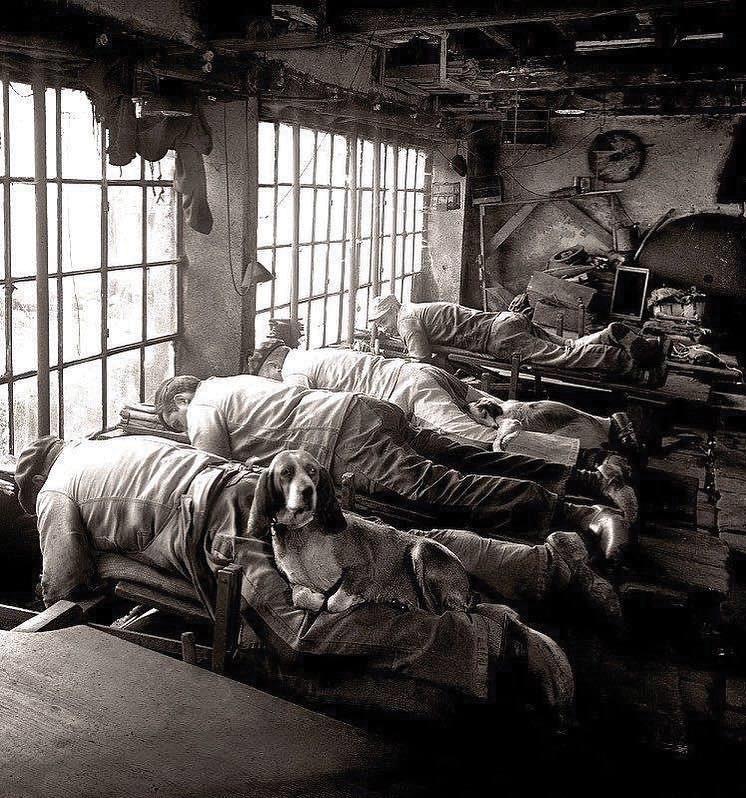
Does anybody know where we can find a school where learning, manners and child safety aren’t optional?
Hookworms can remain in the body for years following a single dose. There is a thriving ‘underground’ market of people selfmedicating with hookworms.
JOKE

A man goes to a circus. After the show he speaks to the manager and asks for a job.
"Alright, what can you do?", the manager asks.
"I can do great bird impressions", the man replies.
"Ha, a lot of people can do that", says the manager.
"Oh well", the man says, and flies away.
NEW PODCAST SEASON 2
Young Country is pleased to announce the second season of From the Ground Up Podcast, now called Down to Earth. Listen to Down to Earth at youngcountry.co.nz

Country-Wide | AUGUST/SEPTEMBER 2023 9
BOUNDARIES
Focusing on the positive
and generally less satisfied by what we are doing on our farms. The alternative is to make a decision to be relentlessly positive and to focus on what is good.
but Anthony reassures me that this must be what taking the next step feels like. Uncomfortable. It is great talking to some of the older folk out there who have made their move before and have come out the other side. These guys who have taken risks and been rewarded are positive about the future. I have been told by a number of them that it is often good to make a move when the economy and sentiment are a bit ugly. I guess for us, time will tell on that one.
THE PURPOSE OF THE RBNZ in hiking rates is to stop us from spending, but to do that the bank needs to make us all feel sad and gloomy so we put our wallets away. I get it, we need to get inflation under control. We have reined in our spending where we can (while actually spending more because our interest rates have gone up), but I refuse to be made to feel gloomy because of an ‘engineered recession’. Mainly because I am stubborn, if someone is trying to make me feel something, then like a teenager, I want to do the opposite. But also, in my view, the fundamentals are good – this is the RBNZ taking a shorter-term position to get the place under control before easing begins and we can get on with it.
What is the point in buying into the doom and gloom that seems to be so easy to come by at the moment? It will surely just lead to feeling less in control of our own futures, less motivated,
We have just bought two-thirds of the neighbouring farm, and it’s been a lesson for me that there is only one way to approach this in a time like 2023. We are attacking it. I’m imagining the All Blacks turning up for the job feeling sad and grumpy about life and guessing the result wouldn’t be what they hoped for. We’re taking the same approach when thinking about our new position.
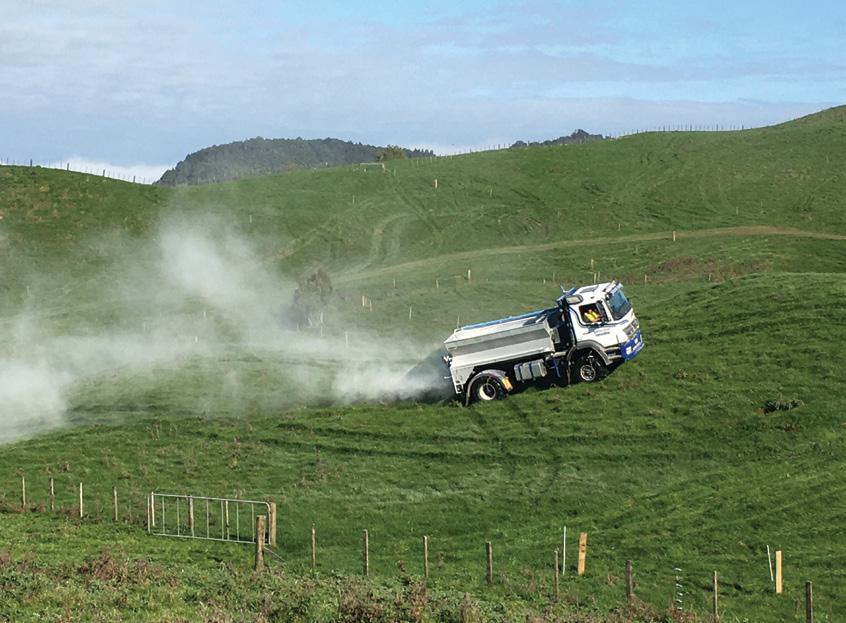
But in the meantime – over the next two years – I accept things are going to be tough. To maintain my position of relentless positivity, I will have to consciously choose what I do and filter out what deflates me. I won’t be watching much of the news or following the election too closely. I will cast my vote though.
If we focus too much on the interest rates and the softening lamb prices, we will take our eye off the ball. The rules of the game are to take a long-term approach: to focus strongly on the future; to innovate and try new stuff; and to relentlessly work for a farm system that is profitable and one consumers will pay for.
Occasionally I falter in my approach and begin to question,

I’ll be spending time with my kids, watching their sports, cosying up on the couch to watch a movie. I’ll be keeping close to our budget and constantly tinkering to ensure we have a farm system that works and that we continue to be on the same page as our bank. We will continue to invest in areas that improve production, like subdivision and fertiliser. And I will surround myself with others who are confident they can meet the challenges in front of us and come out stronger on the other side.
Producing food continues to be (mostly) enjoyable and satisfying work for us. Economist Cameron Bagrie has been recently quoted saying, “I can tell you, I would rather be a farmer in the next two years than an Auckland property developer.” It is a helpful quote to keep a bit of perspective in the current environment.

10 Country-Wide | AUGUST/SEPTEMBER 2023
Some might say she’s mad, buying more land as we’re all being told to tighten our belts, but Dani Darke is refusing to be ground down in these tough economic times.
HOME
BLOCK
“If we focus too much on the interest rates and the softening lamb prices, we will take our eye off the ball.”
Aria
TO ALL THOSE FARMERS and growers feeling put upon and undervalued, consider for a moment the gift that your profession has given humanity. By providing food in quantity you have given the bulk of the population time to indulge in other lives.
For the majority of our time on earth, humans have had to spend their waking hours struggling to find enough nourishment to survive and many didn’t. Modern agriculture changed that and most people take for granted that as long as they have cash in hand there will be food available in exchange. This situation gives them time to pursue other careers, further their education, live in cities, form institutions, indulge in culture and leisure, even have holidays. This process is the rise of modern civilisation and food security is at its heart. But, this enlightened way of living is starting to nibble at the hand that feeds it.
Generally, people who work the land are practical, sum it up, get it done sort of people.
If we didn’t have the ability to prioritise we wouldn’t survive because the nature of our business is compromise. Food cannot be produced without affecting the environment but mitigating those effects should not be solely the producers cost. This point might be easier to get across if hunger was once again to become a normal part of our lives. Or, we had the leverage of operating in the same “cost plus” paradise as oil companies do.
Start with education

A disturbing statistic was published in March this year. An opinion poll asked voters what their most pressing issues were.
Fifty percent said the cost of living, 14% said the climate crisis, 12% cited the ailing health system and 4% were worried about our degraded education system. If we trust the figures, it’s alarming as to why education is not at the top of the list.
implement meaningful change. Perhaps that is why SMEs (Farms included) are usually productive and successful. Money is often tight and cunning plans have to be developed to achieve the desired outcome in the most efficient way. But results are tangible and systems can be seen to be working, or not. Paperwork is minimised and wastage is recognised. Outcomes are monitored and dead ends (I believe they are now termed rabbit holes ) are quickly sealed. The hours are long, there is skin in the game and failure is personal.
Empowering individuals with education is the start to breaking the cycles that plague welfare, law and order and low productivity. The misconception from those who control the nations’ budgets is that money in ever increasing amounts is the cure all. There is plenty of evidence to show that money without competent management only grows the problem. Most public projects are surrounded in so much theory, regulation and analysis there are not enough resources left to
These people who I’ve grown up amongst, worked with and whose company I’ve enjoyed all these years seem to have a wider perspective than many trapped in the 9 to 5 world. In the country you rarely detect envy of other peoples’ lifestyles.
There is very little “old money” in New Zealand and anyone who has operated a business (including the failed ones) appreciates the skill, effort and sacrifice required to attain that much talked about “wealthy” status. If, as a society we don’t start accepting the restraints of compromise and priority there will be no surpluses to benefit the underprivileged. The gogetters will go somewhere else and it’s hard to get a job from a poor man.


Country-Wide | AUGUST/SEPTEMBER 2023 11
Rather than focus on money, NZ should be focusing on education to resolve society’s ills, Paul Burt writes.
Hard to get a job from a poor man
“Empowering individuals with education is the start to breaking the cycles that plague welfare, law and order and low productivity.”
Matata
Quiet on farm, frantic at finals
Hemp product marketing

and
home
farm maintenance kept Blair Drysdale busy on his Balfour farm this winter, and then came the Young Farmer finals.

hoggets and 105 dairy heifers here grazing, along with 200 of our own breeding ewes all of which are on four-day breaks. Otherwise its maintenance of machinery, fencing and a few ongoing projects in the workshop. But by winter’s end I will have taken between 20 and 25 plane flights both here and abroad with our Hopefield Hemp business, speaking engagements, awards evenings, some personal development with the Rabobank EDP in Australia and a family holiday in Fiji. So still enough to keep us out of trouble and off the streets of Balfour.
IT’S FAIR TO SAY THAT THIS winter has been just as confusing and chaotic as the politics of this country right now.
May was one hell of a wet month here with nearly 200mm of rain, which was great if you were a duck, but not for the livestock. Thankfully it was also a very mild month, which was great for late growth of both pasture and winter feed crops. Traditionally June is one of our wetter months, but so far this year it’s been our driest and coldest, with frosts 20 days out of 30 – not seen here since I was a kid. As I write this it’s July 16 and it’s been so mild, spring-like, and the grass is back growing again. So, it’s been a strange winter so far.
I’m not overly busy on the farm during winter and neither do I want to be when the other nine months are spent running around like a chook with its head cut off as I try to keep on top of everything. There are only 600
Our son Fletcher and his teammates from Northern Southland College made it through to the Young Farmer Of The Year finals for the Agrikids section in Timaru. They didn’t win any gongs but did very well overall. It was a great experience for them and all the other teams to get a taste at an early age of what the competition is all about.
give up won the overall title. A huge congratulations to Emma Poole not only for winning, but also for being the first woman to do so. She gave one of the best acceptance speeches I’ve heard for the competition. Her brother and prior winner Tim Dangen also gave a good speech before handing over the cloak of knowledge. A great message of positivity and progress in farming for this country.
It was so good to see all three levels of the competition in action, with the agri-sports being the last event on the Friday so that everyone could watch. What a showcase of fierce competition, fortitude, skill, practical ability it was.
It was fitting that the person who showed the most willpower and a strength of mind to never
Farming and food production have a very bright future ahead. There’s an ever-growing number of mouths to feed with a global population of eight billion people predicted to hit 10 billion by 2050. But not if we have another three years of a government pushing more regulation upon us: a government hell-bent on dividing the nation, that puts gangs before potholes, has both education and health systems in total disarray, and wants to tax its way to prosperity.
The only thing the Labour party is in it for is itself and that must be changed come October. Otherwise the exodus of talent will grow even bigger at an alarming rate and the deficit of skill sets in New Zealand will worsen.

12 Country-Wide | AUGUST/SEPTEMBER 2023
HOME BLOCK
“Farming and food production have a very bright future ahead. There’s an ever-growing number of mouths to feed with a global population of eight billion people predicted to hit 10 billion by 2050...”
Balfour
Sugar beet a winner
that we’ve had sugar beet in the rotation, after I decided that the combination of low prices and high soil damage was not worth it. But the price of a tonne of beet has gone up from roughly £20 (NZ$41) when we last grew it, to £40 (NZ$82) now. Obviously this has to be balanced with the value of everything else we grow, but it seemed worth a try.

IT’S BEEN A FUNNY SEASON
– as every year seems to be – but overall a good one. Autumn and winter saw very, very slow growth on all the crops, probably due to a combination of very dry conditions at planting, and then cold damp weather over winter. We also had a huge freeze, about minus 15C, for several nights, which managed to kill off some of our winter bean crop. This is highly unusual, and hopefully does not become the norm. Not only was it bad for the crops, it also froze the water supply to several of the farm houses and buildings for about a week – not fun.
There was a very nice change in the spring, however, as for the first time since 2018, we actually had some rain. The end of March and all of April was pretty wet, and we just managed to get our sugar beet planted before the supposed cut-off date of April 14, although conditions at drilling were not ideal.
This is the first year since 2018

At the last moment British Sugar decided it was very keen to open its factory early, so we were offered a novel contract for a second field for September harvest (usually the factory is not opened until October) with a fixed price a hectare rather than a tonne (t). This will hopefully allow us to plant a real crop of first wheat behind the sugar beet without damaging the soil structure too much in the meantime.
Following the damp April, we then had a very wet start to May, with 75mm in the first 10 days. This was incredibly gratefully received, as it’s a key growing time for the crop, and we have become used to not getting any rain at all in this period. The bad news was that there was no more rain at all for the next six weeks, but at least relatively cool temperatures meant crops held on for that little bit longer. More rain did come in the
second half of June, but it remains to be seen how effective that was. As I sit here now, we have already harvested 80% of our winter barley crop, and it has given me something that I’m not used to – a great start to harvest. The first field yielded 9.61t/ha, and the second looks on course to hopefully break into double figures. If this does happen, we will set a new farm record for both average yield and single-field yield. It would be great if barley was actually worth something; at the moment it’s trading at £140/t (NZ$289), roughly a £50 (NZ$103) discount to wheat. Last time I grew winter barley it was a malting variety, and it seems I made a mistake in not doing the same this time around. Although the yields you’d expect are about 10–20% less, it also costs less to grow, and this year it is worth about £100/t (NZ$206) more than feed. Ouch!
We only had barley this year because I considered conditions were too dry to plant oilseed rape (OSR) last August, and that decision seems to have been well vindicated. OSR crops in the area either haven’t made it to harvest or look poor. We’re planning to try planting rapeseed this year though, and I have lined up the cards in the best way I know how: The barley straw will be baled, the fields will get a dose of digested sewage, and there’s plenty of time to get planted in the optimum window at the beginning of August. If that doesn’t work, nothing will!
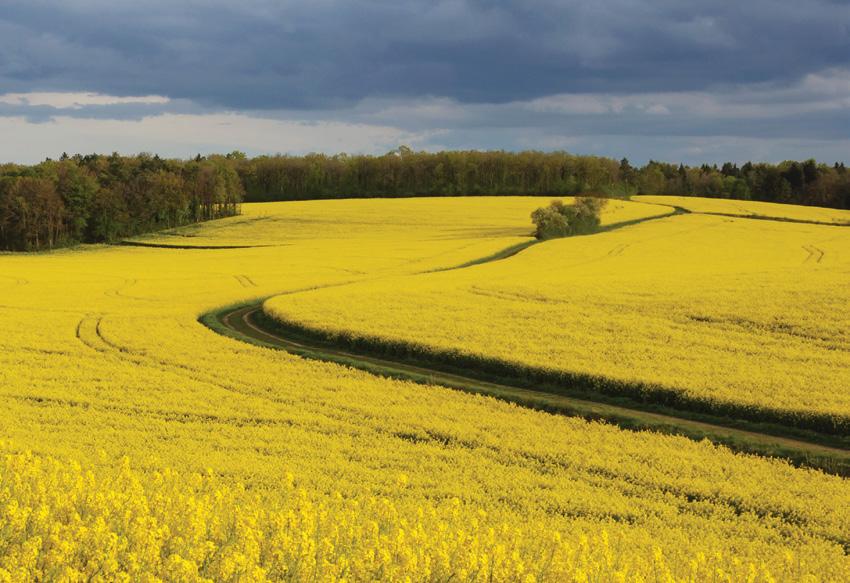
Country-Wide | AUGUST/SEPTEMBER 2023 13
David Walston writes from the UK where weather and pricing
are
dictating his planting schedule.
“...and there’s plenty of time to get planted in the optimum window at the beginning of August. If that doesn’t work, nothing will!”
Cambridgeshire, England







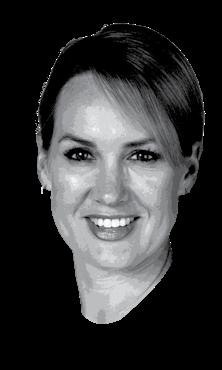

































Election promises and CVs
As the election nears, political parties are releasing their policies. Jo Cuttance looks at what the various parties are proposing for the agriculture sector – policies that will all have an impact on individual farming businesses and the entire sector.
Getting back to Farming’, is the tagline for the National Party’s agricultural policies. National wants farmers to reduce agricultural emissions by embracing technology rather than by reducing production. This involves removing the ban on gene technology so scientists can develop gene-edited crops, feed and livestock. It will also update biotech rules. National will recognise on-farm sequestration and measure farm-level emissions by 2025. An independent board will be established to implement the pricing system.
National plans to limit the conversion of productive farmland to forestry for carbon farming purposes and ban foreign farm-to-forest conversions for carbon farming. For the next three years, for every new agriculture regulation National introduces, two regulations must be removed. New
rules will be assessed for their costs to farmers. The party wants to establish a rural regulation review panel to consider all regulations affecting farmers. National wants to raise the Recognised Seasonal Employer (RSE) worker cap from 19,000 to 38,000 and create a path to residency. It plans to replace the ‘one-size-fits-all’ rules with local decision making and to focus on environmental protection of areas of high environmental value, along with improving stock exclusion rules.
The Green Party wants to regulate agricultural production by significantly reducing livestock numbers and reducing the proportion of land used for livestock. The Greens want regenerative practices in all areas of land use and food production and want to phase out synthetic nitrogen fertilisers, palm kernel expeller and other animal feeds. The party wants to incorporate soil
carbon, the health of biological soil systems and soil water within climate change response frameworks. They want to prohibit new factory farms, and phase out existing factory farming of animals, including feedlots, as well as limit the permissible journey length for transporting live farm animals.

‘Standing Up for Rural New Zealand’ is the catchphrase for the ACT Party. ACT wants split gas reporting tied to any emissions pricing to New Zealand’s five main trading partners. It wants farmers to be able to offset all on-farm sequestration from their emissions’ liability and be able to access emissionreducing technology. ACT also wants environmental standards to be based on science, to liberalise water storage requirements for farmers and for control of water resources to be with regional and local councils.
ACT wants the responsibility of
Country-Wide | AUGUST/SEPTEMBER 2023 15
2023 BUSINESS ELECTION 2023 ‘
managing, regulation, and verifying farm plans to be with regional councils or an approved third party. If farm plans are compliant, with no significant changes occurring on a property or within a specific period, no verification would be necessary. The party wants farm plans to have a consistent template, and existing plans, such as those provided by processors or industry bodies, could still be used. It wants regional councils to monitor environmental impacts of farming and stipulate that a decline in environmental standards must be detected before action is taken.
ACT would allow live animal exports and appoint people with practical animal handling and farming experience to the National Animal Welfare Advisory Committee. It wants to scrap significant natural areas and create a fund to support local government and communities protecting biodiversity. ACT would remove the cap on RSEs and simplify the accredited employer work visa scheme. It would repeal the ute tax, the six elements of the Arms Legislation Act, and introduce a new bill to replace the Arms Act 1983.
In its freshwater policy, Te Pati Maori wants to overturn the Crown’s position that
‘everyone owns water’ to a position that acknowledges Maori proprietary, customary and decision-making rights and interests to freshwater. The Maori Party wants to develop a policy for how Maori rights and interests are implemented in freshwater management and allocation and also wants significant reform of the Resource Management Act to ensure Maori rights and interests in water are addressed.
Labour has introduced a raft of changes affecting the agricultural sector. These include banning live animal exports, introducing Green party leader James Shaw’s Significant Natural Areas policy, bringing in a ute tax, and the introduction of the 2020 Arms Legislation Act. For immigration, Labour has the new residency scheme ‘Green List’ and is planning to introduce the accredited employer work visa scheme. There is also the proposed He Waka Eke Noa, the resource management reform and the Natural and Built Environment Bill, along with a new freshwater farm plan. Labour has also looked to centralise control of water resources through Three Waters and the Natural Environmental Standards regulations.

Who’s who for agriculture
Those wanting to take over leadership of the agriculture sector after the election have varied backgrounds. The National Party’s
agricultural team is made up of Rotorua MP Todd McClay, Southland MP Joseph Mooney, and Selwyn MP Nicola Grigg. McClay is in his fifth term as an MP, was Minister of Trade from 2015–17 and Minister of Revenue 2013–2015. McClay brought the bill before Parliament to prohibit the display of gang insignia in all government premises, schools and hospitals, which became law. Prior to NZ politics McClay was a diplomat and the Cook Islands and Niue ambassador to the European Union.
Mooney is a senior trial lawyer and in 2017 was appointed to the Crown Prosecution Panel for the Invercargill Crown Solicitor. He has also been appointed by the Court as a youth advocate.
Prior to politics Grigg worked as a radio journalist and was press secretary to former National Party leaders Sir Bill English and Simon Bridges.
The ACT Party’s rural team is list MPs Mark Cameron and Nicole McKee, plus Andrew Hoggard. Cameron and Hoggard are both dairy farmers. Hoggard, a Massey University graduate in agricultural economics, stepped down as Federated Farmers president to represent the ACT party in this year’s election.
McKee has worked in various positions within the firearms industry, including five years as a self-employed firearms safety consultant. She has also worked as a senior legal secretary. Agricultural spokesperson for the Green Party is list MP Teanau Tuiono. He has a BA in Maori Studies and a law degree, though he chose not to be admitted to the Bar. In Pasifika communities Tuiono is involved in education and climate-change advocacy, while in Maori communities he is known for his indigenous rights activism.
16 Country-Wide | AUGUST/SEPTEMBER 2023
‘New rules will be assessed for their costs to farmers.’ – National
Red tide or blue wave?
BY MARK CHAMBERLAIN
Lately I’ve been asking “how did we get here, as a country?”
Scratch beneath the surface of this Labour-led government and you'll find little substance. Look past the empathetic head tilt, accompanied by never-ending opportunist hugs. Previous occupations of Members of Parliament in the Government consist of clusters of union activists, teachers and eek… academics.
Our previous prime minister's only real-world job was working down at the local chippy, and of course our current prime minister, ironically nick-named Chippy, has spent most of his poststudent life sheltering beneath the bivouac that is the public service sector.
The Finance Minister, Grant Robber-son has an arts degree for goodness sake. This would possibly explain why he’s a couple of billion dollars short only a couple months after the budget. The Education Minister waxes lyrical about her time as a principal, they were piss-pot, two-horse Southland towns. She was not so long ago organising primary school fairs and now finds herself in a position (dis) organising the nation’s school affairs.
I could go on, but it becomes very repetitive. Maybe they are all good
people with good intentions, but how can you seriously expect them to run the country if they have never experienced the bump and grind of realworld industry.
Throw in the support parties consisting of a rabble of “haters and wreckers” (Helen’s words) fuelled by what, at times, seems to be nothing but politics of envy. A Green Party whose economic policy to make poor people wealthy is to make wealthy people poor. The other party only sees the colour of skin and the associated economic opportunity to feather their own nest with it.
Luxon up the street in Gore. Readers may be surprised that I respectfully, but perhaps bluntly, gave him some free advice on what I expected from my prime minister.
My opinion was that I am looking for a leader who is a unifier not a dividerin-chief. Someone to help unite and heal our fractured society. I suggested perhaps that he or she stand on the front lawn of Parliament and apologise to the good people who peacefully protested in Parliament grounds and who weren't listened to (excluding of course, the crazies). To project strength through the ability to listen to people’s views no matter how much you dislike their opinion and set the tone for the nation. It appears our cadence is off; we’ve lost our rhythm to function harmoniously.
Unsurprisingly, Luxon was quickly ushered away by his handler. I got the direct impression he didn’t agree with me in the slightest with eyerolls all round. But I will say this Mr Luxon, if Chippy gets hold of this idea he might very well try this approach as he becomes more and more desperate for votes.
Just picture it, Chippy on the front lawn, a couple of crocodile tears squeezed out at the most perfect time as he apologises, the press collectively swooning over him, anointing a new saintly saint, while informing the nation of how brave he is… so brave.
I’ve said before that one of the main reasons we find ourselves here is that we have hit the political quinella of the worst Government of all time and quite possibly the worst Opposition of all time. A Government fueled by Covid control, and an Opposition scared into submission by it. Ultimately, whatever policy parties come up with, the main driver of votes will come down to how much money people have at the end of the week.
I recently had the opportunity to have a quick yarn with Christopher
How do I see the election turning out? The two main parties are neck and neck in the polls and I don’t expect that to change. But what's more interesting, is the role that the undecided voters will play, and a potential landslide would be more likely for a centre-right.
I can’t sugarcoat this. We are in trouble. The debt is $74 million accruing daily and rising. Unbelievable? Yes. Unsustainable? Absolutely. Roger Douglas recently said: “If you want to help people, tell them what they need to hear. If you want to help yourself, tell them what they want to hear.” And therein lies the problem.
Country-Wide | AUGUST/SEPTEMBER 2023 17
OPINION
‘I’ve said before that one of the main reasons we find ourselves here is that we have hit the political quinella of the worst Government of all time and quite possibly the worst Opposition of all time.’
What if
Politicians are tasked with a serious job, being responsible for policy decisions that affect each one of us. In the words of Sir Humphrey Appleby: “We can't worry about entertaining people. We are not scriptwriters for a comedian. Well not a professional one, anyway.”
In an earlier piece in Country-Wide I predicted that economic topics would decide this year’s election and tried to make a convincing argument based on insights from political science.
What would happen if Labour or National win the upcoming election with an absolute majority and abstain
While all parties are starting to reveal more about their election programmes, we still know very little about key economic and other policies. Therefore, please take the following predictions with a grain (or better, a pound) of salt.
The general outlook for the world economy and New Zealand’s economy is bleak. The IMF predicts world economic growth in 2023 will be 2.8% and 3.0% in 2024, but NZ’s economy will grow by only 1.1% and 0.8% in 2023, 2024 respectively. In contrast, China and Australia, our largest trading partners, are predicted to grow by >4% and about 1.7% respectively.
The Reserve Bank predicts a negative output gap far beyond 2025, (actual output is below potential output, meaning we are not producing as much as we should based on underlying factors) with the unemployment rate peaking at about 6% and inflation returning to 2% by about 2025. In short, we are facing low growth and high inflation for another year or two, while other countries are predicted to do much better.
If it’s Labour
If Labour wins in October, expect to see more policies, such as the already implemented 39% top income tax rate, “ute” tax, Fair Pay Agreements (FPA), carbon forestry, policies designed to cut greenhouse gas emissions outside the ETS, and a revised NCEA History curriculum. There will also be the debated unemployment insurance scheme and Three Waters (sorry, I mean

Country-Wide | AUGUST/SEPTEMBER 2023
ELECTION 2023
Economist Dennis Wesselbaum says whoever wins the election will have to lead the country out of stormy economic waters with a much-needed ambitious growth policy.
“Affordable Water Reform”). I could debate the usefulness of each of these and argue why all of these policies at least will fall short of expectations, if they are not outrightly dubious (e.g. unemployment insurance scheme). From public comments made by its officials, I also argue that the next Labour government would introduce a capital gains tax, maybe even a wealth tax.
Don’t forget that the unemployment insurance scheme discussed was going to be financed by an increase in income taxes. Maybe we need this additional tax revenue to fund the ever-increasing number of government employees (recall that from 2020 to 2021, the government added 3948 full-time equivalent workers) and pay the bill for consultants (e.g. for 2020/2021 Ministry of Education = $176m, Ministry of Social Development = $94.8m). Government spending by Labour, at least since 2021, has been the key factor driving inflation. Even in the latest “bread and butter” Budget, we see yet another substantial fiscal deficit. In short, the next Labour government will tax more, spend more and micromanage more. Often these policies are not even in line with economic research insights (e.g. the FPA or unemployment insurance scheme). Maybe these policies have (net) positive effects, but the bad economic performance NZ has seen since Labour took office in 2017 makes me more sceptic than optimistic.
What about National?
If National wins in October, and based on public comments by its officials, expect them to reduce the size of the government, stop relying heavily on consultants and use the existing highly paid bureaucrats. It will cut income taxes, reduce the red tape faced by businesses, change zoning laws to increase housing supply, and generally limit the role played by Wellington in people’s lives. Of course, all these
promises must survive the reality of governing and the likely resistance the new government would face by bureaucrats.
Therefore, a public sector reform is urgently needed and should be the foremost goal for the first 100 days in office. We will not see a capital gains tax or a wealth tax and neither will there be an unemployment insurance scheme financed by income tax increases. The so-called “FamilyBoost” programme is a step in the right direction and better than Labour’s recently announced extended 20 hours free ECE programme, but it still falls short of an entirely free childcare system. Evidence about the usefulness of boot camps for youth offenders generally finds only small effects. The Teaching the Basics Brilliantly plan, while again a step in the right direction, should go further in emphasising a change in culture. Focus on competitiveness, encouraging academic excellence and the fundamental roles of mathematics and computer programming for the future of work.
Partnering up
Overall, there are two important differences between a Labour/Green win and a National/ACT win. First, Labour/Green will continue to grow the government and heavily use consultants, while National/ACT have signalled that they want to reduce the size of government and the use of consultants. I agree with Ronald Reagan: “If more government is the answer, then it was a really stupid question.”
Second, and again in the words of Ronald Reagan: “Government is not the
solution to our problem; government is the problem.” While Labour/Green claim to have understood the sources of inflation, this year’s budget still runs a substantial deficit, again fuelling inflation.
In contrast, a National/ACT government would rely on research insights and evidence to make economic policy decisions that benefit businesses (explicitly I want to include agriculture here) and therefore the average Kiwi. As an example, I do not see a National/ACT government suggesting an unemployment benefit scheme financed by higher taxes, as suggested by Labour/Green. There is no need for such a policy nor any evidence that this would improve outcomes; rather, the opposite is true. This is a prime example of a political project rather than an idea based on research. This type of uninformed, ideological policy making will happen more and more with another Labour/Green government, but not with a National/ ACT government.
Whoever ends up governing after the election faces the problem of leading the country out of a stormy economic water. A much-needed ambitious growth policy is needed that focuses on improving educational standards, reforming the health system, futureproofing infrastructure, and creating incentives for economic growth and increased productivity.
Country-Wide | AUGUST/SEPTEMBER 2023 19
Dr Dennis Wesselbaum is an associate professor in the Department of Economics at the University of Otago.
"We are facing low growth and high inflation for another year or two, while other countries are predicted to do much better."
Every spring since 2011, PGG Wrightson and Ballance Agri-Nutrients have partnered to bring the Cash for Communities programme to raise funds for schools, clubs, charities, and community organisations that provide valuable resources and support to rural communities.
To date, $700,000 has been donated across the country. In spring 2022, over 850 farmers and horticultural growers chose over 170 organisations to donate to, including schools, rescue helicopters, fire brigades, St John New Zealand and the Rural Support Trust.
One of the recipients, Kirwee Fire Brigade, received a donation of $1,102 which was presented to Chief Fire O cer, Stuart Jones.

“While Fire and Emergency New Zealand supply us with the equipment and appliances we need, any extras require fundraising,” says Stuart.
“This year’s Cash for Communities donation goes towards buying materials to build a security fence around the back of the station. This will house the cars we use for practising cutouts as part of our ongoing training programme.”
With the Cash for Communities programme running from 1 September through to 30 November 2023, you’ll soon be able to nominate a local cause close to your heart.
When purchasing Ballance Agri-Nutrients fertiliser through your PGG Wrightson account, $1 for every tonne of fertiliser purchased will be donated to a qualifying cause of the customer’s choice.*
New this spring, is the opportunity to nominate a qualifying cause by purchasing selected agrichemical products with every 10 litres purchased, $1 will be donated.*
From 1 September 2023, support your local community when purchasing Ballance Agri-Nutrients fertiliser and selected agrichemical products.
Talk to your local PGG Wrightson Technical Field Representative or store team for tips and advice on how to participate, or find out more at:
cashforcommunities.co.nz
Strengthening rural communities
20 Country-Wide | AUGUST/SEPTEMBER 2023
*Open to PGG Wrightson Ltd account holders for purchases during the qualifying period 1 September 2023 – 30 November 2023. Excludes Lime, Gypsum and 1,000 L agrichemical drums. See full Terms and Conditions and list of participating products at cashforcommunities.co.nz.



Country-Wide | AUGUST/SEPTEMBER 2023 21
Proudly supported by
From left, Barbera Forster – Core Nutrient Specialist Ballance Agri-Nutrients, Stuart Jones – Fire Chief Kirwee Volunteer Fire Brigade and Hamish Milner – PGG Wrightson Darfield Store Manager.
Simple system, high profits
BY TONY LEGGETT
Derek and Leanne White (picured) had an exceptional year in 2021/22.
Their gross farm revenue (GFR) just squeaked past $2000/ha (see Time series analysis). The economic farm surplus (EFS) was an impressive $897/ha, mostly from a high lamb survival to sale performance, stronger farm gate prices for lamb, and a tight rein on costs, which were 55% of GFR.
It was a performance which won them the 2023 Wairere Central Districts Red Meat Farm Business of the Year award.
The Whites are running 3000 breeding ewes and 900 hoggets (mated) on their 470ha farm (435ha effective) at Waiouru on the North Island’s Central Plateau.
Their $2001/ha GFR was $200/ha above the average of the top 25% of similar farms compared in the BakerAg FAB analysis for that year.
Their EFS (GFR less standardised total farm expenses and independent of capital structure and debt levels) has averaged $700/ha for the past four years. In 2021/22 it was $897/ha. The top 25% average for the same year in the FAB report was $825/ha.
This helped the farm achieve a 6.6% return on capital invested, based on a
capital value of just over $6m as a going concern.
BakerAg consultant Tim Abbiss says the Whites’ farm business is consistently producing high profits from a simple system.
“The key point here is Derek and Leanne understand that simple system really well and that is what drives that repeatability of performance.”
Abbiss says their financial monitoring and willingness to seek constant improvement are also helping with that consistency of performance.
John Stantiall, a farm consultant who has visited the Whites’ farm in the past and attended their winners’ field day in April this year, also praised the “power of two” in the exceptional physical and financial performance they consistently achieve.
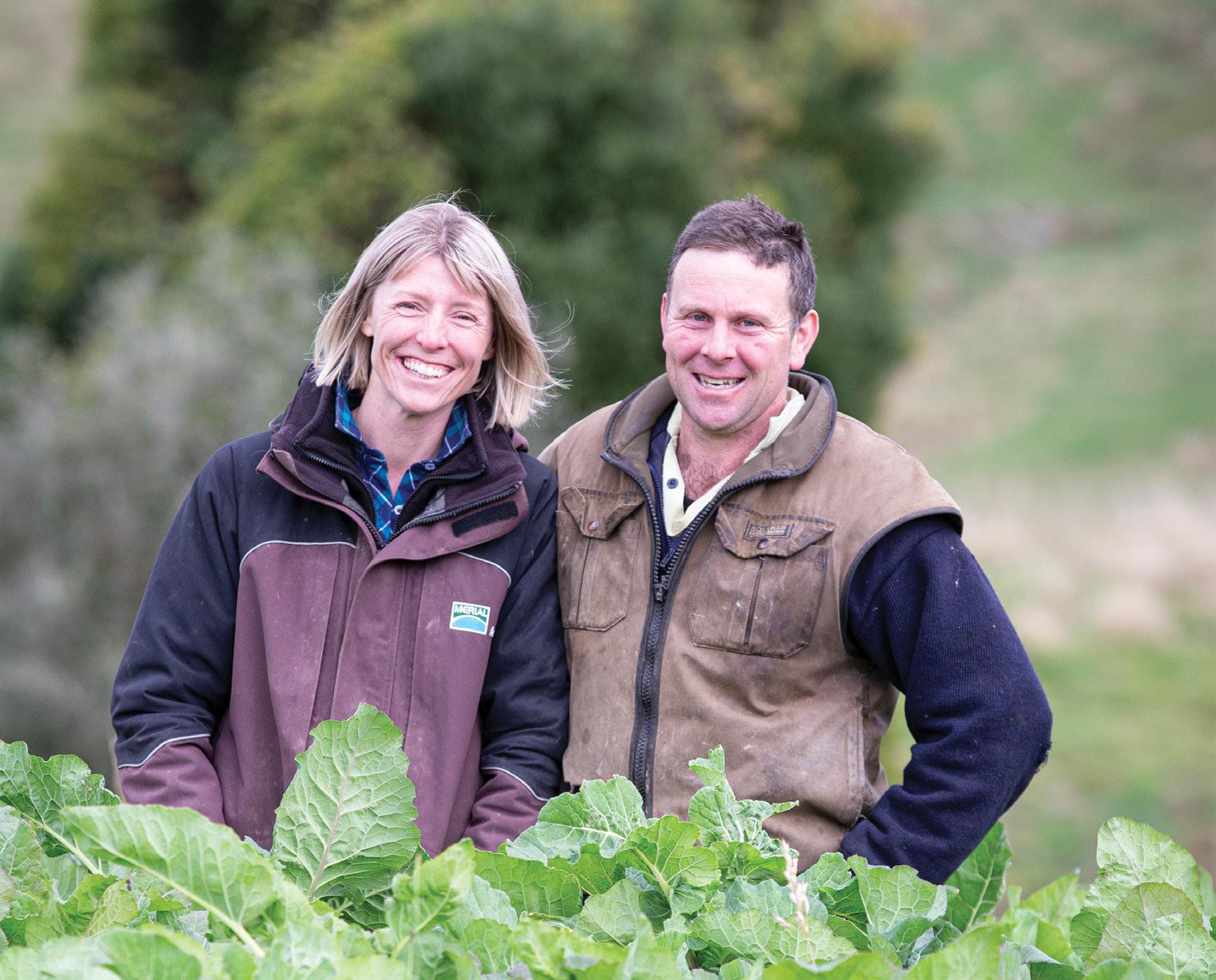
“Derek and Leanne’s grazing management is a bit smarter than they let on at the field day.”
He says they know how to prioritise
some stock and restrict others at critical times to get performance at a good stocking rate.
“Perhaps the cattle take a back seat at key times.”
Stantiall says it’s common for strong performers like the Whites to not be able to explain exactly their approach, especially their grazing management. They operate on a “gut feel” which is difficult to put into words.
“They’re unable to explain what they do, but through education, both formal and informal, and experience, they just do it,” he says.
Note: Two lines of expenditure are standardised in the FAB reporting to remove the impact on performance of capital investment. Fertiliser and lime is standardised at $13/su and repairs and maintenance is $8.50/su.
22 Country-Wide | AUGUST/SEPTEMBER 2023
BUSINESS
Time series analysis Farm class 3, semi finishing, summer wet.
Country-Wide | AUGUST/SEPTEMBER 2023 23
2018-19 2019-20 2020-21 2021-22 Average Physical
Effective hectares 435 435 435 435 435 Total SU at open 5277 5258 5154 5332 5255 SU per ha at open 12.1 12.1 11.8 12.3 12.1% Sheep SU at open 78% 76% 75% 74% 76% Labour units, FTE 1.2 1.2 1.5 1.5 1.4 Lamb STS 146% 143% 135% 153% 144% Calf STS 85% 85% 93% 91% 88% Sheep D&M 8.9% 8.8% 7.0% 8.9% 8.4% Cattle D&M 1.4% 1.7% 7.0% 0.0% 3.4% Wool produced (kg) per sheep SU 3.5 4.3 5.5 4.7 4.5 Adjusted Total Revenue, Expenditure and EFS Sheep revenue $606,388 $636,235 $539,636 $732,287 $628,637 Cattle revenue $126,803 $75,277 $86,521 $132,957 $105,390 Gross Farm Revenue $736,348 $714,902 $633,052 $870,252 $738,639 Standardised Total Farm Expenses $429,516 $407,677 $424,278 $480,059 $435,382 Economic Farm Surplus $306,832 $307,225 $208,774 $390,193 $303,256 Cash Expenditure Wages and Keep $1464 $5616 $932 $7402 $3854 Animal health and breeding $27,581 $25,320 $27,655 $32,888 $28,361 Shearing $51,278 $31,840 $33,388 $44,004 $40,128 Fertiliser and lime $72,822 $59,653 $59,744 $63,341 $63,890 Feed, nitrogen, grazing and forage crops $50,966 $58,971 $49,295 $38,932 $49,541 Repairs and maintenance $172,449 $184,161 $42,024 $64,247 $115,720 Vehicles and fuel $46,154 $40,669 $34,809 $38,296 $39,982 Irrigation $0 $0 $0 $0 Freight $2589 $1806 $2533 $4099 $2757 Weed and pests $6706 $7746 $3478 $24,982 $10,728 Farm working $24,479 $15,365 $24,118 $26,538 $22,625 Administration $7896 $8968 $9665 $8124 $8663 Rates and insurance $15,337 $23,299 $20,860 $13,409 $18,226 Per ha standardised Gross Farm Revenue $1693 $1643 $1455 $2001 $1698 Standardised Total Farm Expenses $987 $937 $975 $1104 $1001 Standardised Total Farm Expenses (% GFR) 58% 57% 67% 55% 59% Economic Farm Surplus $705 $706 $480 $897 $697 Per ha cash Farm Cash Revenue $1684 $1678 $1386 $2035 $1696 Total Farm Cash Expenditure $1370 $1335 $948 $1100 $1188 Cash profit/loss before tax, drawings, depreciation, CAPEX & principal $314 $343 $438 $935 $508 Sundry Return on Capital 5.9% 5.8% 4.1% 6.6% 5.6% Ratio of GFR : Land value 5.9 6.1 6.9 5.8 6.2 More on the farm operation p40
Data
MANAGING TOUGH TIMES
Chartered accountant George Collier encouraged farmers to look for opportunities within their businesses to grow and utilise more feed to increase production.
Drawing examples from his practice’s long-term farm survey, he said costs are typically similar between the top and median performers, the difference is the top performers have a higher stocking rate, lambing percentage and production.
Their economic farm surplus per stock unit (su) is $98 versus $58/su.
“Increasing productivity will reduce costs per stock unit.”

Collier is director of ICL Chartered Accountants in Alexandra and led a recent Beef + Lamb New Zealand Farming

for Profit webinar.
He said the trick is to increase productivity without adding costs and this comes down to being more efficient at converting feed into saleable products.
Speaking to the theme ‘managing in tough financial times’, Collier told farmers that managing cash was key and he advised farmers to have a budget and to revise it regularly.
He suggested that when budgeting for the bank, delay income and advance expenditure and be realistic when making assumptions.
“If it doesn’t work, don’t over-inflate income – rework the plan.”
It was important farmers communicated with their banks, were
clear about their strategy for managing tough financial times and have funding limits well in advance.
Collier’s tips for reducing farm expenses in the short term included slowing the pasture renewal cycle by double-cropping, using contractors instead of employees (saving wages, accommodation and vehicle costs) stopping development, and thinking about needs versus wants.
This might mean repairing and maintaining equipment rather than buying something new.

“Postpone principal repayments for 12 to 24 months but climb back on the bus when the inevitable upswing occurs and restart with small one-off lump-sum payments.”
Drawings are an issue for some farming businesses (the mean drawing in the ICL survey was $72,000/annum or $1400/ week) and Collier suggested setting up an automatic payment from the farm account into a personal account while
MANAGEMENT
Increasing productivity without adding costs is one of the most effective strategies for remaining profitable in tough financial times. Sandra Taylor writes.
minimising both personal expenses and spending on farm cards.
Tax payments can be delayed through Tax Management NZ or through arrangements with IRD and there may also be an opportunity to revise tax payments.
Other options he gave for generating cash included cashing-up life insurance, subdividing and selling off land, selling surplus machinery, looking for opportunities within the ETS and generating income through a partner going off farm to work.
Medium-term cost reduction strategies include being strategic with fertiliser inputs. If Olsen P levels are high, phosphate levels rates can be reduced, but applications of sulphur need to be continued, Collier said.
Pasture mixes should be limited to two to three species. Research has shown there are no production benefits to increasing the number of pasture species in a mix above three. It just adds costs.
Collier suggested buying chemicals and animal health treatments in advance
COLLIER’S ADVICE:
Managing cash is key
Maintain fertiliser applications over the medium term. Possibly skip phosphate for a year if Olsen P levels are high, but sulphur should still be applied
Consider what an optimal farm system looks like; model options for high revenue and medium cost
Communicate with the bank and your trusted team and friends
Down cycles tend to be much shorter than up cycles. Dig deep and hang in there

Levers can be pulled to reduce expenses, increase income or delay cash outgoings, but have a robust medium- to long-term strategy.
and in bulk and taking the opportunity to run a ruler over the cost of insurance.
“Get an independent view on insurance, as people are often overinsured.”


Long-term cost reductions come down to feed, which Collier described as being the core constraint and the core cost in any farming business.
Reducing feed costs by matching the farm system to the pasture growth curve, maximising the use of pasture while minimising the use of supplementary feed, and managing pastures to maintain quality and drive regrowth will all help with long-term cost reduction.
“Pasture persistence is critical to reducing costs and grazing management is key.”
Other long-term considerations include the use of improved genetics to drive productivity and at the same time
reducing costs associated with internal parasites, the smart use of technology, incorporating the “Lean” concept and where possible, protecting income streams through the use of contracts such as fine wool contracts.
The Lean concept is producing goods of the highest quality at the lowest cost by being time efficient, reducing waste and implementing smart systems.
Collier said there was no substitute for mixing with progressive farmers, getting off the farm, networking widely and getting top advice.
Looking back at the financial performance of sheep and beef farms over the past 22 years, Collier said while there have been some roller coaster years, generally the balance sheet has gone from strength to strength.
“The upcycles are always longer than the down cycles.”
Country-Wide | AUGUST/SEPTEMBER 2023 25
MANAGING TOUGH FINANCIAL TIMES
Realise The Full Potentional Of Your Crops


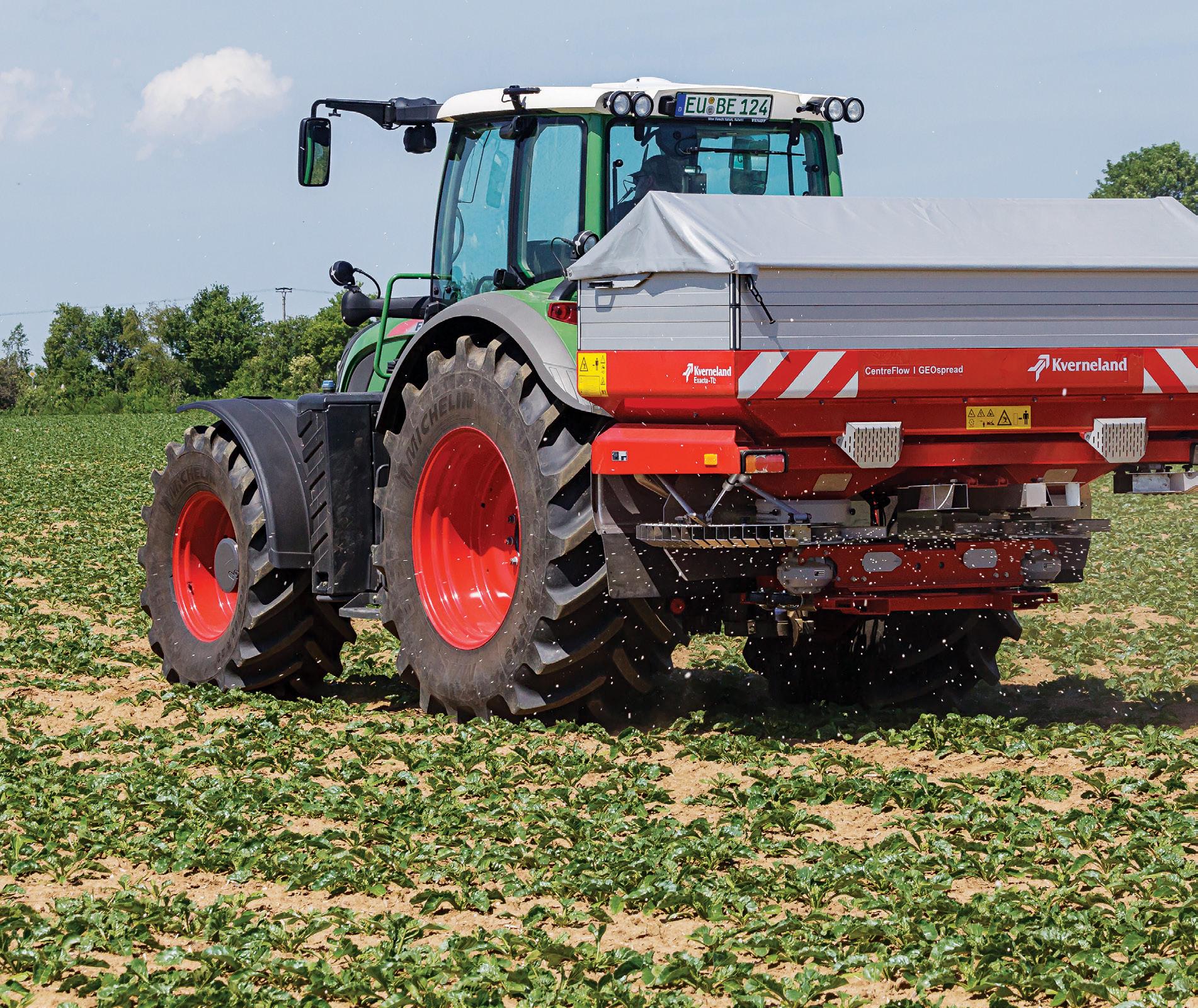
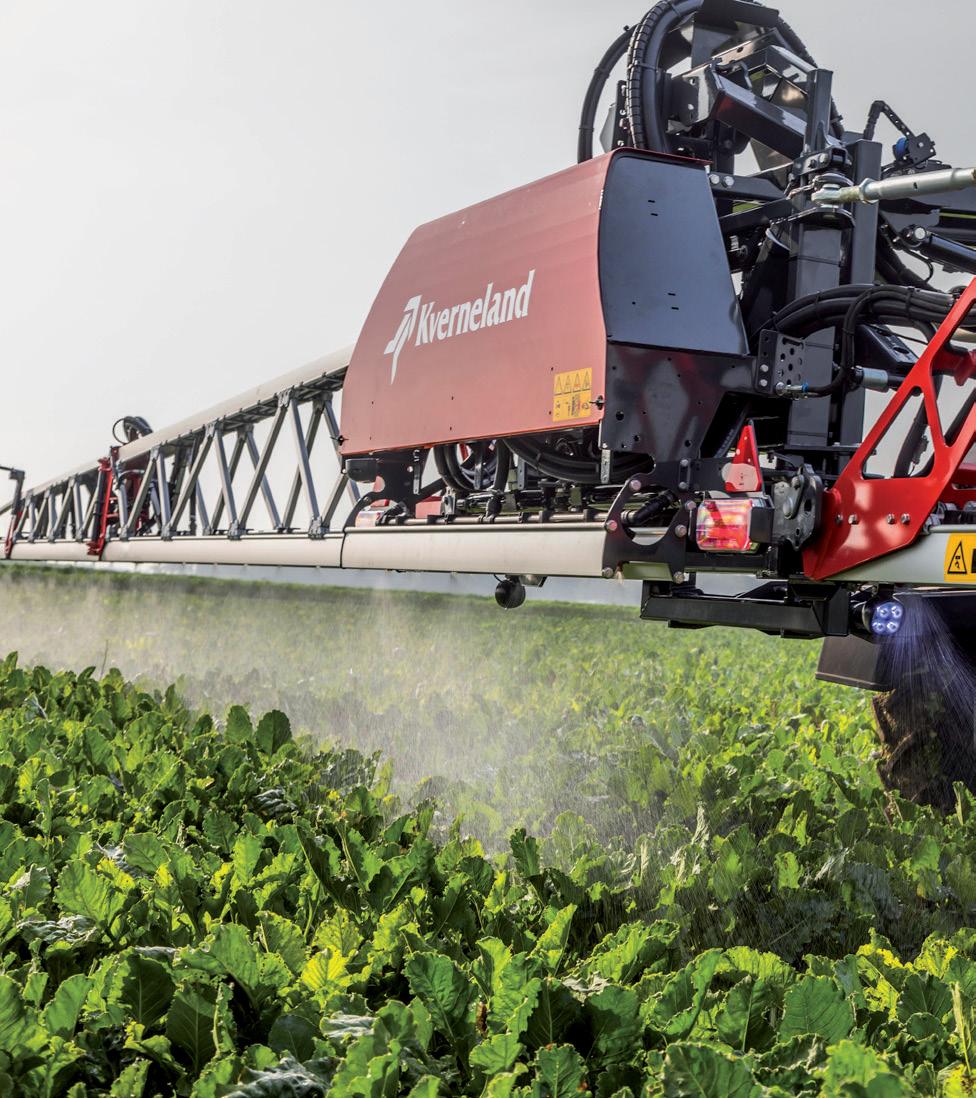
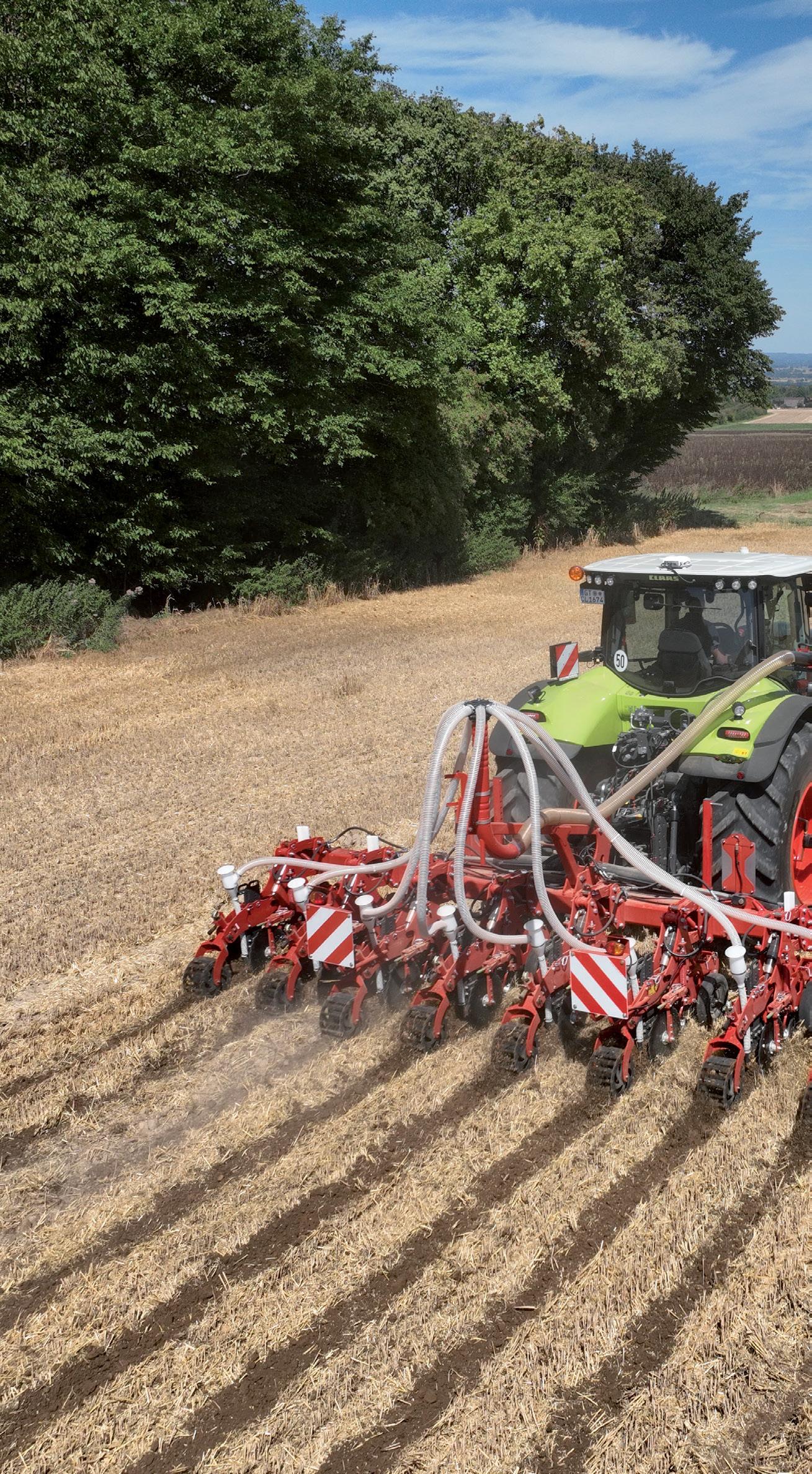
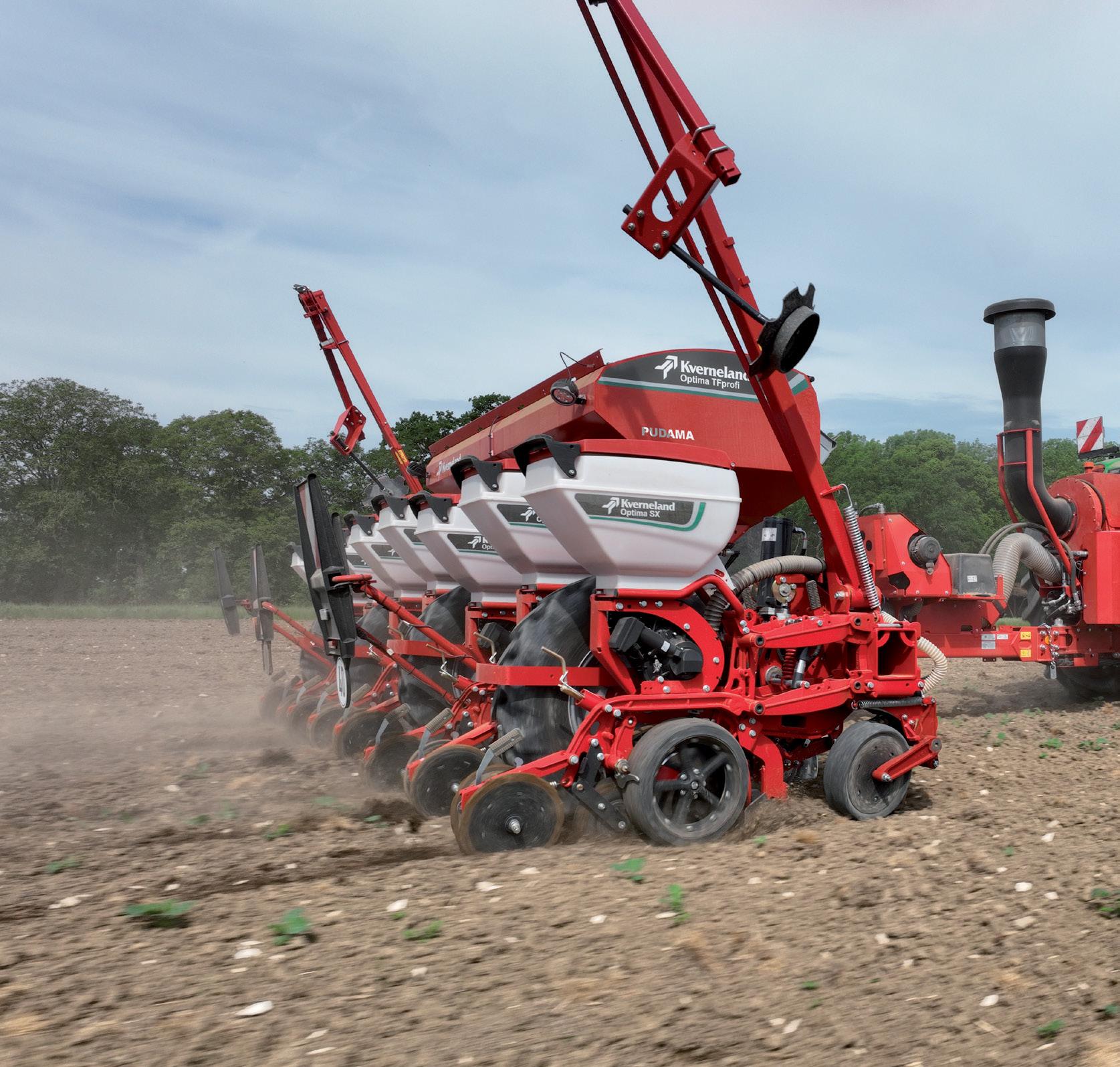
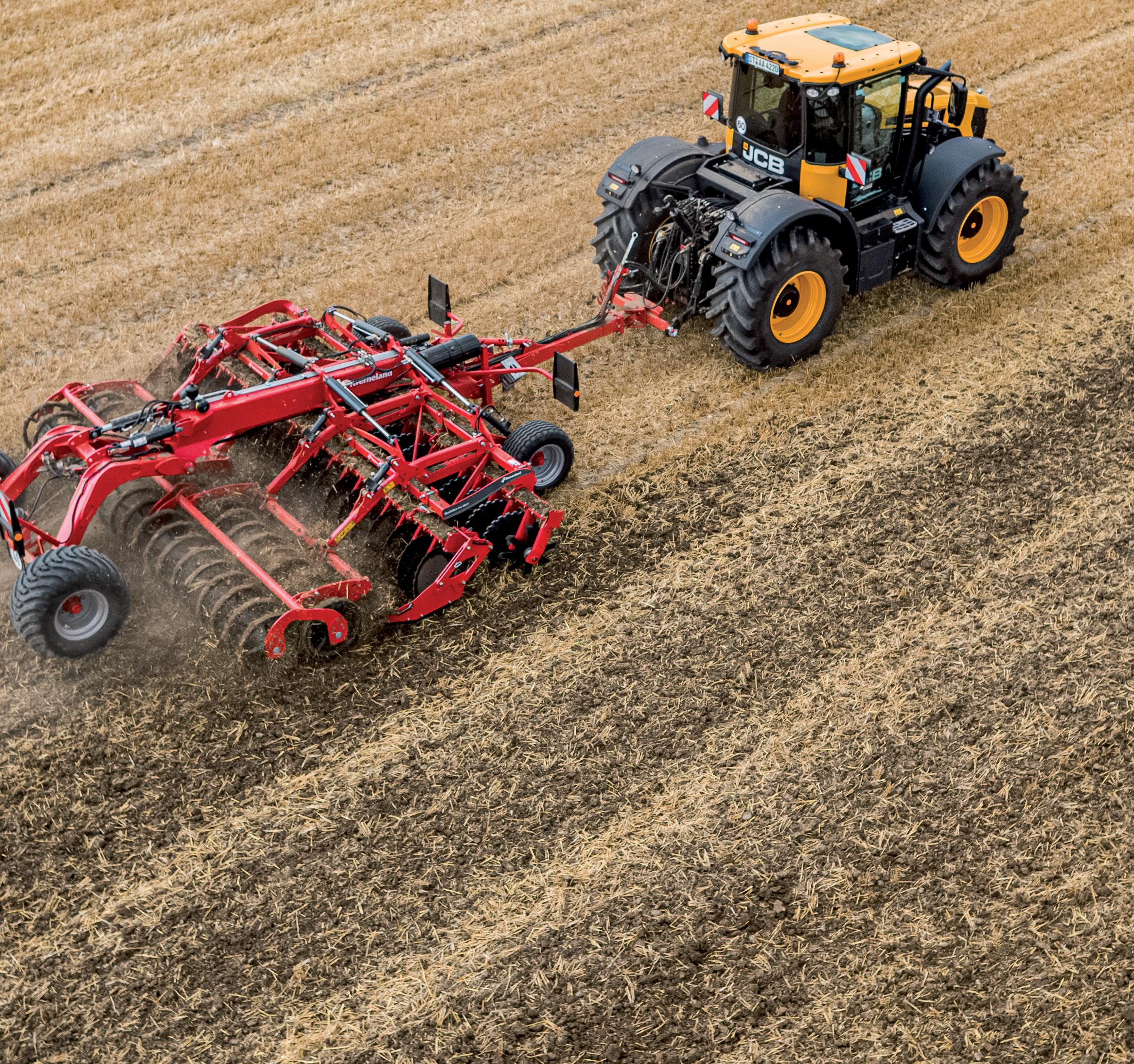
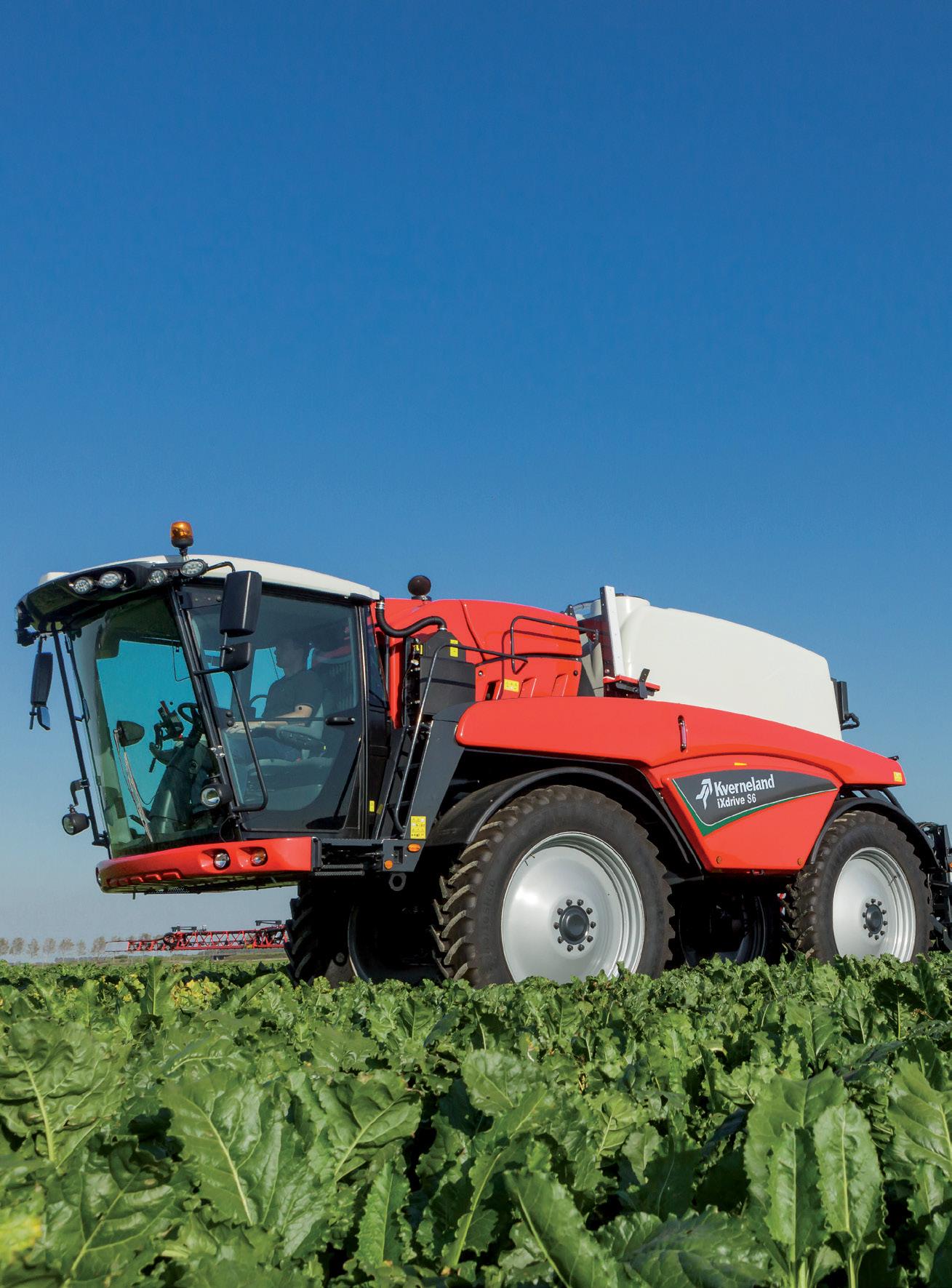

Dear Aunty Thistledown

My neighbour keeps telling us that people are gaslighting her. I want to know what she means. But I am scared to google it. Not after the pegging debacle. I had to get my poor nephew to stop the computer from moaning. I thought it was something to do with laundry. Anyway, if gaslighting is a sex thing, just say it's a sex thing and leave it at that. I don’t need to know what goes where.
Hi FWBAP,
You’ve piqued my curiosity. I wonder how much pornographic detail I can include before the New Zealand Media Council wants a word. But alas, gaslighting is not a sex act. Although it is a form of wankery. Can I say wankery here? Yes, it seems I can.
Gaslighting is a form of psychological trickery that aims to make someone doubt themselves. The term originates from the 1938 play ‘Gas Light’ by Patrick Hamilton. The villain convinces his wife she is going insane so he can keep breaking into the upstairs apartment in his spare time. He assures his dearest that she is imagining the noises coming from upstairs, just like she is imagining the gas light in their house is dimming (when he turns on the upstairs lights).
Have you ever tried to talk to someone about an incident only to have them deny it ever happened?
Doubting the accuracy of someone’s memory is a gaslighting tactic. Parents are great at it. Mine took me to a zoo as a preschooler and laughed while lion cubs dragged me around by my Swanndri. They could just say sorry for feeding me to lions, but they say it was probably a dream.
If downright denial won’t work, then there are more tools in the gaslighting toolkit. The most popular one I have come across in workplaces is simply invalidating the other person's feelings: we aren’t being inconsiderate, you’re just being over sensitive again. It was a joke, lighten up. You need to get an early night. You always think we underpay you when you’re tired.
Then there is diversion and deflection. What’s that over there? It’s a detour to discussing anything but the victim’s concerns. The real issue here is the war in Ukraine or how nasty your mother was at Christmas.
And then there is the darker stuff. All of the above are strategies that are pretty common in the conflict-avoidant Kiwi culture. A lot of people have a gaping void between “don’t make a fuss” and “time for fisticuffs” where “let’s talk it out” should live. So sometimes, the less empathetic amongst us will occasionally employ these techniques in a misguided attempt to keep things genial. Since your neighbour is aware that she is being gaslit, we can assume that she is having this kind of (frustrating, but safe) interaction with a passing narcissist. It seems like she is free to roll her eyes, walk away, and go confuse the neighbours.
if you have a question for her, terry.brosnahan@nzfarmlife.co.nz
But gaslighting can also be used to control vulnerable people for personal gain. It may be employed in domestic abuse or to swindle the elderly. In which case gaslighters may intensify their tactics to push their victim further into la-la land. This might include withholding information, fabricating stories, or acts of sabotage.
Now this is the bit where I refer the audience to some helplines in case someone reading this needs more than a playful article on psychological abuse. The Shine website www.2shine.org.nz has helpful resources on escaping abusive relationships, an online chat function, and a hotline (0508 744 633). The www.healthline.com website has a lot of information on gaslighting, which I totally did not plagiarise. And www.mentalhealth. org.nz has information on narcissistic personality disorder if you have just realised you are orchestrating an alternative reality for the people around you. If you want to look up words that might be sex things without a thousand pop-ups for “hot single ladies in your area”, then www. urbandictionary.com will give you succinct definitions for all youthspeak of today.
Country-Wide | AUGUST/SEPTEMBER 2023 27 COLUMN
Cali
Many thanks, Fine with being a prude
Thistledown lives on a farm where all the gates are tied together with baling twine and broken dreams. While she rarely knows what day it is, she has a rolodex of experts to call on to get the info you need. She’s Kiwi agriculture’s agony aunt. Contact our editor
Stay prudish, Aunty Thistledown
THE OUTLOOK FOR LANDCORP
Is there a future in public ownership for Landcorp Farming? Ray Macleod thinks the SOE is far from a shining example for the farming sector to aspire to and says it needs to sharpen its farming act.
Treasury’s independent review on Landcorp Farming was completed by James Morrison Consulting Ltd in 2021, and its observations and recommendations were released in December that year. The review was commissioned as a result of, and I quote:
“...the strategic approach adopted [by Landcorp] in 2014 includes leveraging off its scale and building resilience through diversification of revenue streams, including through creating value in its off-farm ventures. However, performance to date has not clearly demonstrated that the strategic approach is delivering as intended.”
So the review was not intended to consider the future ownership of Landcorp Farming by taxpayers but to identify why it was not delivering operational and strategic results. It found answers in abundance and provided plenty of examples as to why the long-suffering taxpayer should be asking why we own Landcorp? Perhaps the minister is also

asking the same question?
As a farming operation Treasury’s independent review observes there are issues with:
1. transparency and accountability
2. on farm performance
3. off farm performance
4. corporate overheads.
That doesn’t leave much left to provide us poor taxpayers with confidence in a rosy future for Landcorp. The independent review is a useful document upon which to base a discussion around future ownership of Landcorp.
With respect to transparency and accountability, I fully support the conclusion of the Morrison review that “Landcorp’s performance has proved difficult to assess because of information shortcomings, lack of transparency and “moving targets”, making it difficult to hold Landcorp to account.”
Having been a long-term reader of Landcorp’s annual reports, they are best described as murky. Sure they meet reporting standards, but the ability to
28 Country-Wide | AUGUST/SEPTEMBER 2023
LANDCORP

Country-Wide | AUGUST/SEPTEMBER 2023 29
FEATURE
extract good longitudinal comparative data is limited. I’ve always thought this a Landcorp strategy to distract readers from increasingly average performances. And those performances are not just average; across the bulk of Landcorp’s farming revenue lines the farm performance is below average.

things every farmer is critically aware of in their herd performance. This gives a false impression of the dairy operation performance, good or bad, and add to that the unallocated corporate overheads and we have further reason to get lost in smoke and mirrors.
Figure 1 doesn’t make pleasant reading for an organisation that projects itself as being a sector leader. I don’t feel the dairy sector would be racing to Landcorp for advice, except perhaps for what not to do. Per cow production has plateaued in the last eight years and is firmly locked at about 350kg MS/cow/season. Similarly, production as a percentage of liveweight is locked at about 70%. Landcorp performance is eclipsed by the majority of farmers; it is below average, or to be quite firm, it brings the NZ herd averages down. Putting aside the production per cow, because we can always argue cow size may be a contributor, the milk solid production as a percentage of liveweight is telling. Statistics don’t record average dairy cow liveweight2, so having asked around I settled on 500kg liveweight based on a J9 Jersey cross. On this basis for the 2021-2022 season per cow milk solid production as a percentage of liveweight is 77%. Landcorp is still lowering the NZ herd average.
The dairy picture
Dairying generated $120 million of milk receipts1 or 48%, to the nearest percent, of the group revenue for the year ended June 2022. Based on the annual accounts, this result doesn’t include revenue from sales of cull cows, calves, purchase of dairy stock or cost of raising replacements, all key components of the operating models in the dairy sector. As an aside, if that is how Landcorp reports its carbon performance, it would make the dairying operation look pretty clean! We don’t get a fix on dairy herd replacement rates or how this impacts the bottom line –
Moving on to other on farm performances the enthusiasm for the corporate effort doesn’t improve. Over the 2020, 2021 and 2022 financial years Landcorp’s lambing percentage, with the NZ flock percentage in brackets3 were 135% (138%), 134% (138%) and 130% (134%). Given the size of the flock, Landcorp’s operating challenges are likely a mirror image of the NZ Inc on-farm experience for the same periods, so these results are unlikely to be unique to Landcorp and are simply below average. Carcase weights are at the low end of the scale at 17.8kgs–17.9kgs, with the NZ average being recorded as 20kg4. The interesting one is sheep deaths at 51,6475 or 13.1%
30 Country-Wide | AUGUST/SEPTEMBER 2023
View Treasury’s independent review on Landcorp Farming at: bit.ly/3OmVvPm i
"We find ourselves agreeing with the Morrison Review that Landcorp is a below average performer."
of the total sheep flock of 394,494. A recent study of ewe losses completed by Associate Professor Anne Ridler of Massey University suggests ewe deaths/missing of six animals per hundred6. Assuming the sheep deaths reported by Landcorp are deaths and missing, and I accept this may have been elevated by the sheep dairy operation, it still suggests at 13.1% an excessive level of deaths across the entire Landcorp farming flock. Again this isn’t sector-leading farming performance. We find ourselves agreeing with the Morrison review that Landcorp is a below average performer.
With respect to cattle revenues this includes $31m of dairy cow sales and $8m of purchases in the livestock trading account. What is not evident here is where the costs of raising dairy replacements is allocated. Again the annual report is so deficient, a knowledgeable reader is unable to get a view of divisional performance. Livestock sales are recorded at $127m, or 50% of farm operating revenue. Sound operating division results would
record dairy revenue at $151m and livestock trading, or sheep and beef, at $96m. So livestock trading is overstated and if the annual results are to be used for anything remotely analytical, dairying is understated with livestock trading not allocated to divisions and goodness knows where the operating expenses sit between them. The only thing we can say about the livestock statistics in the 2022 annual report is that carcase weights are likely overstated due to a considerable number of cull cows being in the mix, but then low-performing cows are usually skinny cows.
At 12% of Group revenue, off-farm receipts are not significant and aren’t adding anything to the conversation, other than the Morrison review has expressed a number of doubts about the financial modelling, and I’m of the view that it has probably generated significant overhead, which brings us to the next question. Just how much overhead is Landcorp generating and not allocating to its operational divisions? My best guess, based on what information one
can gather about the head office structure, is that there must be a good $20m in corporate overheads, but as the Morrison review observed, it isn’t reported and thus not allocated to the operating divisions. What would that do to the off-farm investment where I suspect most of the corporate overhead is generated?
Landcorp is by no means a stellar performer. It has managed to hide the worst excesses of its operational performance through not allocating its corporate overhead and by making its annual report so murky it is hard to conclude much of use from it. The Morrison review comments at page 34 that Dairy Holdings has 12 nonsupervisory staff or about one sixth of Landcorp’s. So to support my thoughts about overhead allocation I have assumed that is 70 non-supervisory staff. I have added up the costs for the top 68 salaried staff (from $140k–$149k to $590k–$599k) and they exceed $14m. Add in maintaining a head office, travel and other operating and employment costs, the unallocated corporate overhead
Country-Wide | AUGUST/SEPTEMBER 2023 31
FY ENDED JUNE AVERAGE KG MS/COW NZ AVERAGE KG MS/ COW LANDCORP % VARIANCE FROM NZ AVERAGE COMMENTS % OF COW LIVEWEIGHT 2012 365 Not available Not available 2013 346 Not available Not available 2014 371 Not available Not available 2015 377 350 -7.1% 78,314 Dairy Cattle less R1, R2 & 19,367,000kg MS Not available 2016 372 356 -4.3% 78,491 Dairy Cattle less R1, R2 & 19,691,000kg MS Not available 2017 381 349 -8.4% 76% 2018 368 336 -8.9% 73% 2019 381 327 -14.2% 71% 2020 385 355 -9.8% 77% 2021 397 375 -5.6% 81.5% 2022 386 350 -9.3% 73%
Figure 1 Comparative herd performance vs NZ averages.
Figure 2: The numbers of employees and former employees whose total remuneration was within the specified bands. Remuneration is inclusive of benefits including performance incentives, employer superannuation contributions, health and life insurance and accommodation benefits (where applicable). Performance incentives paid in 2021/22 relate to performance in the prior year. Source – Landcorp Annual Report 2022.
is likely between $25m and $30m. Landcorp’s non allocation of overhead does it no favours and makes me deeply suspicious of why it isn’t allocated.
The only safe conclusion, the one I could rely upon, is that the performance scorecard on page eight of the 2022 annual report is accurate but of no value in scoring Landcorp’s operations with accuracy. Most of this performance report is some sort of social licence tick-box exercise that the market would simply ignore if it were doing due diligence on the operating divisions. But then in my view, a serious due diligence undertaking would ignore the entire annual report.
Landcorp is a perennially poor performer that has drifted away from its core objective of returning an acceptable profit to taxpayers. If it reported and allocated its corporate overhead, which it must for credibility, it would provide a more realistic picture of true operational performance as a state-owned enterprise (SOE). It needs to also report its farm divisional performances as standalone operations too, so its farming performance is better understood. There is simply no compelling commercial or other reasons why this is not done.
Questioning priorities
My question is why aren’t senior management and the board strongly focused on making the core operations of farming perform before moving into offfarm investments? Investments Landcorp doesn’t appear to have the managerial skill or resources for which is noted in the Morrison review. Does Landcorp think off-farm investments are going to improve group results without fixing the farming performance issues first? Farming is 88% of group income according to the 2022 annual report, and off farm activities are not trading to any of the lofty expectations! What would they look like with a share of the corporate
overhead allocated?
Landcorp is not a special case. All farmers have weather and commodity price challenges and it seems they face more critical performance review processes than an SOE whose shareholders’ representative, the minister, largely leaves them to it. Landcorp’s corporate overhead, as noted in the Morrison review on page 33 is high compared to other SOEs. Landcorp is not a shining example for the farming sector to aspire to, it doesn’t have a mandate to identify itself as some industry-good organisation, which, as noted in the Morrison review, it clearly is not. The priorities are wrong here and are a recipe for failure as senior management and the board pursue lofty off-farm goals that appear to have been poorly modelled and as they check social licence tick boxes in what seems to be a vain attempt to remain under the radar while core business performance is below average. The inevitable conclusion is Landcorp is poor value for money and in my opinion has been hijacked by interest groups at corporate level and it should be sold off to better operators, to owners who will stimulate the economy, continue to employ operational staff and pay tax to the IRD on profits. Landcorp’s reporting, while compliant, is self-serving claptrap and mutual back slapping.
If we put the net reported assets of $1.8 billion into the bank on fixed deposit, we would get a better return. If we built 260 houses at $700,000 each, the social return would be better and if we spent it on mental health, who knows? What I do know is that as a taxpayer I think there could be much better use of our funds.
* The asterisk indicates remuneration bands that included at least one former employee who received a severance payment, without which they would not have been in that band.
32 Country-Wide | AUGUST/SEPTEMBER 2023
$000 No. of employees 100–109* 32 110–119* 34 120–129 24 130–139* 18 140–149 17 150–159* 6 160–169* 11 170–179 6 180–189 3 190–199 2 200–209 1 210–219 3 220–229 1 230–239 2 240–249 4 250–259 2 270–279 1 290–299* 1 350–359 1 360–369 1 380–389 1 390–399 1 400–409 1 410–419 2 590–599 1
1 Landcorp Annual Report to June 2022 Note 2 Farm Operating Revenue p65
2 Animal live weight calculations in the NZ Agriculture GHG Inventory Model – Mike Rollo Agresearch May 2018
3 Stats Dept - agricultural production statistics for the year ended June 2022
4 Beef + Lamb NZ– Annual Reports years ended June 2021 & June 2022
5 Landcorp Farming Annual Report year ended June 2022.
6 Ewe wastage in commercial sheep flocks.
Ray Macleod is an agriculture economist and director of the consultancy company, Landward Management.
POSTELECTION OPTIONS
By Jo Cuttance
The National Party wants Landcorp to be run at the same level of expectation as a private entity, while the ACT Party would like to sell chunks of Landcorp to talented, ambitious farmers to own and run.
Improving Landcorp’s performance, productivity and financial return would be a focus for National if it becomes the government after the election.
National’s agriculture spokesperson Todd McClay said improved returns from Landcorp would provide another source of funding for the government to invest in New Zealand infrastructure.
He said under a National-led government, Landcorp would be one of many state-owned enterprises (SOEs) that would help fund New Zealand infrastructure, such as schools, hospitals, police, and so on.
“This would help reduce the amount of borrowing New Zealand is doing to fund these projects,” he said.
An independent review of Landcorp in 2021 found it had failed to meet financial forecasts, had high corporate costs and had invested in unprofitable off-farm ventures.

McClay said not a lot of attention had been paid to Landcorp in recent years and that had resulted in less efficiency. There was a perception that Landcorp could get away with not operating at maximum efficiency because it was an SOE.
National would not sell any Landcorp land, McClay said. It would look at how it was being run and ask if it was being run as well as it could be.
“It must be run to the expectation of a private entity.”
He said Landcorp had a role to play in the agriculture sector. There was a sweet spot being an SOE and this was where Landcorp could try new innovations and have cadetships both for training and to help people move to farm ownership.
ACT’s primary industries spokesperson Mark Cameron said the government should not be in farming. He said New Zealand had plenty of ambitious, talented farmers who deserved the opportunity to farm the land owned by Landcorp.
ACT would sell Landcorp off in chunks, with the proceeds being used to fund conservation on private land, Cameron said.
Landcorp land that would be precluded from sale because of Treaty of Waitangi concerns would be retained and provide long-term leases to the SOE. Cameron said in the hands of expert, profit-focused private owners, these enterprises could prosper on their own merits.
He said the role of government was to provide essential services – not to run businesses.
“Landcorp not only provides a poor financial return to taxpayers, but the government ownership of these farms is keeping Kiwi farmers out of the market,” Cameron said.
Country-Wide | AUGUST/SEPTEMBER 2023 33
Opposition parties have ideas about what they’d do with Landcorp should there be a change of government in October.
MONEY BETTER IN THE BANK?
Landcorp’s head disputes its poor-performing label and argues it is on the road to salvation.
The State-Owned Enterprise’s chairman Warren Parker said Landcorp has improved since a Treasurycommissioned 2020 report.
He argues its farms should be benchmarked to similar farms.
“It needs to be on a like-for-like basis.”
Parker said the report compared its tougher farms with private, better farms.
Under the land classification system, he said, 53% of their farms are class 6 and 7 (poorer soils and steep).
“On our irrigated farms in Canterbury we are comparable.”
Critics say Landcorp exists to put money into the Government’s coffers, the consolidated fund. Landcorp’s return on assets in the past five years is 3.3%. It is not as bad as Kiwi Rail and NZ Post but they are providing essential services. Other SOEs have recorded 2427%.
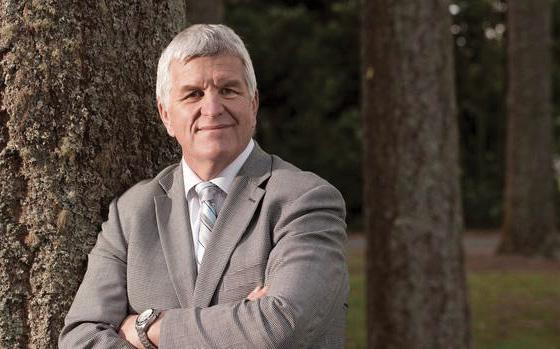
Critics say it would be better to sell off Landcorp farms and put the money in the bank. Landcorp farming’s brand name is Pamu.
Since the report, Parker said Landcorp had acted on some of the report’s criticisms, particularly on improving its transparency.
“We’ve provided better linkages between former forecasts and updated forecasts.”
Critics say the government would be better off selling its farming operation, Landcorp.
By Terry Brosnahan and Glenys Christian.
He says that when Landcorp submits a new business plan to Treasury it outlines why there are variances between the original and current forecasts.
Parker was asked by Country-Wide for a copy of its official business plans which the SOE provided to the Treasury for the past three years to see if the goalposts have changed and if executives are delivering on promises made in 2020. He refused, citing commercial confidentiality.
Parker did send some dairy benchmarking figures for 2021, not 2022. Pamu’s earnings before interest, tax, depreciation and amortisation (EBITDA) is $2477 to $3216/ha. It said
34 Country-Wide | AUGUST/SEPTEMBER 2023
the industry average is $2867/ha.
Ag economist Ray Macleod said EBITDA/ha is a poor measure.
“What percentage of the feed budget is grown and how much is external grazing or imported feed?”
Macleod agrees with the report which says it is difficult to assess Landcorp because of lack of information, transparency and “moving targets”.
“Having been a long-term reader of Landcorp’s annual reports, they are best described as murky.”
The benchmarking put ewe stock and death rate at 8.7% (2021-2022 year was 13.1%) compared with the industry’s 5%.
Parker said the higher ewe loss was an area of focus with poaching on one farm.
Macleod said one farm did not impact a sheep flock as big as Landcorp’s which is 435,000-440,000.
Landcorp’s farm performance does not include its corporate overheads.
Parker said a management fee and cost structure are included, but not the overhead costs.
Critics suggest the overheads are about $25-30 million and likely to include their off-farm ventures. Parker said the corporate overheads were $19-21m.
Macleod argues if an overhead is not allocated a return on assets on the books it will look favourable.
The overall result doesn’t support a good return on assets, he said.
“For example, in addition to overheads, where were the dairy
Country-Wide | AUGUST/SEPTEMBER 2023 35
ROA (%) 3.34% 3.32% 2.62% Central Gisborne Hawke's Bay Lower North North Canterbury Northland Otago Te Anau Genetics West Coast Central Gisborne Hawke's Bay Lower North North Canterbury Northland Otago Te Anau Genetics West Coast Central Gisborne Hawke's Bay Lower North North Canterbury Northland Otago Te Anau Genetics West Coast 4 4 3 3 2 2 1 1 0 16-18 17-19 18-20 2.47% Pamu Above benchmark Below benchmark Pamu Farms average B+LNZ average
Figure 3 ROA on EBITRm rolling average.
“Having been a long-term reader of Landcorp’s annual reports, they are best described as murky.”
replacement costs being allocated?”
This was not shown in the accounts. How was the sale of dairy culls being allocated because in the annual report it is in cattle trading?
“So what is the basis for the benchmarking?”
Parker said the low cash rate of return on assets (3%) is similar to private farms and there had been a significant increase in equity with the revaluation of sheep and beef assets. Critics say revaluation is smoke and mirrors. What is the operation’s return before revaluation?
Parker rejected criticism of Landcorp’s off-farm investments being below projections, saying they were operating at break-even or profitable. He said it was the correct move to lift market returns and land use enterprises. Sheep
milking would have a lighter impact on freshwater.
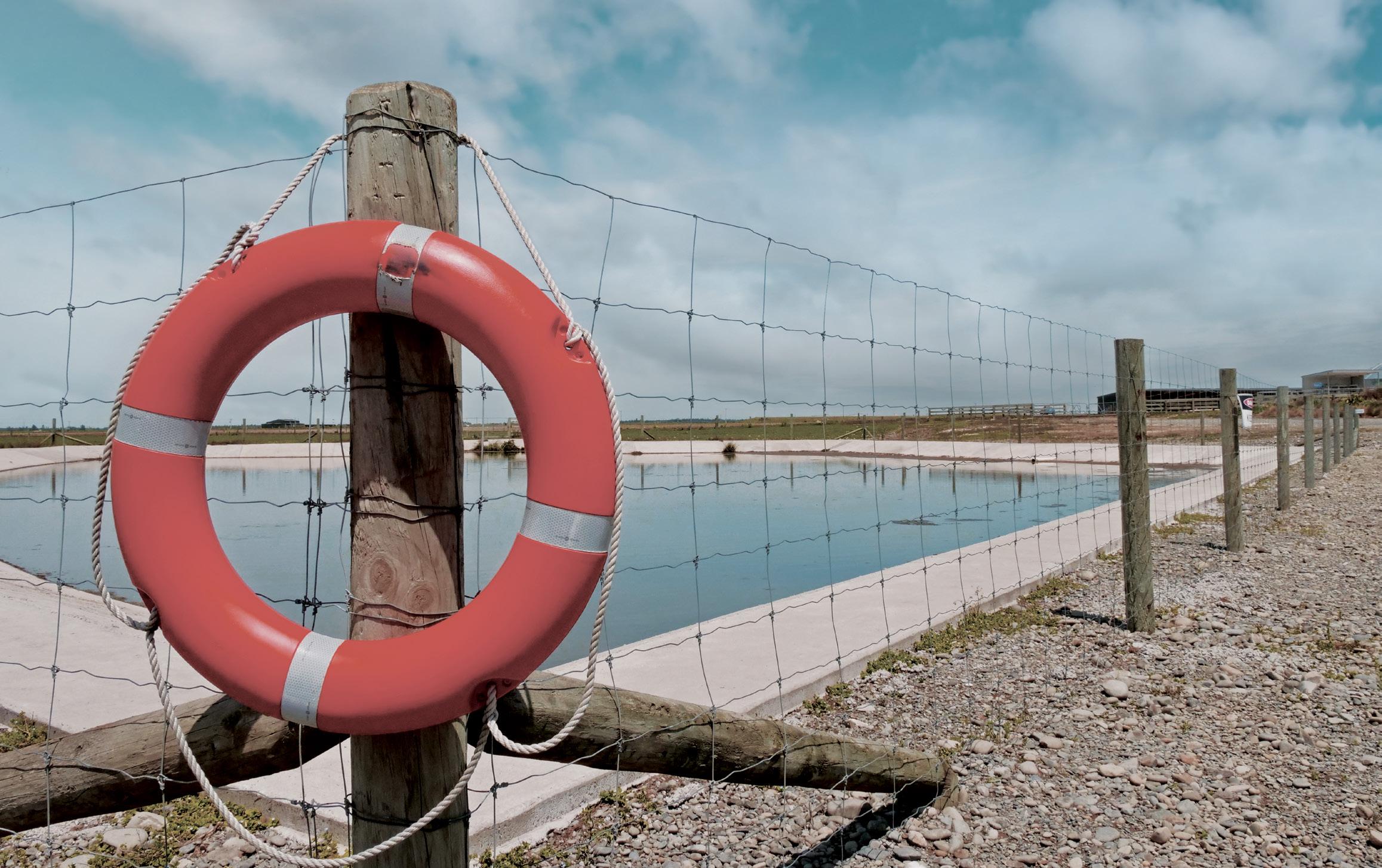
Melody Drier and Spring Sheep Dairy (SSD) were linked to the supply chain and Landcorp was respectively 35 and 50% shareholders. Covid and China market changes for infant formula registration have ‘slowed progress’.
“...but we are seeing markets opening and opportunities for market diversification emerging now.”
Asked for a return on assets for the sheep milk, he replied they were still growing supply. Parker is comfortable with present plans and value accretion, saying SSD isn’t yet equity accounted.
Critics say there needs to be a full investigation to see what has gone on with the management of Landcorp’s offfarm investments.
36 Country-Wide | AUGUST/SEPTEMBER 2023
STATE-OWNED FOOTBALLS
Act of 1986, the principal objectives of an SOE are to be (1) as profitable and efficient as comparable private businesses, (2) a good, equal-opportunity employer and (3) an organisation that is socially responsible towards the community it operates in.
How does Landcorp stack up as an SOE?
It’s election year which means it is time to start booting the political footballs around the beehive lawn. Farmers, teachers, police, gangs, beneficiaries and immigrants can all look forward to having their futures planned out by lonely retirees on talk-back radio. One political party will argue that New Zealand is a country approaching destitution, filled with hungry and illiterate children anxiously waiting on housing and healthcare. The other will argue that, no, everything is either fine or on its way to being fine. One of them will win and fiddle around the edges pecking holes in their favourite victims for the next three years. If red wins, there will be more regulatory jabs at farmers, landlords and other private enterprises. If blue wins, the public sector will be trimmed, purged and audited into submission.
In amongst it sits NZ’s largest farmer and permanently underperforming stateowned enterprise, Landcorp, which can’t expect much love from either direction. National and ACT want to kill it via farm sales or private leases. Labour and the Greens want to torture it into an example of idealistic farming standards. Te Pati Maori would point to the Treaty of Waitangi. This would have to be a major reason why Landcorp continues to persist
despite nobody being too fond of it – it is one of the state’s hidey-holes for illegally confiscated Maori land.
What is
an SOE?
State-owned enterprises (SOEs) came into being on April fools day 1987. It was part of the radical governmental reforms of the 1980s that some people called Rogernomics and others called neo-liberalisation. I call it a massive swing from “government knows best” to “the free market will have to save the country”.
Government departments and assets were repackaged into government-owned companies. The idea being that they would be more efficient if run as separate legal entities. It also wrapped them up in a neat little bow for sale during a time when the state was looking to trim some fat.
This meant the Department of Lands and Survey, which was managing Crown land, got divided up into the Department of Conservation, the Department of Survey and Land Information and Landcorp. Landcorp was probably allocated land the Crown intended to sell off to private buyers, except the 1980s weren’t great years to try offloading farmland.
Under the State-Owned Enterprise
Landcorp, trading as Pamu, sits on close to $2 billion in assets and returns a measly $5m dividend to the NZ taxpayer each year. Their lambing percentage is average at best (130–135% including hoggets). The Landcorp dairy cows flail significantly below the national average with 350–375kg MS a cow over the past three years.
Over the past five financial years, Landcorp’s staff turnover has been 25% for its 600+ workforce. Return on capital invested over the same period has been 3.3%. We can compare this to the return on capital investment for other “agricultural-ish” SOEs, such as AsureQuality (27%) and Animal Control Products LTD (makers of ‘Pestoff’ products) 24%. These particular SOEs will have benefited from Government spending on Mycoplasma bovis and the ‘Predator Free 2050’ programme. But even so, it is clear that Landcorp isn’t doing any better than leaving the money in the bank and, like so many of us, is simply farming for the fresh air and capital gains.
What is the purpose of Landcorp?
Landcorp clearly isn’t blowing the Treasury away with its financial performance. Although it wouldn’t be
Country-Wide | AUGUST/SEPTEMBER 2023 37
It’s been 36 years since Landcorp was formed, a stateowned enterprise tasked with farming state-owned land to “grow New Zealand’s finest natural products”. Dr Nicola Dennis takes a close look at Landcorp’s results and questions its value to the NZ economy.
the only SOE in that category. KiwiRail Holdings Limited had $13.9 billion in total assets in 2022 and will probably never pay a dividend. Its operating balance is frequently in the red by hundreds of millions of dollars. But NZ is a better place with railways and interisland ferries.
Likewise for a postal service. This is basically the Government providing essential services where private enterprise would struggle to survive. After all, Toll holdings was happy to sell the railway network back to the state for $1 in 2004.
But what hole is Landcorp filling?
According to the Government, the purpose of Landcorp is to:
• develop the best systems for dairy, sheep, beef and deer farming
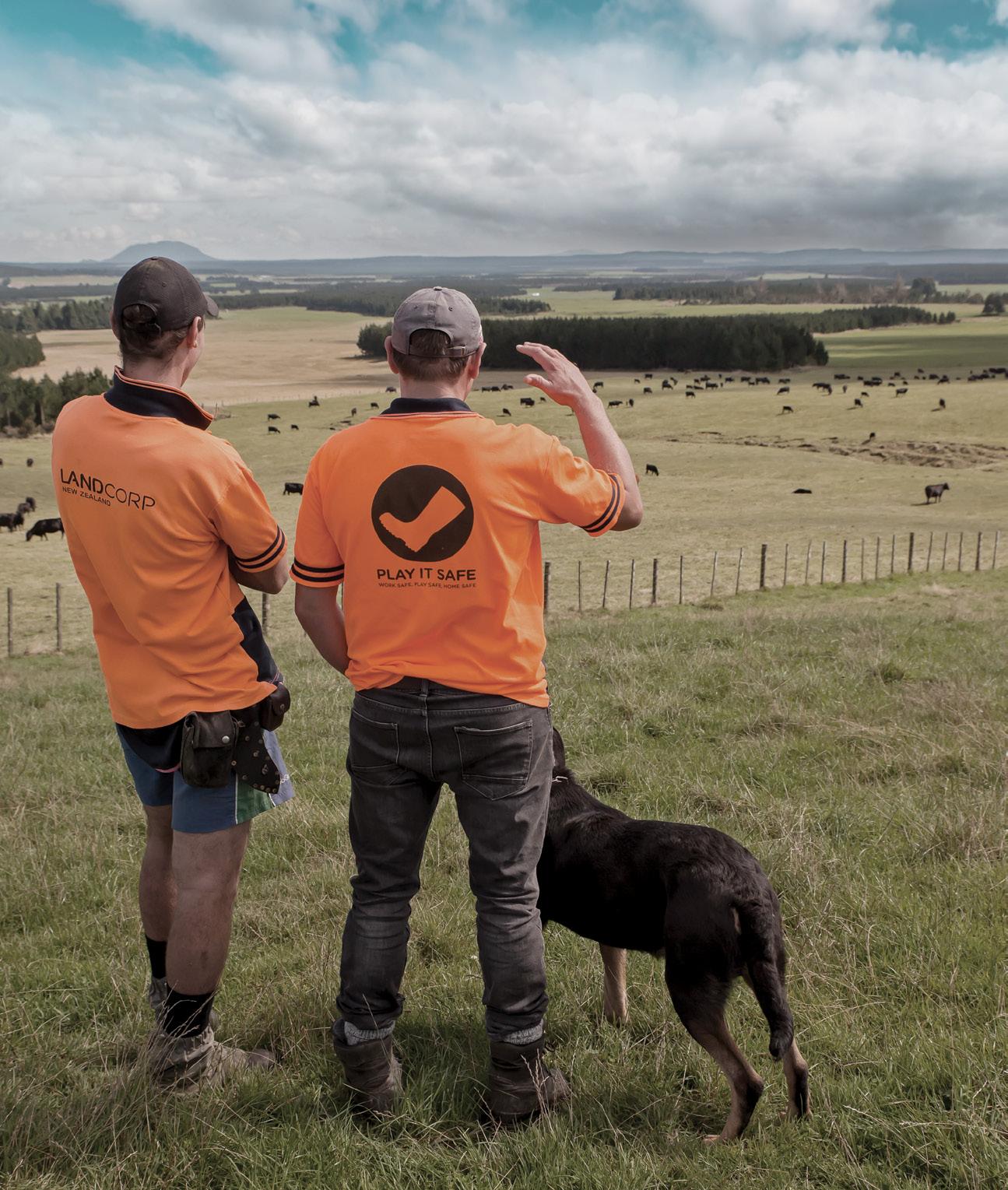
• genetically improve livestock
• offer a farm management service.
All three of these purposes are goals shared by existing private enterprises, as well as the Crown research institutes and universities. The country would not grind to a halt if the state stopped farming 6% of the national farmland.
Landcorp subsidiaries Focus Genetics and its joint ventures such as FarmIQ, Spring Sheep Dairies and Melody Dairies should be able to survive as private or state-owned enterprises without the support of some 24,000 hectares of land. It is worth mentioning that Treasury’s report was quite favourable of Focus Genetics but found Pamu foods, Spring Sheep and FarmIQ were underperforming. They also threw some shade on Melody Dairies where investments were made against Treasury advice.
There may be other reasons why it might make sense for the state to hold onto farmland. They just don’t seem like any of the reasons given.
Is it normal for governments to farm?
The word “farmer” comes from Old French “fermier” which means “lease holder”. This suggests that, historically, the person farming the land probably didn’t own it. Throughout the world today, government-owned farmland is fairly common. But it is usually maintained for reasons other than farming, such as defence training grounds or national parks. And then grazing permits are issued to private farmers. Or it’s in the form of research and training farms, such as what we see at AgResearch, Lincoln University, Telford, or prison farms.
When I try to find examples of other large-scale state-operated farms, I must trawl through screeds of harrowing literature on Soviet-era collectivism and Mao’s Great Leap Forward. These included confiscating private land in the name of idealism. That is not exactly the vibe that Landcorp is aiming for, but then again refer to the start of this article. So which countries are still in the farming game? Definitive answers were hard to find. China is a good place to look. The golden child of communism
38 Country-Wide | AUGUST/SEPTEMBER 2023
“When I try to find examples of other large-scale stateoperated farms, I must trawl through screeds of harrowing literature on Soviet-era collectivism and Mao’s Great Leap Forward.”
has more than 51,000 SOEs. For comparison, NZ has 37 and most countries sit in the 10–50 range.The World Bank estimates that Chinese stateoperated farms make up 3.5% of China’s total farming by gross value of outputs. It is worth pointing out again that Landcorp holds on 6% of NZ farmland. While these numbers are directly comparable, NZ could well have a higher proportion of state-operated farming than the world’s largest communist country.
The International Monetary Fund states that farming SOEs are relatively rare and that Lithuania is an obvious stand out for state-owned agriculture. I would like to know more, but it’s all in Lithuanian.
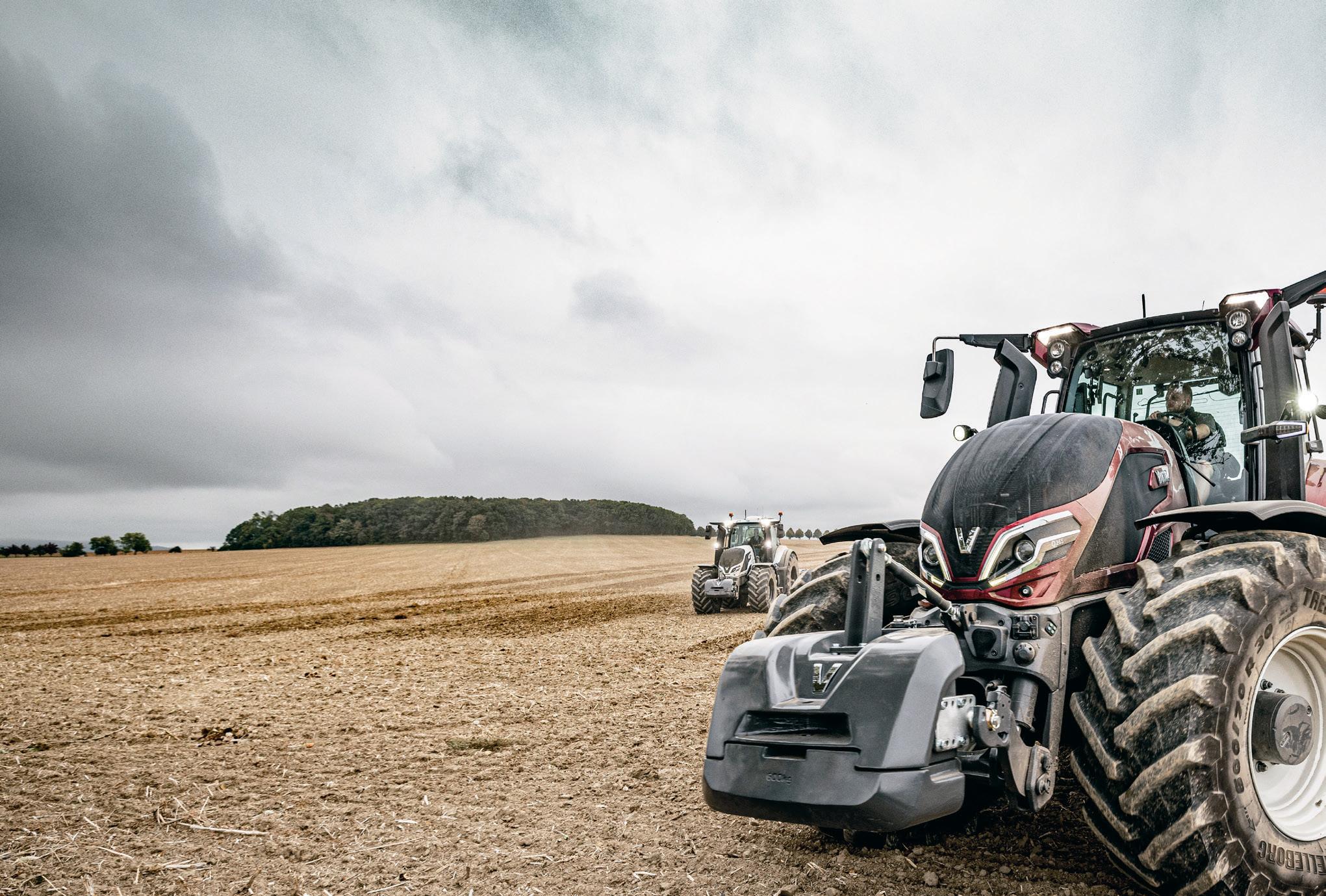
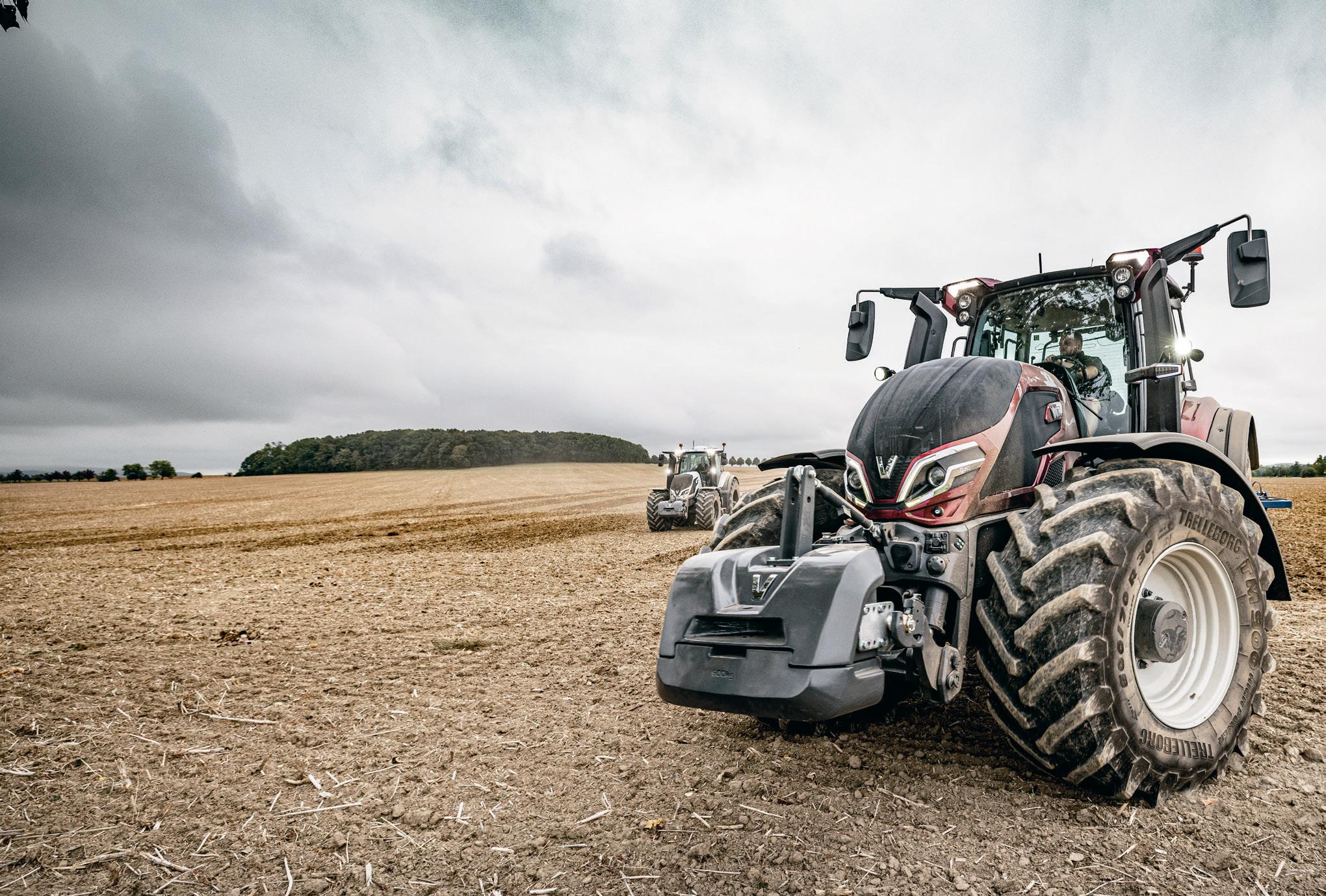
Let’s take a different approach and rule out our main export competitors. Australia doesn’t directly operate any
state farming. Neither does America, land of the free enterprise, although the Bureau for Land Development leases vast amounts of land to ranchers. I have found nothing of note for South America or the EU.
When it comes to states that do farm, it might be a very small party. Possibly just NZ, China, Lithuania and a few buddies.
So now what?
This would be the bit where I get to punch in with my opinion. Only I don’t have one. Some say that Landcorp should focus on its core business and work hard to be a better farmer – pick itself up by its bootstraps and be the best, most sustainable farmer that NZ has ever seen. Although looking at the international figures, it seems that SEOs lag behind private businesses the world over. Why
would Landcorp be the outlier?
Others say that Landcorp should focus more on innovation. Landcorp hasn’t done amazing so far, but that is what innovation is like – 99 ideas fail so that one can come along and blow the world away. However, I can’t ignore some of the uneasiness about some of Landcorp’s innovations so far. Setting up a milk drier against Treasury advice isn’t revolutionary. Neither is hopping on the coat tails of NZ sheep milkers. Sure Landcorp might be the first to milk deer, but why? The welfare concerns with milking an undomesticated animal must be extreme.
What else is there? Speed up the Treaty of Waitangi settlements? Switch to an American model and lease the land out? Plant it all in trees to give them a taste of their own medicine? It’s a hard shrug from me.
Country-Wide | AUGUST/SEPTEMBER 2023 39 Q SERIES 230 – 305 HP QUALITY AND POWER TO HANDLE ANY JOB. TALK TO YOUR VALTRA DEALER FOR MORE INFO TODAY. The all-new Q Series delivers power, practicality, precision and performance right on cue. Featuring intelligent design, smart technology, a 6-cylinder engine and an efficient CVT transmission, the Q series is the profitable and productive way to get the job done. valtra-anz.com VALTRA ® is a worldwide brand of AGCO
 Derek White walks out a line of standards in his winter crop.
Derek White walks out a line of standards in his winter crop.
SET STOCKING THE FLOCK
PHOTOS BY SARAH HORROCKS
Say Waiouru and we automatically think “army town”, but just down the road on the North Island’s Central Plateau, a couple is gaining top sheep fertility and growth rates in a tough environment. Tony Leggett reports.
Waiouru farmers Derek and Leanne White are proving that set stocking their flock almost the entire year delivers consistently strong sheep performance.
In their 2021/22 financial year, their management produced a 153% survival to sale outcome from their two-tooth and mixed-age ewes, and a 91% result for their mated ewe hoggets.
Their net income from sheep for that year was $180/sheep stock unit, nearly $10/ssu above the average for the top 25% of similar class farms compared through the BakerAg FAB analysis that year.
The Whites farm 3000 breeding ewes, split at mating time into a B flock of about 1000 mostly older and poorer constitution ewes mated to Poll Dorset or South Suffolk rams. They are mated two weeks ahead of the maternal A mob of 2000 mostly Romney ewes, which start lambing from September 20.
Most of the six-tooth and five-yearold ewes are quarter-Texel, quarterCoopworth ewes.
“The original genetics we started with were highly fecund but weaned small lambs and had low growth rates, so we introduced some composites to improve on this,” Derek says.
The composite rams they used produced meaty lambs and had good firstcross progeny, but then they began to lose fertility and started to see constitutional faults in the young sheep.
“We realised we were on the wrong track.”
Derek says that’s why they moved to Wairere Romney rams to straighten everything back up and give them the fertility and growth rates they were after.
“The rams we get from Derek [Wairere owner Derek Daniell] are certainly delivering that.”
Scanning percentages are returning to 190–200%, but to boost fertility over the 2021 and 2022 matings the Whites used the ovulation enhancer Ovastim in their younger ewes.
Scanning jumped from 168% the
Country-Wide | AUGUST/SEPTEMBER 2023 41
ONFARM
previous year to 195%, a pleasing outcome when lambing percentage is the single biggest contributor to profitability in a breeding system.
They chose not to do the two-tooths last year just to see where they naturally were. They scanned 190%.
“There’s a good 20–25% increase in two-tooths’ scanning percentage from using Ovastim, so where there is a genetic deficit, it’s well worth the money spent.”
Stocking rate for the farm is high for the altitude and contour at 12.1su/ha wintered (based on 1 ewe = 1su). The Whites believe in putting pressure on their sheep to help identify the best performers and cull heavily any repeat poor performers.
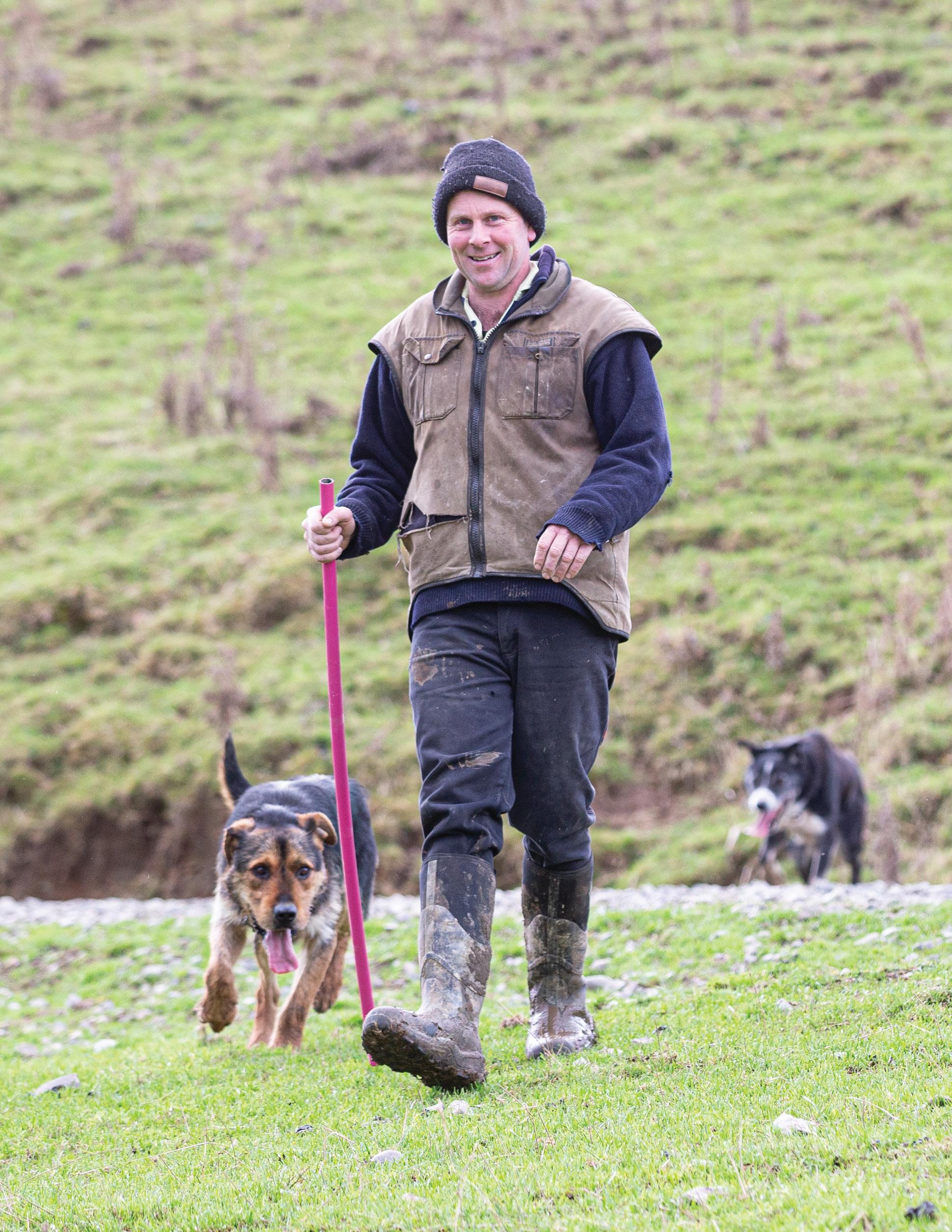
A weaning percentage of about 150% is optimal for the farm.
Derek says it has averaged 149% over the past seven years and been as high as 155% twice in that period.
“I’d rather avoid too many triplet lambs and run a higher stocking rate as this will always deliver more lambs per hectare.”
Aside from a short period leading up to mating and the first cycle, the ewes are mostly set stocked and shuffle grazed according to their condition. Typically, 80–90% of the ewes are in lamb by the end of the first cycle, so Derek starts to tighten them up to conserve feed heading into winter.

Using the gate
Regular drafting through satellite yards allows any ewes in lighter condition to be drafted off and run in a smaller mob with less pressure.
“The drafting gate in your yards is one of your most valuable tools.
“It doesn’t cost anything to use and you can consistently draft off any lighter stock as they pass the yards anytime.”
Derek says ewes are a bit like a jet boat. It takes a lot of time and energy to get up on the plane, but once they’re there, so long as they have scope, they seem to be able to maintain themselves on short covers.
He says a lot of winter feed can be wasted feeding fat ewes in a rotation system when the sheep are treated as one
Country-Wide | AUGUST/SEPTEMBER 2023
group. That feed can be used to raise the condition of lighter sheep within that group.
“If you jam a large mob of varying condition sheep into a small paddock, you soon create a tail of about 20% due to some sheep being less resilient than others.”
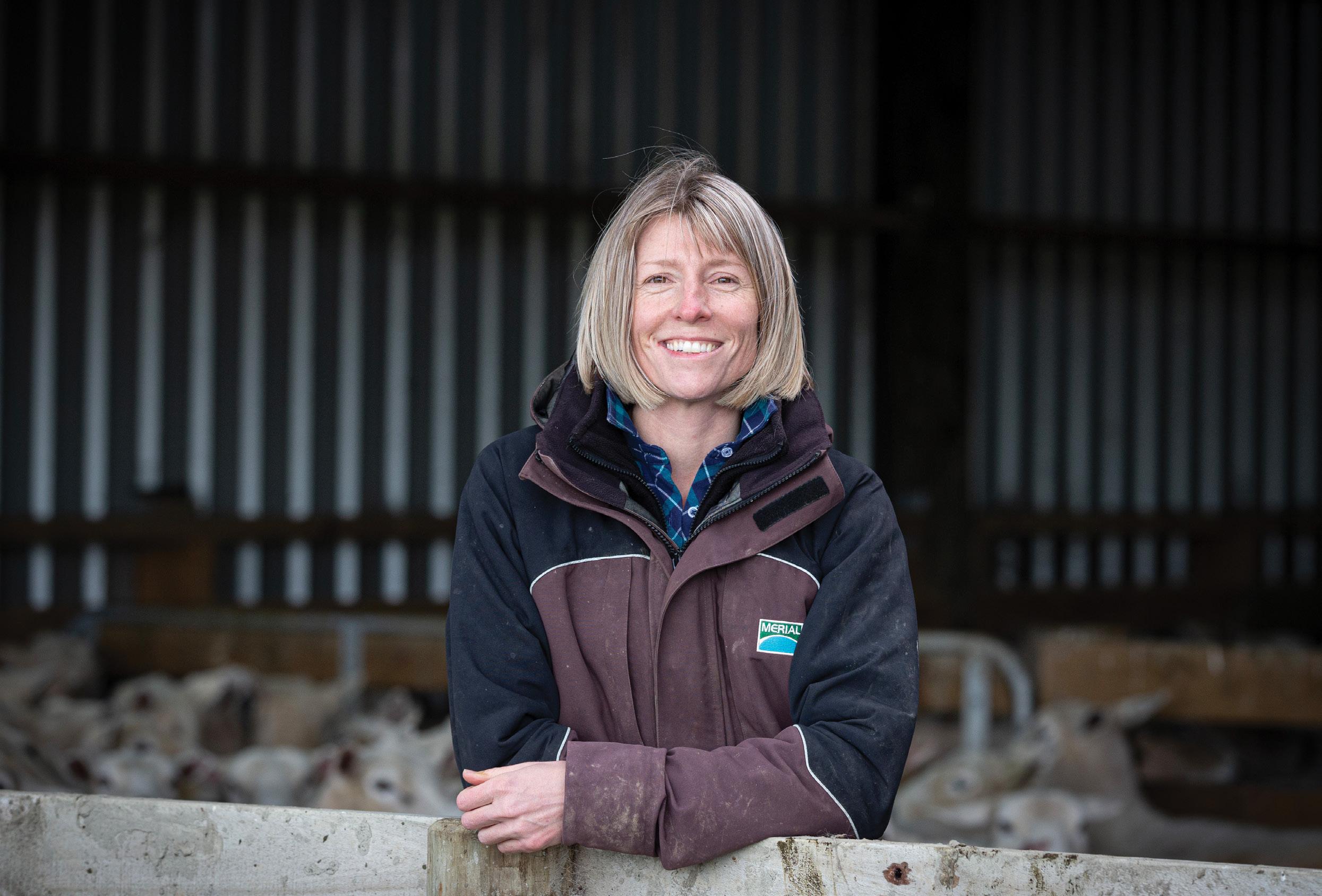
Farming at altitude with a high stocking rate requires a different approach, especially to get through the long winter months. It isn’t unusual to get three or four good snowfalls a year and frosts can make winters long and cold.
Derek says they have had snow any day of the year, from putting the terminal rams out early April to Christmas day.
“Five years ago, we had half a metre on the old woolshed roof which collapsed, so that was a bit of a bonus.”
He says they don’t get a lot of regrowth so once the grass is eaten, it doesn’t come back until spring.
Managing feed
Derek admits his feed management approach is more “seat of the pants” than formal feed budgeting. He cut his teeth on steeper hill country farms where there were limited paddocks, mainly larger in size. He learned to match feed demand to supply and keep it simple. The more variable climatic conditions in recent years also adds another layer of complexity.
“It’s easy to get tangled up with numbers, but you’re farming stock, not grass.”
He would rather have fat sheep and no
grass, but spread out, than skinny sheep on a rotation with heaps of grass in front of them.
“Sometimes a sheep’s biggest enemy is another sheep.”
The older B flock ewes are unscanned. The A flock ewes are scanned and triplets are identified. These are preferentially fed on pasture (with any tail-end ewes) until they are set stocked for lambing with the twin ewes.
There’s no daily lambing beat for the two-tooths or older ewes, other than picking up the odd cast ewe, but the inlamb ewe hoggets get a visit at least daily.
FARM FACTS: 470ha total, 435ha effective • 40ha flat, 60 easy rolling, 300ha medium hill, 60ha steep hill, 20ha forestry • 3000 breeding ewes, 900-1000 hoggets (mated) • Used ovulation enhancer in the younger ewes. • Scanning 195% and weaning, 153% • Average carcaseweight 16kg–18kg • 100–110 mixedage cows and 40 heifers, after Angus-type calves • 950mm rainfall average, 3–4 heavy snowfalls/year, regular frosts in winter, higher altitude climate • Fertiliser – pH range 5.7–6.1, Olsen P 20–29, K 9–17, Organic S 4–32
Country-Wide | AUGUST/SEPTEMBER 2023 43
i
Above: Leanne White is hands-on with the farming operation. Opposite page, top: A mob of mixed-age ewes in the yards. Opposite page, below: Derek White shifting a mob of mixed-age ewes with his dogs.
Winter kale crops are critical to carrying a high stocking rate through the winter. Timing is critical to yield and having their own equipment helps mitigate some of this risk.
About 2200 ewes will go on to crop for a month to spell the pasture in late winter ahead of lambing, strip grazing the kale behind three-wire electric fencing with a fresh break every two to three days depending on weather.
“You can waste a lot of crop in bad weather or when it’s wet, so we usually have a grass paddock alongside any crop to spell it if the weather turns.”
Between 900 and 1000 ewe hoggets are mated from May 10 and lamb on the farm’s flat and easier country. This is the most exposed and south facing, so hogget lambing percentages can vary greatly depending on southerly weather patterns.
go prime or store,” Derek says.
“The main criteria is dollars per head and there seems to be a point now where you can dump a lot of lambs that are 5–8kg lighter than works schedule in the autumn for a similar price.”
The second half of their terminal lambs go on to Pasja and are sold prime. Derek also aims to draft 25% of male lambs in the A flock prime at weaning to minimise the number that require shearing. “We typically shear about half of our lamb crop.”
Their usual mean kill date is January 25 but they had to play catch up this year by adding more carcaseweight to lambs to get the dollar outcome they were targeting for the second half of the season.
The Whites have used drench capsules extensively for many years. One year they
They operate a high replacement rate close to 30%, but it means two-tooths can be culled hard if they don’t catch back up from lambing. This requires grazing out between 100 to 150 dry hoggets to replace deaths and maintain numbers each year.

All ewe hoggets are given the chance to get in lamb to about 20–30 homebred terminal ram lambs left entire for the purpose.
The Whites aim to wean the terminalsired lambs pre-Christmas and kill half-prime off their mothers, even if that means killing down to a lower carcaseweight. Minimum weight at weaning for slaughter is 34–35kg liveweight, depending on the lamb.
Average carcaseweight across the season is typically between 16kg–18kg depending on season and if any store lambs are sold.
“There’s a lot of winter traders chasing autumn lambs these days, so we’re not too hung up on whether they
trialled not using them and had to put a lot of weight on their ewes to get them back into shape for mating. It wasn’t ideal in the dry summer that prevailed.
They regularly monitor for resistance to drench-active ingredients and have deliberately run a large number of ewes without capsules to create the refugia mob, known to reduce the onset of resistance.
Sorting the cropping
Crops and new grass are crucial to maintaining the high winter stocking rate.
Using mostly their own gear, the Whites have been cropping and regrassing up to 40ha each year.
About 15ha of Regal kale grown annually allows 2200 mixed-age and twotooth ewes to get a month off grass in late winter, allowing lambing paddocks to freshen up ahead of the due date.
Ewe hogget mating performance and sale lamb finishing to target
44 Country-Wide | AUGUST/SEPTEMBER 2023
“The main criteria is dollars per head and there seems to be a point now where you can dump a lot of lambs that are 5–8kg lighter than works schedule in the autumn for a similar price.”
The five-year-old covered yards make life easy for Derek and Leanne White as they draft ewes.
carcaseweight are underpinned by 5–10ha of Pasja and 10–15ha of new grass, depending on the paddock rotation. They have used swedes in the past instead of kale for extra tonnage, but Derek believes they don’t deliver the same high protein forage for ewes pre-lamb.

The wet autumn this year created some challenges for returning summer crops back to new grass and also impeded growth of the kale crops. However, the moisture delivered a growthy summer and early autumn so
the Whites carried more feed into winter than normal to cover the loss from their poorer kale crops.
Their new grass cultivar preferences are Rohan ryegrass and clovers on the steeper paddocks and Shogun and clovers on the easier top country.
Costs to establish the kale crops have increased but Ruapehu Farm Supplies agronomist Tane Knight recently prepared a gross-margin analysis for the Whites that showed it was still a costeffective choice.
It showed a 10 tonne/ha crop was
costing 10c/kg drymatter (DM) but had increased this year to 13c/kg DM. An 8t/ ha crop now costs 15c/kg to establish.
He says crops are the cheapest form of winter feed for the Whites, when compared to putting on nitrogen with a truck at 19c/kg DM and summer crops now up to 20c/kg DM.
They’ve completed one rotation of suitable paddocks on the farm, starting with the steepest slopes first and moving through the easier country. All crops are sown with 250–300kg/ha of Cropmaster with Boron boost.
Country-Wide | AUGUST/SEPTEMBER 2023 45
The Whites are also making a transition to reactive rock phosphate (RPR) for their maintenance fertiliser and this will be applied in the autumn. Some of the change is price driven, but there is also a genuine shift to minimise nitrogen use at scale after they had previously applied DAP in the spring.
Their plan is to apply an RPRsuperphosphate blend for two years to transition to a full RPR product in
following years. This year they plan to reduce the phosphorus (P) component back to 18 units/ha to shave a little off the cost and allow fertiliser prices to settle down a bit.
All their new grass and balage paddocks get 230kg/ha of potash/DAP/ Sup (26:30:60:34). All crops are sown with 250–300kg/ha of Cropmaster plus Boron boost.
Dickie Direct territory manager Zara
Cattle sale policy changes
The Whites have been fine-tuning their cattle enterprise over the past few years with a shift in bull genetics and sale policy for progeny.
McFadzean Meatmaker bulls are the sire choice for the Whites’ 100–110 mixed-age cows, but they are now selecting more compact traditional Angus-type bulls after earlier buying
bigger Simmental-Angus bulls that delivered impressive growth rates in their progeny but increased frame size in their heifer progeny.
Derek says the more compact black, Angus-type calves are also proving popular with store market buyers.
Between 30 and 40 rising-two-year heifers are mated to a low birthweight
van Hout says the rainfall level and pH of soils suit the use of RPR on the farm. She says P levels range from 20 to 25 and will support the transition to RPR over time. To overcome the soil’s natural sulphur (S) deficiency, extra S will be applied with the maintenance fertiliser. Derek says the move to RPR should reduce the risk of nutrient run-off in high rainfall events in the first 100 days after application because it is less soluble
Angus bull and calve behind a wire. Any dries are finished and sold to the domestic beef market.
Calving in the main mob starts from October 15, spread among the ewes in their lambing paddocks and coinciding with the usual spring flush. They had previously sold their sale calves at weaning, but with a mean
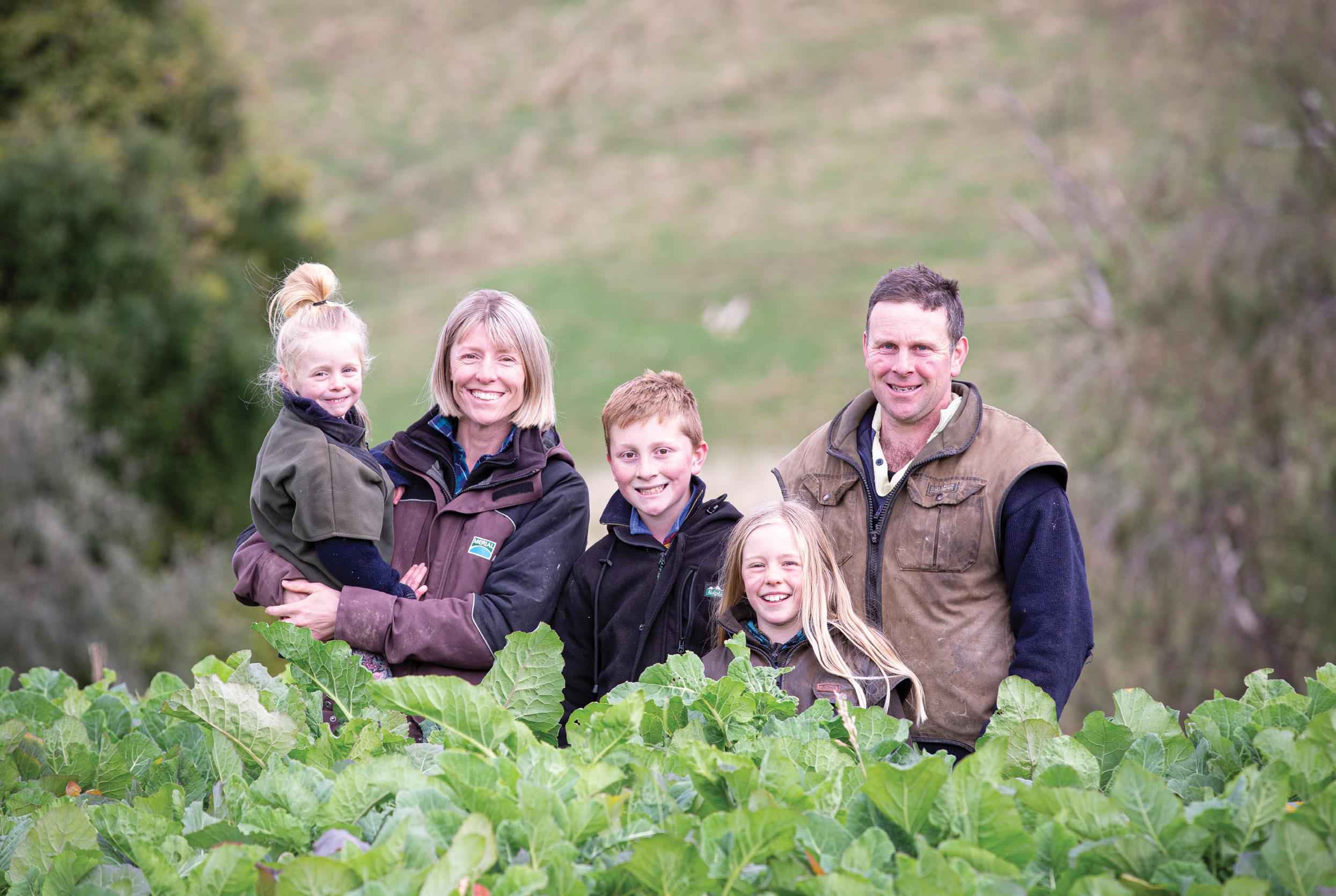
46 Country-Wide | AUGUST/SEPTEMBER 2023
than superphosphate.
“It compares favourably with superphosphate in terms of unit cost of P, and we feel this is a great mitigation tool to reduce nutrient loading on our waterways too.”
He’s also hoping the RPR’s small calcium carbonate content will offer some reduction in liming costs in the future. (See more on RPR p80)
The Whites have also been embracing Ravensdown’s new spreading technology, HawkeEye, which helps top
dressing pilots and ground spreaders keep fertiliser out of sensitive areas, particularly waterways.
Improving water quality
The Whites are part of the Rangitikei River Catchment Group, set up to encourage community involvement in projects to monitor and enhance water quality.
“It’s a good concept. We all want to see the waterways improve in quality so we’re building up our own data set,
doing nutrient budgets and investing in projects that we think will make a difference.”
They have been involved in Horizons
One Plan initiative for the past decade and have completed 5km of fencing along waterways and stock exclusion zones, retired 5ha of native bush and established three wetland areas.
The Whites believe all this extra work enhances the aesthetic properties of the farm for future generations and gives them credibility around their social licence to farm when faced with criticism. They are also hoping it helps educate the non-farming voting public.
Poplar planting on high-risk areas has also been completed in the past decade, along with scattered planting for soil stabilisation and shade for livestock.
Teamwork is crucial to the success of Derek and Leanne White. Both have full-time roles on the farm and share equally in most of the farming activities. Working as a team means the operational and financial management of the business is shared between them, creating flexibility around workload and family commitments.
calving date of mid-November they decided to sell later. Their male calf crop now leaves the farm as yearling steers after a winter break-feeding on the flats and supplemented with home-grown lucerne balage. This gets them to about 300kg liveweight by early spring.
“The spring market can be very fickle, and it only takes one poor large
sale for the whole market to fall over. This can also work in reverse if it is a grass market,” Derek says.
“If we can get a $400 margin from weaners to yearlings in wintering them, then we believe that this delivers a good margin for the work involved. It also makes sense for us with our later-born calves.”
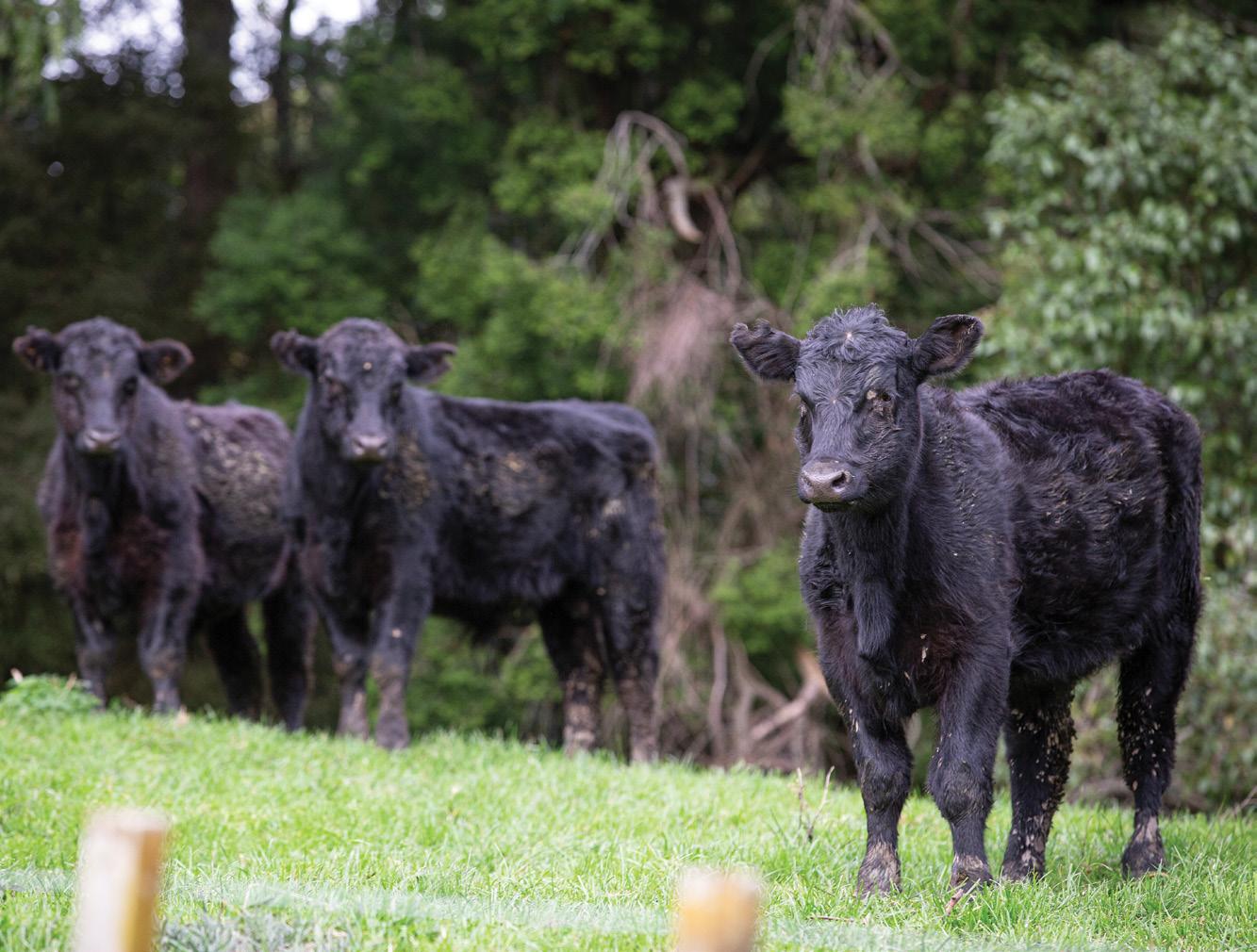
They are also experimenting with
keeping between 15 and 20 of their male calves and killing them before the second winter. The terminal genetics have helped with this.
From 60 heifer calves born each year, 50 go to the bull as yearlings and typically 45 scan in-calf.
In their 2021/22 financial year, their cattle delivered net income of just under $100/cattle stock unit.
Country-Wide | AUGUST/SEPTEMBER 2023 47
Opposite page: (From left) 4-year-old Jess, Leanne, 11-year-old James, 9-year-old Kate and Derek White. Left: Meatmaker weaner cattle.
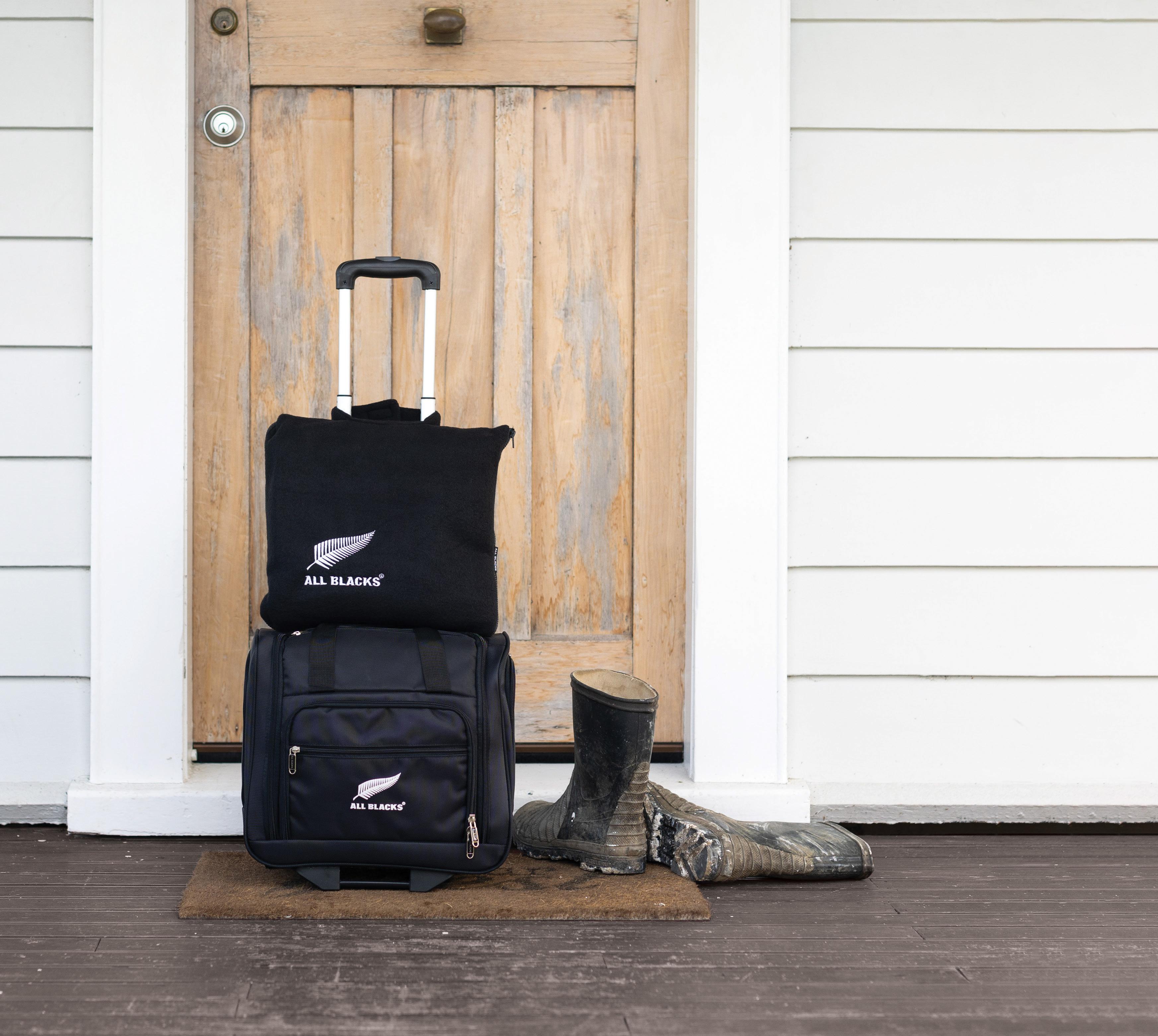
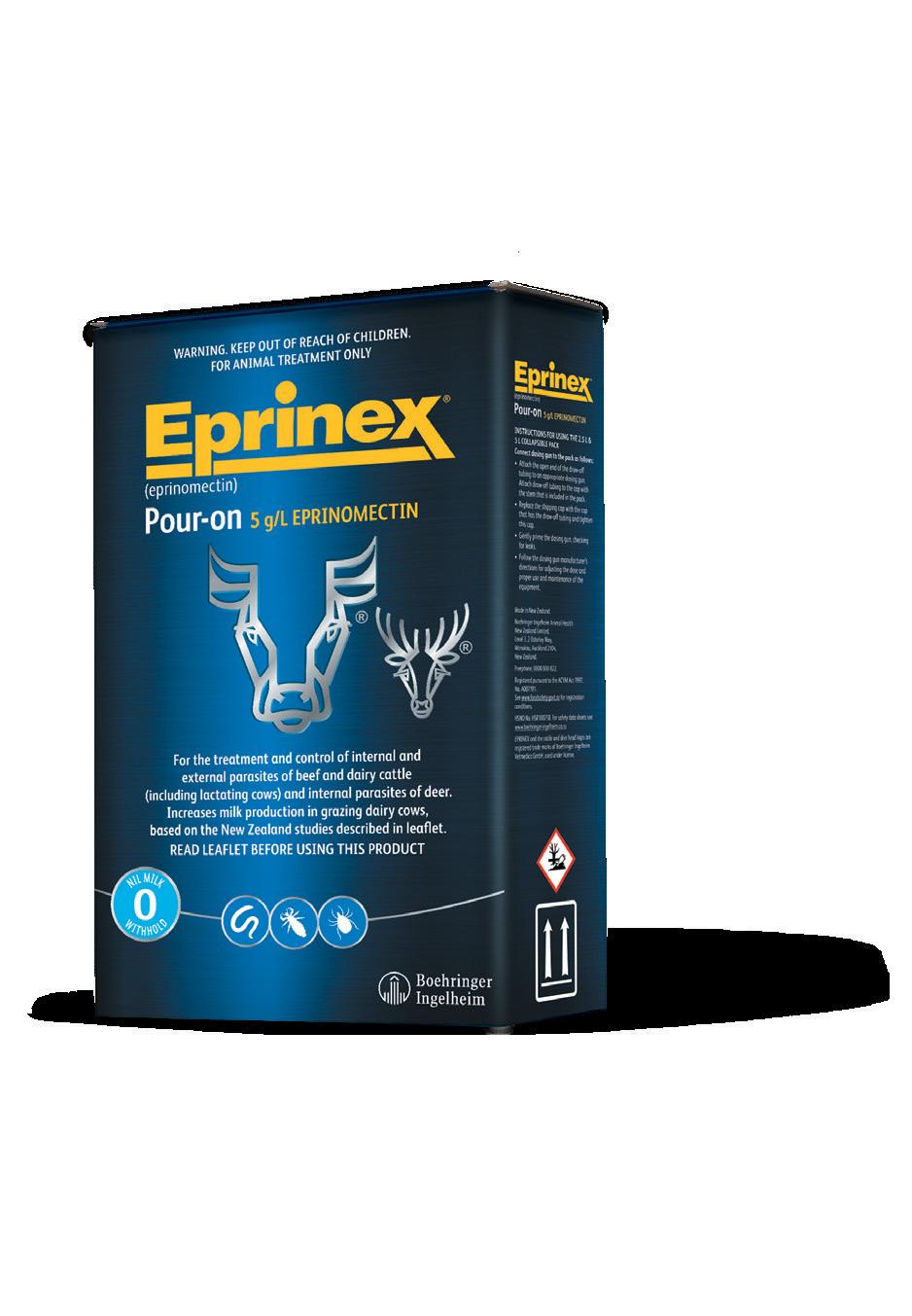

48 Country-Wide | AUGUST/SEPTEMBER 2023 LET’S GO! Never miss a match with this ultimate ALL BLACKS ® travel bag and cushion set yours with selected EPRINEX ® this season! *Promo ends 30th September 2023. Ask in clinic for qualifying products. PROUDLY AVAILABLE FROM YOUR LOCAL PARTICIPATING VETERINARY CLINIC See product label for full claim details and directions for use. Boehringer Ingelheim Animal Health New Zealand Limited. Level 3, 2 Osterley Way, Manukau, Auckland, New Zealand. EPRINEX® is a registered trademark of Boehringer Ingelheim Vetmedica GmbH, used under licence. Registered pursuant to the ACVM Act 1997, No. A007191. © Copyright 2023 Boehringer Ingelheim Animal Health NZ Ltd. All rights reserved. ALL BLACKS® is a registered trademark of New Zealand Rugby Union Incorporated NZ. NZ-CAT-0023-2023. futureproducers.co.nz Ensure young stock become future high producers through improved health, growth and energy at: Scan here to calculate the R.O.I. on your herd...
It also has the added advantage of minimising the need for outside casual labour with most of the farm tasks such as fencing, cultivation, and development work completed in-house.
Their farm White Ridge is 470ha (435ha effective) of hill country just south of Waiouru. It was originally farmed as two similar sized blocks,
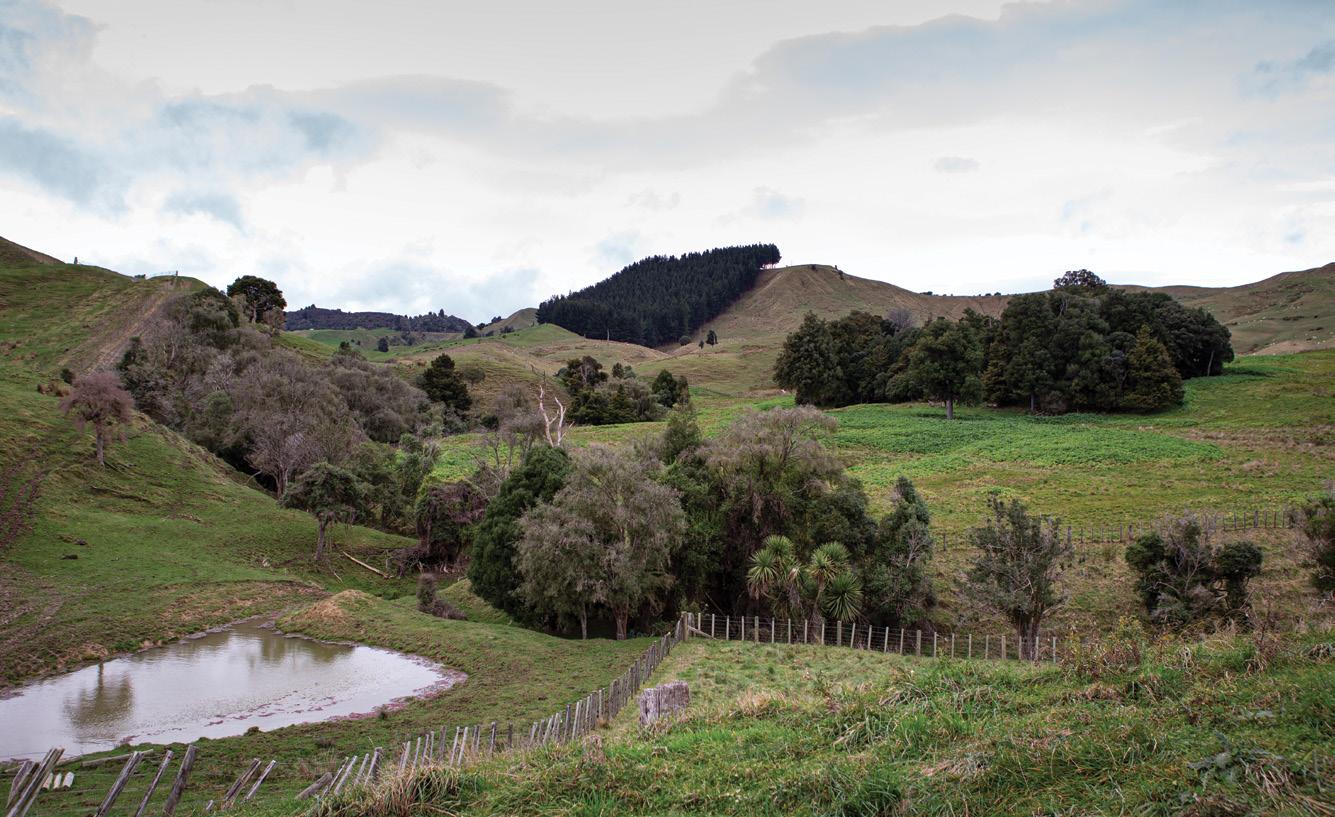
one by Derek’s family until his parents bought their neighbour’s farm in the late 1980s following the withdrawal of subsidies.
Derek’s passion for a life in farming included two years at the renowned cadet training school at Smedley in Hawke’s Bay, followed by shepherding around Wairarapa, Hunterville and
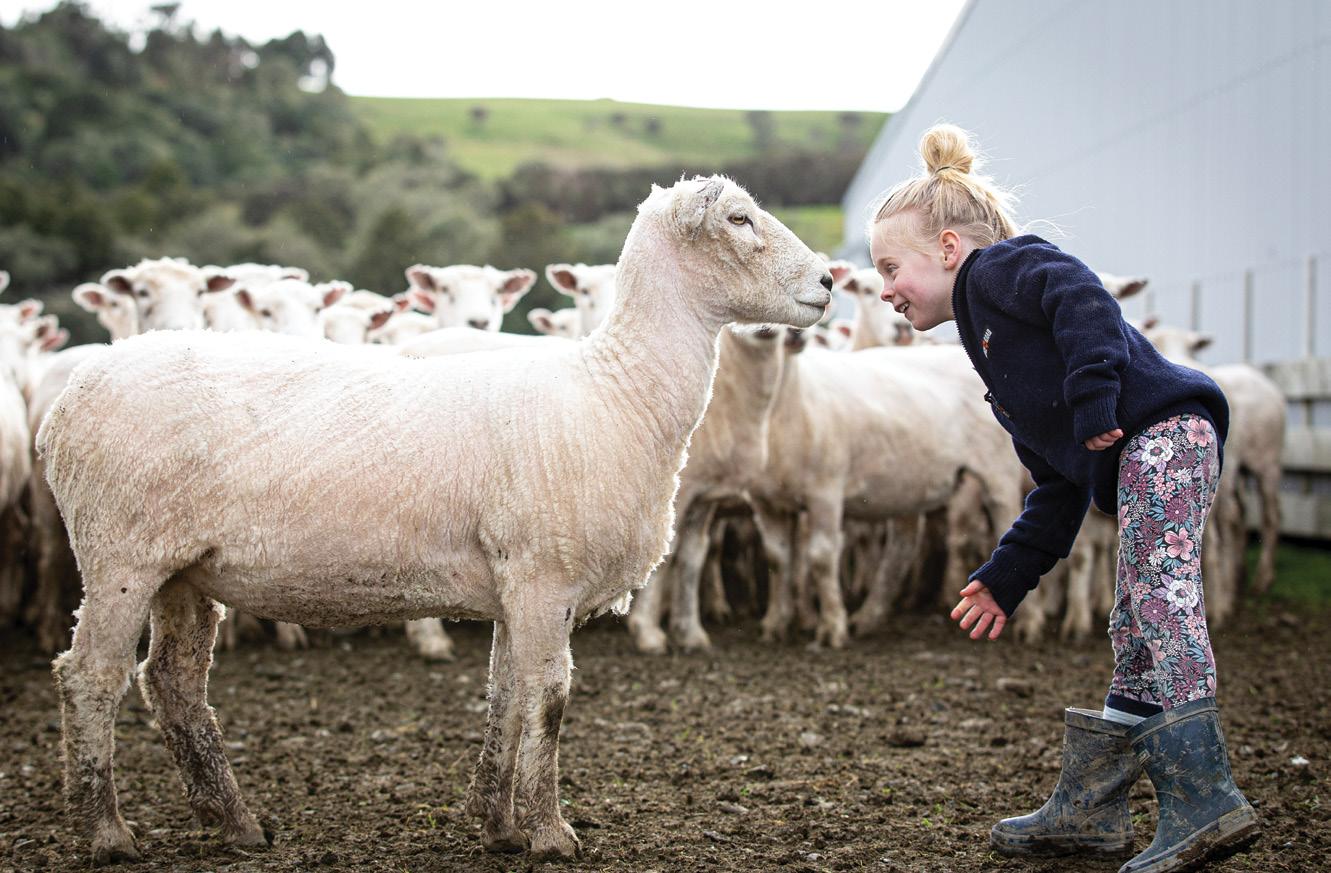
Taihape areas before heading to Lincoln University in 2002 to complete a Diploma in Farm Management, graduating with Distinction the following year.
After Lincoln, Derek managed a 2000ha block near Hunterville for four years, then spent a year in North America driving trucks and working on cattle feedlots and ranches.
Leanne grew up on a sheep and beef farm near Masterton. She completed a Bachelor of Nursing degree in 2005. She worked at Palmerston North Hospital in the fields of medical, surgical and emergency nursing, followed by a short stint working in Australia. After meeting Derek she made the move to the Rangitikei and began working at Taihape Health, in practice and district nursing roles, and on her days off helped out on the lease block she and Derek had just acquired.
The ownership goal
As a couple, they were determined to get into farm ownership from the outset. Their plan began in 2005 with buying a 2.5ha block of land in the upper Pohangina Valley. They sold this in 2008; a good stepping-stone towards buying the stock and plant for a 150ha lease block at Mangaweka that they leased for the next six years. The couple say having debt at a young age was a great motivator and a good compulsory saving scheme.
They added leasing the 470ha home farm from 2010 to 2014 and managed to pay off the stock and plant debt over that four-year period before buying the property in July 2014 and relinquishing the Mangaweka lease at the same time.
“We were fortunate to have an opportunity from my parents to farm the home property, but this would never have been realised unless there was a well-devised plan and significant capital brought into the equation,” Derek says.
Their farm succession plan began after meeting with succession specialist Phil Guscott at a local Beef and Lamb Day. After listening to Phil’s seminar a
Country-Wide | AUGUST/SEPTEMBER 2023 49
Below: An area of retired native bush and wetland on the farm. Four-year-old Jess White with Poppy the pet ewe.
SUPERIOR BULLS CREATE SALEABLE CALVES.
Proven calving ease, white face recognition, great temperament. Select using reliable data for growth rates and strong carcass quality. It pays to capture the Hereford X advantage.
To find out more about buying a registered Hereford bull, view our breeders online sale catalogues at herefords.co.nz
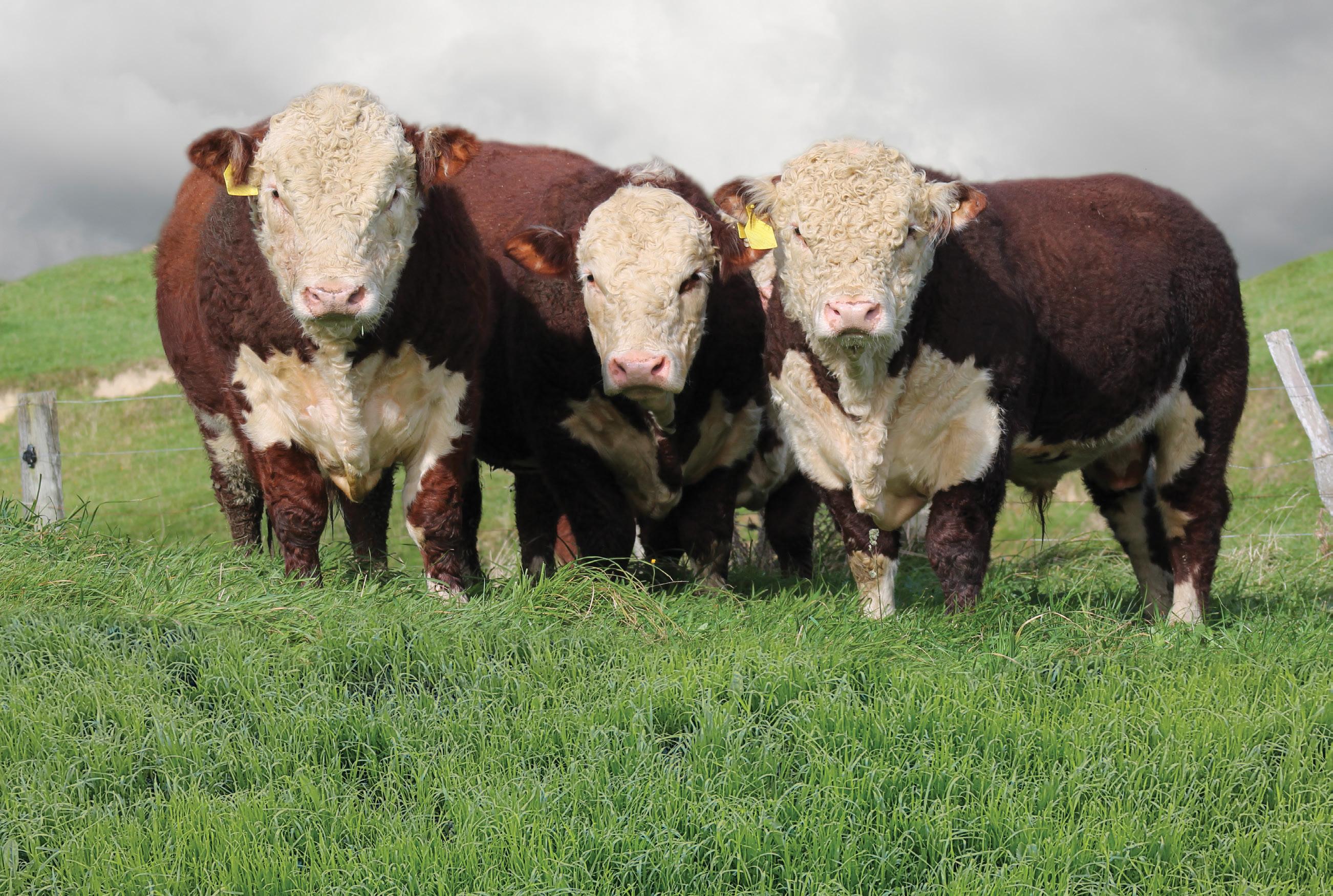
50 Country-Wide | AUGUST/SEPTEMBER 2023
Otengi
Kaeo
AUGUST 31 Waimaire &
Hereford Studs,
Marua
Willowspring
Otorohanga, Private Treaty
Maranui Hereford Stud Waihi
Kokonga/Bluff Hereford Stud, Glenbrook
Craigmore Hereford Stud, Ohaupo
Colraine Hereford & Kanuaka Hereford Studs, Ohaupo
Charwell Hereford Stud, Whakatane
Shadow Downs Hereford Stud, Waverley
Mahuta Hereford Stud, Drury
Kairaumati Hereford Stud, Thames
Hurstpier Hereford & Horizon Hereford Studs, Waitara
Riverton Ezicalve Hereford Stud, Fordell
Maungahina Hereford Stud
Riverlee Hereford Stud
Ezicalve Morrison Farming, Marton
Shrimpton’s
Bushy
Hereford Stud, Te Awamutu
Bexley Hereford
Mokau
SEPTEMBER 1 Matapouri Hereford Stud,
1
Herefords,
7
8
11
12
13
13
15
21
21
21
23
26
26
27
Hill Herefords, Cave 27
Downs
29
Stud,
OCTOBER 3 Matariki Hereford Stud, Kaikoura 4 Bluestone Hereford Stud, Cave 12 Kane Farms Herefords, Tapanui 18 Pyramid Downs Hereford Stud, Gore www.herefords.co.nz
couple of times, and with a bit of gentle persuasion from Derek, Phil agreed to be involved.
“What Phil said in his seminar was a bit of a lightbulb moment for me.
Derek says they had to get him involved. He was instrumental with his experience and advice.
“This would have to be some of the best money we’ve ever spent.”
The past 10 years have mainly been about debt consolidation and development of the farm asset, as well as bringing up their three children (James, 11, Kate, 9 and Jess, 4).
A more recent goal they’ve achieved is asset diversification, including investing in property off the farm to diversify income streams and provide equity for their own farm succession.

“This has had the added benefit of significantly improving our work-life balance as well,” Leanne says.
Useful networks
The Whites also rely on their wider networks, particularly their farm accountant Trevor Young and ANZ banker Scott Mitchell.
Derek has always supported discussion groups and feels the opportunities to engage with similar-minded farmers who offer honest appraisal of a farm business and its management is beneficial to their success.
“I find the discussions are awesome and I’m always asking questions and looking for feedback and knowledge.”
Derek also got a taste of the power of benchmarking and discussion groups while working in the Wairarapa and was determined to link up his farm’s data to see how it compared.
The Whites were keen participants in the establishment of a local Red Meat Profit Partnership discussion group because they knew the power of peer
participation. It has been providing financial data so that each farm can benchmark itself against others in the group. “For a cost of $400–$500 a year, this is a powerful tool.”
Derek says by learning to analyse the data, a farmer can build a picture of an individual’s businesses strengths and weaknesses and where their potential opportunities may lie.
The feedback from the judging of the previous year’s Red Meat Farmers competition, when the Whites were runners-up, was also very powerful. Leanne says intentionally working on the business, not just in the business, was a key take-home from the earlier competition judging session.
“Time off the farm to reflect on goals was another,” she says.
That means booking holiday dates in advance and sticking to them.
Country-Wide | AUGUST/SEPTEMBER 2023 51
Derek and Leanne White drafting a mob of mixed-age ewes in the covered yards.
DEALING WITH SICK CALVES
Paul Muir of On-Farm Research knows a lot about sick calves – what causes illness and effective treatments –but he’s still had problems.
Most problems occur in very young calves and by the time calves are two or three weeks old and eating pellets the incidence of problems drops dramatically. An early indicator of a problem is often scouring. There are three possible causes – stress, nutritional (both management issues) and infectious agents. The cause is often difficult to identify, but the number and timing of calves scouring can be a clue.
• More than 40% calves scouring: often an indication of a milk problem. It may not be curding, the concentration may have been mixed wrongly, or too much is being fed.
• Between 5% and 40% calves scouring: often an indication of cryptosporidia infection, caused by a protozoa that’s widespread in calf sheds, particularly affecting calves up to 10 days old. The infection builds up over a few days and can affect a significant number of calves in the shed. The treatment is to remove from milk and feed electrolytes for a day.
• Fewer than 5% calves scouring: often the sign of something more sinister – particularly if calves go down very quickly. Consult your veterinarian. Potential culprits are rotavirus and salmonella. Isolate and
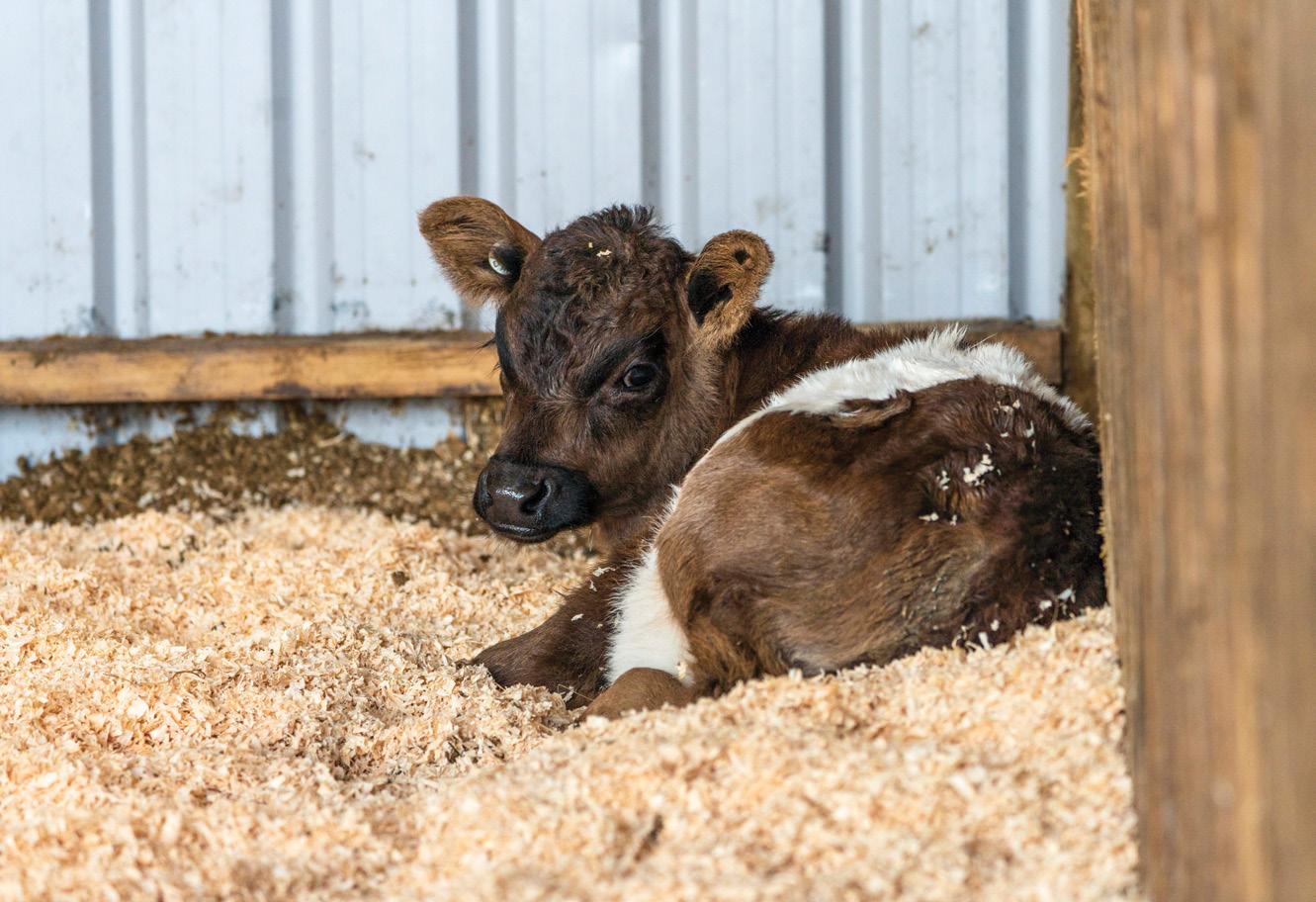
treat with electrolytes. Salmonella is caused by a bacterium and can be treated with antibiotics. If it’s a recurring problem on the property then young calves can be vaccinated. Often rotavirus and salmonella are secondary to a cryptosporidia infection, which makes treatment more difficult.
STRESS SCOURS can be caused by difficult birth, bad or sudden change in weather, transport, environment (e.g. over-crowding, cold, damp, draughty or humid conditions inside calf sheds). Even changes in staff and hygiene can increase the likelihood of scours. The stress of transporting calves from the sale yards or from one farm to another may be sufficient to cause scours if calves are offered milk on arrival. Feed new arrivals with an electrolyte.
NUTRITIONAL SCOURS is caused by overfeeding or by a rapid change from colostrum/milk regime to a milk powder regime. Nutritional scours is due to inadequate milk digestion in the abomasum (fourth stomach). This means the milk leaves the abomasum too early and overloads the intestine with lactose. This results in a watery scour and the fluid loss results in a very dehydrated calf.
INFECTIOUS SCOURS is caused by a range of pathogens including cryptosporidia, coccidia, salmonella, E coli and rotavirus. But generally, the better the immunity obtained from colostrum, the better the calf copes with disease challenges.
ROTAVIRUS is the biggest animal health issue facing calf rearers, with some reporting death rates as high as 30%. It’s devastating and demoralising – for calves and rearers. Antibiotics are ineffective. Treatment with large volumes of electrolytes is labour intensive and time consuming and not always effective. Even if the animals do recover,
52 Country-Wide | AUGUST/SEPTEMBER 2023
ANIMAL HEALTH
they will still shed large numbers of virus particles into the environment, potentially infecting healthy calves. Recovered calves grow slower and are more susceptible to other diseases, and calves can become reinfected. It is persistent in the environment and can remain infectious for many months at room temperature. It can withstand low temperatures and high humidity on non-porous surfaces such as plastic and concrete.
Spreading and signs
Rotavirus affects calves up to three weeks old and is spread primarily by calves ingesting faecal matter containing virus particles, but it can also be inhaled, particularly if the shed is highly contaminated. Infected animals shed large quantities of the virus into the surrounding environment, contaminating the shed area and increasing the risk of other animals being infected, spreading at a rate typically between 24 and 48 hours after infection.
The most obvious sign of rotavirus in calves is a pale-yellow scour, often
rancid smelling, this leads to rapid fluid and electrolyte loss and, therefore, dehydration. Rotavirus initially needs to be confirmed with a lab diagnosis but rearers who have already experienced it are likely to identify the presence of rotavirus very quickly.
The key is to identify infected calves very fast, isolate at the start and treat promptly with electrolytes. Make sure you have good hygiene to reduce the rate of spread. At every feed it is important to cast an eye over each calf to identify any potential signs of illness. These may include:
• Hanging back from the feeder/ reluctance to come in and feed
• Reluctance to drink, fussing with teat, coming off teat
• Wet tail, pale-yellow scour –sometimes will be watery/and bloody.
Most calves that die of rotavirus die from loss of water and electrolytes, rather than the direct action of rotavirus. Rapid treatment with electrolytes is critical. Scouring continues until the villi inside the small intestine are again covered with mature cells that allow
HOW DOES ROTAVIRUS KILL CALVES?
Rotavirus infects and destroys mature cells on the tip of the ‘villi’. Villi are the tiny, finger-like projections on the surface of the small intestine that help absorb nutrients from the digestive tract.

Damage to these cells not only reduces absorption of nutrients from milk and electrolytes, but results in fluid loss from the intestine, further compounding the level of dehydration. It is this dehydration that kills calves. Rotavirus increases the concentration of calcium in the intestinal cells which acts like a toxin and results in the pale-yellow scour associated with rotavirus.
the resumption of normal digestiveabsorptive processes.
Don’t stop feeding milk but don’t mix electrolytes and milk at a single feed. It is important to keep the calf’s energy levels up, as well as continuing to provide the calf with antibodies to fight the virus. Many electrolytes contain sodium bicarbonate that alter the pH in the digestive tract and adversely affect milk absorption, so milk and electrolytes should be fed at least two hours apart. Animals may continue to shed the virus in their faeces while not showing clinical signs. Calves do not become “immune to rotavirus” and they can get re-infected. However, the second infection is usually a lot less severe.
Country-Wide | AUGUST/SEPTEMBER 2023 53
Treatment of scouring
Feeding electrolytes to scouring calves is labour intensive but it is critical to maintain fluid levels. Scouring and dehydrated calves need to have the lost fluid from scouring replaced on top of their normal fluid intake.
If a 40kg calf has lost 10% of fluid it will need four litres just to replace the water it has lost. While the recommendation to stop milk feeding for 24 to 48 hours remains true for nutritional scours, the recommendations for infectious scours has changed in recent years. Now the belief is that it is important to keep feeding at least some milk to calves especially if they will still drink.
Electrolytes provide energy but no protein and removing milk for any length of time reduces the ability of the
calf to fight infection. If milk is withheld for longer than two days the epithelial cells in the gut become dysfunctional and when milk is introduced, the milk itself can cause scouring as it cannot be digested.
Scouring calves can lose up to five litres of fluid each day including mineral salts essential for normal body function which is why it is usually the dehydration and acidosis that kills the calf.
Recommendations are to feed milk and electrolytes separately – with at least two hours between the two. If the electrolytes and milk are mixed or fed too close together the milk will not curd and this will increase the level of scouring. Therefore, the electrolytes needed to be administered as extra feeds. This also means that the calf is
getting fluids on a more regular basis maximising the potential absorption of the poorly functioning gut. While electrolytes can be tube fed, it is much better if the calf will drink the milk so that the milk bypasses the rumen via the oesophageal groove.
How do we prevent it?
There is no silver bullet, although vaccinating cows against rotavirus and then feeding calves with colostrum and milk from these calves in the first 24 hours helps. This provides the calf with some passive immunity against rotavirus. Unfortunately, the passive immunity declines in the days after birth and there is a risk period between five and 14 days before the calf’s own immune system is functioning properly. Nevertheless, the more rotavirus
Our portfolio of powerful, proven products has helped farmers from one end of the country to the other create and maintain thriving businesses, and has earned us a reputation as New Zealand’s brassica protection specialists. Visit corteva.co.nz to view our range of online brassica resources.

54 Country-Wide | AUGUST/SEPTEMBER 2023
Visit us at corteva.co.nz ®, ™ Trademarks of Corteva Agriscience and their affiliated companies. COR-CTA0053
HERBICIDE Arylex™ active HERBICIDE POWERFLO™ Versatill™ INSECTICIDE Jemvelva active Sparta™ INSECTICIDE Qalcova active Naturalyte™ Entrust™ SC INSECTICIDE Isoclast™ active Delivering a complete suite of crop protection solutions for today’s forage brassica growers. Watching
Samuel
over your brassica crop so you don’t have to.
Whitelock – Plant Science Graduate, Lincoln University.
antibodies a calf gets from colostrum and the older it is before it is challenged by rotavirus, the more likely it is to survive. Feeding milk from vaccinated cows will help prevent the development of rotavirus.
Hygiene reduces the environmental contamination. Spray your shed every three or four days with a virucide solution throughout the risk period (i.e. until the youngest calves are two weeks old). Many solutions are suitable for spraying over calves. Thoroughly clean out the shed at the end of each season and spray with a virucide solution.
Maintain a high standard of cleanliness in the shed and thoroughly clean and disinfect equipment such as feeders, especially equipment used in the sick pen. A bucket of virucide can be kept handy to soak bottles and teats.
Minimise equipment (including gumboots) and movement between pens with sick animals and uninfected pens especially at the start of an outbreak – once the outbreak is in full flight the shed is contaminated so it is less important. Initially, try to isolate sick calves away from healthy calves to avoid contamination – this also helps manage the extra feeds of electrolytes.
Keep a close eye on who is coming into the calf sheds and try to avoid contamination from other farms. Minimise the number of visitors to your shed in the middle of a rotavirus outbreak. If calves are coming from a number of sources, pen calves from the same farms together and group calves according to age.
Our experience
Last August we had 435 calves in the shed sourced from supposedly vaccinated herds. There were new arrivals up to calves that had been in the shed for 21 days.
Within three days of the first case of rotavirus being diagnosed, it had spread through the shed, with some calves in each pen affected. Younger calves were hit the hardest, but the older the calf the greater its chance of surviving and
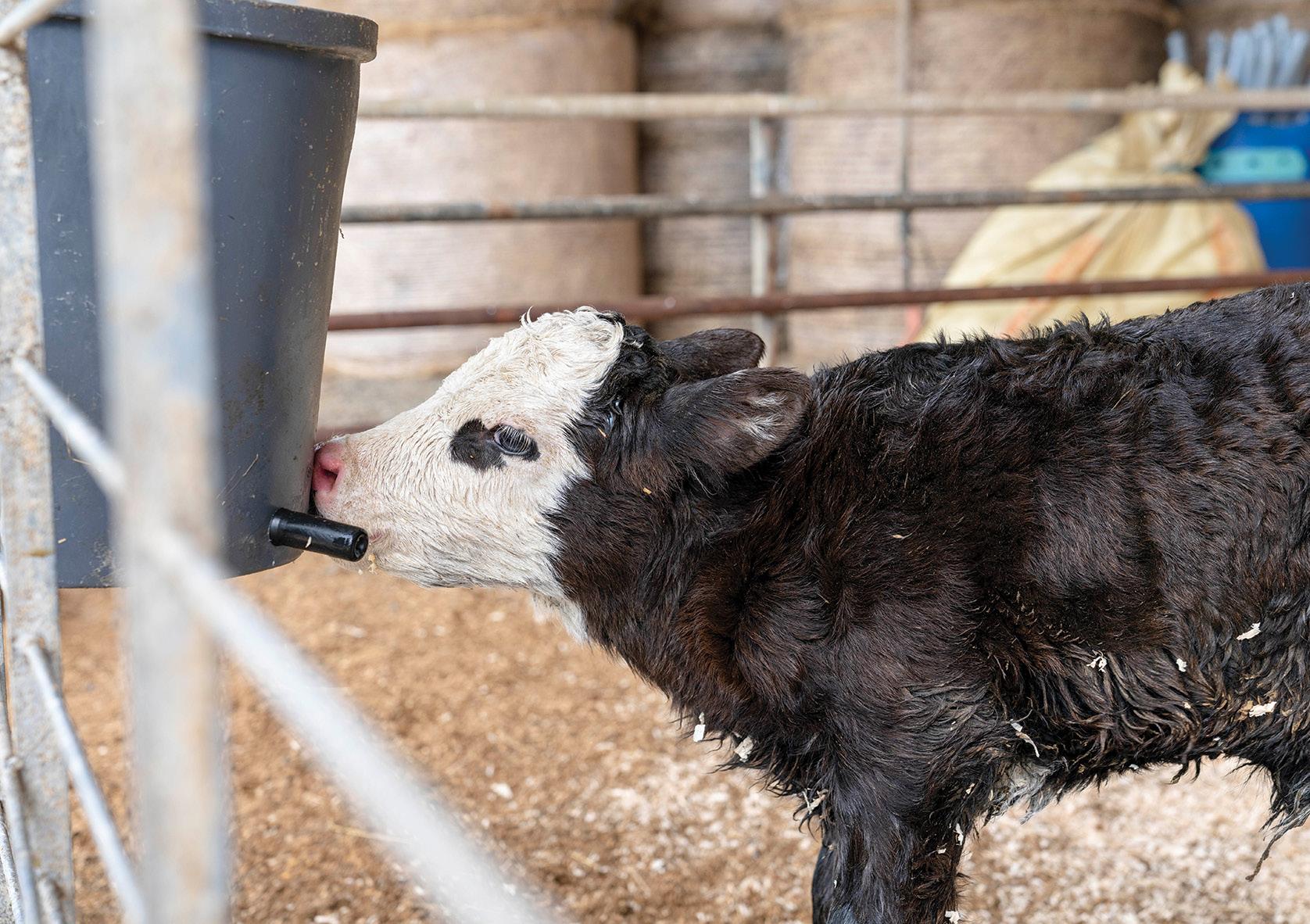
we had no deaths in the calves over two weeks old. In total, 46% of the calves we reared were affected and at the peak we were treating over 80 calves.
The shed was obviously so contaminated that it was not practical or worthwhile to isolate calves, so we concentrated on dealing with the problem. Most calves were on a oncea-day milk feeding system and we continued to feed milk in the mornings.
Any calf that we had any reservations about got a blue neck band so that we knew to monitor it. Any calf that had a wet tail got a pink band and was fed electrolytes in the evening.
Where the majority of the pen had pink bands, it was just as easy to feed electrolytes to all the calves in those pens as the other calves were likely going to need it soon anyway. Any calf that was wobbly, wouldn’t feed or down got a
red band and was taken to the sick pen. In total, 8% of calves were taken to the sick pen and 44% of the sick pen calves subsequently died. Overall, shed mortality was 5.4%. Calves in the sick pen were fed milk in the mornings and electrolytes at midday and evening (either by tube or bottle). Generally, calves in the sick pen need as much electrolytes as you have time to get into them.
Within 10 days, we had worked our way through the worst of the outbreak but any new calves that were brought into the shed went down within 48 hours despite regular spraying of the shed. We put new calves into a completely different shed. We also had three outbreaks of salmonella in the shed. The affected pens were treated with antibiotics and no calf died from salmonella.
Country-Wide | AUGUST/SEPTEMBER 2023 55
Maintaining a high standard of cleanliness in the pens helps to reduce contamination.
“...the older the calf the greater its chance of surviving and we had no deaths in the calves over two weeks old.”
PHOTOS BY ALEX WALLACE
AWARD WINNERS AT WAYTEMORE
Rick and Shirley-Ann Mannering run an integrated sheep and beef farm and two dairy operations just south of Auckland and they’re making big strides to remove pests from their bush bordering the Hunua Ranges.
By Glenys Christian.
The Mannerings report on each entity individually, aiming for efficient and profitable performance, but decisionmaking is based on what will give the best result for Waytemore Farms as a whole.
They wanted to integrate the whole farming operation across the dairy and sheep and beef farms under one farm manager, so in a staged process they bought dairy herds and changed to contract milkers on the dairy farms.
They now run 860 Friesian cows and 360 replacements, with the three-year average milksolids (MS) production 274,846kg and the best achieved, 311,119kg MS. They’re milked through two herringbone dairies, once-a-day milking when required, due to factors such as cow condition, the season and production levels.
“We generally dry off in May,” Rick
says. “But stock may be staggered with some drying off earlier, depending on conditions, and some that are not in-calf may be milked through longer.”
The Mannerings have also made significant changes in the way the sheep and beef farms work, with a move away from the previous trading model where weaners were bought in February and advantage taken of any opportunities to buy other stock at good prices. Now the dairy cows are effectively the breeding herds for the beef farm, providing all the 720 dairy beef stock to be raised.
The rising two-year-old dairy replacements are synchronised in September for AI with low birthweight Friesian semen in the first week of October. At an average weight of 263kg, about 52% take to AI, so this is followed up with proven low estimated breeding value birthweight and good calving ease yearling Hereford bulls from their long-
term supplier, Mahuta Herefords at Glen Murray. The bulls go in with the heifers for 10 weeks, pregnancy testing takes place in February, then they’re returned to their respective herds on June 1 to calve. This starts anywhere between July 10 and 20, aiming for a condensed period with a mean calving date about August 16. The last cows to calve are between September 10 and 20.
Shirley-Ann says they aim for a 20% replacement rate, with dairy heifer calves weaned at 110kg then transferred to the drystock farm at the end of November or early December.
“We want to grow out dairy replacement heifers to an optimum weight for mating so they return to each dairy farm as top condition, well-sized in-calf heifers.”
Under an animal health programme developed with their vet, dairy beef calves are brought to a rearing facility on
56 Country-Wide | AUGUST/SEPTEMBER 2023
ONFARM
Rick and Shirley-Ann Mannering not only took out four titles in the Auckland Ballance Farm Environment Awards they also won the Supreme Award.
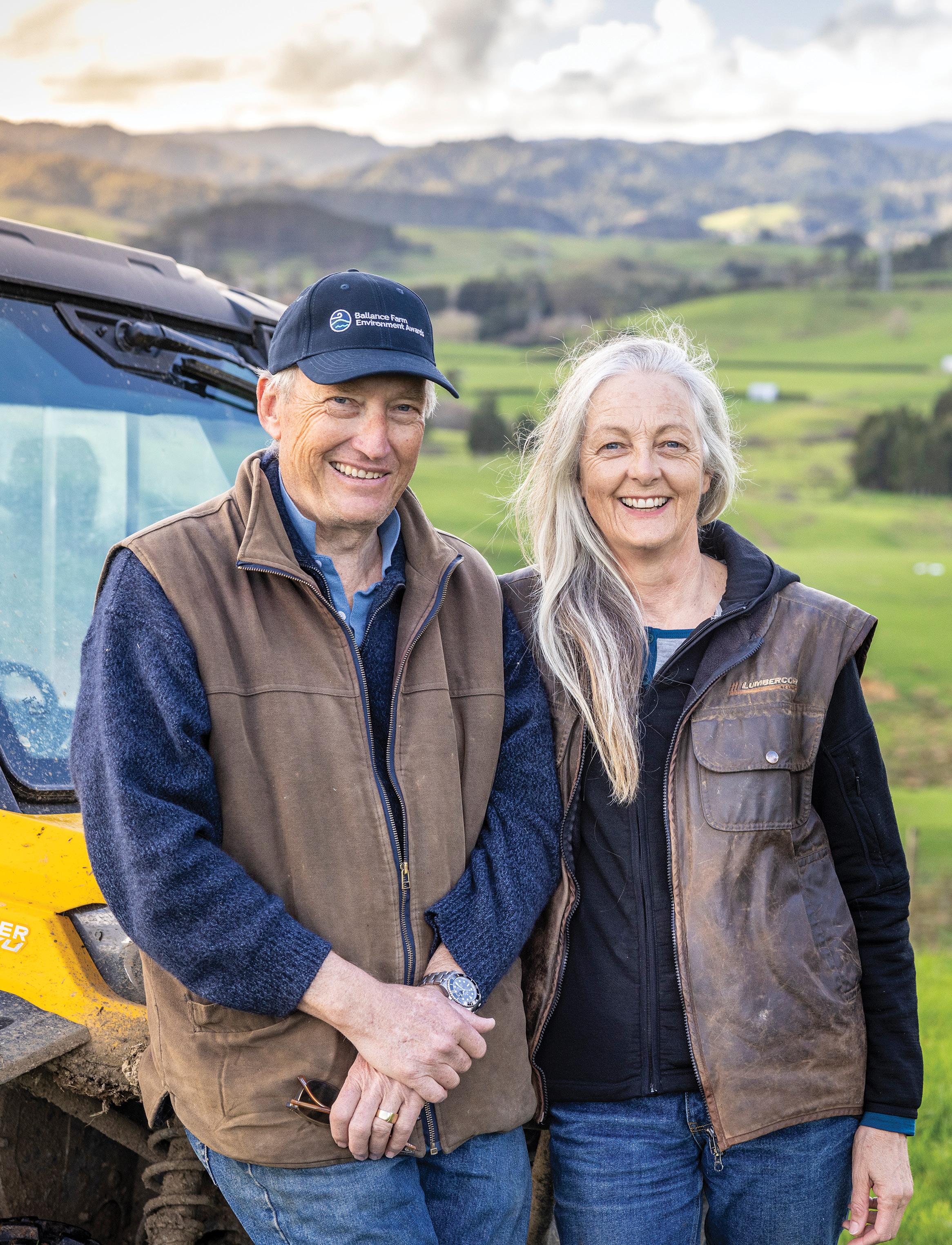
the sheep and beef farm, weighed, NAIT scanned and given a multimin vaccine. Then they’re placed in dedicated plastic tunnel pens at 10 calves a pen. They’ll stay in that group in the same pen for their first month, being fed milk twice a day with Fibre Gain, a fibre-meal combination, for three weeks.
At 4–5 weeks old the calves go out into a paddock in mobs of 40 where there are free-standing shelters from bad weather. They still get the fibre meal and milk once a day. They will be weaned off milk at 8–10 weeks old, staying on the fibre meal until they’re fully feeding on grass.
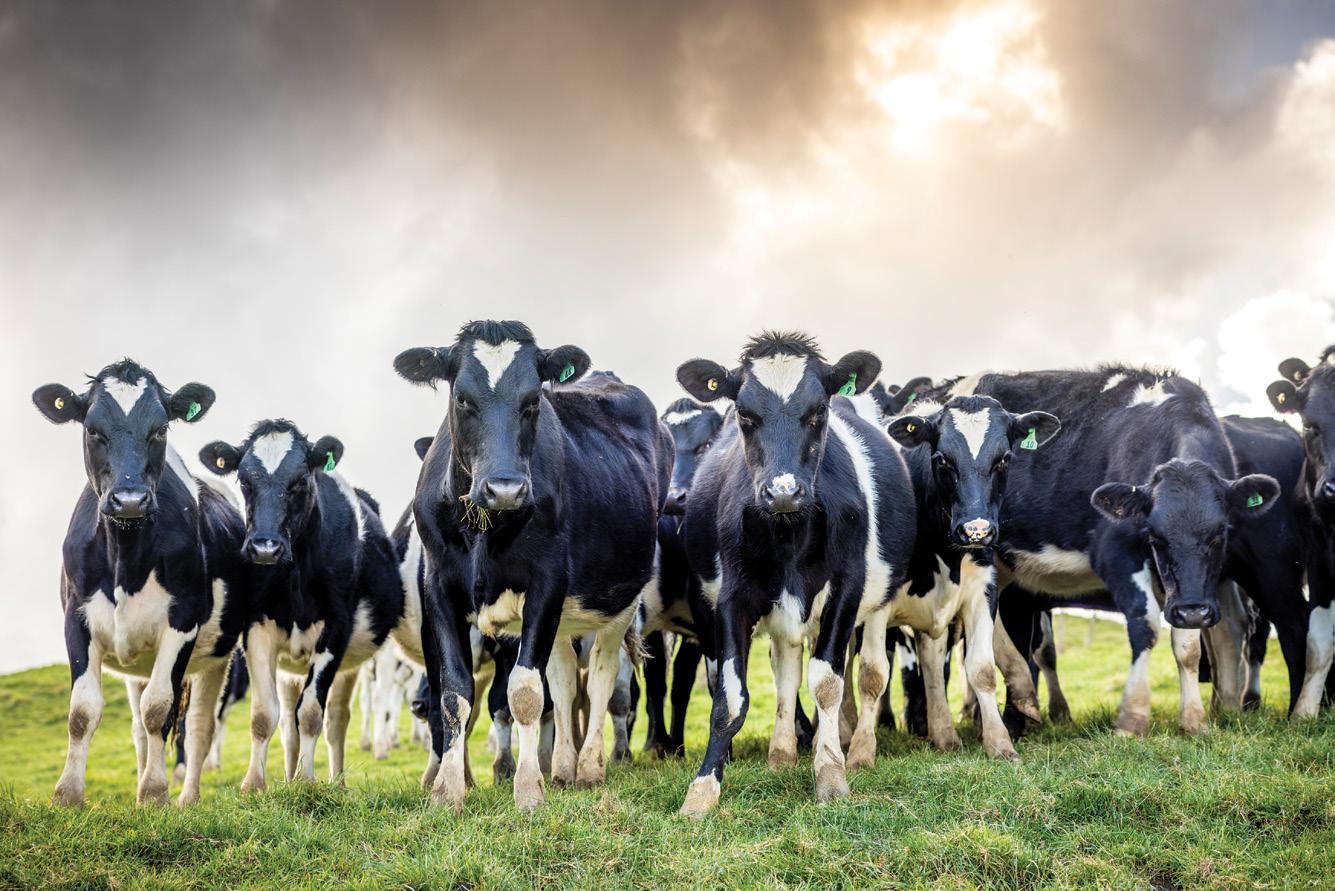
Calf health and growth rates are monitored regularly with them being weighed and drenched every four weeks. Their weights are recorded in MINDA and they’re given leptospirosis and bovine viral diarrhoea vaccinations. For their beef operation, Hereford-
Cropmark Seeds are focused on developing high performance forage varieties that offer farmers very real performance advantages, through improving their livestock performance, farming systems and bottom-line results.
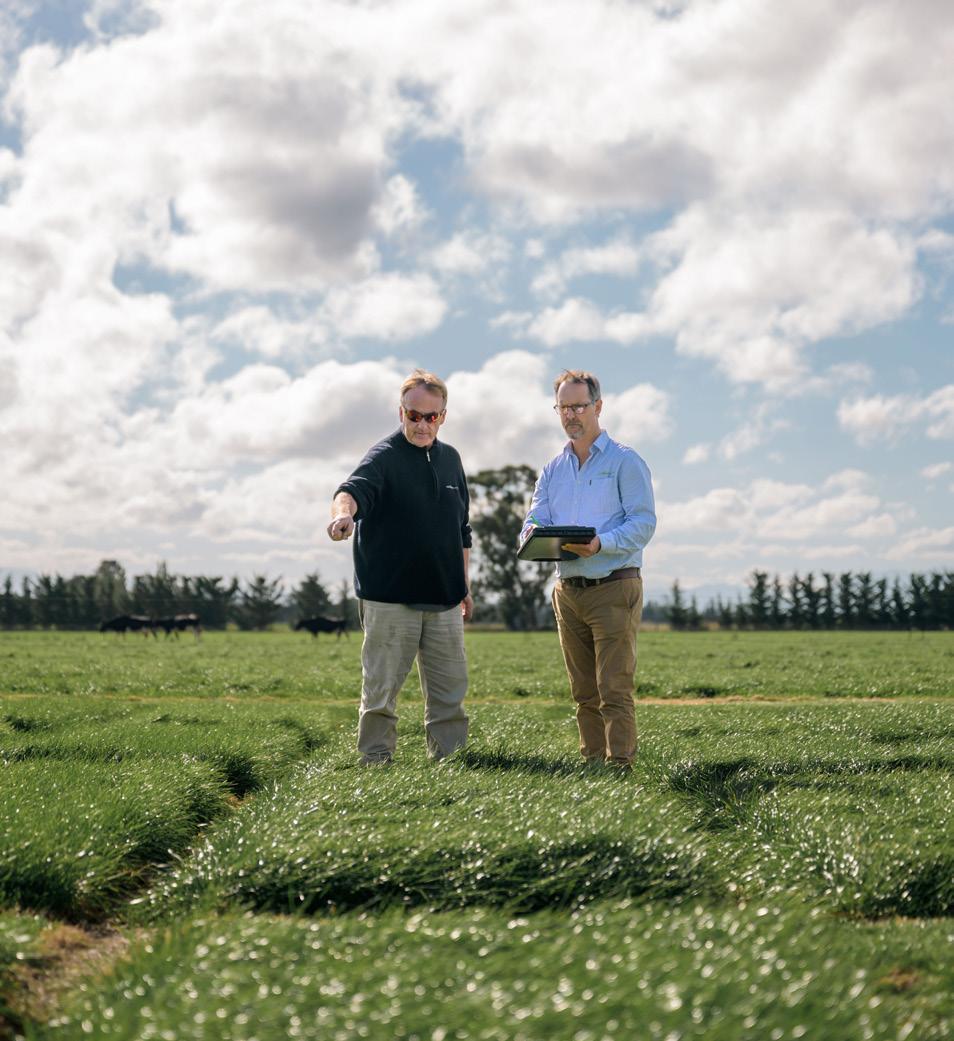
Cropmark’s unique varieties are bred with the emphasis on delivering improved yield, higher nutritional values and disease resistance, coupled with the ability to provide more quality forage when most needed.
Varieties developed by the company are thoroughly trialed and tested on farms to assess their performance capability under varying real-farming conditions prior to their commercialisation, evaluating factors such as yield, forage quality and disease resistance and persistence.
58 Country-Wide | AUGUST/SEPTEMBER 2023
freephone 0800 427 676
www.cropmarkseeds.com
Cropmark Seeds your New Zealand owned forage plant breeding and supply company.
Yearling heifers are grown out to an average mating weight of 263 kilograms.
cross dairy calves and Friesian bull calves are picked up regularly on Mondays and Thursdays from the dairy farms. The top cut of about 60 Friesian bull calves are sold at weaning, usually in December at weights between 110 and 115kg. The remainder are carried through to the following spring and sold as yearlings. Hereford-cross steers and heifers are retained and go onto a beef-cattle rearing programme after weaning to be finished between two and two-and-ahalf years old; average weights this year were 283kg carcase weight for the steers and 229kg for heifers. If there’s a feed pinch point then some stock may be sold as store cattle.
“This means they’re not going through the saleyards as calves so there’s no stock truck journeys until they go off farm for sale.
“We know their life histories with all the details, such as weighing and drenching dates and vet services they’ve received. So they’re happy and healthy stock until they’re finished.”
The yearling Hereford bulls that are brought in to cover selected mixed-age dairy cows are sold at about three years old.
Change of genetics
The Mannerings reduced sheep numbers to 2000 mixed-age ewes in 2016 and moved to Wairere Challenger rams to improve lambing percentage, increase weaning, growth and carcaseweights, and boost facial eczema tolerance after a couple of bad seasons. Rams usually go out from February 15 but their 500 replacement hoggets are not mated as there is usually no surplus feed to get to them to 40kg.
“Our aim is to produce a good twotooth ewe that has lambed, rather than a hogget that’s been underfed and won’t grow out,” Rick says.
FARM FACTS: Waytemore Farms, south of Auckland • 1455ha (1180ha effective)
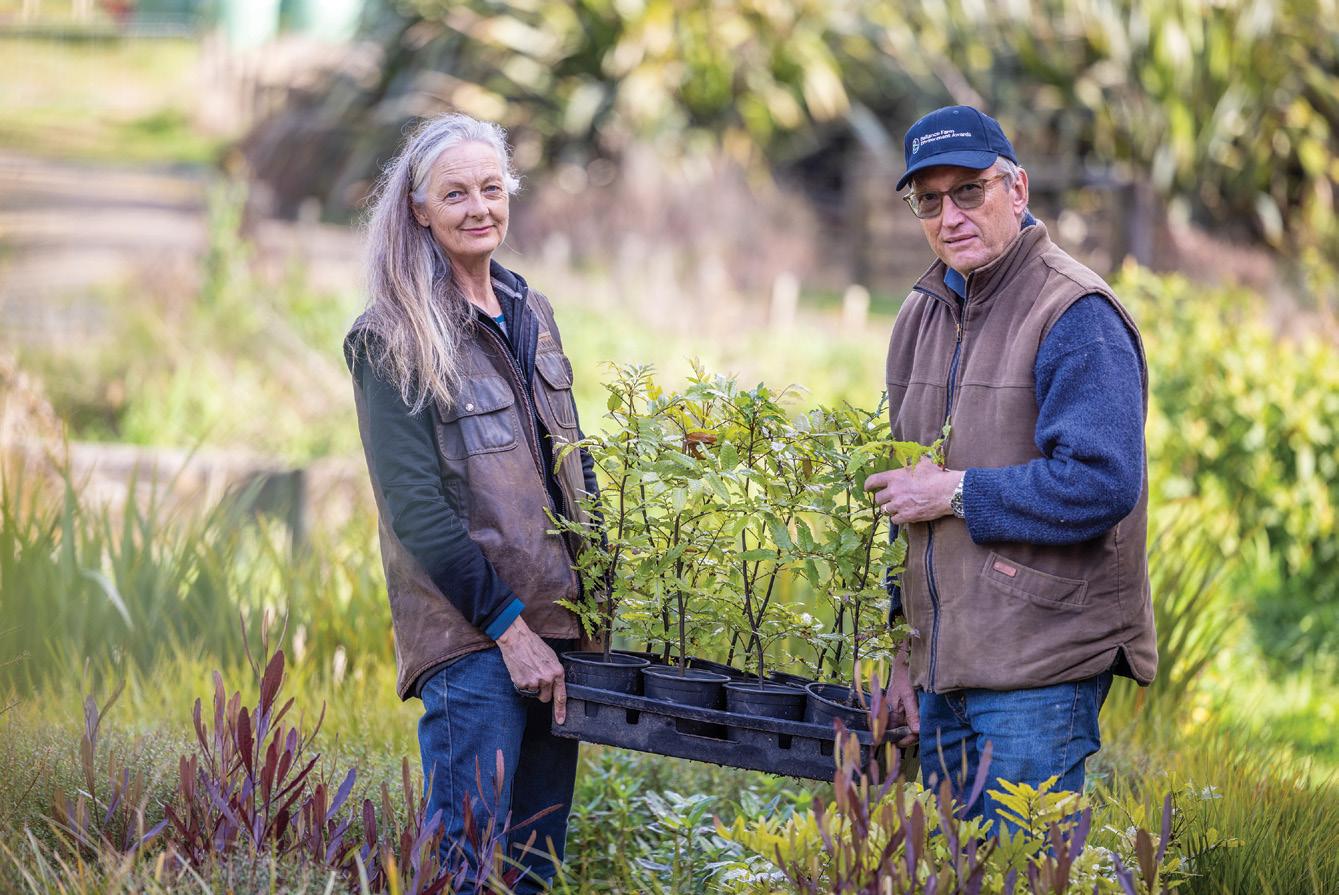
• 1800 Romney ewes and 500 replacements • 720 Friesian-cross and Herefordcross beef cattle • 860 Friesian dairy cows and 360 replacements with young stock grazed on the sheep and beef farm • 130ha mature native bush, forest remnants and kahikatea stands, 60km of waterways and 35km riparian fencing
• Extensive pest and predator trapping programme • The Mannerings did not provide financial information.
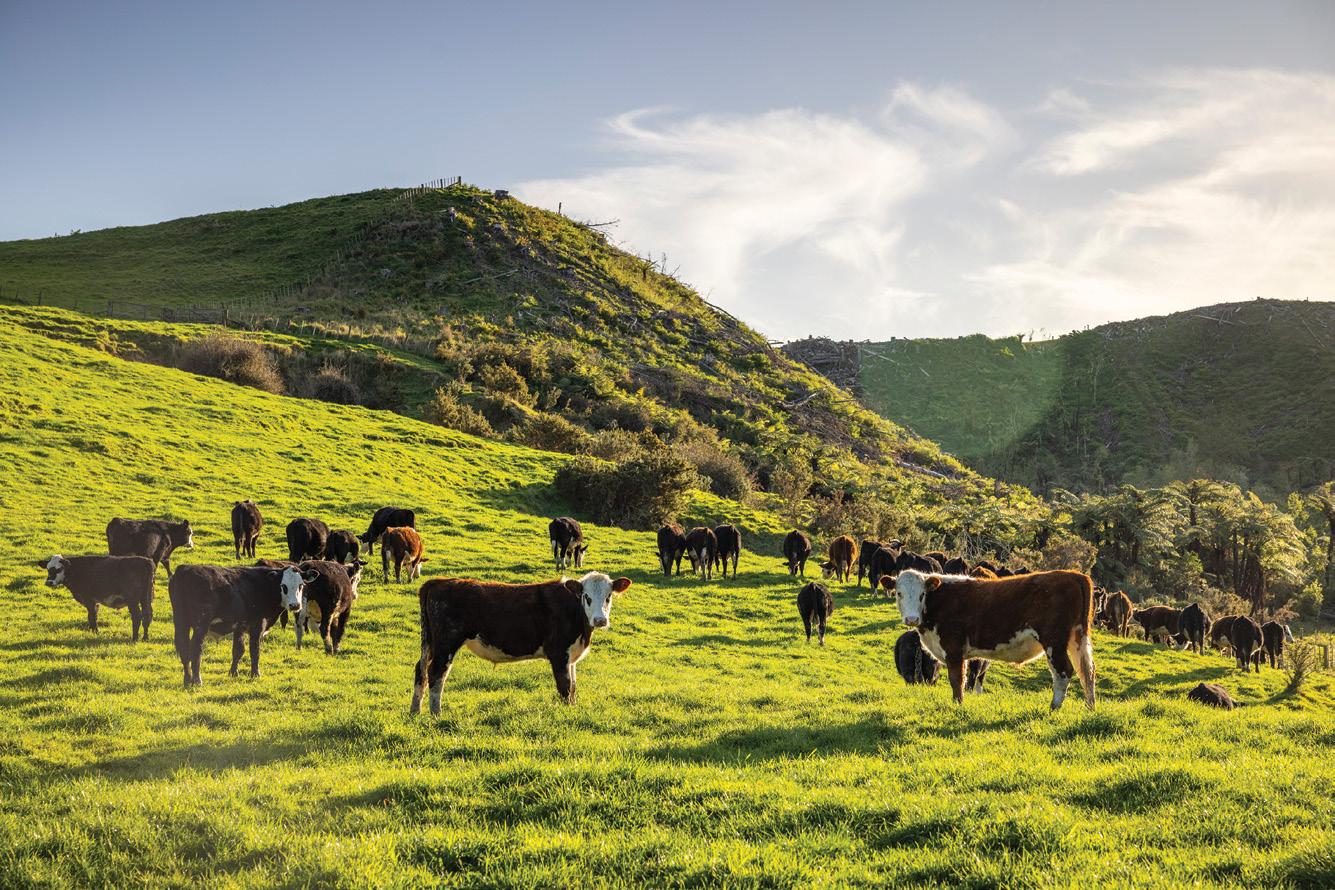
Country-Wide | AUGUST/SEPTEMBER 2023 59
i
Top: Shirley and Rick with native seedlings being prepared to plant out. Right: Hereford-cross steers and heifers are finished at two or two and a half years of age.
Lambs are finished to go off the farm in mobs from December through to May, but some may be sent to store depending on the season. The lambing percentage is improving every year with the three-year average 133% and a high of 142%. Pregnancy scanning is carried out in May and empty ewes culled.





Lambing starts in mid-July and the aim is to complete docking by the end of September. Lambs are weaned in early November. The Mannerings have been growing a summer crop of 14ha of Raphno to help during the usual expected dry period.

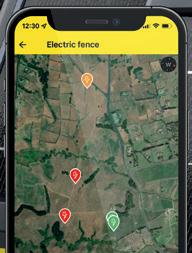


“We can only laugh about that now,” Shirley-Ann says. Rainfall, usually about 1700–1850mm a year, is already twice that this year.





























The ewes are mostly grazed on their harder hill country “filling the voids” around other stock, as feed is prioritised for rising one- and two-year dairy
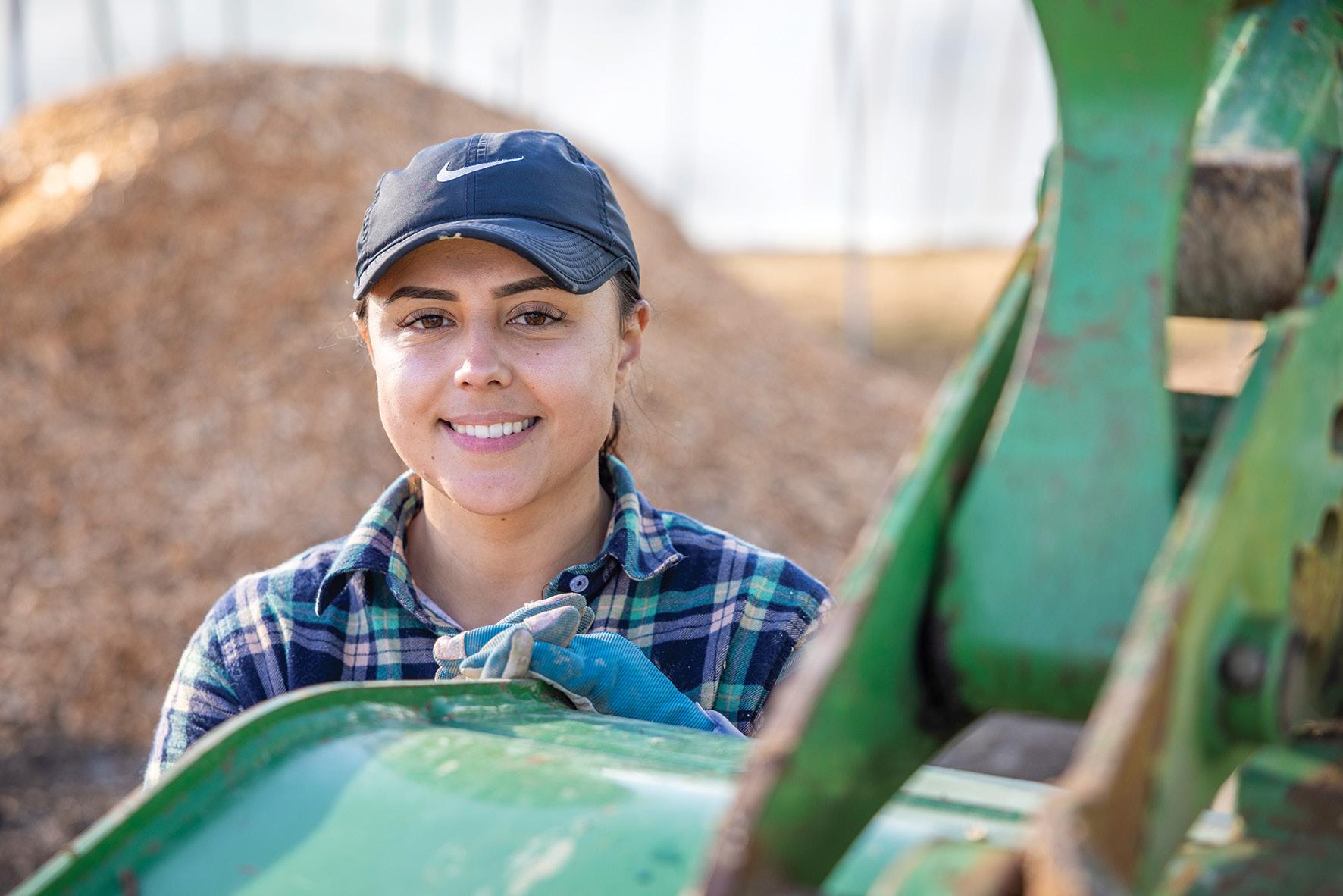
60 Country-Wide | AUGUST/SEPTEMBER 2023
Shay Tavaitai, a new casual worker on Waytemore Farms, mostly helps out with rearing dairy beef calves.
heifers, dairy beef weaners and lambs. Their animal health programme, developed with their vet, sees mixedage ewes go undrenched, but lambs drenched with a short-acting drench as barber’s pole worm can be an issue. Their vet has carried out testing to make sure there are no drench resistance concerns. Stock are also monitored for facial eczema and are given a bolus. Pink eye has been a problem in the past and affected ewes culled.
Shearing takes place in May and November every year, mainly for animal health reasons, says Shirley-Ann, but they do have a contract for lambswool in the 28–31-micron range.
“That’s been worthwhile as our sheep’s wool usually has good colour.”
They used to bring in all maize silage, but last year they grew 10ha of maize for silage on each dairy farm and also bought some in. For pasture renewal they’ve used diploid Platform perennial ryegrass following the supplementary
crops of chicory and maize. Soil testing is carried out every three years on the sheep and beef farm and every two years on the dairy farms with fertiliser applied according to what the results recommend.
The Mannerings employ a farm manager, 2IC, fencer, farm ranger, and two casual workers for calf rearing. Their farm manager Todd Linkhorn has a Bachelor of Parks and Recreation (wildlife management) and farm ranger Gemma Acton has a Master’s of Science majoring in conservation biology. A farm ranger was needed to focus on the necessary hands-on work.
Shirley-Ann develops a conservation strategy each year, which outlines priorities for the next 12 months. The teamwork builds camaraderie and expands interests and experiences, helping workers understand each other’s roles, as well as having an important health and safety aspect. Beef-calf rearing workers are rostered during the
HOW THEY STARTED
The Mannerings, who took out the Supreme Award at last year’s Ballance Farm Environment Awards for the Auckland area, bought their first sheep and beef farm at Paparimu in 1991 and converted to dairying the following year. They employed a sharemilker and kept working in their other businesses to pay the mortgage.
In 2011 Shirley-Ann inherited her father’s sheep and beef farm and two more dairy farms, which she and Rick now run as one, known as Waytemore Farms. Some of the farms share internal boundaries and in total cover 1455 hectares (1180ha effective), with the dairy platform making up about 400ha effective. A block of 28-year-old pines was harvested last year and just over 35ha will be replanted, along with a new 4.3ha planting of manuka to be a buffer between the pine blocks and Queen Elizabeth II National Trustprotected bush and swamp-forest ecosystems.

Country-Wide | AUGUST/SEPTEMBER 2023 61

weekends to ensure they all get time off from calf feeding.
“On the sheep and beef farm docking is the usual example of everyone pitching in, but fencing, weed spraying and wetland planting are also sometimes carried out as a crew.”
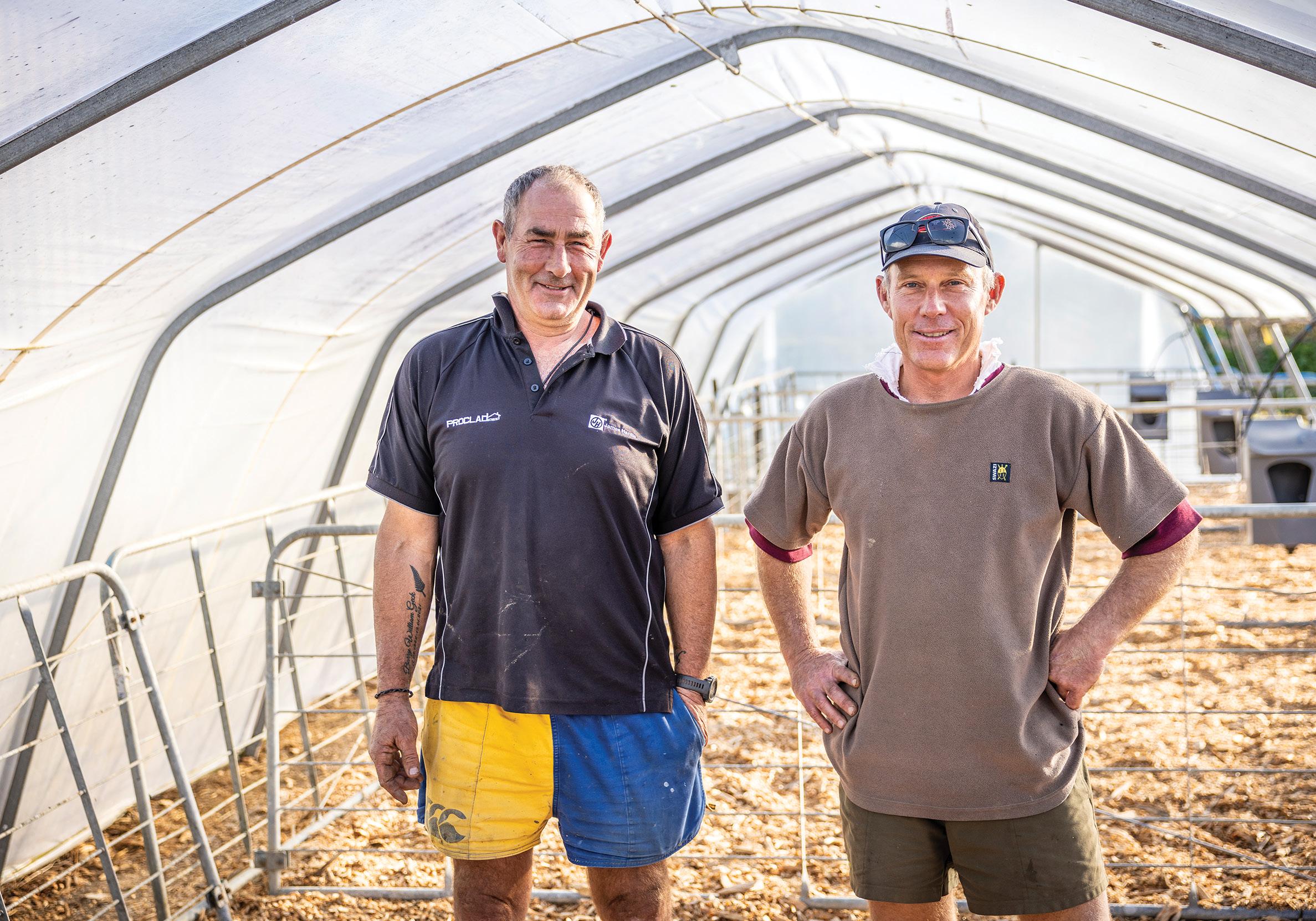
Blitzing the pests
There’s 130ha of mature indigenous trees surveyed and fenced, along with forest remnants and kahikatea stands. As well, there’s 60km of waterways, not including that in fenced forest areas, along with 35km of riparian fencing.
On one of their dairy farms, Kauri Hiwi, they’ve installed about 70 Philproof bait stations as part of the possum ground-baiting programme undertaken following a 1080 operation in 2018. A similar programme added
further bait stations before a 1080 drop in September last year. With support from the Auckland Council QEII Fund in 2020 they installed 65 lockable rat bait stations at the Philproof locations on Kauri Hiwi and put in 12 NZAT 220 autotraps as a trial, which proved very successful at dispatching possums and rats. They’d established lines of 85 Philproof bait stations for possum control in most fenced native bush areas on Waytemore in 2019, but a year
later commissioned a five-year pest and predator control plan for the farms which has been implemented. The aim is an integrated pest management approach that is environmentally and economically sustainable.
“We specifically wanted to avoid the bioaccumulation of chemical toxins within the environment,” Rick says.
In 2021, again with support from the Auckland Council QEIIN Fund, they bought 20 more NZAT 220s for the
Country-Wide | AUGUST/SEPTEMBER 2023 63
The teamwork builds camaraderie and expands interests and experiences, helping workers understand each other’s roles, as well as having an important health and safety aspect.
Kelvin Geck, 2IC, and farm manager Todd Linkhorn.
steeper pine plantation country and have also added 27 Flipping Timmy possum traps, a mix of 24 DoC 200s and 250s for mustelids, 100 rat bait stations and five Steve Allen Kat Traps for feral cats.
“While possums are the major issue, we also want to address apex predators such as mustelids and feral cats as well as rodents.”
Pest control for biodiversity sees them not solely focusing on one species but taking a landscape scale approach. With the Hunua Ranges Regional Park and Mangatawhiri Forest Conservation Area as neighbours to Kauri Hiwi, pests and predators can re-infest protected covenants and re-establish in
uncovenanted areas.
“We’re aware that at the moment extinction is not realistic, so we aim for heavy suppression of targeted species,” Rick says.
“Trialling new hardware and looking at new technology helps us ensure we’re being both efficient and effective with
our control.”
Alongside their Ballance award, the Mannerings took out the DairyNZ Sustainability and Stewardship Award, the Hill Laboratories Agri-Science Award, the Massey University Innovation Award and the Auckland Council Water Quality Enhancement Award.


64 Country-Wide | AUGUST/SEPTEMBER 2023
Above: Hereford bulls are bought in as yearlings and sold two years later. Right: Casual worker Michelle Van Den Bogaard with 2IC Kelvin Geck.


Country-Wide | AUGUST/SEPTEMBER 2023 65 Tick all the boxes. It’s CRUCIAL®. ®CRUCIAL is a registered trademark of Nufarm Australia Limited. ®Pulse is a registered trademark of Nufarm Technologies USA Pty Ltd. *Commercial Performance Guarantee. ©Nufarm 2021. ONF207915NF Contact your local Rural Supplier or Nufarm Territory Manager. 0800 NUFARM or visit us at nufarm.co.nz/discovercrucial SCAN ME
Hard to comprehend
Trevor Cook has been hosting farmer groups around the country and is all too aware of the disconnect between farmers facing numerous issues and those who make the rules.


Iread recently that time today is five times faster than time was in the earlier universe. This is a concept I just cannot get my head around, and one that hardly matters to me. But it was my lack of being able to comprehend it that made me read it again.
It struck me that in discussions I’ve been having with farmer groups around the country, many farmers must feel the same way about some of the stuff coming their way.
A good example recently was in an area decimated by pine tree planting. The farmer whose neighbours had all gone into trees just could not see how his sheep and cattle could be making a significant impact on the temperature in the world.
So what was the value in working out a number in order to find a way to decrease it? Trying to suggest that market access was bothered about this fell on deaf ears at a time when the market for his lamb and beef was rewarding him based on a few carcase characteristics. It highlighted the massive disconnect between politics and markets and producers. For these three, time probably does move at different speeds.
Reading in the same magazine as
the time change was an article about prebiotics. These are the fuel in the gut for the good bugs to live on. Certain foods are good at doing this and in that list is milk. Just as well we produce plenty.
Another story in the magazine was about a study that revealed consuming extra of the amino acid taurine extends life by 12%. This was in mice so needs to be taken with a grain of salt. But it backed up lots of other surveys that have shown a link between ageing and taurine levels.
What is a very good source of taurine? Red meat. These articles just added to the huge number that show the health benefits of consuming animal products, but these studies hardly star in our urban press.
The farmer groups mentioned above exposed a widespread poor sentiment driven by so many things: markets, potential regulation, weather, labour shortages and farm inflation. For some farms with so much damage it is hard to see their way forward. Farm budgets that are now all actuals for this last year do not look good and the budgets for the year ahead are no more comfortable. Rural spend will be down and the low
tax take is tangible evidence of this downturn. But these farm groups never fail to come up with positive stuff.
The move into low- or no-wool sheep options is growing momentum, supported by more stud-breeding activity. Just brainstorming policy options can be enough to generate enthusiasm. New approaches to taming gorse and introducing new legume options into traditional crops came out of another group.
66 Country-Wide | AUGUST/SEPTEMBER 2023
ANIMAL HEALTH
An interesting conclusion to a June meeting was on a farm owned by an accountant. He spent the day with his manager sharing the farm with the group. Suggestions and ideas flowed freely leaving the manager and owner with a number of policy and management options to ponder.

As I left, the accountant expressed amazement with the day, saying that in his office his accountants did not freely share what they did, yet on this day he
experienced farmers willingly giving advice and sharing knowledge. This is unique to farming and is a forum that is very powerful in supporting change.
As I drive around the country I have been exposed to so many damaged roads. The impact on transport has been immense and what a godsend to orange road cones. I often talk to them, particularly when they have chosen to be somewhere with no apparent damage. My response has been tempered by a
comment from one of my daughters who recently returned from a few years working in poor countries. She told me that I should be grateful that someone was trying to fix the roads. But I’m not sure our expectations are excessive when we do have the wealth to have that backup.
It is the internal road damage on farms that has not hit the headlines but is still severely restricting farm activities on many farms. No wider community wealth is coming to the rescue here, yet once again the farming businesses will work their way through getting back on track. That is the long history of New Zealand farming.
In my last column I mentioned the science that linked low-methane outputs from ruminants with smaller rumens. Hence lower feed efficiency. It seems that this struck a sensitive nerve in the politics of the greenhouse world because it did not fit their agenda.
Breeding lower-emitting sheep and cattle is such a good story, even though we have been breeding for lowermethane animals for the last 40 years by selecting for efficiency. We cannot afford to lose that by getting sidetracked with measuring methane outputs.
Country-Wide | AUGUST/SEPTEMBER 2023 67
Trevor Cook is a production animal consultant/ veterinarian in Feilding.
“It highlighted the massive disconnect between politics and markets and producers. For these three, time probably does move at different speeds.“
ARABLE PROSPECTS
Colin Hurst, Federated Farmers’ new vice-president and Mid Canterbury cropping farmer, says while the 2002 white clover season was the worst on record with the New Zealand market barely able to be supplied, Canterbury produced a good average cereal crop this year.
“But the North Island was hugely impacted by extreme weather events.”
Maize growers had a very challenging season resulting in some paddocks unable to be harvested and some that were recorded as “very below average” yields. But greater demand for malting barley along with higher returns created an opportunity.
Anecdotally, Hurst has heard of pastoral farmers switching to grow some grain crops, lured by higher prices which are still about $500 a tonne (t) for feed wheat and barley and $540–560 for milling grain.
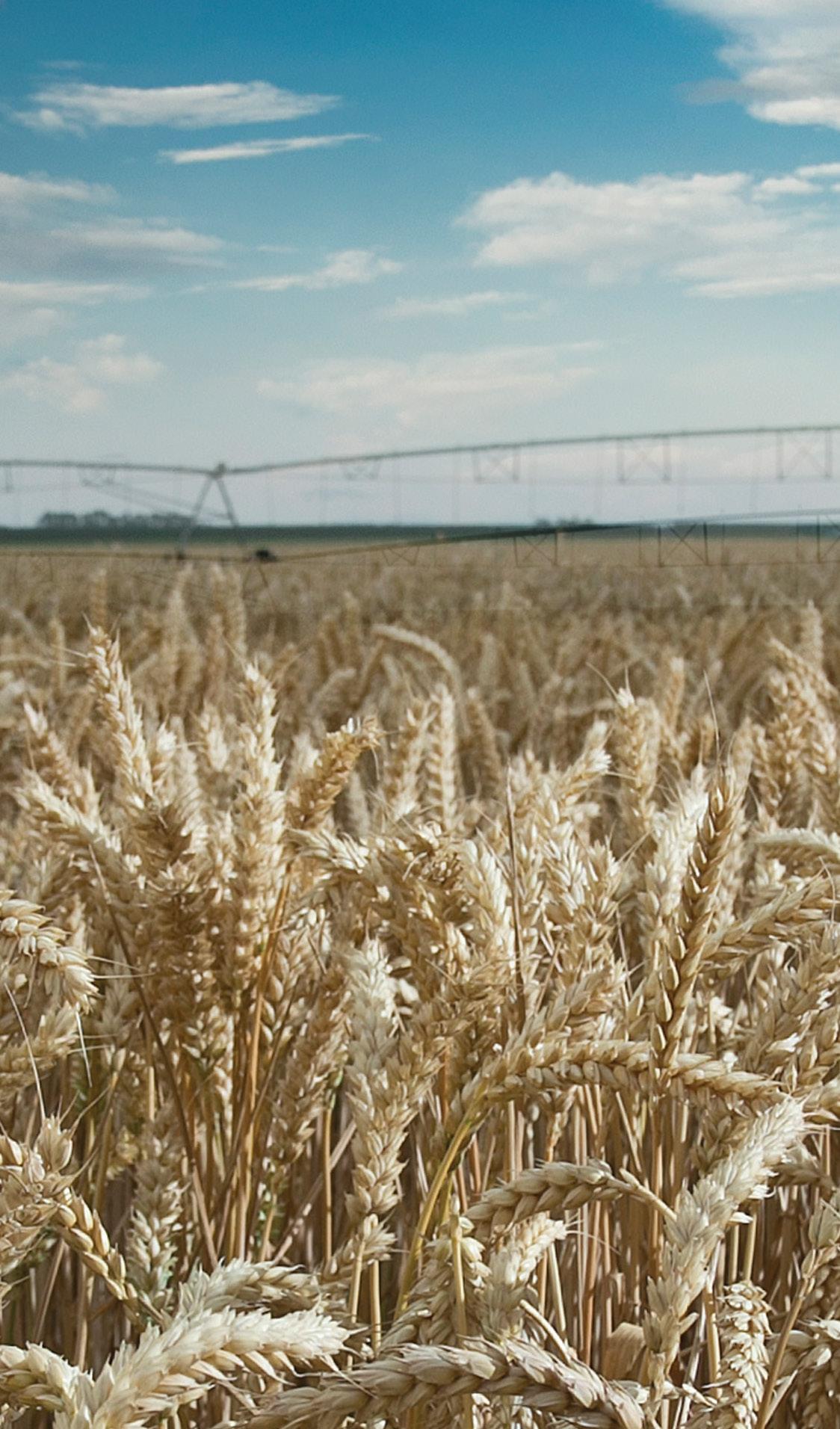
He’s a great fan of integrating farming systems and the potential fit with pasture renewal programmes, but he warns that fuel, machinery and labour costs have all gone up, with an estimated lift on his farm over the last year by “a good 15%”.
And he makes the point that unlike dairy farmers receiving regular income, arable farmers can lag up to a year behind, depending on their supply contracts.
“But with New Zealand still being a net importer of one million tonnes of grain and two million tonnes of palm kernel, there are significant opportunities available.”
Market corrections
Seed companies and feed manufacturers supplying the dairy industry say the market has largely corrected.
Seales Winslow’s procurement manager Michael Leaf says things have changed a lot in the last six months. Not only have international grain prices fallen but shipping rates are back to near pre-Covid levels.
“Local prices are expected to soften in the short term.”
Leaf says the market appears to be very cautious approaching the next three to four months as companies work through their existing grain positions.
“There’s plenty of grain available to support a busy spring. However, a slow spring will only create further price pressure for uncontracted grain.”
PGG Wrightson’s grain trading manager Andy Wilson says world grain supplies have returned to a genuine supply and demand dynamic after good harvests in Europe, so he doesn’t see NZ’s arable footprint increasing. Instead, it’s more likely that pastoral farmers on the fringe of arable areas will continue to take an opportunistic approach when
prices are high.
Some dairy farmers might be tempted into growing grain as they face nitrogen leaching restrictions. Their industry’s impact on cereal prices showed this year as they tightened their belts with on-farm costs increasing, particularly interest rates, which in some cases had doubled. Many dairying areas experienced a second spring in autumn, boosting feed supplies, and Fieldays saw a lot of palm kernel sold at prices less than $300 a tonne.
A good cereal crop across the South Island made up for an estimated 30% drop last year, but there’s a smaller window to trade carryover grain before next year’s harvest, meaning little demand for some crops. The ryegrass harvest this year has been extremely good.
Herbage Seeds subsection chair John McCaw says a good harvest in Europe leading to a glut of seed has meant the “nui market tanked”. But with not a lot of clover seed in the market after last year’s poor harvest, pricing is stronger. Generally proprietary grass seed prices are between $2.70 and $3.30/kg.
“But they need to be at $3.50 to $3.80,
68 Country-Wide | AUGUST/SEPTEMBER 2023
CROP & FORAGE INDUSTRY
Pastoral farmers tempted to grow cereals on their farms as a result of recent high prices are being urged to tread carefully as the market returns to a more normal demand and supply situation. By Glenys Christian.
depending on yield,” he says.
Ed Luisetti, chair of the grains and pulses group of the NZ Grain and Seed Trade Association, says dairy farmers under environmental pressure might look to grow some milling wheat on their land, but this isn’t happening at present.
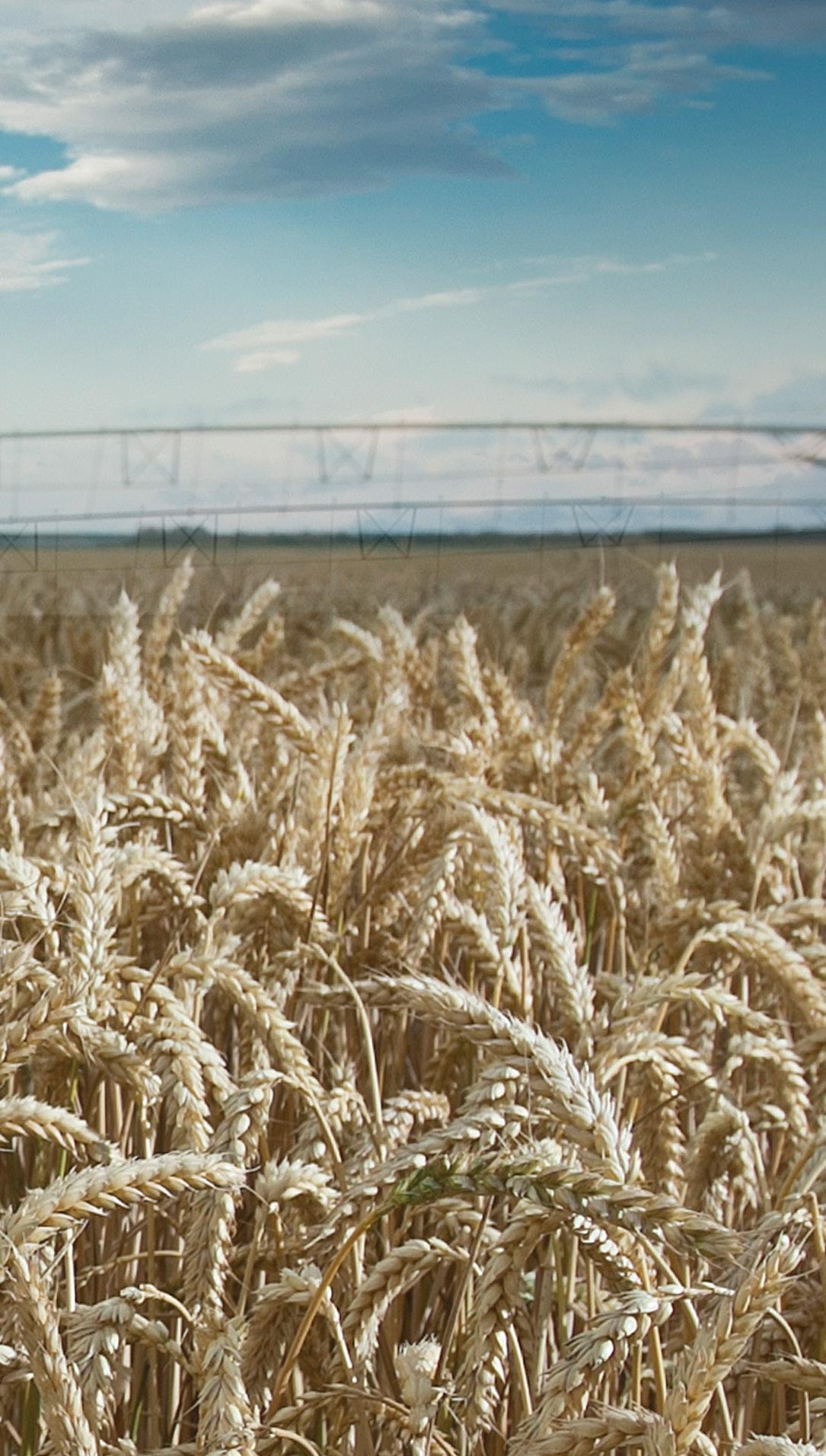
Feed barley prices, which were in the high $400/t, with malting barley slightly higher, are likely to remain at those levels, tempting some farmers, but demand could be greater for spring sown milling wheat.
Clover prices are “incredibly strong” and likely to remain high, with anticipated shortfall again this year seeing some NZ companies importing clover seed.
“Prices are $9/kg and just two years ago they were $6,” Luisetti says.
Ryegrass prices are still very firm at from $2.20 to $3.20/kg but the multiplication area grown has dropped back.
Barenbrug NZ’s commercial manager
Graham Kerr says they won’t have any real seed supply issues for pastoral farmers. Grass seed harvests look slightly above average this year, much better than those in 2022.
He says the company is paying growers more for their seed this year recognising the increased costs growers are facing.
Barenbrug hasn’t lifted its spring prices for retailers selling to farmers, but they’ll be reviewing at the end of the year.
Sowing intentions for arable crops showed the total area was estimated to be up by 2%, or 800ha.
This is according to the Arable Industry Marketing Initiative (AIMI) survey of NZ cereal growers on April 1 this year.
Autumn/winter malting barley was predicted to be up 96%, or 600ha, and milling wheat up 24% or 1400ha. This was balanced by feed wheat, predicted to be down 1% or 300ha and autumn/ winter feed barley down 7%, or 900ha. Milling oats sown in autumn/winter were estimated to be up 56% or 400ha but feed oats down 80% or 450ha.
The survey also showed overall harvest yields earlier this year were up 7% compared with last season over the six main arable crops with a 1% increase in the area grown. Milling wheat’s estimated tonnage at 103,200 was up 49%, while feed wheat at 303,800t was down 3%. Malting barley at 62,700t was up by 69% with feed barley at an estimated 286,500t, up 6%. Milling oats at 19,700t lifted by 3%, but feed oats at 8,400t were down by 45%.
The AIMI Maize survey carried out on June1 showed average maize grain harvests were estimated at 9.7t/ha, down from 11.5t last year. The total harvest is down 13% on last year with 16,700t unsold, well up from the 5,600t at the same time in 2022. Silage maize yields were estimated at an average of 19t/ ha, down from 20.9t/ha, with the total harvest down 7% at just over a million tonnes.
When it comes to spring sowing intentions it's estimated the area will be 12% less for grain maize and 3% down for maize silage.
• As this story went to print Russia withdrew from the Black Sea Grain Initiative and Rabobank predicted grain prices would continue to be volatile. – Ed
Ryegrass and clover growers can now work out their true costs of production, including return on investment thanks to a new online herbage seed spreadsheet.
Federated Farmers’ herbage seeds subsection chairman John McCaw says last year growers realised that although their input costs had gone “through the roof” there wasn’t a lot of movement in seed prices they received.
“We needed a more coordinated approach.”
So, eight Mid and South Canterbury growers ranging from small scale to owning a number of properties agreed to open their books to each other. Despite variations in growing area, costs were quite similar so on-farm expenses could be subtracted from their average gross margin. “That gave a net margin and tells you what the net price needs to be.”
Growers can add their farm value and desired return on investment to compare contract options. The model will be reviewed in the next few months with plans to update it annually. There has been talk of expanding it to other crops such as wheat but that isn’t planned at present, McCaw says. Feedback was positive from the 13 merchants who were shown the spreadsheet and growers were positive too.
Country-Wide | AUGUST/SEPTEMBER 2023 69

70 Country-Wide | AUGUST/SEPTEMBER 2023
THE CASE FOR GENETIC MODIFICATION
By Joanna Grigg.
Modern tools to shape plant and animal genetics have been largely off the menu for New Zealand-based scientists. The gate to on-farm trials has been firmly closed.
Transgenesis – also called genetic engineering or modification (GM) –didn’t sell well to the NZ public initially. The 2002 memory lingers on saboteurs raiding a GM potato trial at Crop and Food Research near Christchurch.
Time has seen science move on. Plant genes can now be edited in different, more accurate ways, and also with or without bringing in genes from another plant or animal. Gene-editing technology involves deleting genes, inserting them, or switching them on and off.
Plant scientist and CEO of Grasslanz Technology John Caradus said it was time to revisit regulations and have an educated debate. When the Hazardous Substances and New Organisms Act 1996 was brought into law, gene-editing was not developed. “Our current regulations are no longer fit for purpose.”
He said research on GM was still funded by the NZ Government but the products can’t get past the gate-keeper. Policy means NZ is poorly equipped to make a strategic decision on the release of GM organisms to the outdoors.
National took a political first step in June – perhaps prompted by advocacy. They are proposing to update rules and open up access to gene editing and genetic modification. Labour has also hinted at a willingness to revisit it.
As many Kiwis have been wandering in the GE-free desert, far from the world of this biotech science, it will be tough to catch up.
As yet, there are few “go-to” voices among ag leaders who have emerged in this space.
John Caradus describes himself as an “plant-breeder of old” and an introvert by nature. He is now, perhaps reluctantly at times, on the speaking circuit helping agriculture (and beyond) get up to speed.
“I’ve watched for 25 years at the lack of engagement of politicians and some agriculture leaders on this issue – we
need leadership here.”

He spoke at a plant breeders conference in July about NZ being “increasingly out of step”.
“Why allow plants into NZ that have been radiated to form a mutation – which is so random – but not allow targeted gene removal in a plant, which is precise.”
“It’s plain nuts. We need open debate involving industry and political leaders about benefits and risks.”
Caradus works for an organisation that invests in forages and microbes that are developed using transgenics. That conflict aside, he knows how it all works and has the gift to be able to explain it.
His recent papers include whether consumer attitudes would reduce the demand and acceptance of food produced by NZ pastoral farmers if GM forages were included in animal feed.
He has also written about different plant breeding techniques and the perceptions people hold – covering from 10,000 years since the domestication of maize through to modern breeding using
Country-Wide | AUGUST/SEPTEMBER 2023 71
New Zealanders were scared off GM back in the early 2000s, but the science has moved on since then and the calls to rethink our stand on gene-editing technology are getting louder.
GENE EDITING
tools such as gene editing.
It can be heavy going, but Caradus says this stuff should be in plant breeding 101 for farmers.
Tools available
The take-home message with modern breeding is that there is a huge range of tools. One that farmers might know is using chemicals to double a chromosome in perennial ryegrass. Bingo – there’s a tetraploid ryegrass.
Bomb something with radiation and you get a mutation.
Some of these mutation-induced cultivars in the lab have gone on to be popular. The highest number are used in Asia (with 2087 cultivars – mainly rice), followed by Europe (960), down to Australia/Pacific (9).
Another tool – and getting more techy here – is reverse genetics and breeding. It’s all about deleting what you don’t want out of the sequence. Options are using a virus to silence the gene (VIGs) or RNAi, which suppresses expression of the gene.
Another tool is mixing genes from different organisms. Transgenesis involves introducing genes from other organisms to another. It may also involve genes artificially synthesised in the laboratory. Cisgenesis is defined as transferring a gene from the same or a closely related species. This is a method that is defined as GM in NZ, but not in other countries.
Gene-editing is the most precise tool of them all, at this stage. There are lots of different ways to do it, but the most familiar term is probably CRISPR.
CRISPR gene-editing uses site-directed nucleases (SDN) which uses different enzymes to cut the DNA at a set spot.
AgResearch used a gene-editing technique called TALENS to produce edited cattle with milk that is hypoallergenic. Modified embryos were placed in surrogate cows resulting in calves born (in containment). This research work is not ongoing.
Caradus said that each breeding result must be weighed up on its merits; not just ban the whole tool box.
The future: Some genetically modified traits with potential for grassland systems:
• Insect pest resistance
• N-fixation in non-legumes
• Reduced methane and urinary N
• Improved winter or drought hardiness
• Disease resistance
• Tolerance to salt soils
• Higher metabolizable energy feed.
There would have to be a convincing cost-benefit analysis for each product and the onus is on science to deliver this, he said.
He would like objectors to stick to the facts.
“GE Free NZ and Sustainable NZ are against some of the biotechnologies, but we need them to back up their statements with facts.”
New Zealanders eat it, but current regulations mean we don’t grow it.
The number of GM plant events authorised for (a) commercial cultivation and (b) for food and/or feed use since 1992 per jurisdiction.
Source: Spök et al. 2022; ISAAA 2023.
a - Stacked events of registered single events are not included in the US list
b - No commercial cultivation despite approval; Japan has approved a lot of commercial GMOs for cultivation
c - Commercial cultivation with one event only in some regions of the Union (Spain and Portugal)
d - Only cultivation of blue carnation for decoration purposes allowed
e - Moratorium for commercial cultivation in place since 2005
f
– Only approved for use as food (not feed)
Credit: John Caradus, CEO Grasslanz.
72 Country-Wide | AUGUST/SEPTEMBER 2023
APPLICATION USA Canada Australia Japan NZ EU Norway Switzerland CULTIVATION 184a 144 56 145b 0 10c 11d 0e FOOD/FEED 370 293 142 375 142f 226 11 4
“GE Free NZ and Sustainable NZ are against some of the biotechnologies, but we need them to back up their statements with facts.”
When it comes to GM food products consumed in NZ, there are about 90 on the list, Caradus said.
“Farmers can eat these plants and seeds but not grow them, so the issue for us is the effects of them growing in our environment.”
When queried whether GM sits with brands like regenerative or organic, Caradus said the organic market has indicated a “no”. He said the regenerative agriculture term is loosely defined and alignment with GM concepts largely untested.
“Organics turning their back on gene editing may be unfortunate, as you can measure risk with each application, and you are switching a gene on and off, and this could happen naturally too – we just make it happen.”
He said the potential to help the environment and reduce chemicals could be a great fit with organics.
Where he does see debate ahead is around whether organic farmers can coexist alongside gene-edited neighbours. Pollen, for example, doesn’t respect boundaries.
His list of risks to be debated are testing for human and animal health and welfare (e.g. allergies), the impact on beneficial non-target organisms (e.g. insects) and understanding gene flows from GM crops.
Professor Andrew Allan from the School of Biological Sciences at the University of Auckland said NZ policy was made law before the development of new techniques. It made the application of the law vague and not based on biology or science.
He saw real disadvantages in the status quo – especially around climate change.
“Our existing crops are under threat and traditional breeding methods can’t keep up with warming temperatures.”
Allan said there should be a “case-bycase decision tree as to whether an edited organism provides a measurable benefit, without an increased risk”. This would be compared to an established breeding practice.
When it comes to market perceptions,
More digestible lucerne on the US market
Alfalfa (or lucerne) is an important source of cut and carry cattle feed. If harvested late, it can contain high levels of lignin. This fibrous material binds cells, fibres and vessels in plants, but animals can’t digest lignin. HarvXtra alfalfa, produced by Forage Genetics in the USA, has up to 20% less lignin, making it much more digestible for cattle. It can also be harvested or eaten seven to 10 days late without sacrificing quality. This plant cultivar is genetically engineered.
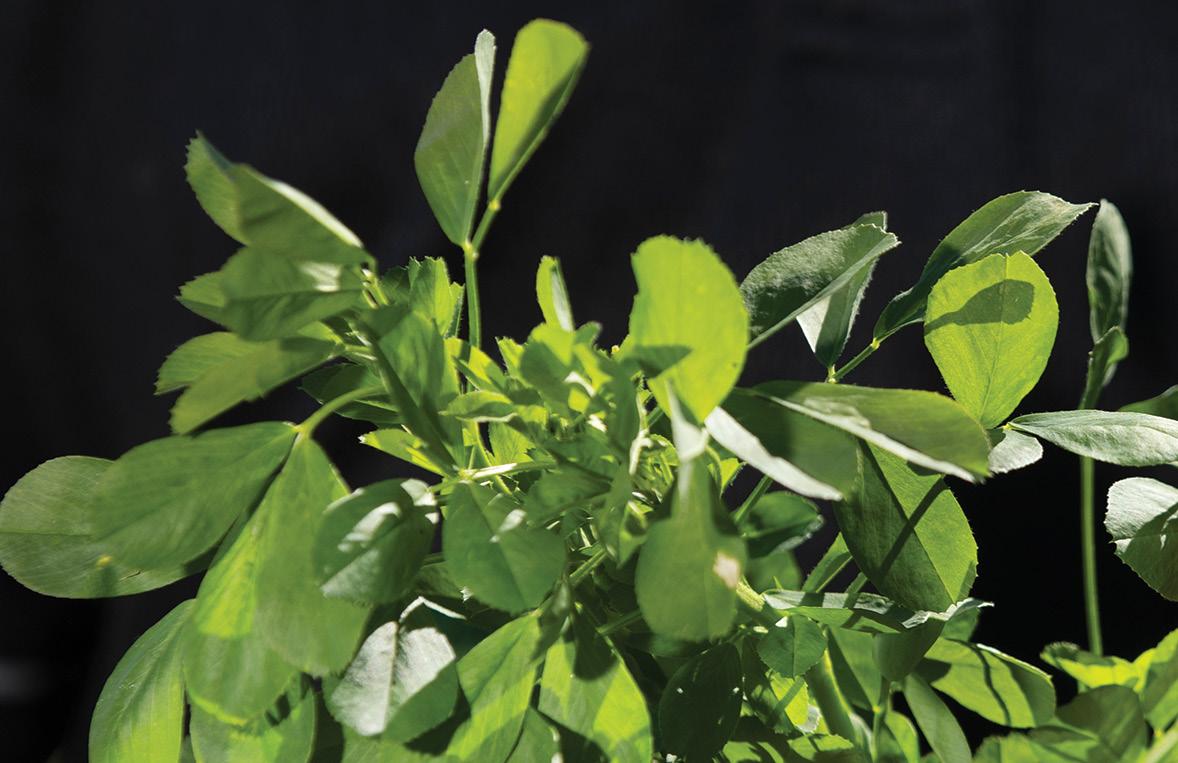
he said overseas markets could continue to receive NZ products labelled GMO-free and new products labelled appropriate to that product.
“Having an edited crop in New Zealand does not taint all New Zealand products.”
A 2022 survey in NZ (Research First, 2022) showed that 32% of surveyed people supported gene editing in food production, 47% were neutral and 21% were against. When it came to pasture quality traits, 62% of NZers supported gene editing for this, while 15% were against.
Caradus studied whether the use of GM plants in NZ for food production would have long-term deleterious effects in overseas markets. He concluded that the evidence showed it wouldn’t, although there would always be a proportion of consumers against the use of GM in food production.
Who’s doing what with GM
What’s out there in the wide world of modern biotechnology?
If gene editing and other breeding tools get the political green light, farmers and growers can expect different plants and animals on offer down the track –but some way down the track.
Caradus is picking that, subject to sensible regulations, the first type of gene-editing we might see in NZ is SDN1 which doesn’t involve introducing new DNA. It can be as simple as making cuts to the target site and relying on the host cell to “fix up” the break by removing or changing the DNA bases. Or it might involve switching genes on and off with short-lived genetic signals.
“It has no foreign DNA, so takes away some concerns, and the technology is out there already,” Caradus said.
“It’s relatively unregulated in Canada and US for example, and in Australia you
Country-Wide | AUGUST/SEPTEMBER 2023 73
just need a legal statement to say it’s a SDN1 product.
“The first cab off the rank may be the gene-edited endophyte, developed by AgResearch and funded partly by Grasslanz and the Government.”
It protects the plant it lives on but doesn’t hurt the animal eating it. It’s done by “editing out” the grass staggers and heat stress effect in the fungus. Caradus said it could be commercialised within five years, or earlier, if the EPA accepts an application, adding that introduction would involve consultation with agriculture, public and iwi.
He said knowing exactly what’s out there globally is tricky as there’s no list of international genetically modified STM1 (suppressor technology) products that are available or being developed.

What is known is that across 26 countries there have been 824 approvals to date (2022) for cultivation of
genetically modified (GM) crops. These include eight different GM traits, mostly for animal feeds. Between 70 and 90% of all GM crops, principally soybean and maize, are used to feed animals. The biggest users are USA, China and Europe – all major export markets for NZ. The product tastes the same. These traits do not change their composition or nutritional value for animals, Caradus said.
Grasses and forage species are behind. There are only a few examples of GM technologies being used commercially in grasses and forage species that could benefit New Zealand.
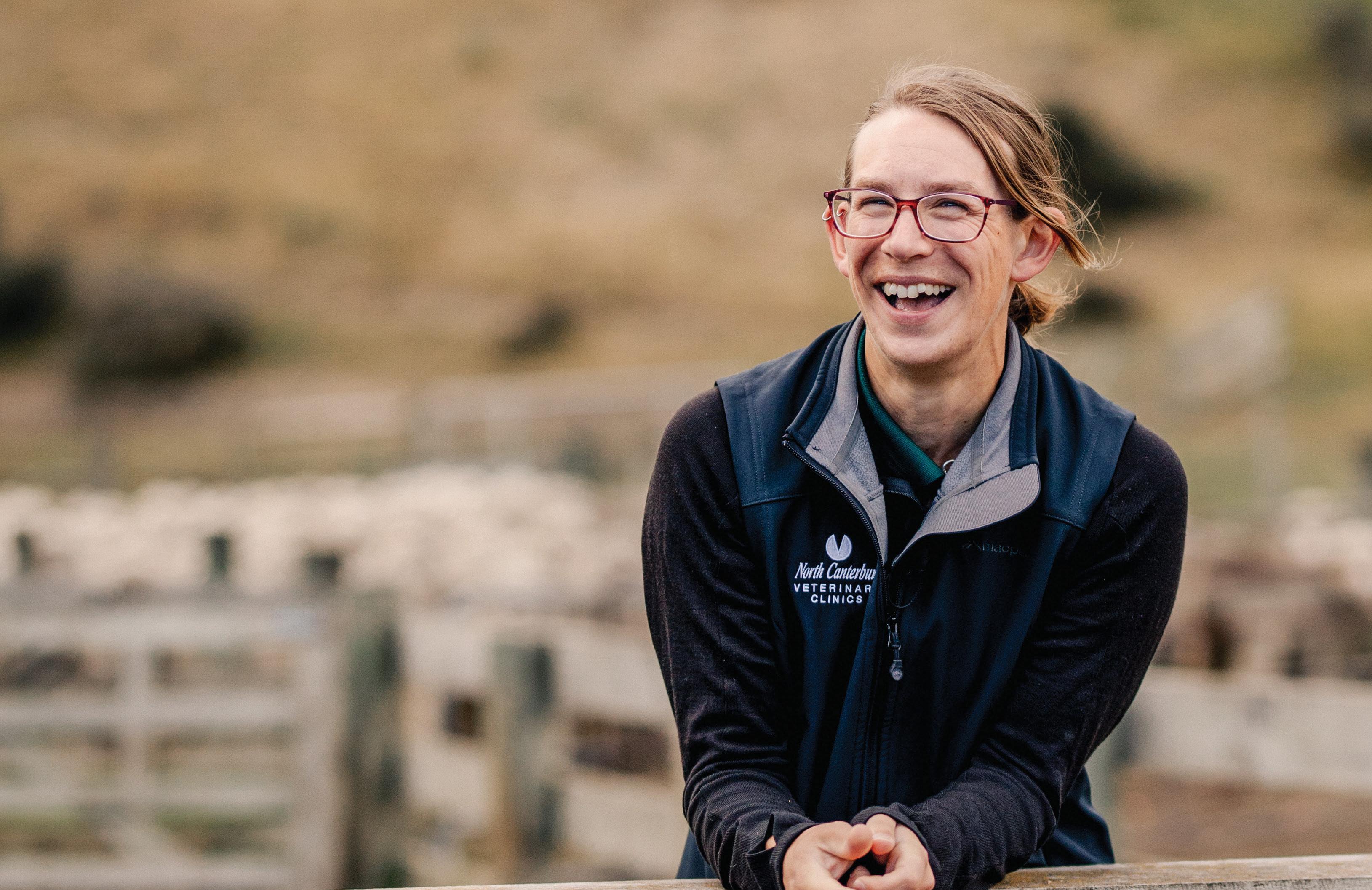
Australia has dipped a toe in while NZ sits on the deck. They have genetically modified (GM) canola, cotton and safflower crops approved for growing. They have developed a sorghum that is larger and has extra protein. This will grow beef or pork faster. It is also a food source for 500 million people who live in Sub-Saharan Africa. Research by the Queensland Alliance for Agriculture and Food Innovation has used gene-editing to lift sorghum protein from 9–10% to 15–16%. It has been grown in greenhouse conditions but will progress to outdoor field trials.
Wheat has been developed with
“It’s relatively unregulated in Canada and US for example, and in Australia you just need a legal statement to say it’s a SDN1 product.”
“ Being a long-acting product and a single injection there’s less handling, less yarding and it’s just one injection so less needlework.”
smartshot.co.nz Registered pursuant to the ACVM Act 1997, Nos. A009984 and A009402. Copyright @ 2023 Virbac New Zealand Limited. All rights reserved. *Based on label claims and dosage, and supporting published literature.
Erin Riley Veterinarian, North Canterbury
increased yields, quality and tolerance to environmental stressors such as drought. The Commonwealth Scientific and Industrial Research Organisation (CSIRO) in Australia used a breeding technique called RNA interference (RNAi) to do this. RNAi switches genes on and off. It was also used to develop barley resistant to Yellow Dwarf Virus.
Monsanto (now owned by Bayer) is working on an RNAi spray to combat weeds that have developed resistance to its glyphosate herbicide. The spray would neutralise the resistance in those weeds. An interesting flip on the idea of genetically modified plants to withstand glyphosate.

NZ apiarists should be excited that RNAi could be used to target varroa mites in bees.
Farmers are right to get enthused about the potential. Current work includes a lucerne that doesn’t go starchy when harvest is delayed, potatoes that don’t go brown and a wheat that can withstand fungus infection.
CRISPR is one of the newest and most powerful of the gene-editing technologies. It’s cheaper, rapid and more accurate. It’s based on a natural bacterial immune system designed to
defend cells against invaders by splitting up invasive DNA.
Japan has used CRISPR to develop three trials to date: fleshier red sea bream, high-growth tiger puffer fish and, to help lower blood pressure, a GABAenriched tomato with five times as much of this amino acid. The tomato has more GABA by changing genes that normally limit GABA production.
Japan allows gene-edited products to be sold to consumers without safety evaluations as long as the techniques meet certain criteria. The US has adopted a similar screening process. Japan has used CRISPR to develop a rain-resistant wheat.
The Genetic Literacy Project website said that when the US Department of Agriculture allowed for deregulation of gene-edited plants in 2019, the agency approved more than 70 geneedited plants. While the “boots ‘n’ all” approach occurred for plants, approval for animals has been slower. This is because the Food and Drug Administration (FDA), which oversees animal biotechnology in the US, takes a far more cautious approach.
Only one gene-edited animal has been approved in the US – the GalSafe Pig.
WHAT IS GENE SILENCING OR RNAI?
Gene silencing is a way of reducing, or switching off, the activity, or expression, of single genes. RNA is the courier that delivers the gene's instructions to make a protein. By changing the instructions for the RNA, a gene can be prevented from making its protein – therefore “silencing” the gene.
Good RNA is single stranded, bad RNA from viruses tends to be double-stranded. By introducing a complimentary strand that will bind to the RNA, they make it double stranded which is alarming to the host.
Gene silencing is also referred to as RNA interference (RNAi). RNA interference is a naturally occurring mechanism that has evolved in plants and animals over millions of years as a defence against viruses. Scientists from Australia’s national science agency CSIRO won an international award in 2007 for their discovery of how to silence genes in plants.
Country-Wide | AUGUST/SEPTEMBER 2023 75
GENE EDITING
AgResearch is at the start gate with gene edited fungus and plants.
• White clover with higher condensed tannins (less bloat, better resistance parasites, improved animal production, lower methane 15%+)
• Drought-tolerant ryegrass (currently trialled in US)
• Hypoallergenic milk
• Low emission ryegrass to reduce methane 10-15% (currently trialled in US)
• Endophyte that deters plant pests but is easy on the animal grazing it.
This line of pigs, developed by Revivicor, has been gene-edited. An unwanted gene was “knocked out” to remove alpha-gal sugars from cell surfaces, reducing the risk of allergic reactions in people with Alpha-Gall Syndrome. It allows for wider use of pigs as food, as well as for organ transplants.
NZ scientists poised
Kiwi scientists are at the start gates, and in some cases commercial ventures are ready to take biotechnology-created products to trials, then market.
Drought-tolerant ryegrass and a grass that reduces methane emissions in animals that eat it are two AgResearch developments being trialled in the US, but excluded from NZ soil.
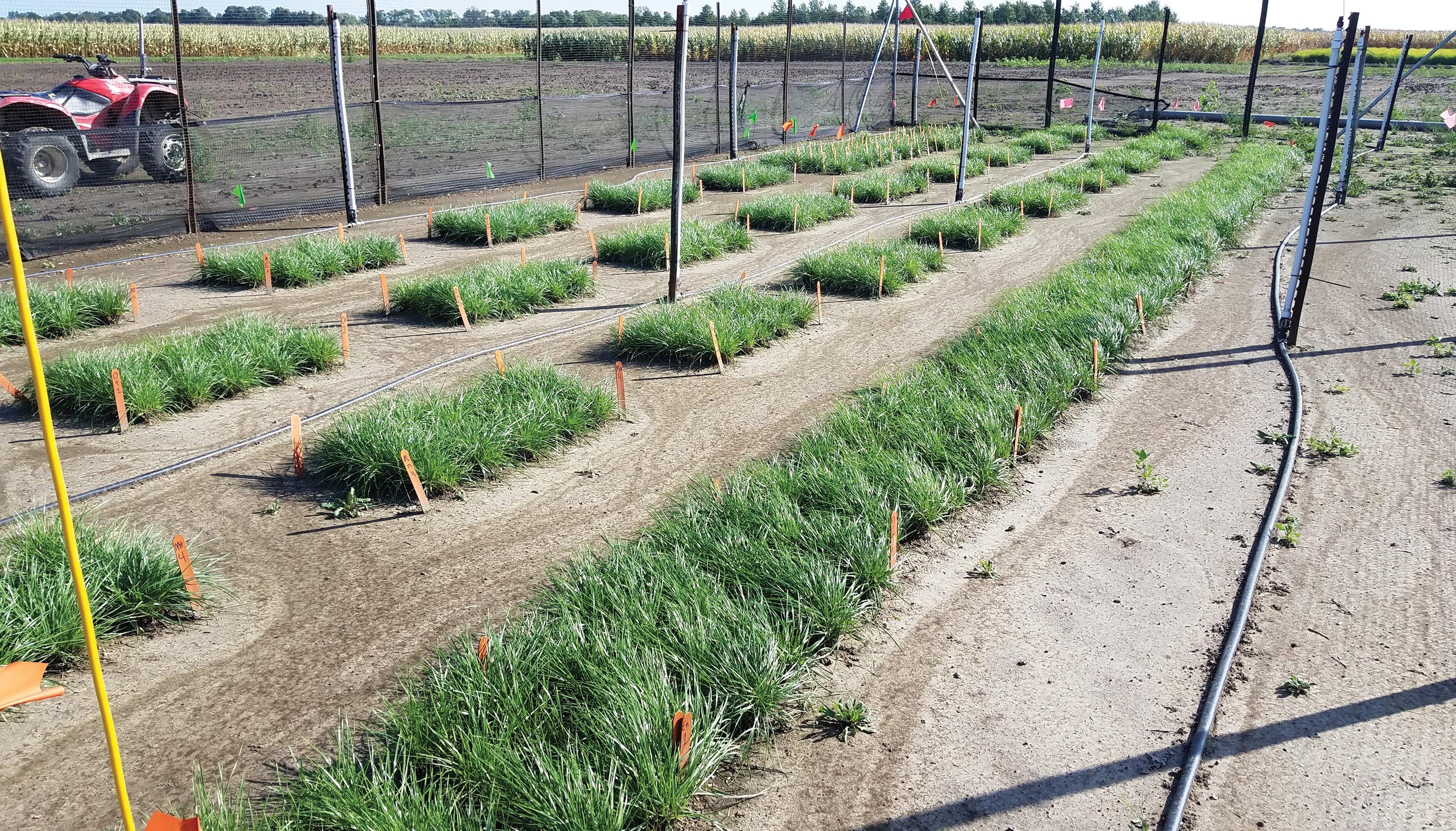
There may be a fair bit of “revving in neutral” for some time yet. It may take an election, a consultation period and a deep level of policy writing to get the green light.

AgResearch scientists are using genetic modification to select a high metabolisable energy (HME) ryegrass.
This is funded by the Government and commercial partners Grasslanz Technology Ltd, PGG Wrightson Seeds and DairyNZ. This is being done by adding and modifying two plant genes to increase lipid content in the leaf and boost photosynthesis in the plant. Current research suggests that methane reductions of 10 to 15% may be achievable but animal feeding trials are still to be done. Work on the HME Ryegrass has taken place, in containment in NZ, and in outdoor growing trials in the US where the regulations allow it.
A second breeding programme is to capture the benefits of tannins in white clover. AgResearch scientists, working with seed companies, have identified a molecular “master switch” that accelerates the production of condensed tannins. This results in significant levels in the leaves of white clover. Condensed tannins reduce urinary nitrogen and methane production from grazing animals, reduce bloat, reduce internal parasite burden, and improve animal
76 Country-Wide | AUGUST/SEPTEMBER 2023
Trial work in the USA: AgResearch HME ryegrass after being transplanted out from the glasshouse.
productivity. Research to date suggests methane reductions of 15% or more may be possible, but further research is needed. This includes animal feeding trials.
AgResearch has developed a ryegrass with a gene-edited endophyte, that produces a fungus to deter plant pests but doesn’t knock animal production


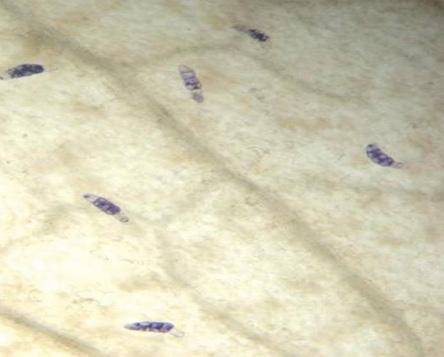


and welfare. Ryegrass staggers and related heat issues can have huge effects on sheep, cattle and deer.
Malcolm Bailey from AgResearch’s Endophyte Gene Editing Steering Group said a change in out-dated regulations could see the trial work shifted back to NZ.
“The National Party policy is a
welcome development.
“We are not asking for complete deregulation – we accept we need regulation.”
AgResearch has also developed a ryegrass that can withstand drought. A simple concept based on complex science that could have huge benefits for NZ farmers.
The planet’s favourite
bait
Ironmax Pro®: Powerful But gentle on the earth

77
The differences between Wild Type White Clover (left), and the White Clover bred for High Condensed Tannins (Hi-CT). The tannins show up purple as they are stained for the photo. Tannins occur naturally on the hairs at the base of the clover leaf, but the Transgenic White Clover produces tannins in the whole leaf area. Tannins are good for reducing methane, bloat, internal parasite burdens and for boosting animal production.
Talk to your local merchant to find out more. Registered pursuant to the ACVM Act 1997, No. P009801 See www.foodsafety.govt.nz for registration conditions. Approved pursuant to the HSNO Act 1996, Approval Code HSR000143 See www.epa.govt.nz for approval controls. Ironmax is a registered trademark of De Sangosse SAS UPL-LTD.COM
Ironmax Pro is next gen science that’s building on the toughness of Metarex® Inov. And it’s a great fit for all farming and growing practices – conventional, sustainable, regenerative, and organic.
slug
REALISING CATCH CROPS’ POTENTIAL
particularly where it is attached to the soil.
Catch crops can also improve soil condition. Malcolm says while soil condition is not a variable they’ve looked at in detail, visually the soil condition was significantly better in the plots under catch crops compared to those left lying fallow.
Timing is everything
Sown in the wake of intensively grazed winter forage crops, catch crops such as oats and Italian or hybrid ryegrasses capture and use the nitrogen (N) left in soil from urine patches and turns it into drymatter (DM).
The four-year catch Crops for Cleaner Freshwater programme, has been run by Plant & Food Research soil scientist Dr Brendon Malcolm in conjunction with AgResearch.
Now in its final year, the programme has identified and demonstrated best-practice management of catch crops through trial sites established on commercial farms in Southland, Canterbury and the West Coast. A lysimeter facility installed at the
Southern Dairy Hub in Southland has also allowed scientists to directly measure how effective catch crops are at reducing N leaching in that region.
Malcolm doesn’t believe many farmers fully realise the potential value they could capture from early sown catch crops, not only from capturing excess N, but also from crop yields.
Trial work in Canterbury has shown catch crops can effectively reduce N leaching by up to 60%, but they can also reduce the potential for soil loss.
“We’ve seen a 40% reduction in soil runoff in plots under catch crops compared to the plots left fallow,” Malcolm says.
They can also reduce phosphate losses,
The key to successful catch crops is timing and Malcolm says these crops should be sown as soon as practicable after the paddock has been grazed.
Cereals such as oats can germinate in soil temperatures as low as 2C, but Malcolm says they recommend sowing when soil temperatures are 4–5C, particularly if soils are heavy or very wet.
In the researchers’ experience, soil temperatures very rarely drop below this for significant periods and this is across all the regions in the programme.
In Southland, one-pass spader drills are ideal for drilling in heavier and wetter soils, but in other regions drilling should take place as soon as the tractor can get on the paddock.
Higher than normal sowing rates of 110–120kg/ha are recommended to achieve target plant populations of 300 plants/m². The greater the plant density, the more light is intercepted and the higher the crop yield and N uptake. The higher sowing rate also allows for some seed losses. In very wet soils, Malcolm says Italian or hybrid ryegrasses should be included with cereals.
While the seeds will germinate, establish roots and capture N at these low temperatures, the seedlings may take 4–5 weeks to emerge when sown in winter, and this is where patience comes in.
Farmers may think that the crop has rotted in the ground. But in the many catch crop trials Malcolm has been involved with since 2014 there have been only two crop failures when several torrential rain events shortly after sowing caused the worked soil to cap. Ironically, the crop established around the trial plots
78 Country-Wide | AUGUST/SEPTEMBER 2023
With the right timing and a bit of patience, catch crops can reward growers with high-yielding supplementary feed crops that can generate gross margins of more than $1000/ha.
By Sandra Taylor.
Sown July 11 Sown August 3 Oat catch crop biomass (t DM/ha) 10 8 6 4 2 0 Jul-1 Aug-1 Sep-1 Oct-1 Nov-1 Dec-1 CATCH CROPS
Figure 1: Mossburn catch crop trial
was successful because it was sown into a coarser seed bed and with Italian or hybrid ryegrass.
The importance of early sowing was particularly highlighted in an on-farm trial in Mossburn in 2021.
One plot was sown on July 11 and the other just three weeks later on August 3. By November 7 the early sown crop was yielding 4.5t DM/ha, while the later sown plot yielded 1.4t DM/ha. By the time the plots were harvested for green-chop silage, the early sown crop yielded 9.3t DM/ha compared to 4.5t DM/ha in the later sown plot.
Similarly, the amount of N captured by the two plots at green-chop varied accordingly, with the early sown oats capturing a total of 106.9kg/ha versus 89kg/ha. The differences were particularly large during earlier samplings.
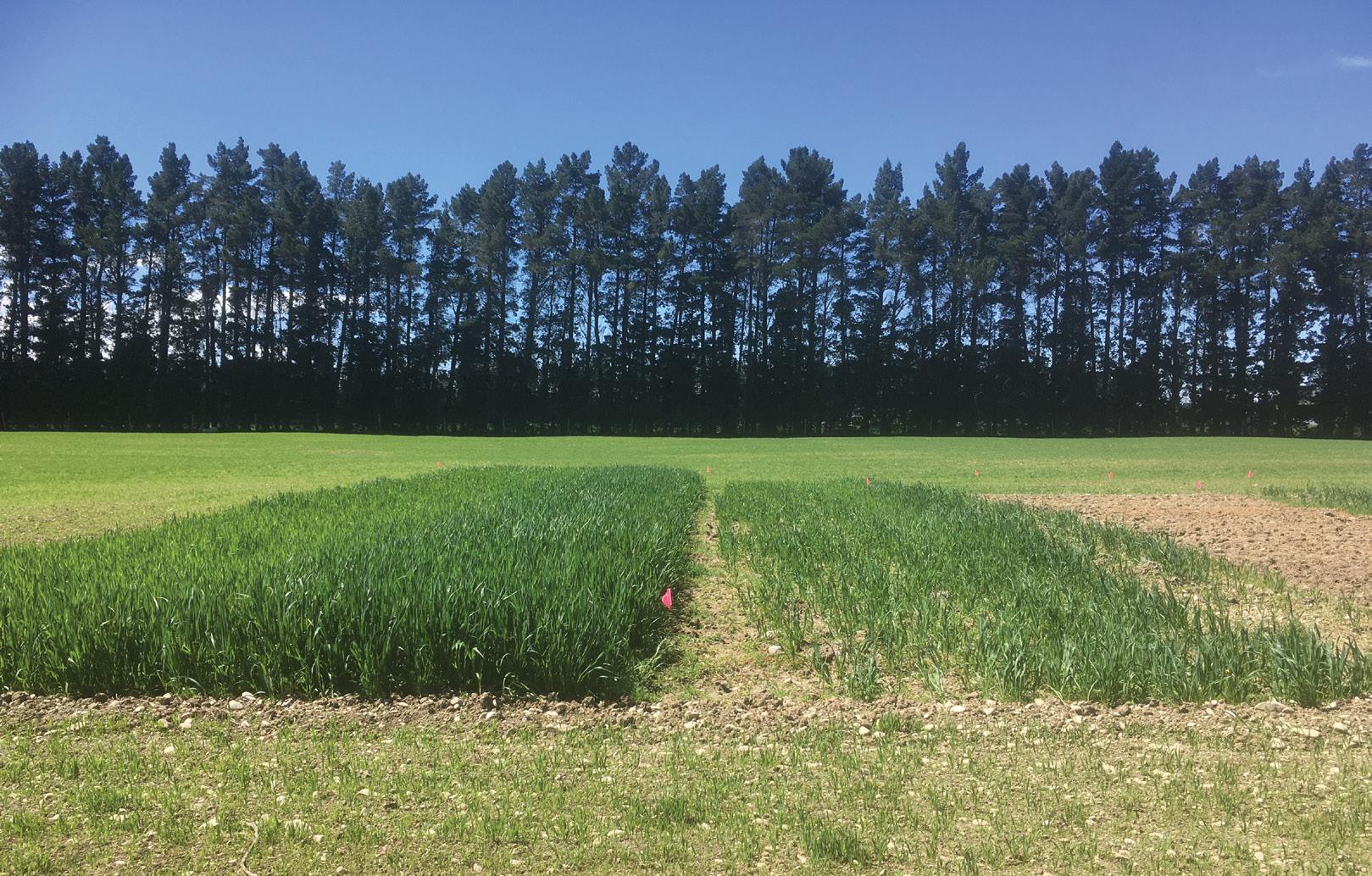
“When sown early, the root system develops early so when soil temperatures increase, the crop bolts ahead.”
In this instance, the growth in November after canopy closure was explosive and the grower was rewarded with a high-yielding crop of green-chop silage.
Regional variance
In a Canterbury trial, a catch crop of oats sown after a kale yielded 10t DM/ha and at a value of 20c/kg DM, this generated a gross margin of more than $1500/ha.
While sowing as early as July is not always practical, Malcolm says sowing in August and into early September can still significantly reduce N leaching.
“Treat the catch crop as a main crop, even when sown late. It will still pay.”
If sowing is delayed until late September and October in Canterbury, the main leaching period will generally be over, and the focus will be on the next forage or pasture crop.
He says because soil temperatures are colder in Southland, the window of opportunity for establishing catch crops is wider than it is in Canterbury and other regions further north.
It’s important that if the paddock is cultivated after winter grazing, then it should be drilled as soon as possible. Cultivation in itself releases N via the process of mineralisation, just adding to the existing leachable pool. While this will be captured by a crop, leaving a cultivated paddock to lie fallow will just
MAXIMISE THE BENEFITS OF CATCH CROPS
• Sow as soon as conditions allow after winter grazing
• Select winter-active species (oats and/or Italian ryegrass are ideal)
• Talk to your seed rep and order seed early
• Target high plant populations to capture nitrogen. For cereals about 300 plants/m2 (110–120kg seed/ha for oats) is ideal
• Minimise tillage where possible
• Control weeds
• Nitrogen (40–50kg/ha) may be required from canopy closure (October) – not at sowing
• Harvest timing – for green chop silage harvest oats at booting (just before seedheads emerge).
exacerbate the risk of leaching.
N fertiliser is not required when sowing catch crops as the crops will capture soil N, but 40–50kg N/ha may be required from early October when the canopy has closed over and the catch crop starts to grow or show signs of N deficiency. This small application of N will help boost yields and increase the amount of crude protein in the leaves.
Another tranche of Catch Crops for Cleaner Freshwater is the use of a modelling tool to extrapolate the results of the trials onto different soil types, climatic conditions and seasonal variations amongst other variables. This will give farmers an indication of how catch crops might perform in a range of environments and climates, and under different management scenarios.
To follow the trial work, see Facebook page @catchcrops and Twitter page @malcolm_brendon
Country-Wide | AUGUST/SEPTEMBER 2023 79
i
A trial highlights the benefits of sowing catch-crops early. Sown just three weeks apart, by the time the plots were harvested for green-chop silage, the early sown crop yielded 9.3t DM/ha compared to 4.5t DM/ha in the later sown plot.
RPR’S ROCK ROAD Y
The phosphorus (P) in most phosphate rocks (PR) is not plant-available – it must be chemically treated with acid to convert the P into a plant-available form. In New Zealand this is done by treating carefully chosen PRs with sulphuric acid, making water-soluble P plus soluble sulphate S. However, it was realised in the early 1990s that some PRs were sparingly soluble – they did not require treatment with acid to make the P plant available. Thus came the idea of direct application of reactive phosphate rocks (RPR), by-passing the need for any manufacturing.

RPRs were introduced into the New Zealand fertiliser market in the mid-1980s, coinciding with the removal of fertiliser subsidies, and with a claim they were cheaper than superphosphate as a source of P, and agronomically equivalent to super – in other words a kilogram of P from super was equivalent to a kilogram of P for RPR. They were strongly promoted by new, emerging start-up companies and enthusiastically purchased by farmers.
At the time I was national science leader of the Soils and Fertiliser Group in the old Research Division of the Ministry of Agriculture
& Fisheries, which morphed in 1992 into the Crown Research Institute called AgResearch. As a measure of the interest in RPRs at this time, it is interesting to reflect that about 50% of the group’s annual R&D budget was directed towards research on RPRs. It was a big deal.
Initially we – most soil scientists – went along with the early RPR narrative. We had no research data at the time to say otherwise. But as our research developed, a different ‘story’ emerged.

Unravelling the knots
It was true that on a total P content basis RPR P was cheaper than the P in super. But as the science emerged it became increasingly clear that RPRs were not agronomically equivalent to soluble P fertilisers, such as super. As things turned out, it became a complex knot to unravel.
Some of field trials comparing RPRs with soluble P fertiliser were laid down on soils that had an adequate soil P status initially; in other words these sites were not initially P responsive to P fertilisers and hence it appeared that RPR was as good as soluble P! This, of course, masked the slow release nature of RPRs.
FERTILISER
Dr Doug Edmeades is a scientist and the managing director of agKnowledge, a soil and pasture nutrition consultancy company.
Not so long ago RPR was seen as the new fertiliser saviour, but science and experience has shown it to be less of a success than first predicted and promoted. By Dr Doug Edmeades
It took many years of experimentation to discover that the P in RPR was indeed slow release and that it took about 4–6 years for annual applications before RPR “caught up”
There was a further complication. It was realised that the main RPR we were testing (Sechura) contained molybdenum (Mo) and that some of the field trial sites were Mo deficient. In other words, some of the pasture response we attributed to RPR was indeed a Mo
As the research continued, it also became apparent that not all RPRs were agronomically the same. Trials were undertaken comparing RPR from different sources around the world. Sechura, an RPR from Argentina, was consistently the best and our research, both in the lab and in the field, showed that it dissolved at about 30% a year. This was the cause of the so-called RPR lag effect of 4–6 years – expressed differently, it took about 4–6 years of annual applications before sufficient RPR residues built up in the soil, such that the pool of plant available P was sufficient to maintain pasture production. Other RPRs, some from North Africa and USA were not as
Some RPRs had a liming effect and this was strongly promoted as another good reason for using RPR. The advertising patter was obvious – soluble fertiliser, like super, was made by reacting phosphate rock with sulphuric acid, as discussed, to produce plant available P. It was not a great leap in faith to assert that super was bad because it acidified the soil, whereas RPRs were good because they had a liming effect. Once again it took some time to unravel the

It turned out that, while some RPRs contained liming materials, the amounts were small and insufficient to have any practical effect on soil pH when RPR was applied at
The super-acid link also required attention. It is true that in the early days of super manufacturing in NZ – back in the 1950s – the demand for super was such that the product was not properly ‘cured’; the chemical reaction between the PR and the acid was not complete and hence they contained some ‘free acid’. This was problematic because in those days super was sold in jute bags, which rotted over time. Thus, it was not difficult to believe that super
was acid and by extension, not good for soil biology. This myth persists today, even though these days, with improved manufacturing, super contains very little ‘free acid’.

The sulphur issue
The introduction of RPRs also required us to do more research on the nutrient sulphur (S). Most NZ soils require S as well as P. Super contains S and hence in most circumstances, if super was applied to meet the need for P, this also satisfied the need for S. RPRs contain no S and hence S had to be added and the only way of doing this was to mix elemental S in with the RPR. Easy? No!
Elemental S is not water soluble and must be broken down (oxidised) by bugs in the soil to become plant available. This biological reaction takes time and depends, among other things, on the particle size of the elemental S and the soil temperature. Thus, further research was required to determine the optimal particle size for our NZ conditions.
Looking back, some very good research was conducted between 1985 and the late 1990s to unravel the RPR-elemental S knot – to understand the basic chemistry and agronomy. At its peak, RPRs and RPR-derivatives made up about 30–40% of the fertiliser market.
Today the market is much diminished – the bubble has burst. Some farmers discovered at their cost what the science was showing – RPRs were not as good as was initially thought, relative to super. Also, RPRs are now priced off the market especially taking into account the lag effect. Their use is largely limited to the organic farming sector and to those few who have not taken on board the science or otherwise continue to believe that RPRs have a role to play in this environmentally sensitive time.
In this regard, some recent research has provided encouragement. It has been found that P runoff can be reduced by using slow release RPR, compared to soluble P. However this effect of RPR lasts for only about four months following application, thereafter the amount of P runoff is the same. In any case, new RPR-like products have been introduced to the market to meet this need and it is now realised that the amount of P runoff is determined in the longer term (> 6–12 months) by the soil P status (Olsen P) and not the type of P product applied.
Country-Wide | AUGUST/SEPTEMBER 2023 81
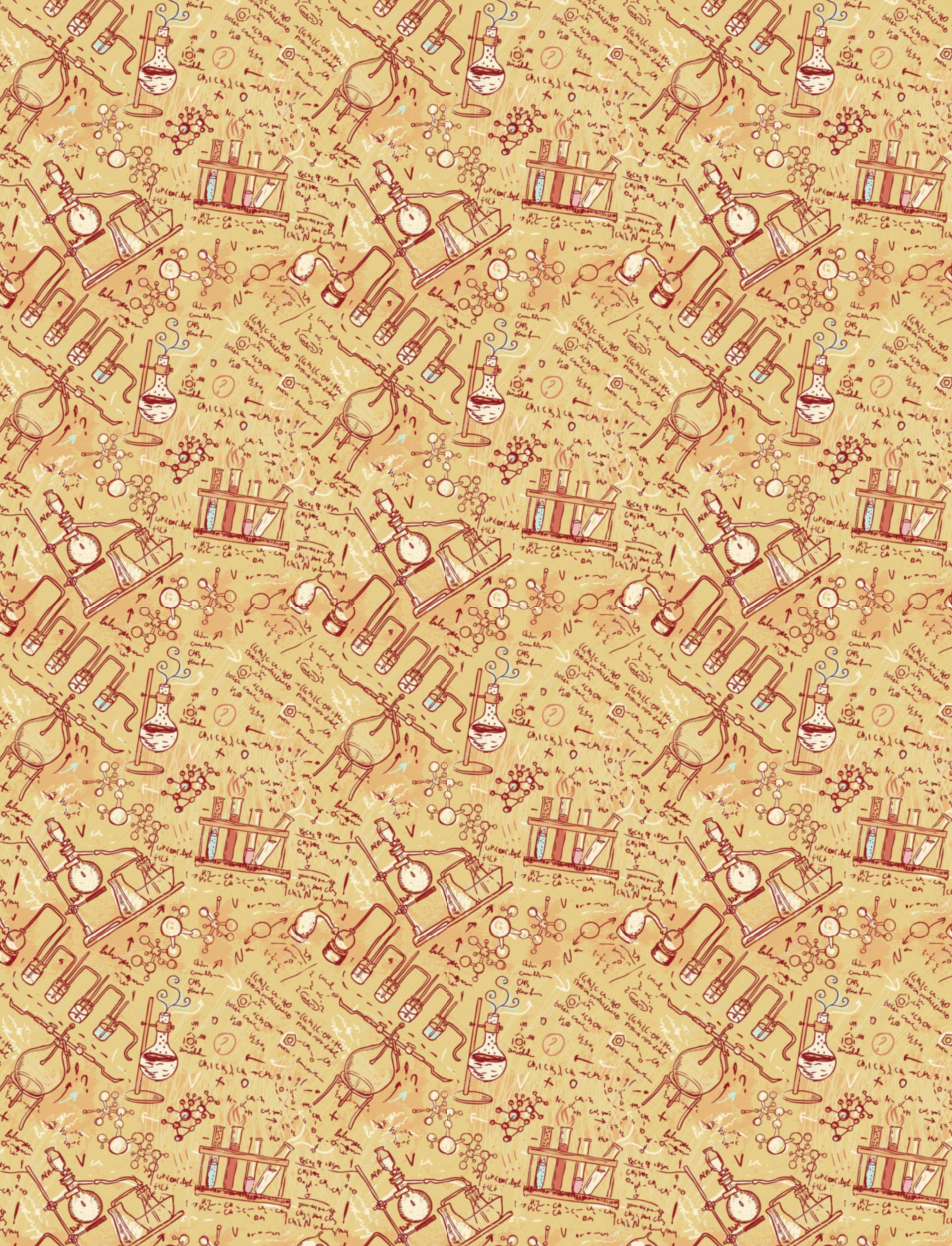
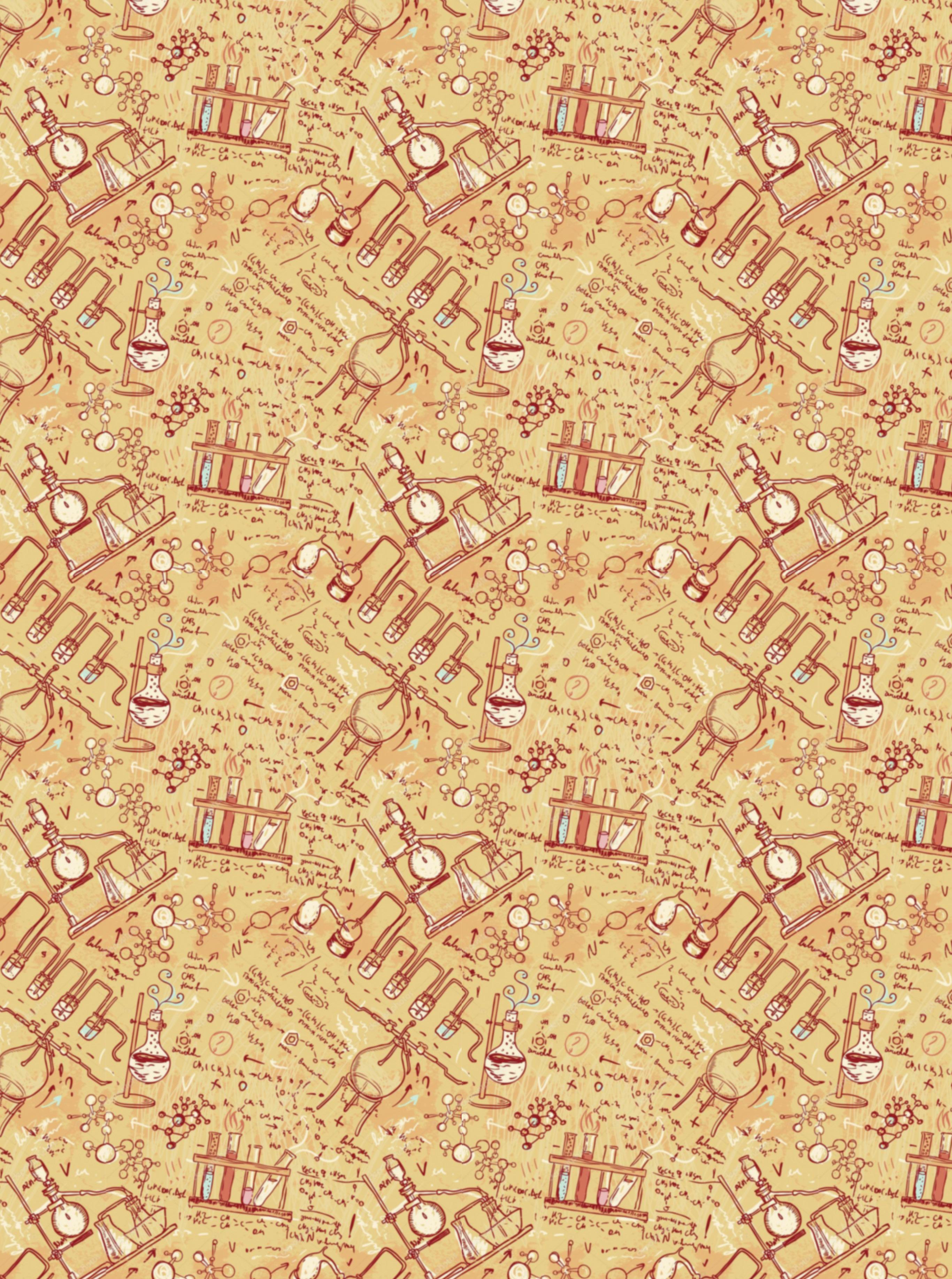

Ignoring science –not worth the risk
nutrient that will be available within the growing season.
The tests extract the nutrients in soil solution and a proportion of the plant-available pool. The tests have been calibrated for NZ soils and growing conditions, enabling target ranges to be established for different crops and soils. The tests have been used to assist farmers in their decisions about which fertilisers to use at what time and in what quantities – the four Rs refer to the right amount, right place, right time and right form of nutrient.
In 2021, Sri Lanka decided to become an organic nation – the first country in the world to take the step. The Sri Lankan government apparently believed there would be rewards in the form of higher prices (a premium) paid for export produce.
Agrichemical imports were banned. Although the government allowed farmyard manure to be applied under the agrichemical ban, it hadn’t calculated whether there would be sufficient manure produced in the country to compensate for nutrient export. There wasn’t.
The result was a crash in yields: rice production decreased by 25% and tea by 35%. Media reports suggested that 30% of land was abandoned because farming under the new regime was financially unviable. Food was scarce and foodprice inflation hit 21.5% in the year to December 2021 – the year of the organic experiment. Rural poverty increased and the economy suffered. Contributory factors included Covid-19 destroying the tourist industry. Riots followed.
Sri Lanka provides an example of what can happen if science is ignored.
The science says that to maintain soil quality, nutrients harvested (in food) from the soil must be replaced. Theories that the soil can supply everything that is needed works only in the short term or in a subsistence (low-yield) system.
Scientists globally have studied soil biology, chemistry and physics and have the data. The research is under constant development, but it is clear that nothing comes from nothing – if maintaining soil quality and productivity is the goal, what is taken out must be replaced.
New Zealand scientists have been studying the soil that underpins production within the NZ environment for decades. Working with farmers in different parts of the country, soil scientists have identified how to manage the soils to increase soil organic matter and maintain productivity despite the removal of nutrients in meat, milk and other products sold (could be hay, maize silage, etc).
Developments have increased production while enhancing soil quality. Organic matter in soil, particularly under pasture, has increased since deforestation because of the addition of fertiliser to enable plants to grow and animals to be fed.
Testing and more testing
In the 1980s, the early iterations of what is now Overseer enabled farmers and their advisers to apply fertiliser to match nutrient exports while maintaining or developing the soil, depending on the starting point of the farm. The starting point is identified through soil tests which indicate the amount of the desired
More recently, tests have been developed for cropping that allow an assessment of how much nitrogen the crop needs to achieve a desired yield, how much will come from the soil, and what must be applied to achieve that yield. An example is the AMAIZE-N calculator https://www.far. org.nz/articles/1244/amaizen-lite on the Foundation for Arable Research website. For production to occur, nutrients that are removed in harvesting must be replaced. In general, the quantity of the nutrient is more important than the form.
Breakdown of soil organic matter provides nutrients, but the organic matter must be replaced if soil quality is to be maintained.
Suggestions that fertiliser isn’t necessary because the soil holds enough nutrients for hundreds of years should be regarded with scepticism, and evidence should be requested.
NZ scientists have data to support their statements about the importance of replacing nutrients.
When the subsidies were removed from agricultural production in the mid-1980s, some of MAF’s long-term superphosphate trials were converted to “withholding of superphosphate” trials. Effects weren’t seen for 3–7 years, depending upon the starting phosphorus concentration in the soil. Research papers describing the trials at Whatawhata, Te Kuiti and Ballantrae are available on
Country-Wide | AUGUST/SEPTEMBER 2023 83
Sri Lanka went organic, and that, coupled with other bad policy decisions, saw the country go into bankruptcy in 2022. Soil scientist Dr Jacqueline Rowarth says we can learn from Sri Lanka’s mistakes.
SCIENCE
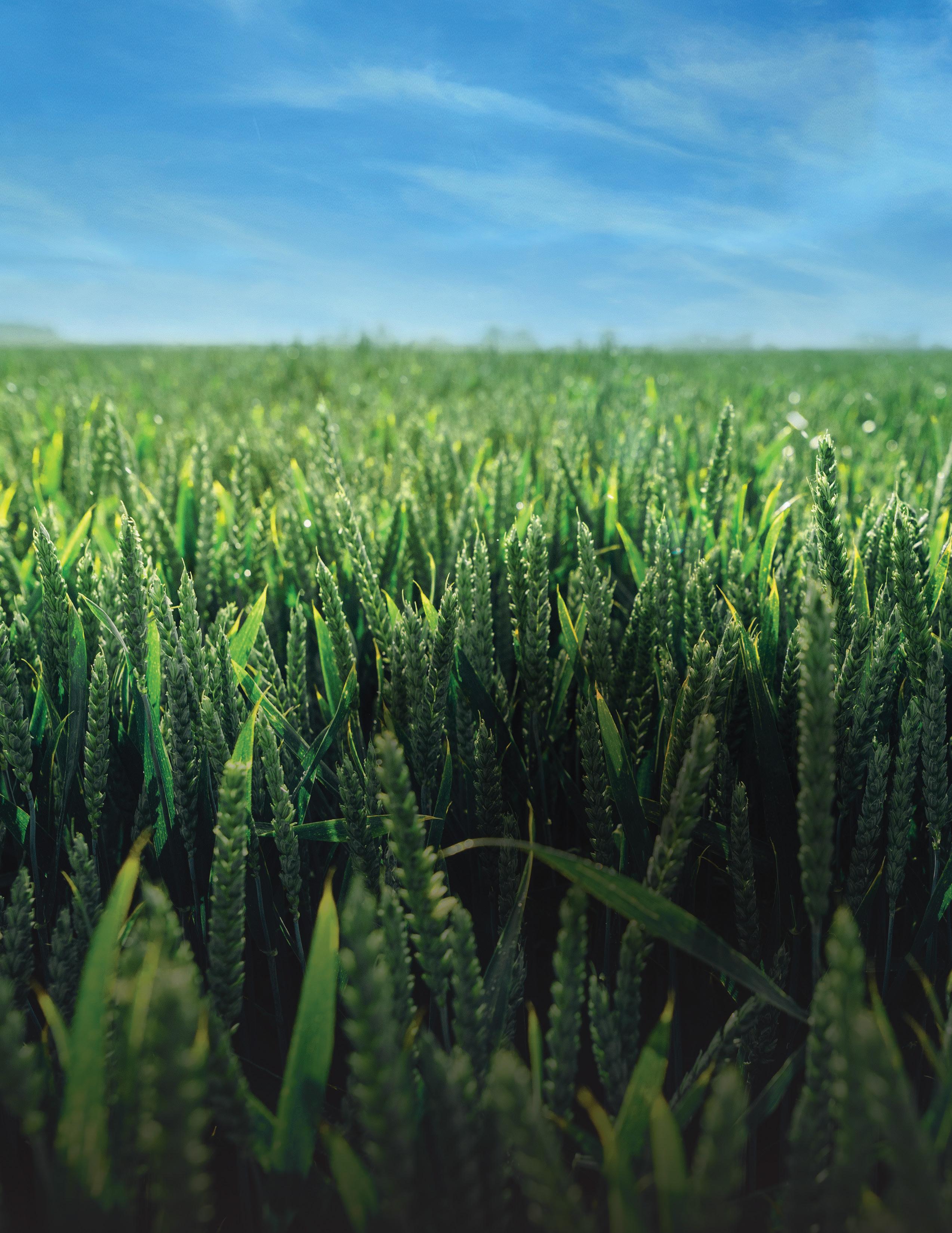
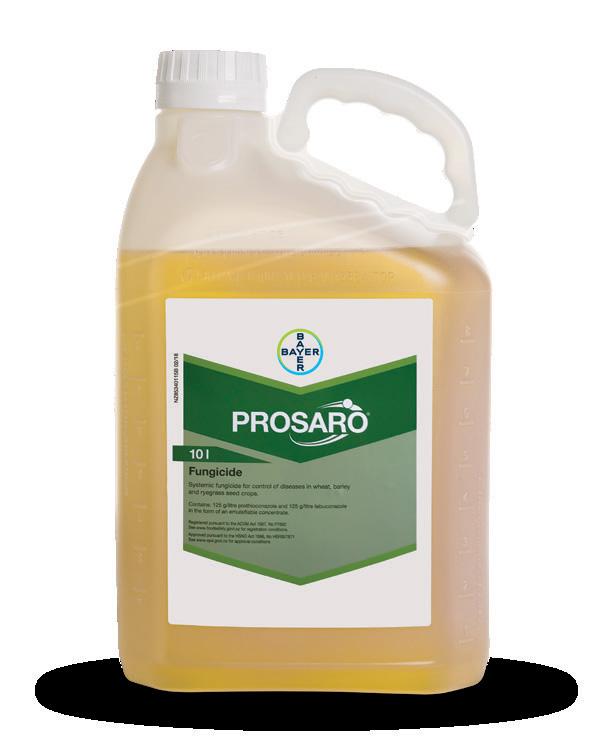
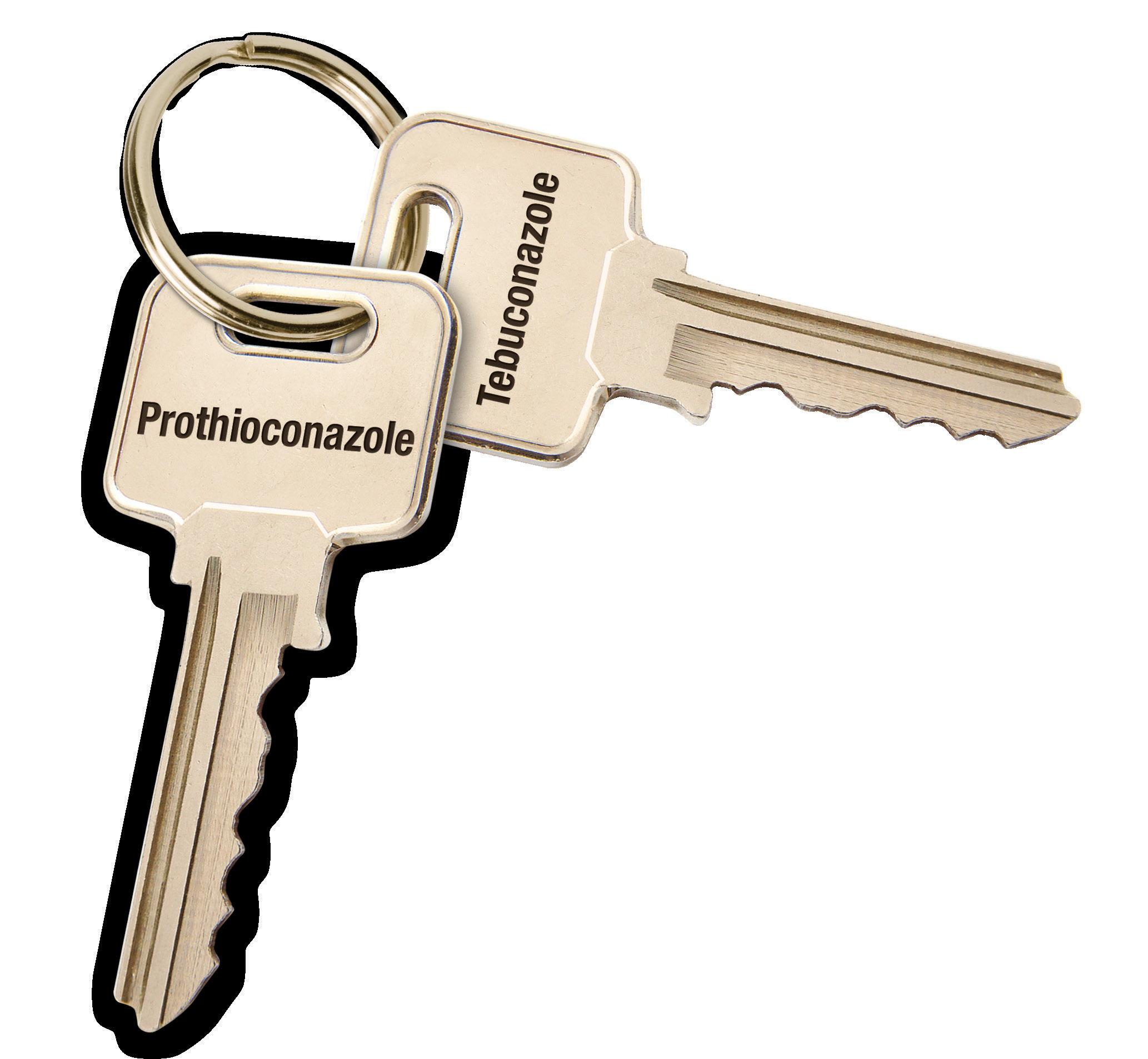
BAC 2880 We’re with you in the field cropscience.bayer.co.nz With the power of dual DMI fungicides Prosaro® Use Prosaro for powerful broad spectrum disease control for wheat, barley and ryegrass seed crops Prosaro hits disease hard with two DMI fungicides, to safeguard Unlock the value in your crop with the dual DMI’s of Prosaro. Prosaro and VIMOY iblon are registered pursuant to the ACVM Act 1997, Nos P7662 and P9617 respectively and are approved pursuant to the HSNO Act 1996, Nos. HSR007871 and HSR101374 respectively. Prosaro®, VIMOY® and iblon® are registered trademarks of the Bayer Group. © Bayer Crop Science 2023.
the New Zealand Grassland Association website (www.grassland.org.nz).
The economics of withholding fertiliser were calculated in a paper published in 1990. The authors concluded that stopping fertiliser could be a sound strategy to survive periods of low product price:fertiIiser cost ratio. They warned, however, that doing so “will decrease sustainable productivity and hence farm resale value”.
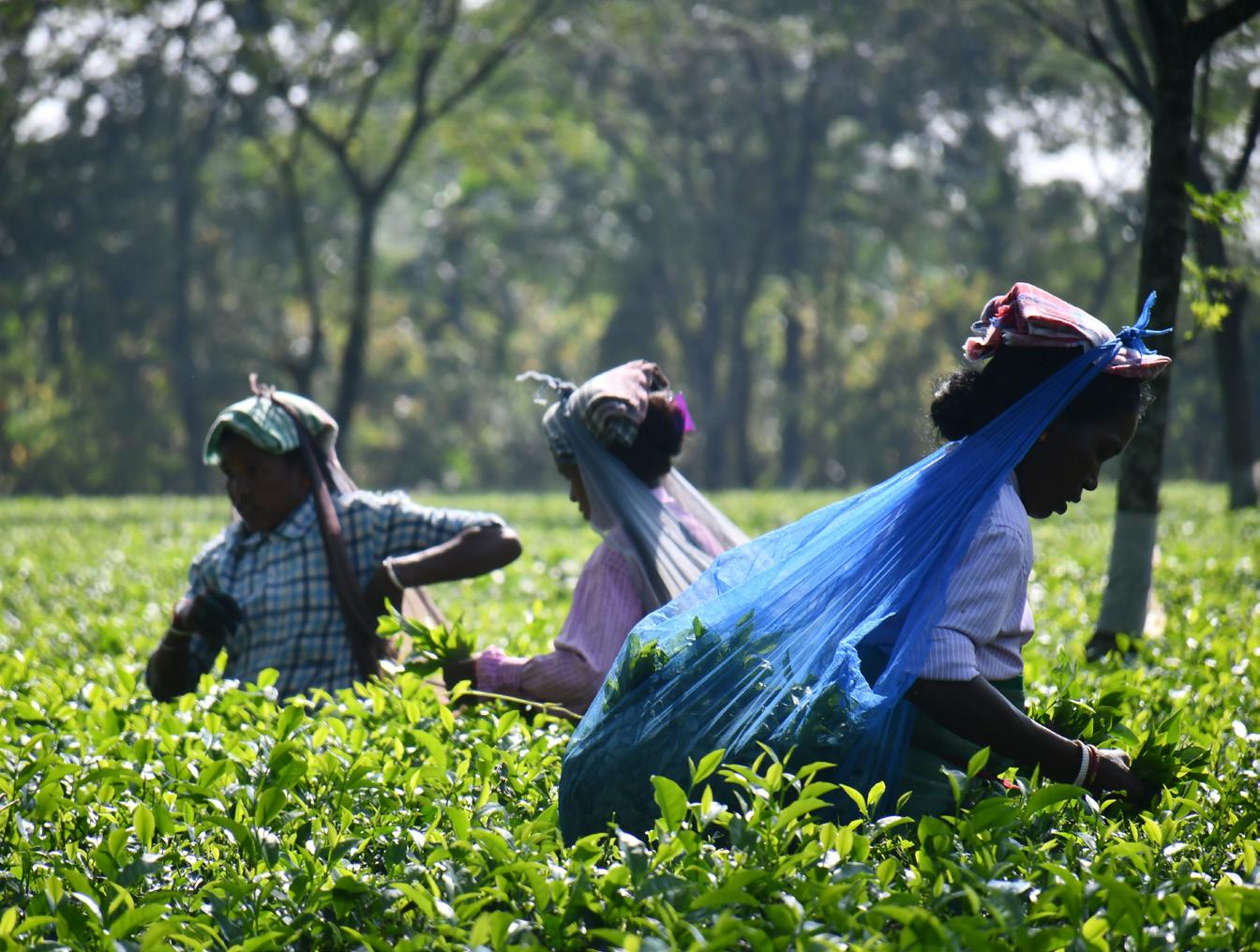
Withholding fertiliser while continuing to sell products means exported nutrients are not being replaced. Ultimately the soil is being mined, and at some point (depending upon the starting nutrient concentrations) soil testing will show that the soils are deficient in nutrients. This is why the property will be devalued.
A 10-year update on the two remaining long-term trials, published on the Grassland Association website in 1999, reported that Olsen P had decreased, annual pasture production had decreased 10–17% (Whatawhata) and 22–42% (Te Kuiti), productive and desirable species had decreased (15–20% for ryegrass and white clover), and the abundance of undesirable species (browntop and other low-fertility grasses) had increased. The authors indicated that the systems had not yet reached a new equilibrium –deterioration was still occurring. Although the soil does contain many nutrients, most (more than 90%) are not available to plants within the growing season. The time frames for availability are long and involve complex biological,
Dr Jacqueline Rowarth, Adjunct Professor Lincoln University, has a PhD in Soil Science (nutrient cycling) from Massey University. She is a member of the Science Advisory Council of the World Farmers’ Organisation and on the board of directors of several agricultural organisations including Ravensdown. The thoughts and analysis presented here are her own. jsrowarth@gmail.com

chemical and physical transformations before the roots of a plant can access them. Cold and drought increase the time frames required.
Looking for stability
Further, the non-available nutrients form the structure of the soil matrix. In the organic matter, carbon, nitrogen, phosphorus and sulphur are part of the stable soil organic matter – stable because it is difficult to break down. Other minerals, some of which are nutrients, are part of the sand, silt and clay particles which, with organic matter, are the components of soil. If all the nutrients were accessed within the soil, the soil’s fabric would be destroyed.
Initial buffering of the biological system shields productivity losses after a change in management, but the longer the period of nutrient deficit, the greater the effect will be. In the case of Sri Lanka, the effect was almost immediate and devastating. Five to seven metres of rain is part of the reason for the quick collapse. Similarly, the Southland story of a move into regenerative agriculture when soil nutrient stores were already low, resulted in a rapid crash. Productivity returned after nutrients became available through the application of conventional fertilisers.
Fertiliser recommendations do not remain the same over time. They are constantly being adjusted according to enterprise, product and fertiliser price, soil nutrient status and nutrient harvesting in product. As science advances, approaches and recommendations are adjusted. The research that underpins the New Zealand soil testing system has been developed and calibrated for New Zealand soils and environment.
Maintaining soil quality is an art that balances biology, physics and chemistry as well as economics. Sri Lanka’s experience is not one that should be tried and stories from individual farmers support the case that nothing comes from nothing.
Country-Wide | AUGUST/SEPTEMBER 2023 85
Sri Lanka provides an example of what can happen if science is ignored.
AN INTEGRATED SYSTEM
The pros and cons for integrating livestock and arable production were discussed in depth and from many angles at a recent industry field day, Sandra Taylor writes.
86 Country-Wide | AUGUST/SEPTEMBER 2023
SYSTEMS
New Zealand is one of the few countries in the world where livestock is integrated into arable systems for the mutual benefit of both.
While livestock thrive on grassseed crops and pasture grown in the restorative phase of a cropping rotation, arable farms benefit from livestockderived nutrients, cashflow, weed control, residue management, and improved soil quality due to belowground soil organic matter returns.
Speaking at a recent Beef + Lamb NZ and Foundation for Arable Research (FAR) field day, FAR’s Abie Horrocks said the benefits of integrating livestock into an arable system were made very clear when looking at soil carbon stocks.
Under pasture, soil carbon stocks were 110–140 tonnes/ha, and under a mixed arable/livestock system they were about 90t/ha, but in soils overseas that had been continuously cropped, soil carbon stocks were closer to 10t/ha.
In integrated mixed systems carbon sat in the top 0–15cm of soil.
“This reflects the diverse rotations in
NZ’s arable systems and the frequent inclusion of restorative phases,” Horrocks said.
The challenge was striking the right balance between restorative and depletive phases.
“It doesn’t need to be livestock but that’s an easy win.”
As many as 93% of FAR farms surveyed had some livestock in their systems and other countries were now looking to NZ to learn how livestock can benefit arable systems.
Horrocks said removing livestock from mixed rotations may have unintended consequences with increased pesticide use.
Grazing grass-seed crops
FAR’s Richard Chynoweth talked about the grazing of seed crops and said the practice had both pluses and minuses, as the main aim with seed crops was to grow biomass which captured sunlight which ultimately drives grain and seed yields.
With early sown ryegrass seed crops, there’s a lot of opportunity for grazing before the crops are closed up in late
spring or at the beginning of stem elongation. This was often at Growth Stage 30–31.
Defoliating crops through grazing in mid-February through to mid-March benefited the crop by stimulating tiller formation.
This defoliation can increase seed yields by as much as 20% compared to not grazing grass-seed crops.
“Grazing is always beneficial to ryegrass seed production, but closing dates are important so the growing points are not removed in that spring period.”
This was the opposite to Italian ryegrasses where late grazing will remove the main growing point and increase the number of seed heads and potential yields.
Chynoweth said there was potential to graze cereal crops, which could be beneficial by removing diseased biomass, but it was important to close the crop off before stem extension.
“Between March and June there is probably more potential to graze cereals than we may believe.”
Country-Wide | AUGUST/SEPTEMBER 2023 87
Stock options in arable systems
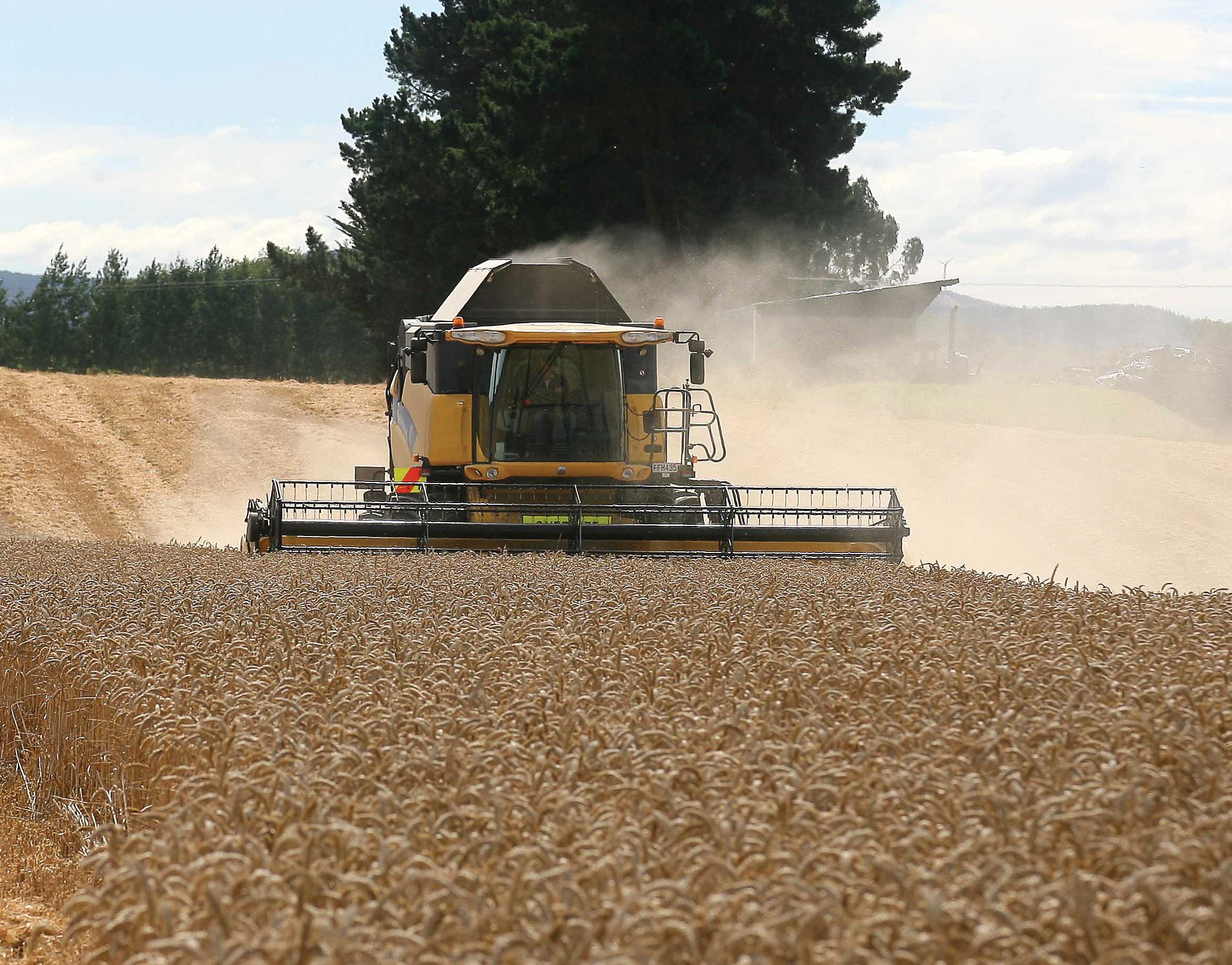
Speaking at the field day, farm systems scientist Tom Fraser said to get the best results from livestock in an arable system, farmers needed to understand and identify the goals for their farm systems.
“Are livestock a tool to achieve higher returns for a crop, or an alternative income?
“The ideal is to incorporate animals into an arable system, without compromising that system, to generate extra income.”
Fraser said there were a number of livestock options for arable farmers and these included prime lamb contracts, grazing replacement ewe hoggets and trading old ewes.
“You don’t have to tie yourself into lamb-finishing contracts.”
When deciding on stock classes, factors such as crop closure needed to be taken into consideration.
“How will you feed your lambs when the crops are closed up?”
Fraser said many hill country farmers struggled to get their ewe lambs up to good weights and he believed there were opportunities for arable farmers to enter into contracts with breeders to grow out their hoggets.
“If you can get alongside a breeder and work out a contract that suits both parties, there are huge opportunities.”
Factors that needed to be worked out included when they arrive, when they go home and flexibilities within these timeframes.
Fraser also raised the possibility of arable farmers buying old ewes and putting weight on them before selling them for processing.
Most important was the decision of when to sell stock, and at the same time ensuring the main goal, which could be arable production, wasn’t compromised.
“Set a date for when preparation needs to start for a new crop and stick to it.”
A good example was when a summer crop, only intended as a break crop, kept growing. The temptation was to
keep grazing it, therefore delaying the establishment and compromising the yield potential of the subsequent crop. Similarly, with winter trading lambs, setting target end-weights and dates would help ensure they were gone before compromising the arable side of the business.
Genetically, all lambs were capable of growing 300g/day and to realise this potential, the lambs just needed feeding, Fraser said.
The best forages for driving lamb growth rates were grass and clover and greenfeed, and while the quality was always good in winter and spring pastures and summer forage crops, grass quality fell in summer and autumn.
“You can’t expect high animal growth rates over December, January and February.”
Faster growing lambs were far more efficient in every respect, particularly in greenhouse gas emissions.
Update on drench resistance
North Canterbury vet and wormwise facilitator Sarah Williams gave an overview of drench resistance and the emergence of triple combination drench resistance in both islands, particularly the North Island.
Vets were also reporting resistance to the new actives, namely Startec and Zolvix, she said.
The biggest risk for arable farmers was buying in resistance with trading lambs. Williams said when trying to prevent resistance becoming an issue, a quarantine protocol should be adopted, rather than just a quarantine drench.
This could include giving the lambs a fully effective combination of Zolvix
Plus and Startech (given separately, not mixed together) and the stock being held in a holding area for 24 hours to empty out any residual worm eggs.
Ideally, finishers should find out where the lambs have come from and that farm’s drench resistance status.
Ten to 14 days after the quarantine drench, a faecal egg count (FEC) will show whether or not that drench had been effective.
“That’s just risk management,” Williams said.
“If the quarantine drench hasn’t worked then you get to fix the problem quickly.”
Drench frequency depends on the farming system. Clean feeds (new
88 Country-Wide | AUGUST/SEPTEMBER 2023
A lamb growing at 300g/day will produce half the emissions of a lamb growing at 100g/day.
“This is what we may have to think about in the future,” Fraser said.
When arable farmers buy lambs in February, many still want them on hand in September to graze grass-seed crops to help lift yields and reduce input costs. This could be a disincentive to fast finishing. There was also the incentive to hit the higher October schedule prices.
Farmer experience
Arable farmers Erica Callaghan from Fairlie, Hamish Marr from Methven, Pieter Taco (PT) Bierema from Mitcham and Darryl Oldham from Wakanui all outlined the role livestock played in their businesses and the benefits and challenges they bring.
Callaghan said they only introduced livestock into their 1800ha cropping operation in recent years. Store lambs were bought in March and in June and July and 100 calves were carried through on the farm’s lighter soils until they were R2s.
“What works really well is cash flow. When we had to change our cropping mix we had another source of income, which spreads cash flow through the year.”
The biggest challenge was bringing lambs into a broadacre system and managing the regulations around winter grazing.
Hamish Marr and his family farm 500ha, with 400ha in arable crops and 100ha in pasture. He said they have two very separate crop rotations: one based on cocksfoot seed production and the other on pastures. Agronomically, they were kept very separate, but both the cocksfoot and pasture paddocks were in the ground for five years.
They grazed dairy heifers and cows and 4000 lambs for a neighbour and while they used to trade lambs, Marr said it got too complicated as they had to
crops or pastures or areas where cattle have grazed for long periods) will have a low parasite larval challenge and this was where arable farmers could have an advantage.
“Knowing the grazing history of paddocks can be useful to understand drench frequency.”
Measuring liveweight gains and carrying out FECs were ways to monitor worm burdens.
“It comes down to farm-specific management, not recipes.”
Williams said refugia was a tool to prevent drench resistance becoming established on a farm. This meant maintaining a population of worms that had not been exposed to drench. These
worms reproduce mostly susceptible worms.
Refugia can exist both in the animal and pasture.
It was much easier to maintain refugia on breeding properties and while it was more difficult on cropping farms, it was still possible, although it required more thought and planning, Williams said.
Other animal issues arable farmers needed to consider were clostridial protection, particularly when grazing high octane pastures or forages, and trace elements including selenium, copper, iodine and vitamin B12.
Nitrate poisoning can be a real danger in autumn and a simple test could prevent stock losses.
SMCO or kale anaemia can be a problem on brassica crops and bloat a risk on clover and kale crops.
To allow rumen microbes to adjust to a new feed, the transition onto crops and forages should be a slow process.
Another factor arable farmers needed to consider was feed composition and whether the feed on offer meets animals’ energy, protein, fibre and micronutrient requirements.
Williams also stressed the importance of not transporting heavily pregnant or lambing animals, which could be an issue for arable farmers. There was a danger when buying store lambs for winter trading that the ewe lambs may have been inadvertently mated.
Country-Wide | AUGUST/SEPTEMBER 2023 89
"Are livestock a tool to achieve higher returns for a crop, or an alternative income?"

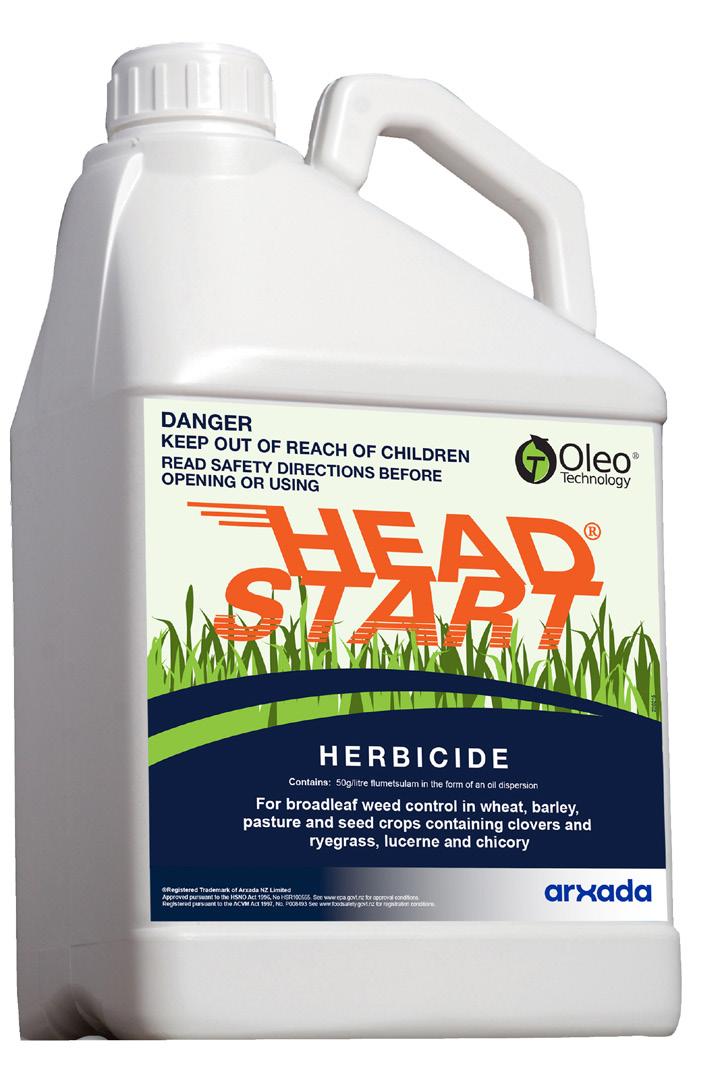
close up cocksfoot crops in May.
He said pasture was the best break crop of all and for someone who was always thinking about chemical resistance, having paddocks in pasture or cocksfoot seed for five years meant it could be 10 years before they were back in a specific paddock with the same crop and the same chemistry.
Livestock also helped spread risk in their business as unlike crops, they were not going to be destroyed by bad weather.
Winter was the biggest challenge for the Marrs and dealing with the impact livestock had on soils.
For the Bierema family, store lambs were an integral part of their 500ha arable business. They start buying lambs at the end of March and sell them from June to October which is when they start closing their grass-seed crops off. The lambs are wintered on forage oats.
Bierema said they saw themselves as arable farmers and lambs were complementary to that.
“Lambs are a good fit. They are good at controlling ryegrass seed crops and after harvest will clean up ryegrass and clover seed crop residuals.”
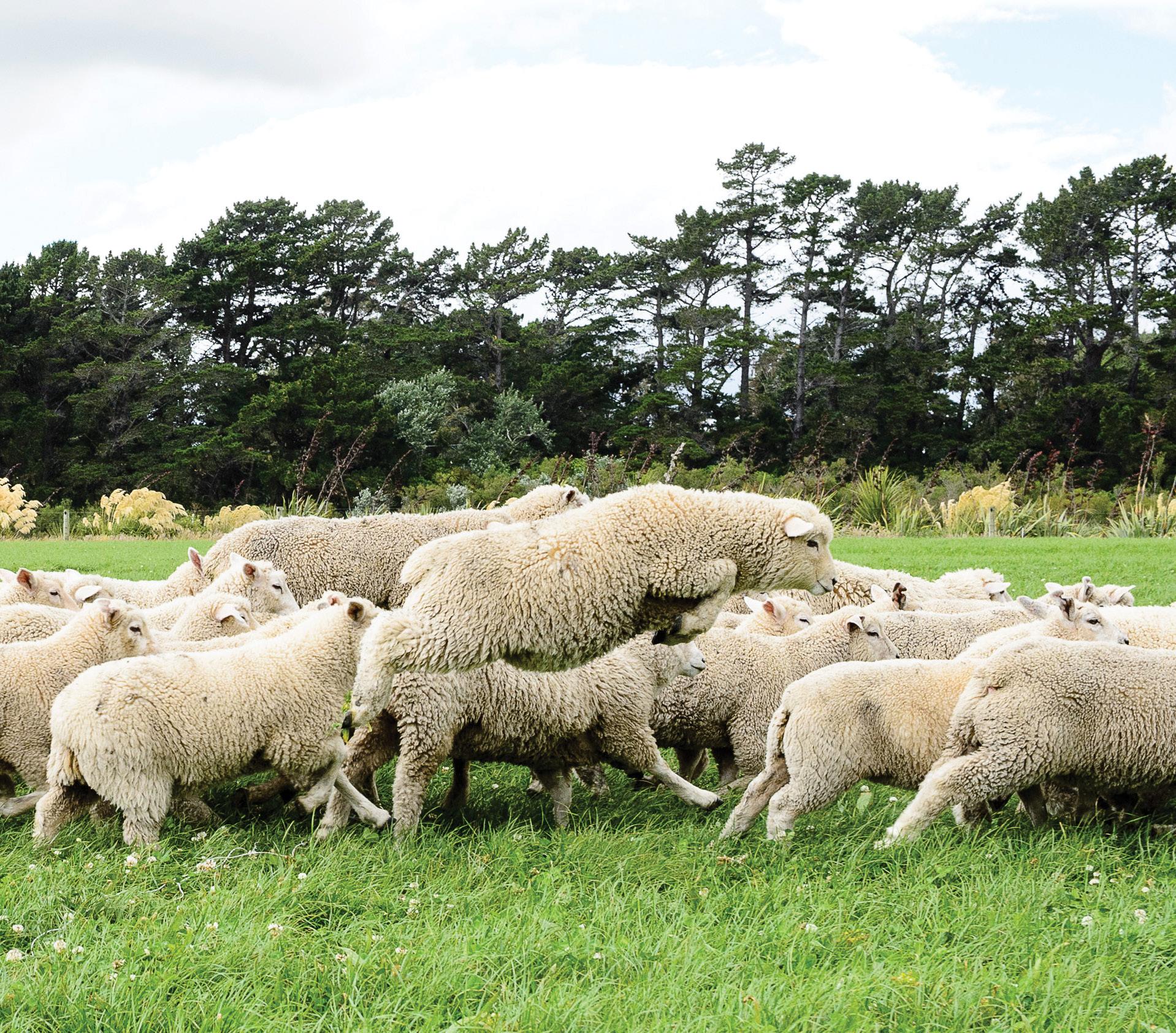
The challenge for them was reliability
of supply of lambs when they wanted them.
Darryl Oldham and his family farm 200ha with one-third cereals, one-third grass and one-third potato crops.
He said they were wintering dairy cows, but their proximity to the river and the implementation of intensive winter grazing regulations was a catalyst for them to move to trading lambs. While they found they had a lot more flexibility for when they call buy and sell lambs and could graze them over the whole farm, unplanned pregnancies were a challenge.
Bierema said unplanned lambs were a huge issue for many arable farmers,
but they got around this to some extent by separating the ewe and ram lambs as soon as they arrived on farm. It does mean sexing every lamb as they’ve found earmarks to be unreliable.
Building relationships
The long-term availability of store lambs as ewe numbers continued to decline and the building of relationships between commercial breeders and hill country farmers looking for grazing was discussed throughout the field day.
Overall, the feeling was that while there were significant opportunities for arable farmers to get alongside hill country sheep farmers, there were also challenges. These included what to feed sheep once grass-seed crops had been closed off, or conversely, sheep farmers wanting their sheep back before grassseed crops were ready for grazing, which could result in compromised yields.
Trust and flexibility were the key ingredients to successful grazing relationships and the willingness to compromise.
Tom Fraser summed it up: “The relationship needs to be a win-win and both parties need to be prepared to compromise.”
Country-Wide | AUGUST/SEPTEMBER 2023 91
“Lambs are a good fit. They are good at controlling ryegrass seed crops and after harvest will clean up ryegrass and clover seed crop residuals.”
Entering the cereal game
With increasing costs and lower returns, the wash up of the 2022-23 season has seen a review of alternative cropping enterprises that have some synergy with sheepdominant farming operations.
The driver of the decision could be a combination of valid factors, most of which have been experienced on previous occasions. In some cases it will be the push of poor net returns, high interest cost and frustrations with the persistence of pastures and physical workload of intensive sheep systems.
For others it will be the pull of a better return from a good class of land where multiple use options are available. Where pivot irrigation is newly available, the draw can be a higher return not previously possible. Irrespective of the drivers, there will be a number of new entrants and market chasers who will be burned as the grain market becomes over supplied.
Managing the risk
There are ways to reduce the risk of the grain option that are worth considering. Getting alongside a good cereal farmer can be a worthwhile option. As with many businesses, there is a lot of enterprise-specific know how, not to mention a fair investment in gear. Ideally there is a sweet spot where knowledge, plant capacity and labour resource meet suitable land for a win-win.
By Simon Glennie.
Modern cropping gear has high capacity and is very efficient but has a price tag to match, so throughput is required. Storage and marketing of the crop are also factors that can constrain net returns, and experienced grain farmers often have arrangements and contracts in place.
The skill, time, resources and networks of the cereal farmer has a value and so too does the landowner who provides the area of soil. A healthy tension should exist to determine whether there is a value proposition and how that value should be divided to give fair reward to both parties.
There are two key questions that drive most of the determination of value in this situation. What is it worth? And what does it cost? From a cereal farmer’s perspective, there is a consideration of the yield risk and likely variability. Soil type, fertility, drainage and the state of the fencing to keep livestock out can be risk factors.
Many of the cropping costs are fixed (don’t vary with yield) but can be somewhat volatile within seasons as we have seen recently with fertiliser, fuel and chemical inputs. A higher outlay of direct input costs and the more hidden
92 Country-Wide | AUGUST/SEPTEMBER 2023
CROPPING
Simon Glennie is an ag consultant with AbacusBio in Dunedin.
cost of depreciation of higher value plant lift the grow costs for all. Add in any allowance for more volatile climatic conditions to the capital outlay and the risk has increased for the grower.
If yield is considered to be constant, then the price for a tonne of grain would need to rise significantly to cover not only the increase in cost but also the increase in risk. In this case, contracts are a way to somewhat secure the price risk. Where contracts are not available, and often this can be the case where buyers sense a glut and prefer sitting on their hands, the risk is increased again.
Consider straw
Straw can be a forgotten part of the equation and is sought out as a bedding or fibre complement for beet grazing. The amount recovered can vary and the nutrient content removed needs to be considered – potassium in particular. However, when we are looking for the icing on the cake, straw can help.
For the landowner, the break of a grain crop can be beneficial, with cleaner young grass and better clover performance often reported. Simply increasing the rate of resowing of aging pasture provides a benefit in terms of overall pasture yield and quality. Where there is an option to sow the area back to pasture after a crop, these upsides need to be considered.
While there is an obvious period of time when the crop area is not available to graze, the time out can often be shorter than a calendar year.
Looking at the annual net return from an alternative system is a good start, but there can be a small twist if a second use of the area is even partly possible. An example may be following a spring barley with greenfeed oats and getting the margin of a winter grazing. Farmers looking to reduce the soil loss under brassica and beet may find the soil holds up better under a cereal.
Growing grain on dairy farms has been mooted as a potential option to reduce N loss. There may be some incentive as dairy companies track the purchased N surplus, but this is some way off making up for the lower profitability and increased risk involved.
It is always possible to embark upon the cropping under your own steam and there is a reasonable history of mixed-cropping farmers in NZ. In many cases these hardy souls were typified by older gear lacking in capacity, accuracy and reliability, as there was never a justification to warrant new kit. This group lags behind by 30 years in terms of efficiency but often gets the job done, albeit somewhat reliant on mechanical ingenuity and know-how to keep the wheels in motion. Often the bane of modern crop farmers, this group can increase the crop area or drop out of the market depending on a hunch on pricing. Any over supply, particularly without storage, can see pricing pressure and softening of contracts. Farmers need to take off the rose-coloured glasses in order to review the sense in dipping into the cereal game.
CROPPING FARMERS URGED TO VOTE ‘YES’
Cropping farmers have been voting to determine the future of the Foundation for Arable Research (FAR), their levyfunded research organisation. Voting by post or online closes at noon on August 25, with results expected on August 28.
Under the Commodity Levies Act, growers can vote to renew levy orders every six years, so a ‘yes’ vote will ensure FAR’s continued existence and ongoing contribution to the cropping industry, while a ‘no’ vote will result in the organisation being wound up and a cessation of all research and extension programmes.
FAR is a key partner to the pan-sector multi-million dollar A Lighter Touch programme that provides the opportunity to effectively leverage FAR funds and deliver greater research outputs for its growers. It’s also a signatory of the Governmentindustry agreement on biosecurity as part of Seed and Grain Readiness and Response. The referendum will not impact levy rates which are set at 0.9% of sale value for all grain and herbage, amenity and open pollinated vegetable seed crops. It is 0.6% of sale value for hybrid vegetable seed crops, $1 for 10,000 seeds bought for maize, and $10/hectare for cereal silage.
Country-Wide | AUGUST/SEPTEMBER 2023 93
“Irrespective of the drivers, there will be a number of new entrants and market chasers who will be burned as the grain market becomes over supplied.”


GIVING CULTIVAR CONFIDENCE
BY SANDRA TAYLOR
For 20 years, independently run cereal performance trials have given arable growers confidence that the cultivars they are selecting have been tested in commercial conditions and their performance rigorously analysed.
Run on commercial arable farms throughout the cereal growing regions of New Zealand, Cereal Performance Trials (CPT) are run independently of any commercial entities and are organised and funded through the CPT committee.
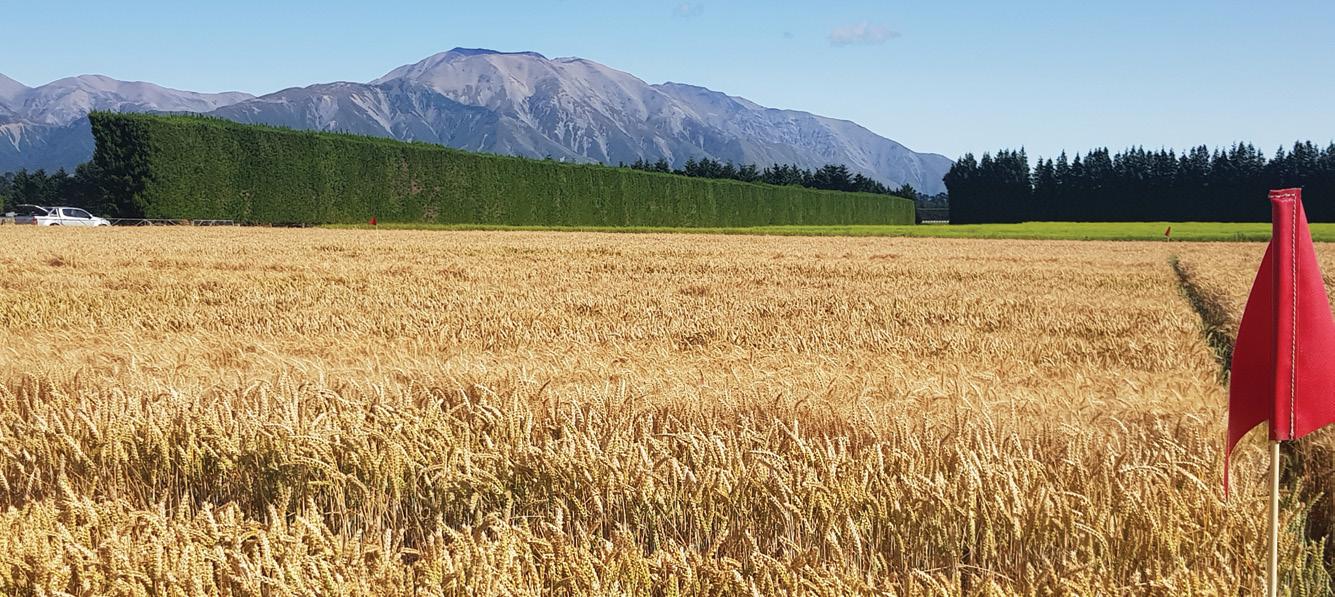
The committee is made up of representatives from the NZ Flour Millers Association Research Trust (NZFMRT), the Foundation for Arable Research (FAR), Plant & Food Research, seed companies and the New Zealand Plant Breeders Research Association (NZPBRA).
The NZPBRA in itself is an umbrella organisation that represents plant breeders, intellectual property owners and managers of proprietary agricultural seed. Its members are companies whose primary focus is the development and marketing of plant intellectual property through demonstrating the strength of research-proven standards of performance.
PGG Wrightson Seeds Nick Brooks has chaired the CPT committee for more than a decade. While breeders or seed companies manage the individual trial sites, he says the critical factor is that the data generated is owned and published by FAR who are independent of any
commercial organisation.
Originally run under the umbrella of Arable Cultivar Evaluation, today CPT is run on 29 trial sites across Southland, Canterbury and Manawatu on a mix of irrigated and dryland farms. CPT tests the performance of feed and milling wheats, and feed and malting barley. The trials are sown among commercial crops, so they are subject to the same management and climatic conditions as the surrounding crops.
Cereals being tested through CPT go through two stages. The first, CPT1, is where advanced breeding lines are tested within a series of collaborative breeder/seed company operated and funded trials. These are run at 15 of the CPT host farms in Canterbury. Based on the outcomes of these trials, companies may then apply to promote promising cultivars into the next stage.
CPT2 is for close-to-market and commercial cultivars and these cultivars are subject to the most stringent quality and environmental assessments.
FAR co-ordinates the trials that are all designed and analysed by an independent statistician.
Brooks says most host farms have been growing CPT within their commercial crops for many years and while they receive some compensation for the use of their land, many benefit from seeing how plant varieties perform in their growing environments.
PGG Wrightson Seeds’ cereal breeder
Steve Shorter has had a long involvement with CPT. He says farm management must be at a robust level that allows the new varieties to express their genetic yield potential as well as post-harvest grain and end-use quality.
Specialist nurseries are carried out within the CPT system to determine other important traits, such as disease resistance and pre-harvest sprouting resistance. Cultivars targeting the milling and baking industries are extensively evaluated using industry-standard quality control rheological tests funded by the NZFMRT.
Brooks says PGG Wrightson Seeds tends to promote its varieties using data from CPT because of their independence and rigour, only adding relevant additional data if required.
Cropmark’s Matthew Hicks says CPT widens their net by giving companies the opportunity to trial varieties in a wide range of farm environments.
Cropmark evaluates the performance of UK-bred cultivars in NZ conditions and while Hicks says they obviously run their own trials, CPT gives them access to sites they couldn’t necessarily access on their own.
The results of the CPT are presented in FAR’s spring and autumn cultivar booklets, although early yield results are presented every week over the harvest period in FAR’s weekly Harvest Snippets newsletter. Brooks says this gives growers in regions that need to establish crops in early autumn an indication of cultivar performance.
The results in the cultivar booklets are far more detailed. They include an assessment of a cultivar’s susceptibility to a range of diseases, straw strength, crop height, maturity and sprouting susceptibility. It also includes yields and grain-quality data, such as test weight, protein levels and screenings.
Detailed information is provided about each trial site including soil types, previous crops, sowing and harvest dates and inputs.
To remove seasonal variations, the yield results are also presented in a fouryear adjusted mean and this ranks the cultivars based on the relative yield of that site over four years.
Country-Wide | AUGUST/SEPTEMBER 2023 95
PLANT BREEDING
Cereal Performance Trials are run on 29 trial sites across New Zealand.
SPREADING THE RISK
There’s no rule book on the Taggarts’ farm in North Canterbury, and they don’t mind the debt because it keeps them pushing. Story and photos
 by Annabelle Latz.
by Annabelle Latz.
FARM FACTS: Cust, North Canterbury, 732ha (714 effective) • 700mm average annual rainfall • Between 160m and 180m asl • Stock: 250 cows, 5500 lambs.
CROP: 220ha wheat, 175ha rye grass, 30ha maize, 13ha barley, break crops for the export vegetable seed market. • Maize, forage rape, hybrid rape, carrots, parsnips, white clover, red beet, radish, corn salad, kale for seed, and a small patch for onion • Yields: Wheat 15t/ha (best), ryegrass seed 1.6-2t, white clover seed between 500–800kg/ha • Benchmark net profit: $3000/ha.
96 Country-Wide | AUGUST/SEPTEMBER 2023
i
Astone’s throw from the quiet rural town of Cust, the 732ha (714 effective) mixedcropping farm sits in behind Summerhill, where to the west are the Southern Alps, and to the south across the Waimakariri River are the Canterbury Plains.
The Taggart family has worked this land since 1958, now three generations deep.

“We are having a big consolidation now,” Roscoe says.
Having the ability to diversify is key to help spread the risk. During any year there will be fluctuations of lambs on the ground, crop production and in how they’re utilising the residues.
“Our strength is that we are able to diversify with our crops, tonnages, and animals.”
The income blanket has been thrown wide over various income streams and markets, to hedge any major downturns and not make themselves too reliant on one area.
“We have got an absolute mountain of debt, we are doing this to save money because we can’t afford to take punts.”
Rainfall used to average about 650mm a year, but in recent years it’s been closer to 700mm. Roscoe would choose to irrigate over a muddy summer, reflecting on the previous two harvests that have been the worst in 20 years.
“Rain equals disease, which means a lot more spraying.”
Every hectare must pay its way, because each one they paid for, therefore must provide a return.
Roscoe, his wife Gracie and Roscoe’s father Murray, who is the Alliance Meat
Group chairman, work in a trading partnership called Taggart Farms, leasing the four family farms.
Roscoe bought his own first bit of dirt in 2012, and since then has been adding to it.
“If more land comes up, we’ll buy it or lease it, because I love the idea of growing the farm.”
Farm and family life is busy. Roscoe and Gracie have three children, Harry 3, Heidi, 2, and Ollie, 6 months.
The farm comprises two full-time staff, a truck driver for six months of the year, and Murray works on average one or two days a week, Gracie helps when she can, and they call on a part-timer when needed.
Sitting between 160m and 180m above sea level, the soils are a mix of Pahau, Damley, Wakanui, Claremont, Balmoral and 100ha of peat which they put drainage through.
“The range of soil types gives us flexibility around crop rotations,” Roscoe says.
Country-Wide | AUGUST/SEPTEMBER 2023 97
MIXED CROPPING
Left: Gracie and Roscoe Taggart live a busy life with Harry, 3, Heidi, 2 and Ollie, 6 months, (not in photo). Below: Harvesting wheat in 2015.
Crop and stock integrate well
They grow 220ha of wheat for the pig and poultry market. They have 175ha of ryegrass, 30ha of maize, 13ha of barley, with the balance made up of break crops for the export vegetable seed market –maize, forage rape, hybrid rape, carrots, parsnips, white clover, red beet, radish, corn salad, kale for seed, and a small patch for onion that they’re trialing.
They have roughly 2500 tonnes (t) of wheat storage, which Roscoe admits is not enough, so they try to deliver as much crop as possible straight off the combine or out of the dryer to make sure everything can fit.
They do their own trucking.
This is the first year they’ve grown maize, earmarked for the grain market. This works in well with the cull cows, as once the grain is harvested, the cows graze the residue supplemented with balage, which adds to the gross margin.
“It’s a nice environment having 250 cows grazing over 15 hectares,” Roscoe says, adding that choosing the grain market over making silage also has its
environmental benefits. About 300 units of potassium comes off the paddock making silage compared to 80 units for grain.
The record wheat yield is 15t/ha; their worst has been 4t/ha, put down to seasonal changes, availability of irrigation, bad yields are the general nature of dryland paddocks.
Ryegrass sits about 1600kg/2t, white clover comes in between 500–800kg/ha.
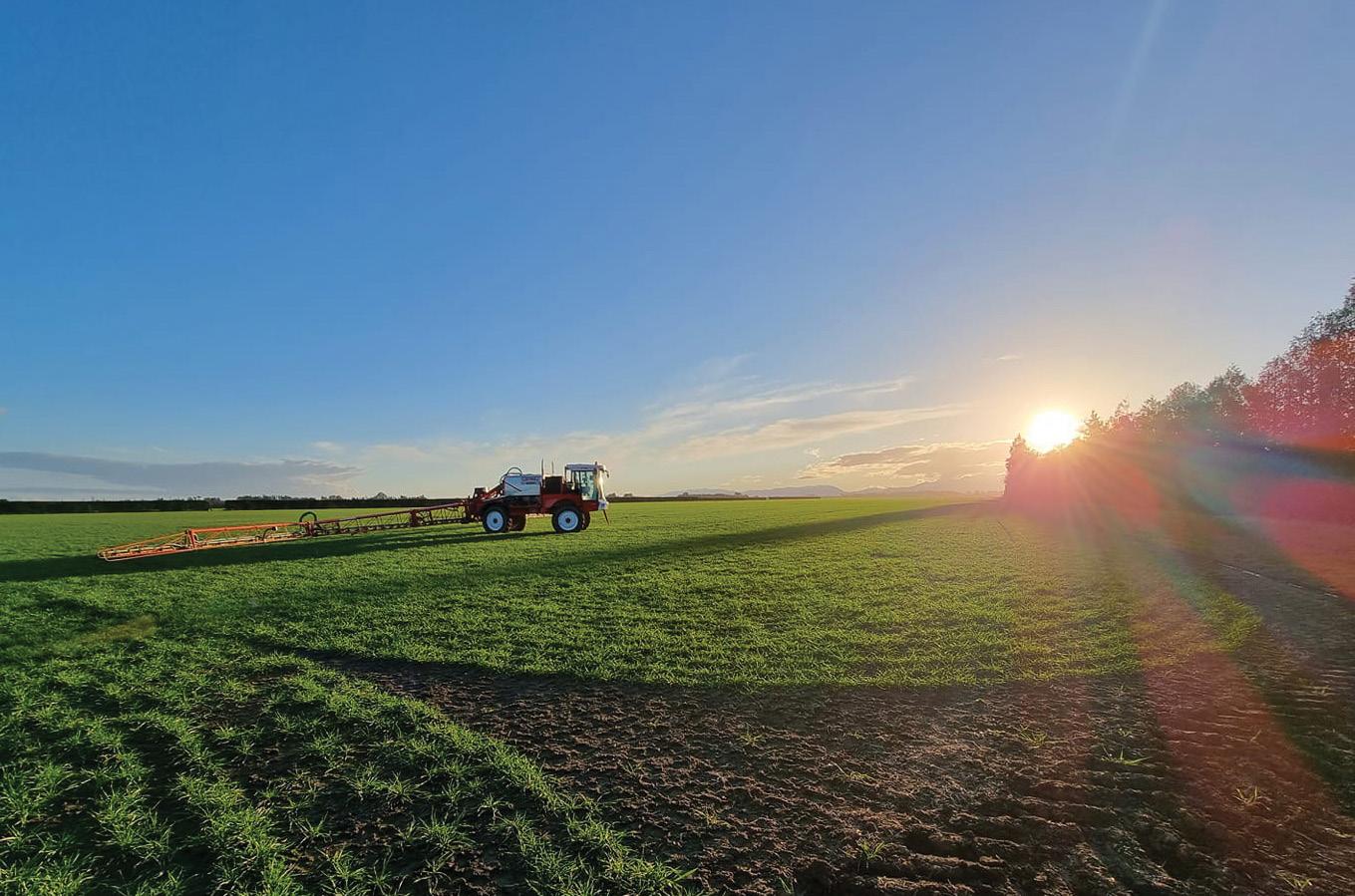
The benchmark net profit over the farm is always $3000/ha.
White clover is a good option at the moment, making up 85ha of their crop farm; it used to be 30ha.
This is due to a couple of bad clover harvesting years which has maintained high prices, complemented with lowinput requirements for chemical and fertiliser. Roscoe said all the clovers have different prices and cost structures, but overall white clover exceeds their benchmark comfortably,
Like any business, gross margin is the biggest factor, but minimal spray and fertiliser is significant too.
Grass grub and slugs mean a need to cultivate, and grass weeds are always an issue.
To name a few, blind seed disease, rust, BYDV, fusarium and septoria can pose challenges.
With the vegetable seeds, on average they reach their targets, which are estimated yields from the agronomist. Roscoe holds huge value in the four agronomists he draws expertise from and who he’s stuck with through both the good times and the more challenging ones.
“I’m a big fan of relationships.”
The overall picture
On the irrigated land, the five-year rotation rolls by with autumn planting in April and May made up of wheat, autumn break crop, wheat, ryegrass, spring break crop, then back to wheat. The dryland rotation is ryegrass, forage rape for lambs, wheat, then into ryegrass again.
Winter means maintenance, fencing, and also fattening lambs. Each year
98 Country-Wide | AUGUST/SEPTEMBER 2023
Spraying early spring herbicides over wheat crops.
Right: It’s a good work and family balance in Cust for this young family; the children are involved in the farm as much as possible. Below: Precision technology has helped the Taggarts with their margins and performance.

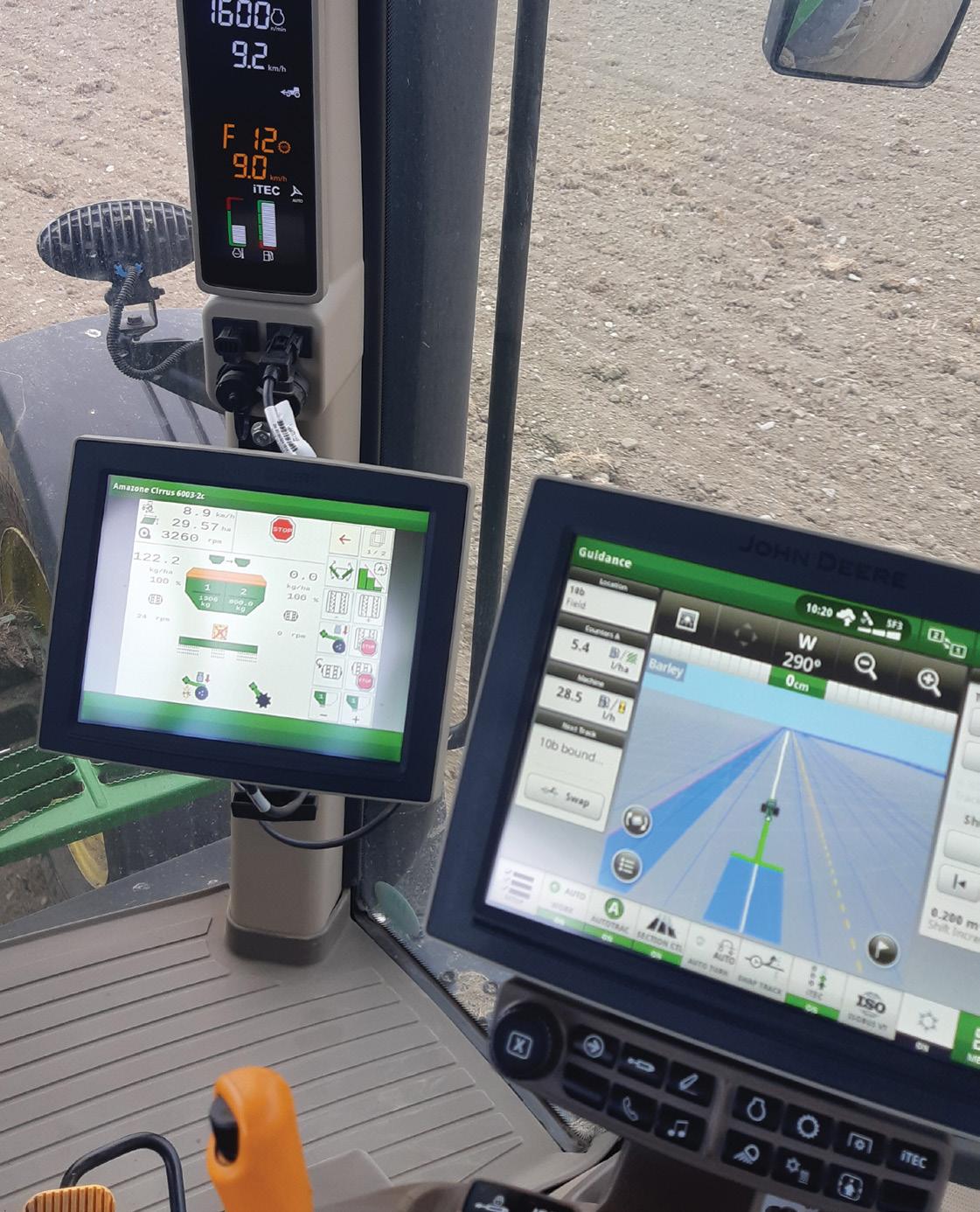
they finish about 5500 which arrive in February and March. They’re a mix of Romney Texel-cross and Merino cross, with a preference for anything with a black face.
They winter lambs on pasture that is ex-ryegrass and rape sown for forage, direct drilled into areas of the farm that sit on riverbed. Lambs also graze the dryland cropping areas.
Spring is about spraying and fertilising for crop maintenance. The lambs are sent to the works in October – they aim for a $40/head margin. In years gone by, lamb numbers have been as high as 8000, but at the moment it’s better to use that land for crops.
Spreading and spraying happens from August through to early December and spring planting is August to October.
Shifting irrigators keeps things busy late September until late January or early February, depending on the season.
“We look at every paddock and ask ourselves, what is the best way to use it?”
They cultivate and drill, depending on the season, what they are growing, disease and insect pressure, water usage, and establishment cost.
“Everything is situational. As soon as you stick to one rule, you hamstring yourself.”
Applying precision technology
To ease their reliance on contractors, five years ago the Taggarts bought their own spreader. At the time, the extra cost to buy precision technology was only marginal, requiring minimal additional yield or savings on fertiliser to cover its costs.
“The GPS mapping provides georeferencing and spread maps, while the N sensor does the sensing and rate control,” Roscoe says.
As the spreader goes through the paddock, chlorophyll levels of the
Country-Wide | AUGUST/SEPTEMBER 2023 99
PRECISION WITH HIGHER PERFORMANCE
With the cost of fertiliser at a premium you need precision application. With hopper sizes up to 10000 L and working widths up to an impressive 54 m, we have a spreader to suit every farming operation.

SPRAYERS
AMAZONE is world-renowned for building of the most robust, technically advanced sprayers available. With tank volumes up to 11200 L and working widths up to a remarkable 40 m, we have a sprayer to suit every farming operation.

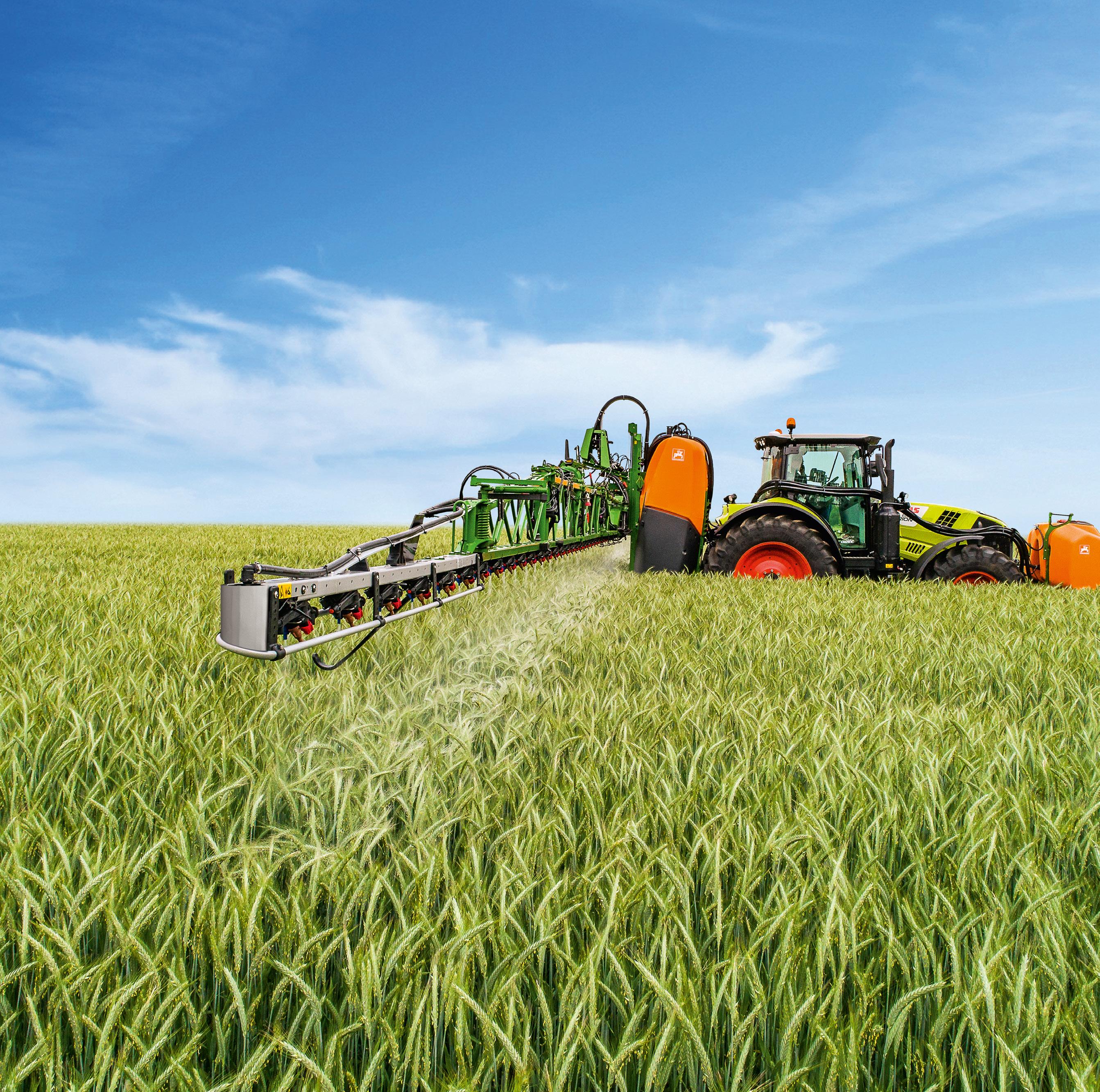
100 Country-Wide | AUGUST/SEPTEMBER 2023
our website to see the full range: claasharvestcentre.com
Visit
plants are sensed using infrared and the normalised difference vegetative index (NDVI) to calculate crop health, while nitrogen (N) sensors attached to the tractor’s roof dictate the rate to the spreader.
“At the beginning it was difficult to trust the technology, but it has paid off.”
For the first three seasons they used standard variable rate based on satellite imagery for their N application. For the last two seasons they’ve used variable rate, based on an N sensor map.
They also use the sensor over brassica, maize, barley, and ryegrass as well as the wheat.
They used to apply N based on the FAR recommendation of 25 units of N/t of grain produced, but they have got that down to 20 units on average.
“Five units of N/t of wheat produced over 2500t is 10,000 units, which is just over 27t of N fertiliser, just on our wheat.”
Information about growth stage, expected yield and rate parameters are dialled into the system for N application,
and the maps can be used for variable rate spraying and planting.
For irrigation they use two pivots with variable rate irrigation (VRI) on one of them, linears, and one roto rainer (which they want to get rid of).
“The VRI water based on an electromagnetic map means that different soil types get different rates of water to minimise excess water usage or nutrient loss.”
This irrigator is coupled with a 6ha water storage pond that acts as a buffer for the irrigator, increasing the irrigation scheme water use efficiency.
The VRI pivot uses maximum 72 litres/ second and minimum 23L/s, depending on what soil types it’s on.
Across the different on-farm activities, variable rate technology is used on more than 670ha of the farm on ryegrass, brassica crops and barley.
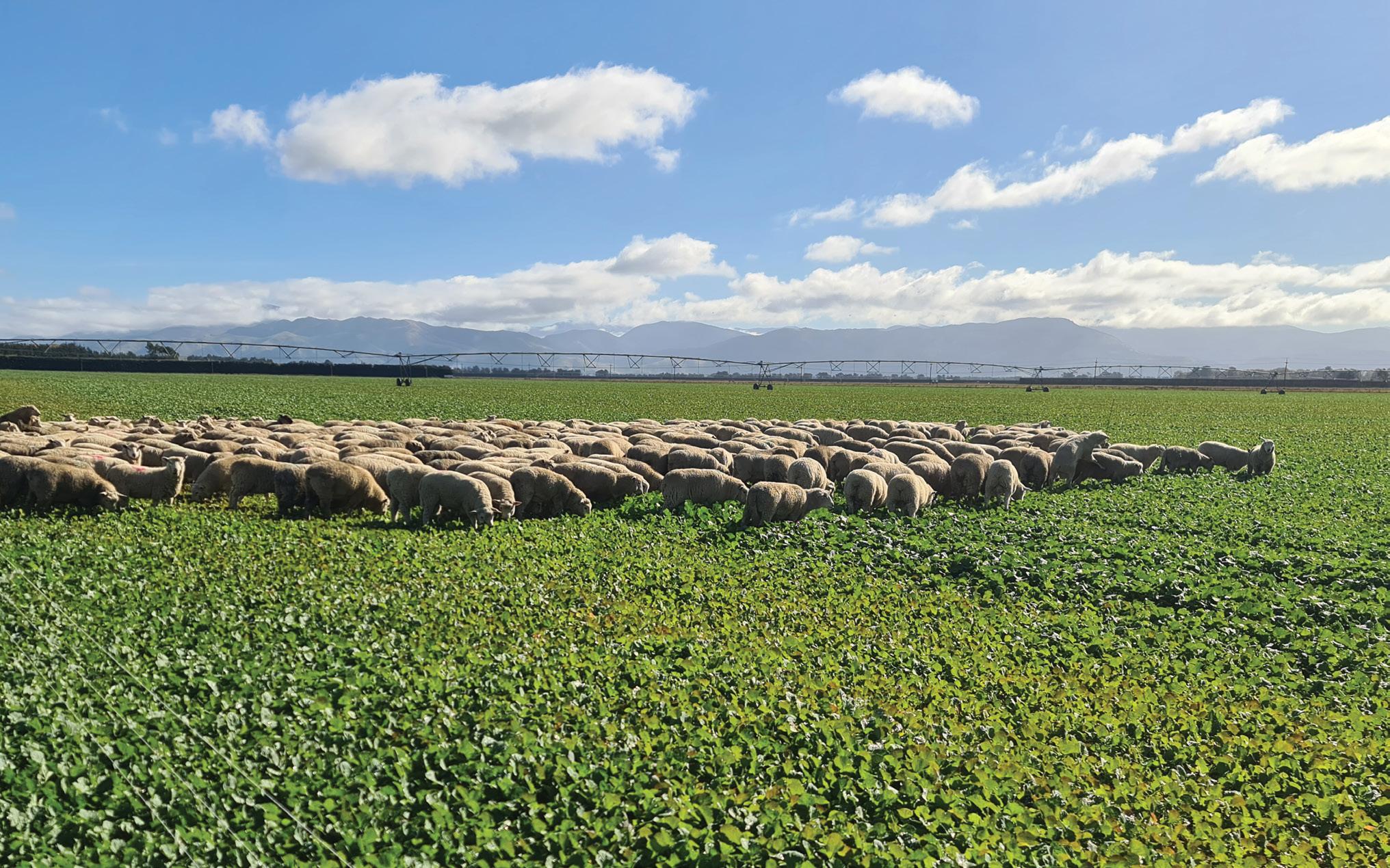
Due to the scale it’s used, the Taggarts managed a 100% return on capital on the N sensor.
“We will always aim to have debt behind us – it means we have incentive
to push things, and it creates pressure to keep us moving.”
Environmental and economic factors are considered when deciding what crops need fewer inputs. Roscoe says they’ve got better at growing their 30ha of peas, with a cost about $1100/ha which can vary based on the season.
“Gross margin is still key at the end of the day.”
They map for soil testing and are now in their second year of grid sampling. The variability of trace elements they discovered means across the paddock they may apply 0.5t/ha of triple super at one end and half that at the other.
“There is insane variation across the farm. A paddock that is dead-flat has way more variation than you’d think, taking in an old gravel pit, history of sowing, stock and soil types.”
As with all trace elements, quite often there will only be small areas of paddocks they are actually spreading on.
“Generally about the same money is spent per hectare, due to using more expensive products plus the cost of
Country-Wide | AUGUST/SEPTEMBER 2023 101
Grazing hybrid rape post-harvest with lambs.
AngusPRO are a group of New Zealand Angus studs that encompass over 40% of New Zealand’s registered Angus cattle. These studs have united and made the shift across the ditch, to join the progressive governing body that is Angus Australia.
Angus Australia pride themselves on their quality of leadership in the delivery of innovative programs that will enhance and promote the value of Angus cattle and beef.
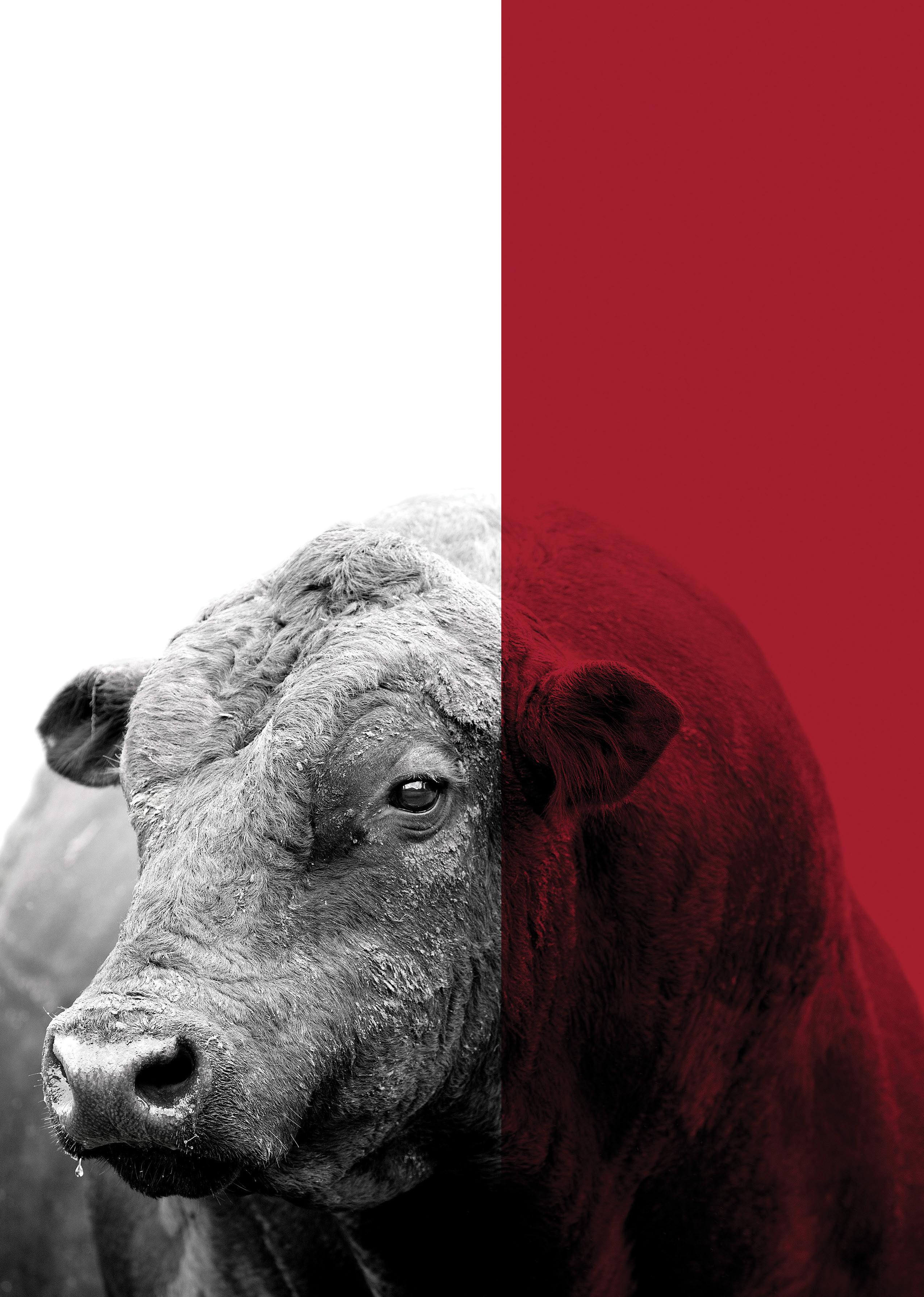
Cleardale
Focus Genetics
Grampians
Kahurangi
Kakahu
KauriDowns
Komako
Lake Farm Genetics
Mount Linton
Ngāputahi
Ranui
Rimanui Farms
Rissington
Rotowai
Seven Hills
Stokman
Storth Oaks
Takapoto
Te Mania
The Sisters
Totaranui
Twin Oaks
Vermont
Village Farm
Wairere
Waitangi
Waiwhero
Wakare
Whangara
anguspro.co.nz
Everyone in the industry knows that profitability within a cattle system can be improved by making educated predictions with factual data.
It’s scientifically proven.
sampling, but we know everything is going in the right place.”
They grid map quarter of the farm each year, and then after year four they’ll start again.
“Blanket fertiliser application is not an option anymore, we’ll never go back to using a base-rate system again.”
Tight on capacity
Their combine harvester, a Claas Lexion 540 clicks over 400 hours a year. Ideally it needs to be replaced, but in the economic climate they make do and look after what they have.
“There’s no capacity to replace just for the sake of a ‘nice to have’.”
The main work comes from their two John Deere tractors, 230 HP, and a 130 HP that’s completed more than 10,000 hours. They also have a 36-metre boom sprayer.
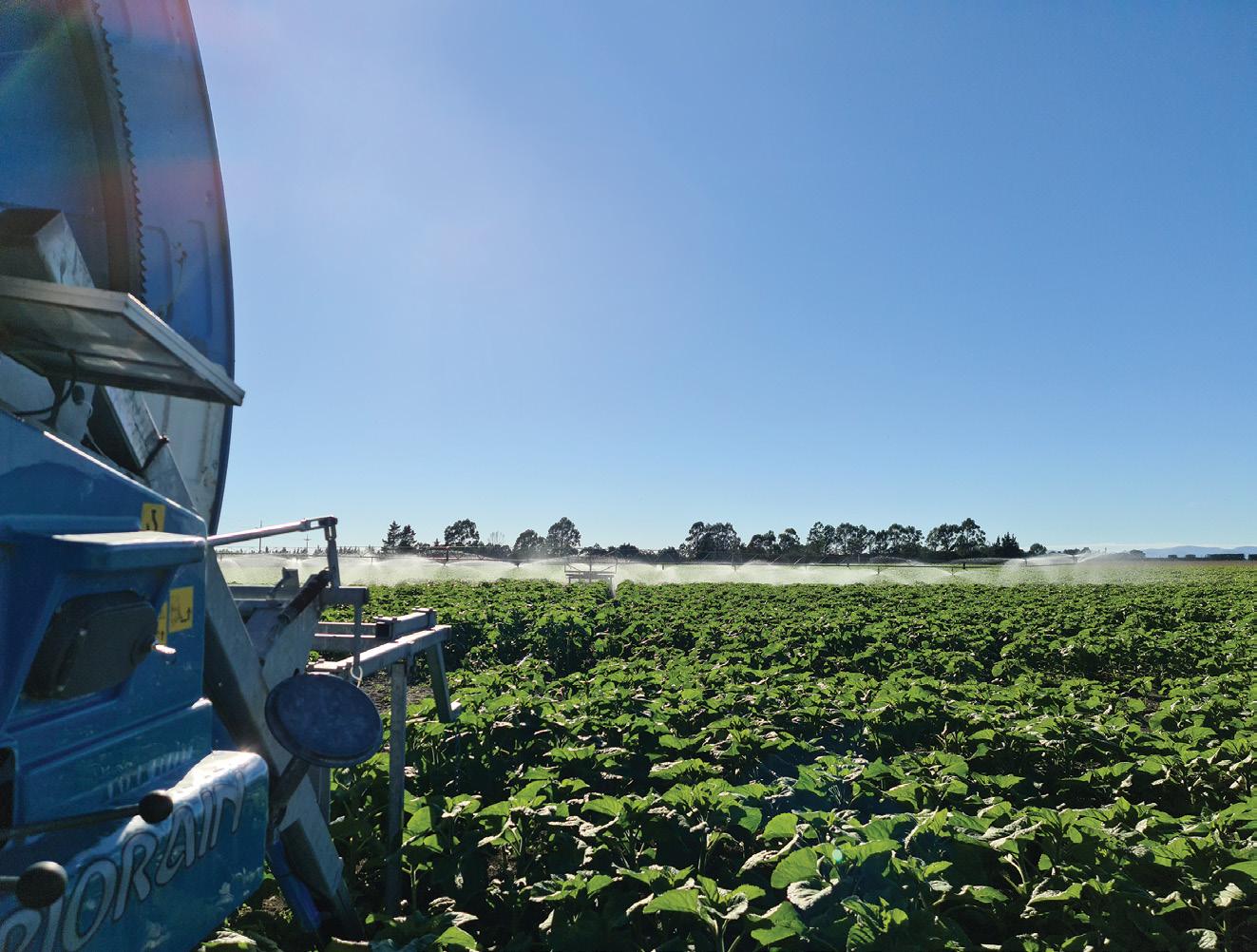
Roscoe admits they’re a bit tight on capacity and could do with a bit more horsepower behind them.
“We are looking very hard at the machinery we use. But if we’re getting the productivity and yield we’re after, we’re good with what we’ve got. We’re trying to make the farm profitable, so that’s the sacrifice.”
In five years the aim is to have machinery up to date for the scale of the farm and to continue on with precision technology. Solar is a great idea, but for now it sits in the nice-to-do, although Roscoe says it’s a great way to make a return on a shed roof.
If something hasn’t been used for three years, they sell it, because “being neat and tidy pays dividends”.
Holding paddocks around yards are as small as possible. “It’s about maximising every area.”
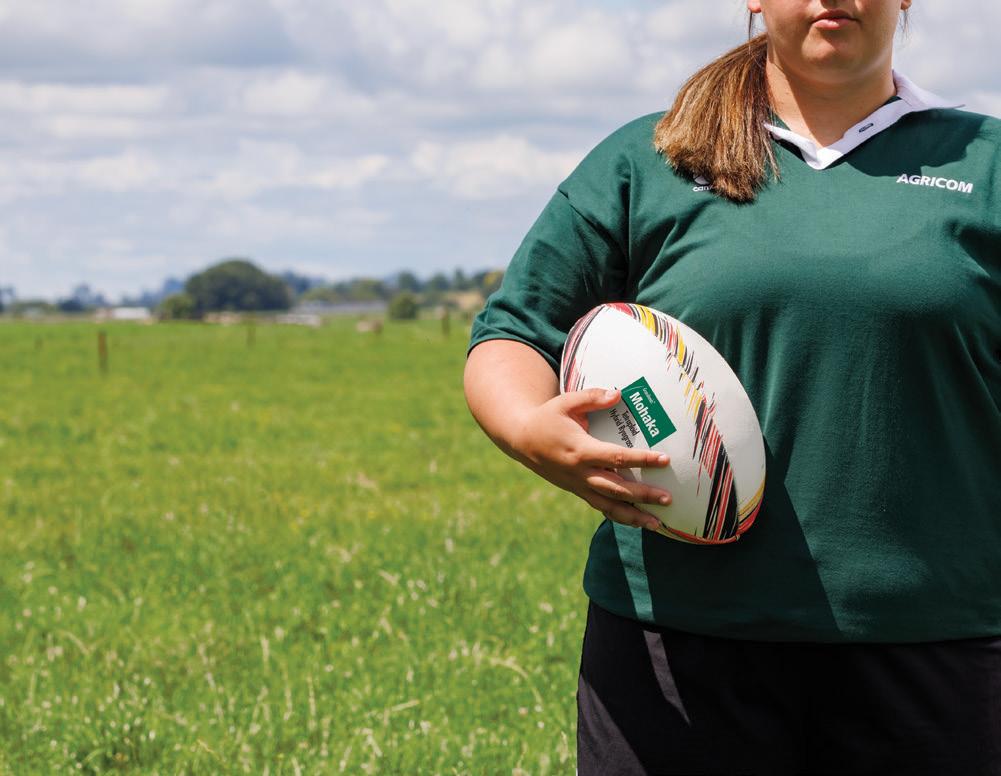
A young family means adventure activities like jet boating and mountain biking are on the back burner for now. Time off the farm is still of big value whether it be enjoying local North Canterbury holiday spots, or heading to Gracie’s family farm near Hawarden, North Canterbury.
“Farming is not a job, it’s a lifestyle we absolutely love and we can incorporate the whole family.”
• Broader leaved, well tillered hybrid suited to 2-4 year pastures
Available with AR37 and AR1 endophyte
Ideal for undersowing programmes
Ideal for short term finishing pastures, runoff pastures, supplementary systems
AGRICOM.CO.NZ/PRODUCTS/RYEGRASS/HYBRID/MOHAKA
Country-Wide | AUGUST/SEPTEMBER 2023 103
Call us on 0800 183 358 or visit your local seed merchant. AGC2370
in the
Mohaka has created quite an impact, not only
field but with farmers across NZ.
ON THE
PROVEN
FIELD.
Above: Irrigating sunflowers in January 2021.
RULES AND REGULATIONS summarised
Anyone new to New Zealand or observing us from afar could be forgiven for wondering what is happening with farming regulations here. Many farmers are struggling to keep up with the growing number of regulations, requirements, policies and promises. James Hoban summarises the most prominent changes and where they have got to on the policy conveyor belt.
FRESHWATER MANAGEMENT
The National Policy Statement for Freshwater Management drives regional and catchment direction and will be implemented in regions over years. It is the framework that the Government uses to instruct regional councils in setting their own local rules.
STOCK EXCLUSION
In 2020 the Government introduced regulations to exclude pigs, cattle and deer from water bodies. The regulations apply to wetlands, lakes and streams more than one metre wide. Dairy cattle, dairy support cattle and pigs must be
excluded from the waterways regardless of the terrain. The same applies to break-fed beef cattle and deer and irrigated land. Otherwise beef cattle and deer are only included if they are on “low slope land”.
The same year, the Government produced a map showing low slope land, which was laughably inaccurate and relied on land parcel boundaries. After widespread criticism, the map was reviewed and an updated version released in 2022. The new map has removed the link to land parcels and while it is more accurate, it is far from perfect.
It identifies areas of
land less than 5 degrees as low slope land and also highlights land between 5 and 10 degrees. The low slope land is included in the rules while the 5–10 degree slope land is where the Ministry for the Environment says stock exclusion from waterways is “also likely to be practical and advisable”.
The rules also include a setback distance of three metres from the beds of lakes and rivers but does not require farmers to replace fences that were already there on September 3, 2020. These rules also include specific restrictions around stock crossings, bridges and culverts.
INTENSIVE WINTER GRAZING
After several years of increased public scrutiny, many farmers across the country now trigger rules requiring them to apply for resource consents. This is after two postponements.
The Government has attempted to draft higher risk-intensive winter grazing scenarios into a consented framework and let lower risk activities continue without the costly paperwork. The rules apply to annual forage crops grazed in-situ between May 1 and September 30.
The following conditions need to be met to avoid the need for resource consent.
• Critical source areas
104 Country-Wide | AUGUST/SEPTEMBER 2023 POLICY
need to be identified and carefully managed – this includes not sowing them in crop and not grazing them during winter. Fencing around these areas can be temporary. Critical source areas are low points where water and potentially nutrients and other pollutants accumulate in high concentrations and flow to waterways.
• Slope of cropped areas needs to be below 10
degrees. If there is an area in winter feed that is greater than 10 degrees, measured across a distance of 20m, then technically a consent is required.
• Waterways should be protected from stock, with a minimum of 5m buffers.
• The total area of winter crops needs to be under 50ha or 10% of the farm area (whichever number is greater).
• The area of winter crops needs to be no more than
the maximum used on the farm between June 2014 and July 2019. The farm needs to have been winter grazing during that time. This clause is designed to capture expansion and new winter grazing. Thankfully, the challenging draft rules around pugging and sowing dates after winter were eventually removed. These were largely unworkable – potentially requiring sodden paddocks to be drilled and stock to
leave no footprints. It is important to remember that being on the wrong end of these rules does not mean winter grazing has to stop – it just means a consent is needed.
ENVIRONMENTAL STANDARDS
The various national environmental standards are designed to address practices that pose a risk to freshwater. They cover a range of topics including wetlands,

urban streams, fish habitat, feedlots, nitrogen fertiliser use and most prominently, intensive winter grazing. These are national rules – in place now.
BIODIVERSITY
The National Policy Statement for indigenous biodiversity is seen by some experts as the most daunting of all the pieces of wisdom built by the Government in recent years. It is under development after consultation on a draft in 2019 and 2020. In 2022, Environment Minister James Shaw released an exposure draft to selected interest groups. This draft
had responded to earlier feedback and was open for further response until July 21st, 2022. Since then, the masses had been waiting nervously for an updated version which eventually landed via public announcement in July. The new version is not different enough to the earlier draft to please landowners. There is still a major emphasis on district authorities having to identify Significant Natural Areas (SNAs). Critics have always maintained that this approach sees millions wasted on identifying areas rather than invested in meaningful action, protecting or enhancing
Applications for the 2024 Nuffield Scholarships
biodiversity. SNA is a controversial term which will raise the hackles of many experienced farming advocates.
This draft is littered with challenges around privacy, access, accuracy, interpretation and cost. Historical controversies with SNAs remain in many memories.
HE WAKA EKE NOA
In 2019, the Government agreed to a proposal from the primary sector to develop a system for reducing agricultural emissions, rather than pricing them in the Emissions Trading Scheme
(ETS). The agreement included the industry having to meet certain milestones, with the omnipotent threats of the ETS and a Government not impressed with heel-dragging looming over them. Since then, He Waka Eke Noa (He Waka) has been through public consultation periods and caused considerable division within and between farming sectors.
Reaction to it largely drove the removal of Beef + Lamb NZ’s former chair Andrew Morrison after dissatisfied levy payers voted him out. Billed as the industryconstructed saviour for farmers, an alternative to
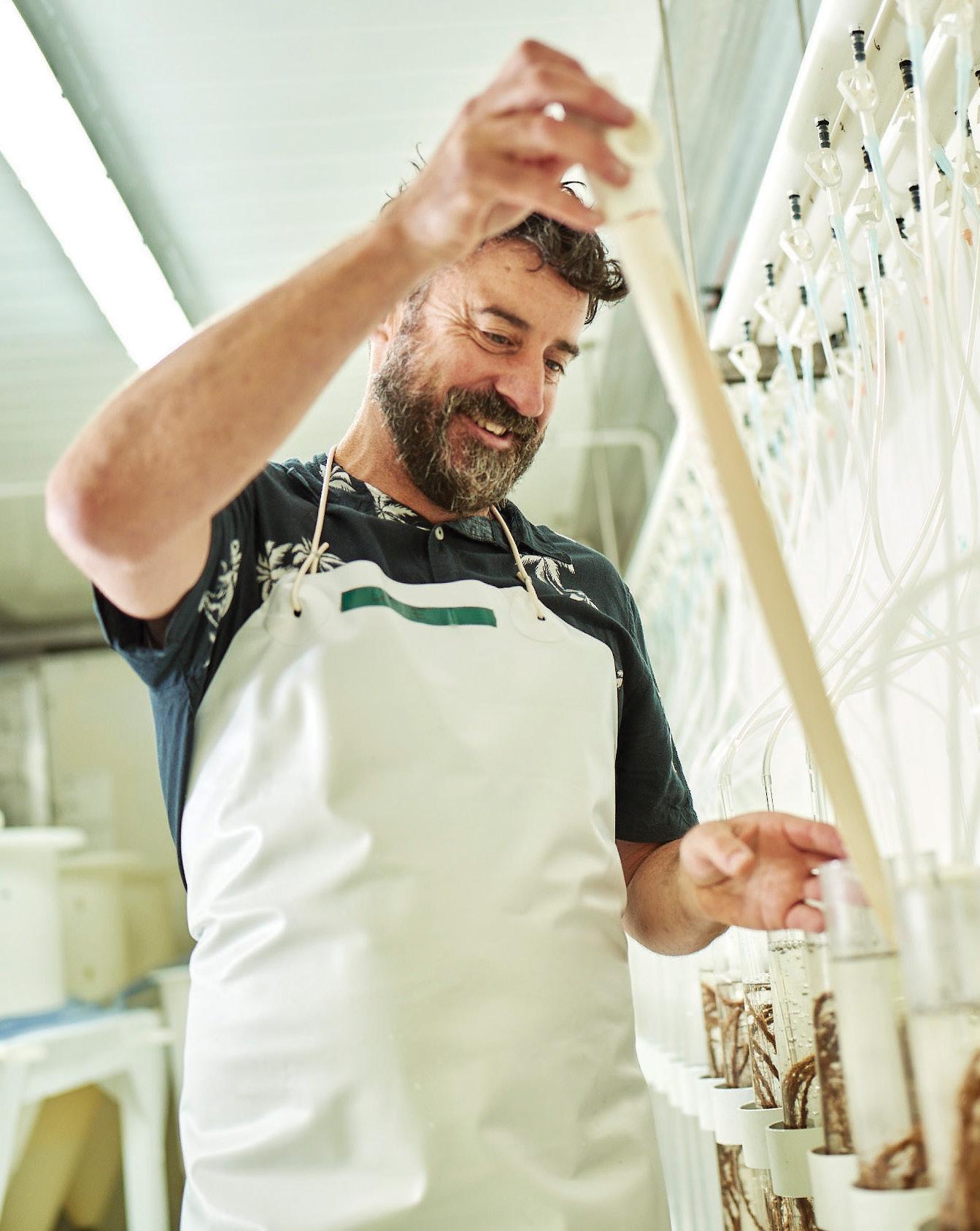
106
Andy Elliot Aquaculturalist Nutrition Champion Nuffielder
close 13 August. The future of Food and Fibre is in the hands of our bold and grounded people. Sound like you? Register your interest in a Nuffield Scholarship at Ruralleaders.co.nz/ application-nuffield
the crippling ETS, He Waka has failed to deliver. Instead of achieving farmer buy-in, it has galvanised a response where large numbers are vehemently opposed to the industry’s proposal.
At the time of writing, the Government continues to cling to He Waka and maintains an industry-led scheme is still alive and implementable. This is despite the Minister for Primary Industries Damien O’Connor straying from his lines and publicly mentioning an alternative fertiliser tax. Minister Shaw and Prime Minister Hipkins appear to be keeping their political capital invested in He Waka. While Hipkins has been trying to hose down the flames of a ministerial bonfire, the opposition National Party has promised their idea of a red-tape-free El Dorado for farmers.
A neck-and-neck October election is predicted. Farming industry leaders involved who have shown themselves previously to be divided over He Waka, are trying to balance the opinions of their levy payers and members with the need to be able to work constructively with either party post-election. Do they cling to a controversial policy in the expectation that Labour will be back in power? Or do they write Hipkins and co off as a sinking ship and distance themselves to avoid getting tangled in the anchor chain?
ZERO CARBON
Despite ongoing debate about emissions pricing, New Zealand’s commitment
to reductions is time-bound and set in law. Our domestic targets are:
• net zero emissions of all greenhouse gases other than biogenic methane by 2050, and
• 24% to 47% reduction below 2017 levels of biogenic methane emissions by 2050, including a 10% reduction by 2030. Despite National promising to scrap He Waka and restart negotiations if it gets into government, the party has also stated it remains committed to the 2050 ‘Net Zero’ targets.
EMISSIONS TRADING SCHEME
The ETS is touted as the Government’s main tool for reducing greenhouse gas (GHG) emissions. Farming leaders have argued that if agriculture was fully included in the ETS as it stands, farmers would effectively face a net zero target for methane. This would link the methane price to the carbon price and result in a more costly impact for farmers than He Waka. It is worth noting that this argument was especially compelling when the carbon price was beyond $80/ tonne and expected to soar. Since then, Government announcements and indecision have seen this drop back and hang stubbornly around the mid$50/tonne mark.
He Waka has been built on a split-gas approach which treats methane as special in an attempt to make emissions
pricing for farmers fairer and survivable. Unfortunately even the He Waka proposals were predicted to put as many as 20% of sheep and beef farmers out of business.
Wholesale farm conversion to permanent pine forests has been a hot topic for several years and recent cyclone damage has heightened anxiety. When former minister Stuart Nash pushed for exotic species to be excluded from the ETS permanent forest category he created a backlash from politically powerful owners of land with forest potential. These changes were undone, but with further review underway and political uncertainty abounding, the carbon price remains subdued.
The Government wants more indigenous permanent forest, but this is prohibitively expensive to establish and slower at sequestering carbon than exotic species. A range of interests want to see productive farmland kept out of permanent forest but farmers facing eventual emission
pricing will likely need strategic areas of planting to stay in business. Despite reigning ambiguity, the smart money is on change that sees trees incorporated with livestock farming, with restrictions around land classes and the scale of planting.
FRESHWATER PLANS
If it seems like an overwhelming bombardment of policy is taking aim at farmers, that is because it is. Imminent freshwater farm plans are sometimes referred to as a solution to the complexity and breadth of new rules. These plans will involve independent consultants helping farmers at a cost, as well as audits, also at a cost. While recent announcements around the new plans have answered some questions, the future is still not entirely clear.
What is obvious is that the new farm planning regime is going to create a higher cost of compliance for most farmers. It will take farmers and their advocates time to digest the requirements and as usual the devil will be in the detail.
Country-Wide | AUGUST/SEPTEMBER 2023 107
“IF IT SEEMS LIKE AN OVERWHELMING BOMBARDMENT OF POLICY IS TAKING AIM AT FARMERS, THAT IS BECAUSE IT IS.”
PART OF THE SOLUTION


Farmers, particularly young ones, want to be part of the policymaking system with environmental regulation.
f farmers are to remain passionate about farming, they need to know their voice is being heard and that they are part of the solution when policy makers are formulating regulations.
Kellogg Rural Leadership scholar, Hamish Murray, produced a report about the challenge of keeping farmers passionate when up against immense amounts of environmental policy change. Murray, who is Lone Star Farms operations’ manager at Caberfeidh Station in South Canterbury, focused on intensive winter grazing (IWG) as that was a particularly challenging aspect of the regulations for farmers across various sectors.
His report involved interviews with farmers of different age groups and though there was a variation in views, the overwhelming response from farmers was they wanted to have input into policy from the beginning so that practical solutions evolved.
They also wanted a more collaborative approach between
By Anne Hardie
industry bodies when dealing with the Government to get the best outcome when writing policy and the end result should be simple.
Long-term planning was needed for implementing regulations and education should take place over a period of time, with practical information for farmers to implement change before new policies were rolled out.
“There is a lot going on in the regulation and policy space and I think farmers have it on their minds all the time,” he says. “Regulations and policy with our current government is forever changing.”
Farmers interviewed emphasised their frustrations about the ever-moving targets of regulations and were passionate in their views.
Murray says they recognised the importance of continually enhancing the environment with sustainable practices, but wanted policy written from the ground up to deliver a better outcome.
“I believe working with farmers
108 Country-Wide | AUGUST/SEPTEMBER 2023
POLICY
from the ground up when writing policy would deliver a better outcome and keep farmers up to date and feel involved. Farmers need to be more utilised with their extensive knowledge when writing policy.”
Murray says the initial rules released for IWG were impractical and impossible for farmers to achieve and the Government did listen to farmers’ concerns and
made amendments.
If farmers cannot comply with the rules, they need to apply for a resource consent or have a Freshwater Farm Plan in place to continue IWG. Consents come at a cost which farmers would prefer to use on environmental improvements and enhancements on farms.
Long-term planning is needed for IWG regulations to give
farmers time to comprehend those regulations and then implement them before deadlines, he says. That would give farmers the opportunity to report back to industry bodies about their ability to comply with the regulations and enable a pragmatic approach before those deadlines.
The majority of the IWG policy and regulation will affect the younger generations the most, yet Murray says they have not been part of the discussions. He says they really need to be around the table to have a say in their future and offer their ideas. ››

Country-Wide | AUGUST/SEPTEMBER 2023 109
“There is a lot going on in the regulation and policy space and I think farmers have it on their minds all the time.”

live naturally, choose wool biodegradable • renewable • natural nzwool.co.nz
Image supplied by Bremworth Carpets and Rugs
Younger farmers in their early to mid-20s generally did not want to know about the regulations because the rules were forever changing and few were employed in roles to manage IWG. Their view was to wait until they reached management roles and find out about the rules then –which might be different to now.

Those aged between 25 and 35 had some “really good ideas” but were often sitting in the background at meetings and field days. The older generation tended to be more vocal, passionate and usually the first to put their hand up. Often, the younger generation sat back and did not take part in the discussion.
“Our industry bodies and policymakers need the leaders of tomorrow to be around that table when forming policy
ideas. Creating a youth voice for the agricultural industry is something that shouldn’t be underestimated.”
On the need for education, farmers in his survey wanted the right people with the right skillset to educate farmers and a lengthy period to get the right, practical information and implement it onfarm. Most preferred information in the form of fact sheets that provide a practical and simple process to follow. Emailing information directly to farmers brings it to their attention, rather than having to search for it themselves.
Showcasing good management practice (GMP) is seen as an important way to educate other farmers, though interviewees acknowledged farmers are not particularly good at showcasing GMP. Catchment group field days is another way to educate farmers, as it gets them off their own property to visualise and hear how it can be done differently.
As well as education, his report highlighted the need for tools to make the job easier in a practical way. Scrolling through the internet to find information around mitigation techniques can be frustrating and slow.
Murray says incentives to adopt GMPs would also help farmers remain passionate and engaged toward regulations. Incentives helped offset extra costs accumulated with compliance. As an example, he pointed to
Fonterra’s Co-operative Difference
Payment structure which focuses on five key areas to achieve a premium payment.
“I believe there is opportunity to develop a monetary incentive or something similar for GMP around intensive winter grazing. This would help in mitigating incurred costs for new regulation.”
His report describes incentives as something that motivates or encourages individuals to achieve, as opposed to forcing change upon them.
A model showing the stages for grief and trauma can be applied to change and shows the five stages people go through including, denial, anger, bargaining, depression and acceptance. The latter is often a resigned attitude that may not be a happy space. For farmers tackling difficult change, the way those changes are introduced can make the difference between that resigned attitude or being passionate about farming.
Murray says farmers’ overwhelming desire is to “be heard and be part of the solution”.
“They want a pragmatic approach to writing policy –something that could work onfarm.”
Country-Wide | AUGUST/SEPTEMBER 2023 111
Hamish Murray with his daughter, McKenzie. Hamish says farmers want to be heard and be part of the solution.
First published in NZ Dairy Exporter February 2023.
“Our industry bodies and policymakers need the leaders of tomorrow to be around that table when forming policy ideas.”
BUILDING BLOCKS OF
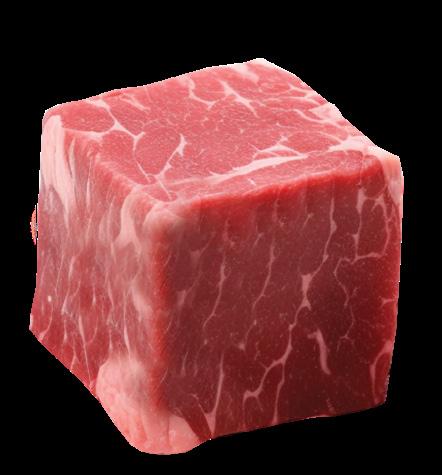
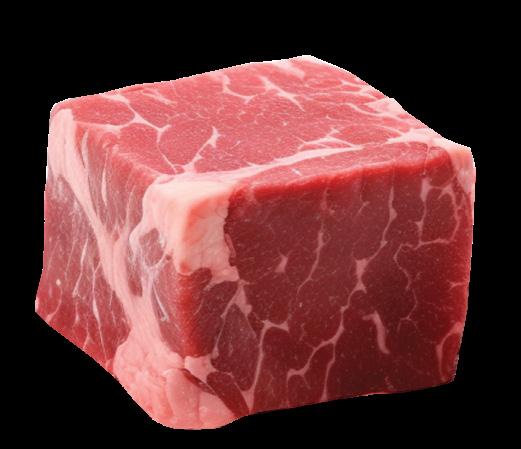
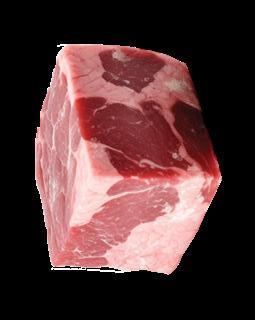


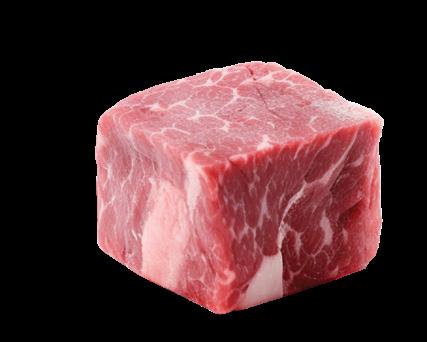
IMF

GENETICS
Story by Sarah Horrocks
IMF gives beef its flavour, taste, tenderness and juiciness, and processors are rewarding farmers who deliver it in their cattle because the more there is, the more beef the consumer demands.
The process of achieving IMF begins at conception, and there are a number of opportunities throughout the year when the farmer can get things right or wrong.
IMF develops in the perimysial connective tissue between muscle fibres, opening up and disrupting the organisation of intramuscular connective tissue, making it easier to chew. More fat within the muscle also improves the aroma and flavour of meat during cooking and eating. This is how we get tender, tasty beef.
Farmers around the country are now selecting bulls with favourable estimated breeding value (EBV) figures for IMF because they want to breed progeny that will have good marbling at killing time. But there’s more to the equation – stock
bred to deposit higher levels of IMF also need to be nourished to encourage the trait, and that nutrition starts in utero.
In a recent Head Shepherd podcast, hosted by neXtgen Agri CEO Dr Mark Ferguson, he spoke with Dr Charlotte Westwood of PGG Wrightson Seeds about the importance of not just the quantity and quality of the feed going into animals, but also the timing throughout the lifetime that this feed is available.
While the ratio of the value of genetics to nutrition in livestock production is a well-debated topic, there’s no denying that genetics is a slower burn, whereas the results from nutrition can be seen almost immediately.
Westwood is a veterinary nutritionist who did a PhD at the University of Sydney looking at cattle reproduction and how it’s influenced by the interaction between nutrition and genetic merit. At the What’s The Beef
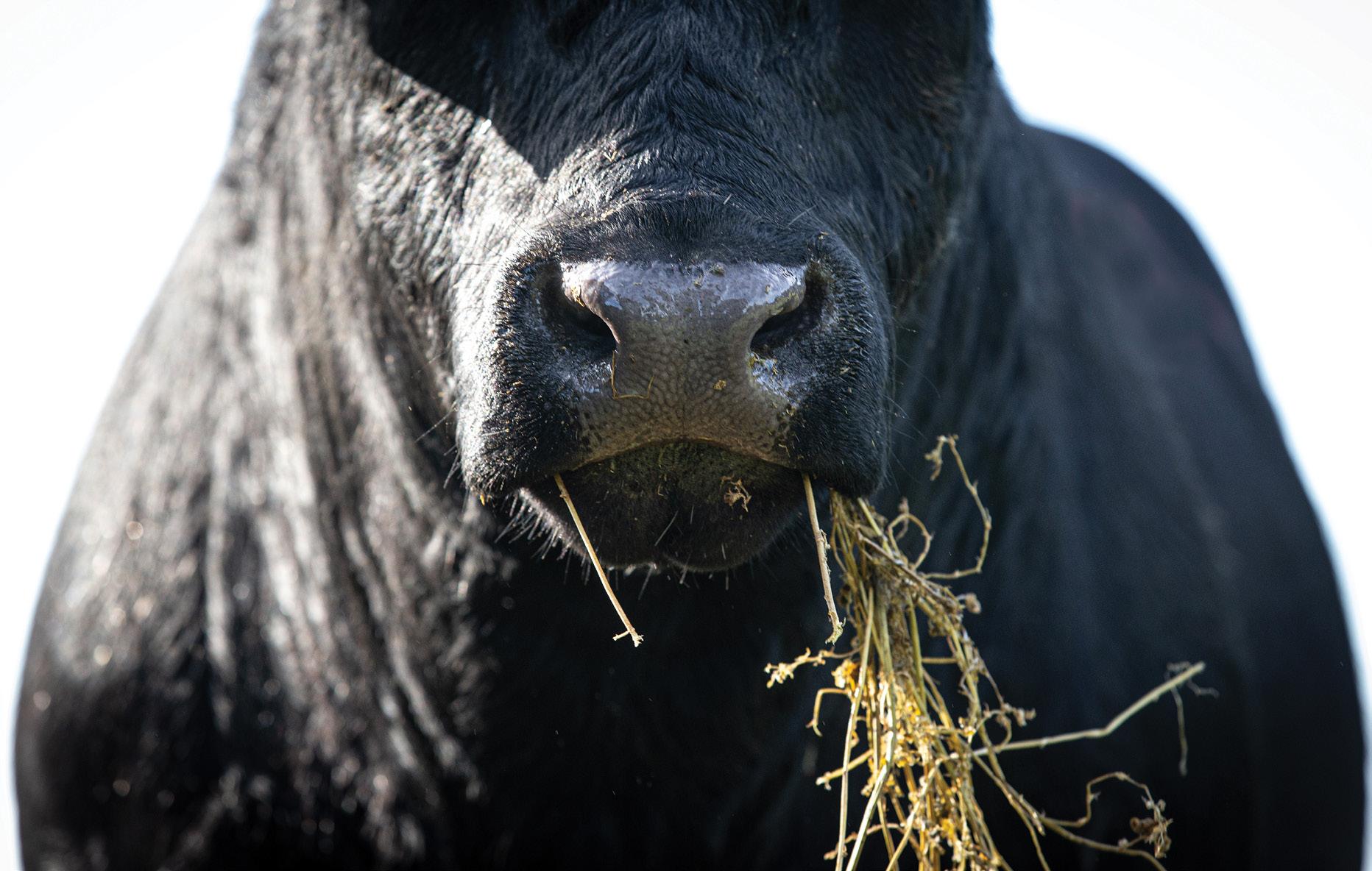
Country-Wide | AUGUST/SEPTEMBER 2023 113
Farming beef cattle with the right combination of genetics and raised within a strict regimented feeding plan to the appropriate processing age will result in beef carcases with the coveted intramuscular fat (IMF) that’s demanded by consumers around the world.
Photo: Sarah Horrocks
field days earlier this year, she discussed the importance of genetics, nutrition and other management aspects when trying to increase the amount of IMF in a beef carcase.
Getting the balance right Westwood says it's an interplay between genetics and all aspects of management.
“We've got the sex effects and the age of the animal, their liveweight as a percentage of mature weight, and the time of slaughter if they're a little bit younger.”
She says a lot of what is happening when the animal reaches its finished stage for processing has started while still in utero.
“Opportunity to improve IMF in the finishing animal actually does start inside mum's tum, and there's a term that's framed the ‘marbling window’.”
While this might sound a bit mystical, the last trimester of pregnancy, from day 180–190 onwards, can influence both the number and potential future growth of the fat cells (adipocytes) within the muscle itself.
“So if we work mum a little bit too hard during the last trimester of pregnancy, that may influence the decision around stem cells inside the unborn calf – whether they're going to turn themselves into fat cells or muscle cells or fibre cells, like collagenproducing cells.”
Westwood explains there’s a drafting gate happening during the marbling window, so if the nutrition isn’t done right during that time, it can in a small way influence future IMF deposition in the progeny.
It’s not limited just inside mum's tum. There is some degree of plasticity around continuing to encourage more stem cells to end up as adipocytes in progeny up to about 250 days of age. Adipocytes, also known as lipocytes and fat cells, are the cells that primarily compose adipose tissue and are specialised in storing energy as fat.
“So yes, beef cows have to do what they have to do and suck it up… for
other capital stock classes during winter, and work a bit harder.
“But if we are looking for … an endto-end aspect around nutrition and IMF deposition, it does start inside mum's tum and during that critical first 250 days.”
Westwood says if you’re looking for the added benefits that come from genetics, nutrition is a key part of the management strategy.
“You can’t run a Ferrari on 91 fuel.”
Just feed them
Grain feeding is the typical way to pump IMF into finishing animals around the world, but here in New Zealand, there’s a far greater focus on grass-fed, forage-based finishing. The opportunities are there with foragebased feeding but in order to look at which are most suitable Westwood says it’s important to look at the biochemistry involved in creating intramuscular fat.
Westwood says intramuscular fat cells love their glucose and they take their glucose and turn it into fat.
“The subcut internal fat tends to
She says essentially the gestational diet of the breeding cows is what is being looked at, encouraging better foetal maternal programming for the calf. Improving cow condition at calving and feeding optimal nutrition for lactation performance and mating go hand in hand with this science.
If you’re already ticking these boxes then you’re already giving your Ferrari genetics (as Westwood terms them) the opportunity to express themselves.
prefer making fat directly from some of the VFAs [volatile fatty acids] … inside the rumen.”
So when a lot of good quality leafy green feed is fed, it is potentially improving the total amount of volatile fatty acids. This creates more of a special VFA called propionate, which converts in the liver and makes more blood glucose.
She says overseas research has shown that more blood glucose is better in a finishing programme, because those little IMF fat cells prefer glucose as the building blocks to
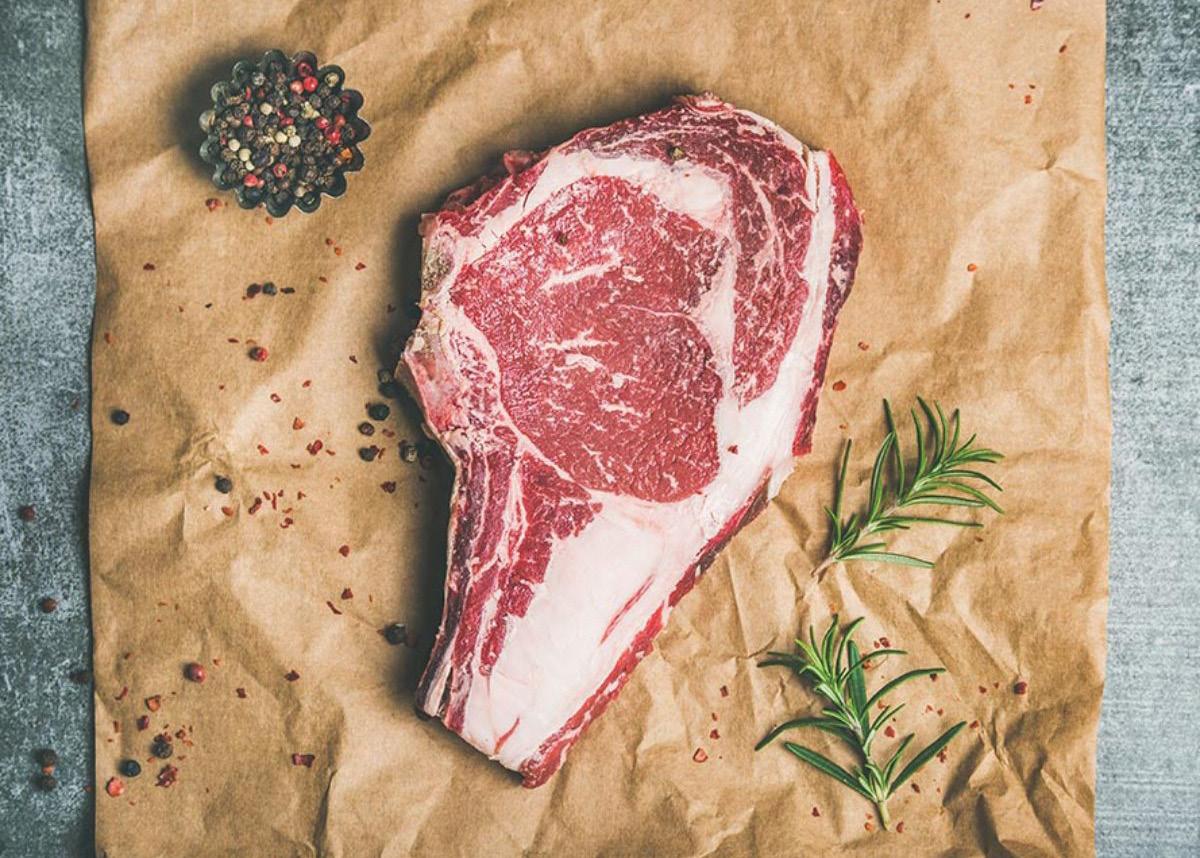
114 Country-Wide | AUGUST/SEPTEMBER 2023
What else to consider
While Westwood spoke about IMF in isolation during her presentation at the What’s The Beef field day, she did note that it shouldn’t be looked at in isolation from other aspects around productivity and profitability – growth for example.

“I wouldn't suggest we tip a farming system on its head just to chase more IMF cells being deposited within the
muscle bundles in an unborn calf, but it kicks a few goals along the way.”
She says farmers are chasing IMF in their bull-buying decisions and while, of course, the science tells them that they’ve got to have the genetics there to get that IMF into finishing progeny, they don’t want to burn those progeny by not getting their nutrition right from conception onwards.
“Some think that genetics are a silver bullet, and there are also those at the other end of the spectrum who think it’s only about feeding.”
The two work together and it is a key issue in terms of IMF predisposition. Genetics is certainly a strong attribute to part of it, like putting a jigsaw puzzle together.
“You know, if you've got half a jigsaw puzzle piece missing, well you're not going to get the complete picture in the end product.”
You don’t create a premium product such as high-marbling beef by accident – you have to get all aspects of the production system right, every time.
The finishing phase is equally important with IMF, since all the different fat depots inside that animal are laid down in a specific order. First is intra-abdominal or visceral fat, which protects internal organs and serves as an energy source; the second is subcutaneous fat, deposited under the skin as an energy source and protects the skeleton from harm; third is intramuscular fat, also an energy source, though surrounding moving muscle surfaces, therefore serving to reduce friction from muscle movement. It’s not until the fourth and final stage of fattening when an animal is typically getting closer to its mature liveweight that the IMF gets laid down.
If things come unstuck – perhaps you hit a drought, bad weather, a feed deficit, stress or there’s no feed budget in place – the IMF will disappear. Any of these examples can be enough for the animal to go through a short period of negative energy balance and it starts to mobilise fat. They'll mobilise it out in the same order that was laid down. So the IMF that you've lovingly sculpted through a combination of genetics and good nutritional management is the first to peel out.
deposit fat. Therefore any diet that can increase blood glucose is good.
On a feedlot starchy grains such as maize, corn grain and sorghum, all lift blood glucose in two ways. Increasing VFAs in the rumen (subsequently creating more propionate), and secondly, there is some rumen bypass of starch which also drives up blood glucose.
Westwood says that because of NZ’s temperate climate, she predominantly sees C3 pastures, legumes, and increasing amounts of herbs such as plantain and chicory being used
for finishing. “It seems that chicory drives higher dry matter intake as a percentage of liveweight. So they’re eating a whole lot more, which means a whole lot more VFAs, which coincidentally along for the ride, brings more propionate.”
Feeding high-quality forages at an allocation well above maintenance maximises the likelihood of IMF accumulation in finishing cattle.
Westwood says there’s a resounding take-home message that’s applicable to all ruminant species.
“Just feed them.”
“So if we see back-fat mobilisation, as in a drop in body condition score, heaven forbid, in our prime cattle, the IMF is probably long gone and we're gonna have to start that process again.”
Breed for it, feed for it, and farmers will be rewarded for it.
Dr Charlotte Westwood runs her own podcast, The Rumen Room, where she covers a broad range of topics that bring together the nutrition, health, reproductive performance and well-being of ruminant animals.
Country-Wide | AUGUST/SEPTEMBER 2023 115
Dr Charlotte Westwood.
“...nutrition and IMF deposition, it does start inside mum’s tum and during that critical first 250 days.”
i
GISBORNE’S BIG WET OVER IT
THE BIG WET IN THE GISBORNE district has unfortunately not let up at all. Before and between cyclones Hale and Gabrielle the rain continued to fall and has scarcely let up since.
Laura Watson who farms at Waimata Valley 30km inland from Gisborne has tipped 2.1 metres out of the rain gauge already, only halfway through the year. Average annual rainfall is 1500mm. The Waimata catchment alone has suffered 10,000 landslides. There will be many more.
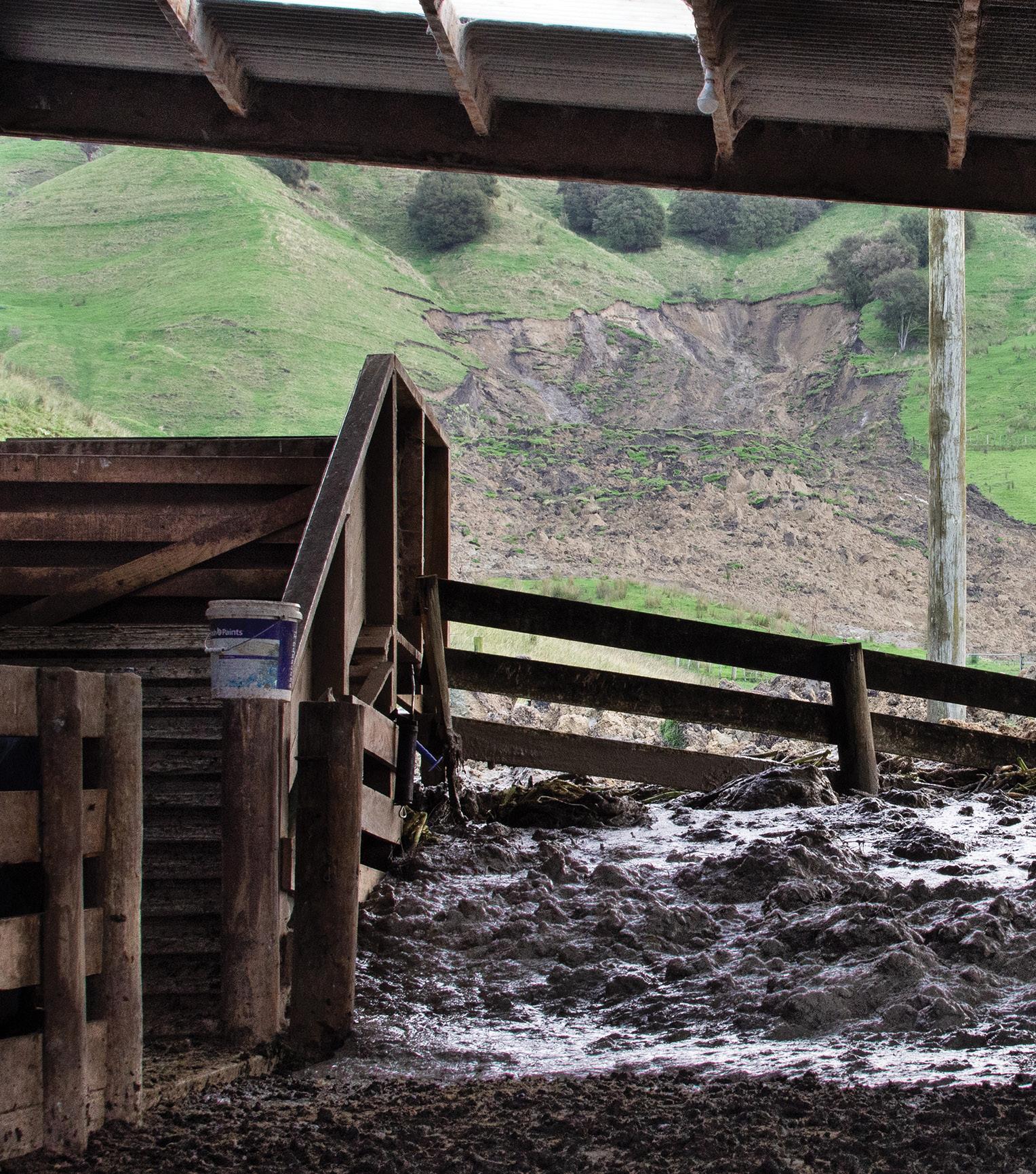
Principal scientist at Gisborne District Council Dr Murry Cave describes the integrity of the soil all over the district as “sloppy porridge”. He isn’t expecting the soil to dry out until next summer; after all we are at the beginning of winter.
“We haven’t even finished cleaning up after Hale, let alone Gabrielle, and the damage is just accumulating and ongoing.”
The water table is at or even above the
surface all over the district, meaning the soil has no capacity to absorb any more water whatsoever. Landslides continue all over, including in Gisborne city. Several houses have been added to the tally of those already red-stickered following Cyclone Gabrielle.
Residents have been asked to be keenly aware of their surroundings, including sticking doors in buildings and hearing unusual noises, which may be a precursor to land movement around their properties. This advice is unnerving for a community already living on edge.
There are several significant groundwater aquifers beneath the Poverty Bay flats. These porous geological structures can absorb and store water.
They often comprise ancient, buried river gravels, deposited when rivers meandered over flood plains in pre-human times, before we attempted to control them and confine them to flood-control schemes.
116 Country-Wide | AUGUST/SEPTEMBER 2023
The rain continues to fall in the Gisborne region and Louise Savage is just one of many who’s had enough.
Along with the (normally) benign climate and class I soils, this reliable water supply is a factor in the wonderful growing conditions in Gisborne for crops, from kiwifruit to salad greens, squash and tomatoes.
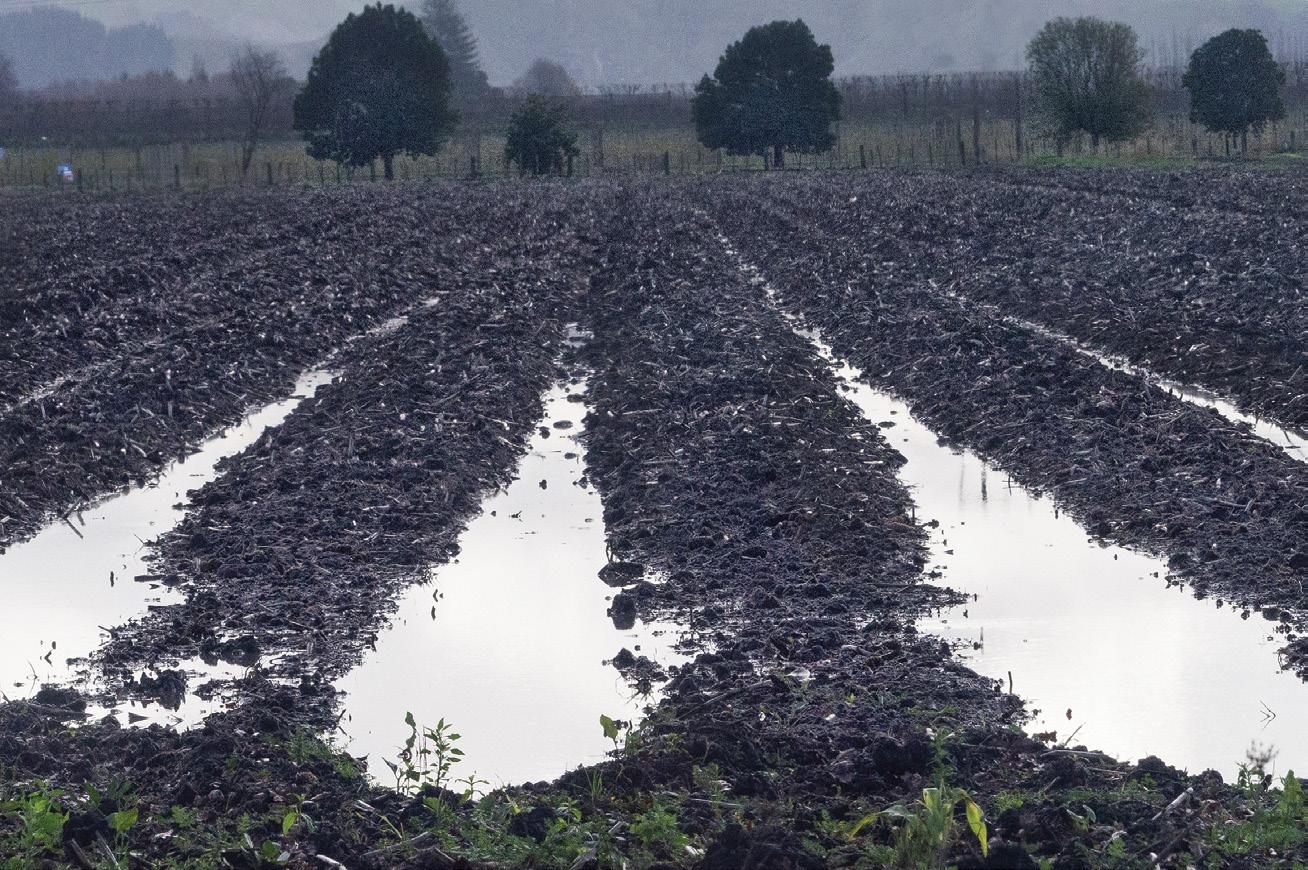
There are more than 1400 bores on the Poverty Bay flats, and in typical, hot, dry Gisborne summers plenty of water is drawn for irrigation and domestic use. Monitored bores therefore show a summer draw-down in level and pressure, followed by a recharge over winter when rainfall increases and people stop drawing water. If you look at a graph over many years, it has a regular
saw-tooth pattern of seasonal drawdown and recharge.
This hasn’t happened at all in 2022-2023. Because of the enormous volume of rain that’s fallen, there was no irrigation, no draw-down in aquifer levels, and groundwater is above the surface in some places.
I live atop Te Hapara sands aquifer. Weirdly, the weight of rain falling all over the flats seems to push water up out of the ground. Sometimes 20mm in my rain gauge translates to a crystal clear “lake” up to 150mm deep coming up out of the ground. This phenomenon has never happened in the time the council has monitored ground water, or in fact in the 53 years since my house was built.
Normally it takes up to five months for water levels in the Te Hapara sands aquifer to recede a metre lower in the aquifer. That’s if no significant rain falls. That is extremely unlikely given we are coming into winter, meaning for many months to come we will have high groundwater levels and surface flooding every time it rains even a little.

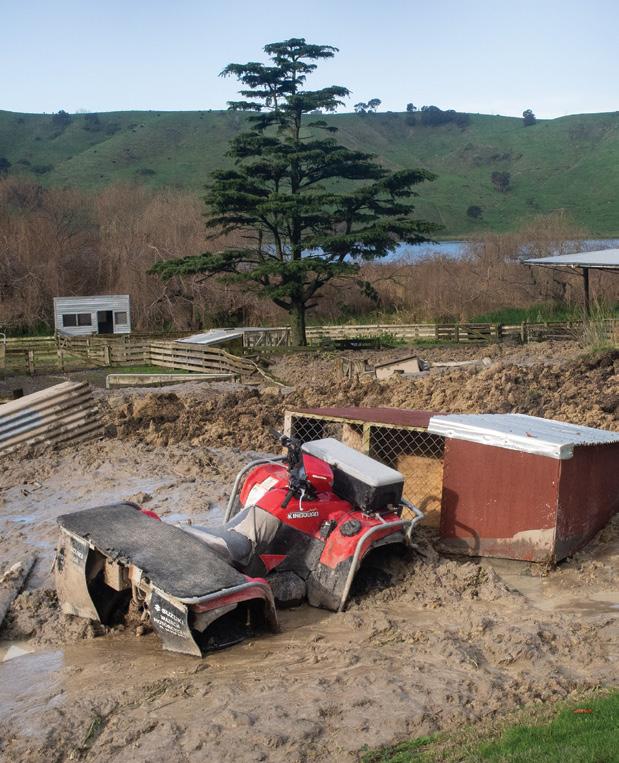
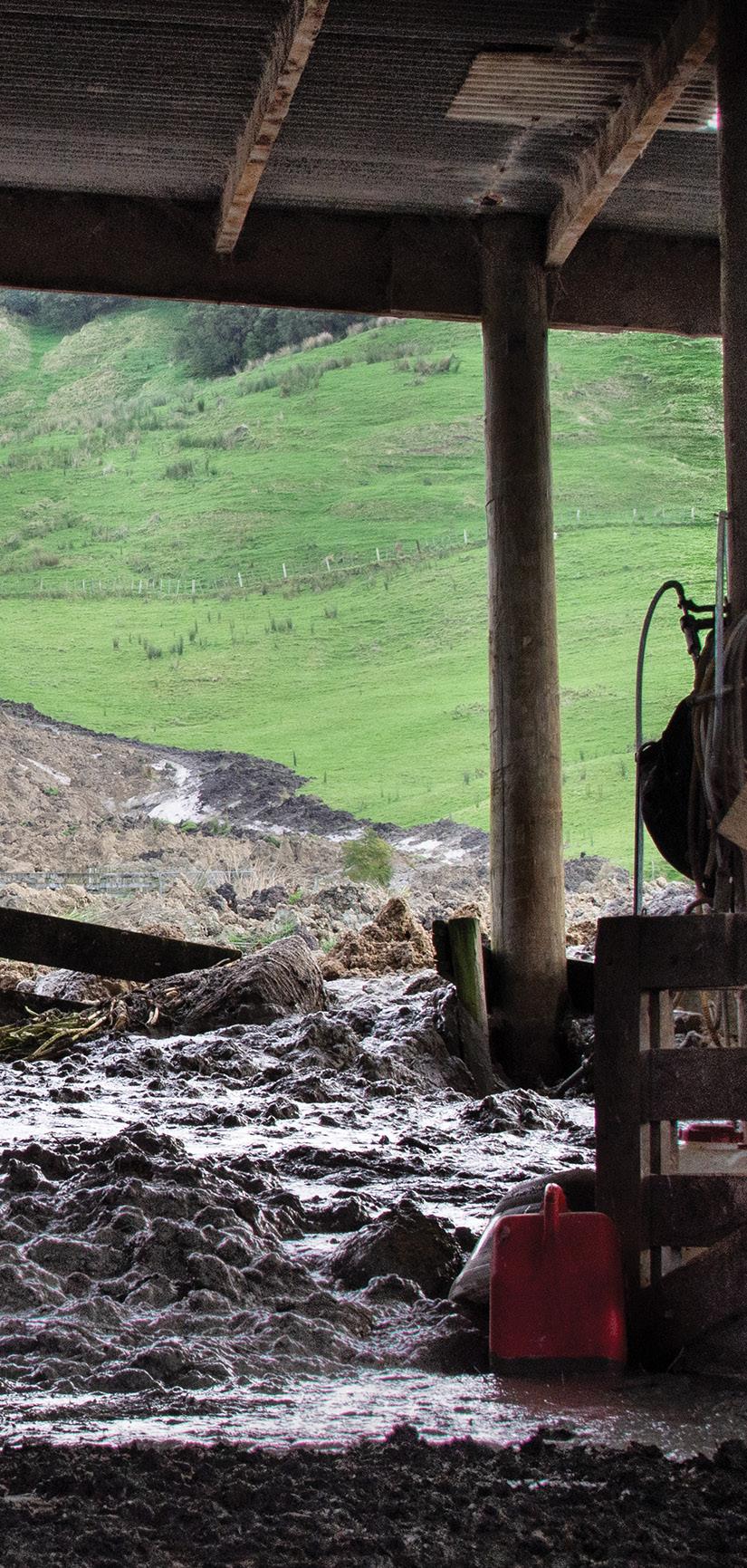
The Gisborne cemetery is also on Te Hapara sands aquifer. There haven’t been any burials for many months. I was told many years ago that if looking to buy a property, choose one on the same soil type as your local cemetery, as that’s a guarantee of the freest-draining soil around.
Yeah right.
Country-Wide | AUGUST/SEPTEMBER 2023 117 SOCIAL
PHOTOS BY LOUISE SAVAGE
MAKING CONNECTIONS WITH WOOL
The Campaign for Wool New Zealand (CFWNZ), tasked with advancing strong wool education, promotion and advocacy, has unveiled a new online portal and updates to the Wool in Schools programme.
General manager – advocacy Tom O’Sullivan says the digital partner portal, housed on the CFWNZ website, allows wool manufacturers, businesses, brands and supporters access to verified consumer and
market research, a library of professional photography, business templates, a growing directory of wool industry contacts and a range of other resources.
As a not-for-profit organisation, CFWNZ uses the $1000 annual subscription fee charged to users of the portal to develop and expand its initiatives and programmes. This, in turn, supports NZ’s strong wool industry and wool growers, as signalled in its three-year strategy,
published late last year, O’Sullivan says.
One CFWNZ programme is the Wool in Schools initiative. This year, with co-funding from the Ministry for Primary Industries’ Sustainable Food and Fibre Futures fund, the two shipping containers that travel to primary schools around the country have been substantially renovated, and the educational resources that travel with the containers fully digitised.
Hastings-based educators Digital Circus were tasked with making learning materials more accessible to container visitors. Later, CFWNZ plans to make these resources available to schools across NZ, irrespective of whether it’s convenient to book a Wool in Schools container for a visit.

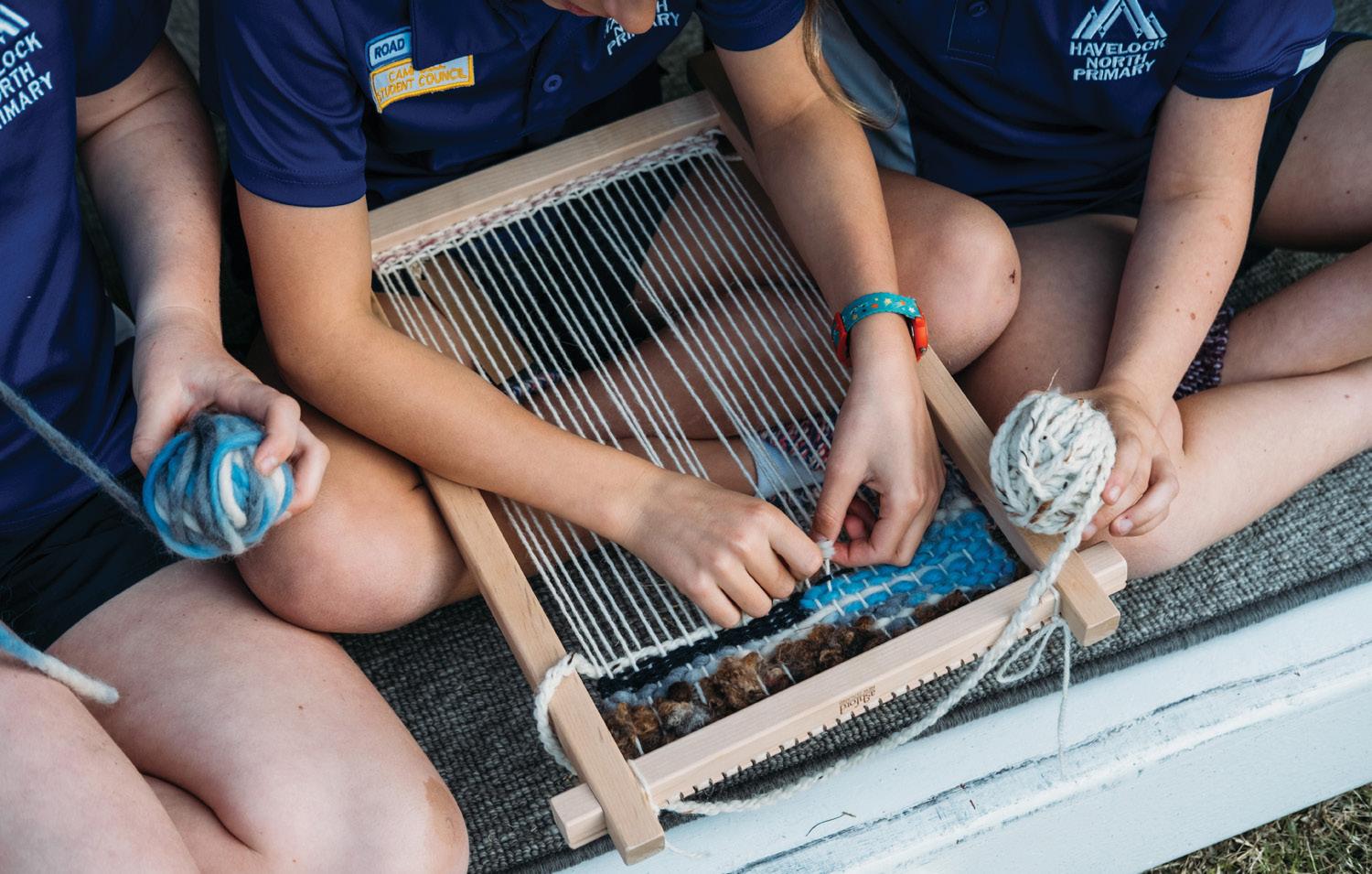
“So far, we’ve reached 30,000 students across the country, but we could impact so many more kids with our fully digitised resources, and share our messages even wider,” O’Sullivan says.
+
To learn more about Wool in Schools, access the Partner Portal or make a donation, go to nzwool.co.nz/
118 Country-Wide | AUGUST/SEPTEMBER 2023
SOCIAL
FARMERS RACE FOR A CAUSE
BY ANNABELLE LATZ
An agricultural pilot and three farmers, collectively called the Gizzy Gully Runners, had a promise to honour. They were competing in the 12-stage Godzone Adventure Race, trekking, packrafting, mountain biking and kayaking 550km from Te Anau in Fiordland to Riverton in Southland, navigating their way with just a map and compass.

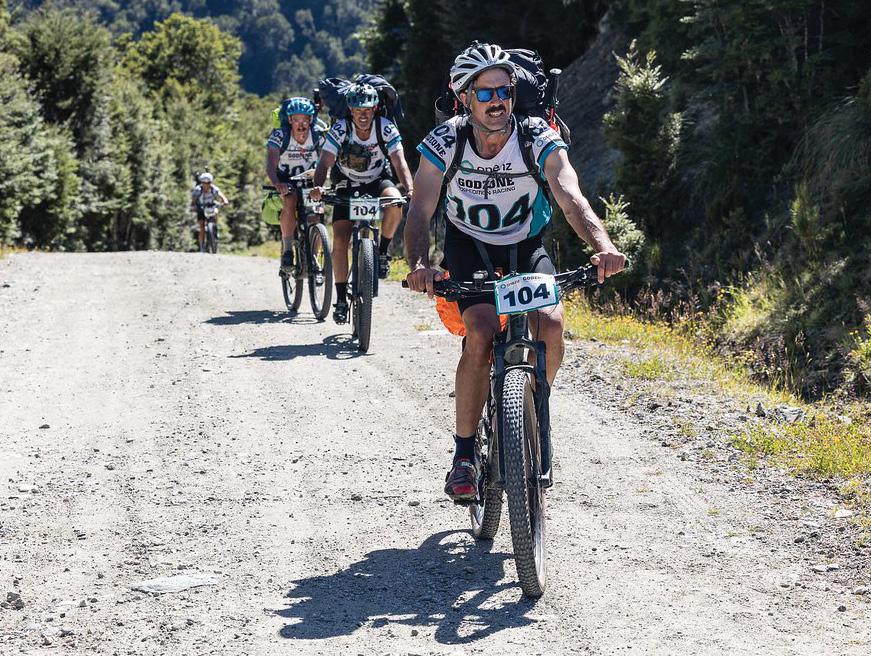
Despite the damage to their farms, exhausted and emotionally drained, Pete Blake, Chris Cave, George Williams and Caroline MacLaurin with their three support crew of Chris Fraser, Chris Williams and Ray Blake made their way south just a week after the cyclone.
The Gizzy runners were raising money for Hear4U through their Give A Little page, a Gisborne-based charitable trust which, since its inception in 2002, has raised tens of thousands of dollars for mental health, wellbeing and suicide prevention.
The $6000 they raised by competing in the Godzone race was directly used to help ease the mental strain in the Gisborne community by providing funds for care packs and essential food after Cyclone Gabrielle.
But how it all began was back in 2019 when Chris Fraser and her husband Dan’s 21-year-old son Toby took his own life. During the aftermath, Chris knew of a local woman, Krissy Mackintosh, who made wreaths from bunches of flowers, and that was the start of a special friendship that created Hear4U.
“Everywhere Krissy went she knew people who knew Toby,” Chris said. “She’d see young guys in tears in the supermarket. Toby was bubbly and bright and vivacious. It was an enormous shock to everybody.”
Krissy Mackintosh has endured her own battles with mental health and by the age of 30 had lost 10 friends to suicide, predominantly rural men.
“When I heard about Toby, I thought enough is enough; it’s going
to happen more and more if we let it happen.”
Hear4U offers a counselling service, transport and in-person support to appointments, encourages sport and recreation, and complements similar movements like Surfing for Farmers.
She says the main issues for men’s need for mental health support are environmental, political and financial, the detachment happening between husbands and wives because of farm life pressures, the isolating factors and the ever-increasing red tape requirements.
“It’s about breaking down the stigma, creating events and projects. We create the environment first, providing them the opportunity to open up and talk.
“I tell these rural men they are not getting off the farm enough. You can’t have gratitude when you are stuck in the same place doing the same thing.”
Country-Wide | AUGUST/SEPTEMBER 2023 119
+ www.hear4utrust.com/
The finish line in Riverton for Godzone Adventure Race. From left: Chris Cave, Peter Blake, George Williams and Caroline Maclaurin.
SOLUTIONS
SOUTH ISLAND MAIZE DELIVERS
Higher and more consistent crop yields are driving the increased use of maize silage as a supplementary feed option across the South Island.
Maize silage has been grown in the South Island for more than 30 years.
Typically, South Island maize silage crops achieve yields of 20–26 tonnes of drymatter per hectare (t DM/ ha). In the 2022/23 growing season, a maize hybrid trial just south of Timaru topped the country, averaging 30.14t DM/ha and with the top hybrid achieving 36.01t DM/ha.
Several factors have led to the increase in South Island maize. These include a warming climate, new maize genetics, changing environmental regulations, challenges to water availability and a desire to build more nitrogen (N) efficient farm systems.
The warming climate characterised by fewer frosts, and the commercial release of new, short maturity maize
hybrids, has opened up opportunities for growing maize silage throughout the South Island.
Recent favourable growing seasons have resulted in several successful maize silage crops grown in south Otago and into Southland. Maize grain has also become a viable option in Canterbury and further north. It produces reliable yields of high-value grain and is more disease-resistant than most cereals, providing a great addition to the cropping rotation. Changes to environmental regulations, particularly in relation to reducing intensive winter grazing, have changed South Island wintering systems. Maize silage has emerged as a sustainable alternative.
Use of off-paddock feeding facilities has enabled dairy farms to successfully integrate maize silage as a large proportion of the winter diet. Feeding maize silage as an alternative to a winter crop helps protect soils, reduces N leaching and
increases animal welfare.
Many South Island farmers have access to irrigation, which takes the risk out of critical times of year (e.g. during tasselling) when maize needs consistent moisture to achieve high yields. Moreover, maize has a deep rooting structure and is extremely water-use efficient. Compared to other plants such as cereals or ryegrass, maize has the potential to grow more drymatter per unit of water applied.
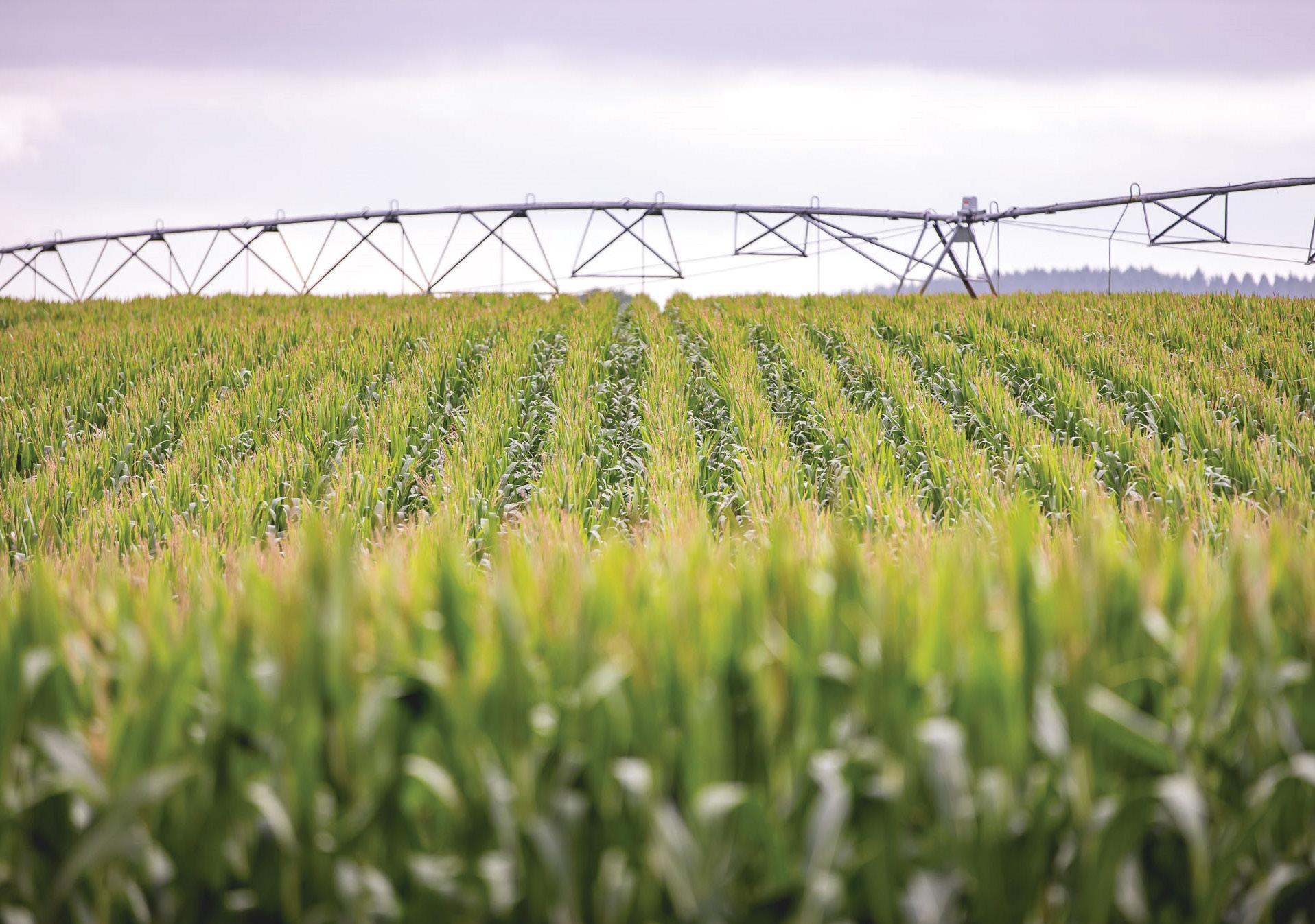
Maize silage grown according to best management practices can minimise nitrogen (N) loss and enhance environmental sustainability. Pioneer brand maize conducted a series of experiments to measure N loss to water. These showed a maize crop followed by a winter catch-crop resulted in minimal nitrate-N loss, while losses were higher with winter fallow (no winter crop) systems.
Research has shown that feeding maize silage – a low crude protein feedstuff – dilutes dietary nitrogen levels, subsequently reducing the nitrogen content of livestock urine. By harnessing these proven benefits of growing and feeding maize silage, farmers can significantly reduce the N impact of their dairy systems.
Good crop management practices should be followed to ensure growers reap the economic and environmental benefits of maize. Maize is reliant on heat to progress through its growth stages.
Selecting the right hybrid maturity is a key element of maize growing success, especially in the South Island where heat unit accumulation is lower than for the North Island.
• Supplied by Genetic Technologies.
For more visit pioneer.co.nz
120 Country-Wide | AUGUST/SEPTEMBER 2023
SOLUTIONS
A SLIMY SEEDLING STEALER
Slugs, Gerard McCarthy reckons, are an underestimated pest.
Fortunately, the experienced technical field representative at PGG Wrightson in Cromwell, South Otago, was on hand when trouble struck.
In Central Otago, 45 hectares of highvalue SovGold Ultrastrike-treated kale seedlings were attacked. With average yields of about 10-14 tonnes drymatter (DM)/ha, and suitable for both cattle and sheep grazing, it was a crop the farmer was keen to protect.
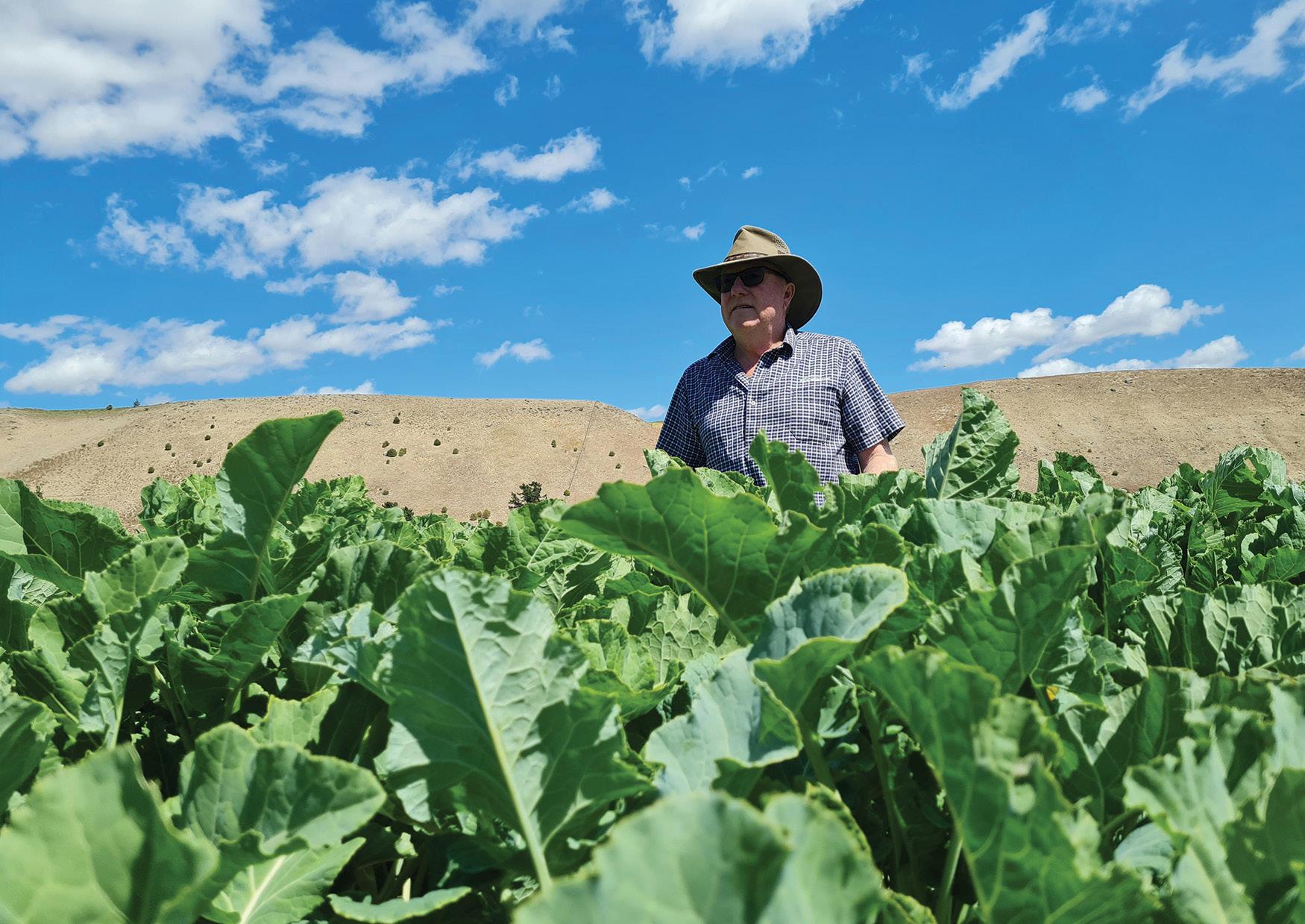
Solution? Ironmax Pro molluscicide, from UPL NZ, was spread by helicopter at 6kg/ha.
Gerard says it made an extremely good job and supported the crop getting well established. “The client rang me three days later. They saw an almost instant result.”
Manufactured by French company DeSangosse, global leader in molluscicides, Ironmax Pro is as effective as sister product, industry leader, Metarex Inov. But with serious environmental chops.
UPL NZ regional sales manager Upper North Island Pieter Van Der Westhuizen says organic accreditation means a lot.
“There’s demand for products safer for the environment without compromising efficacy. Grey field slugs have the potential to wipe out crops. They cause damage across a range of plants and are tough on seedlings. You really need to look for slugs. Monitor and measure!”
Pieter advises using a slug mat or damp hessian sack. “Leave it overnight and check next morning. Even one slug may signal a problem.” Slugs can produce 300 eggs in their 13-month lifespan.
Attractive to slugs due to Colzactive (an attractant made of rape seed extracts) Ironmax Pro’s optimised active, 24.2g/kg ferric phosphate anhydrous, is a natural component of soil. In Ironmax Pro, it works as a stomach poison – impacting vital organs and is fatal to slugs and snails.
For more visit www.upl-ltd.com
Over several seasons Headstart has become a trusted option for broadleaf weed control in pasture, clover, clover seed crops, lucerne and chicory.
Now it can be used for applications in new crops of ryegrass and clover at any time after planting, and in cereals (wheat and barley) any time after planting up to the end of tillering.
Pre-emergence applications of Headstart are effective for early weed control, even before weeds emerge. This gives growers options to go earlier than normal, providing a longer spray window. It is particularly effective on more difficult weed species which require earlier intervention for best control.
It is therefore not necessary to wait for a specific growth stage in the crop to ensure adequate crop safety, as is the case with other herbicides. This is especially important in situations where there are mixed crop emergences within the paddock, but the weeds are up and growing fast.
Headstart Oleo formulation is based on the highly effective systemic active flumetsulam, which is rapidly taken up in the roots and foliage of target weeds. Registered tolerant crop species metabolise this active, rendering it safe.
Arxada’s in-house formulation team developed Headstart in New Zealand. It is based on Arxada’s patented Oleo technology as an oil-dispersion adjuvant-ready liquid formulation.
Country-Wide | AUGUST/SEPTEMBER 2023 121
Visit arxada.co.nz/contact. THE ULTIMATE HEADSTART

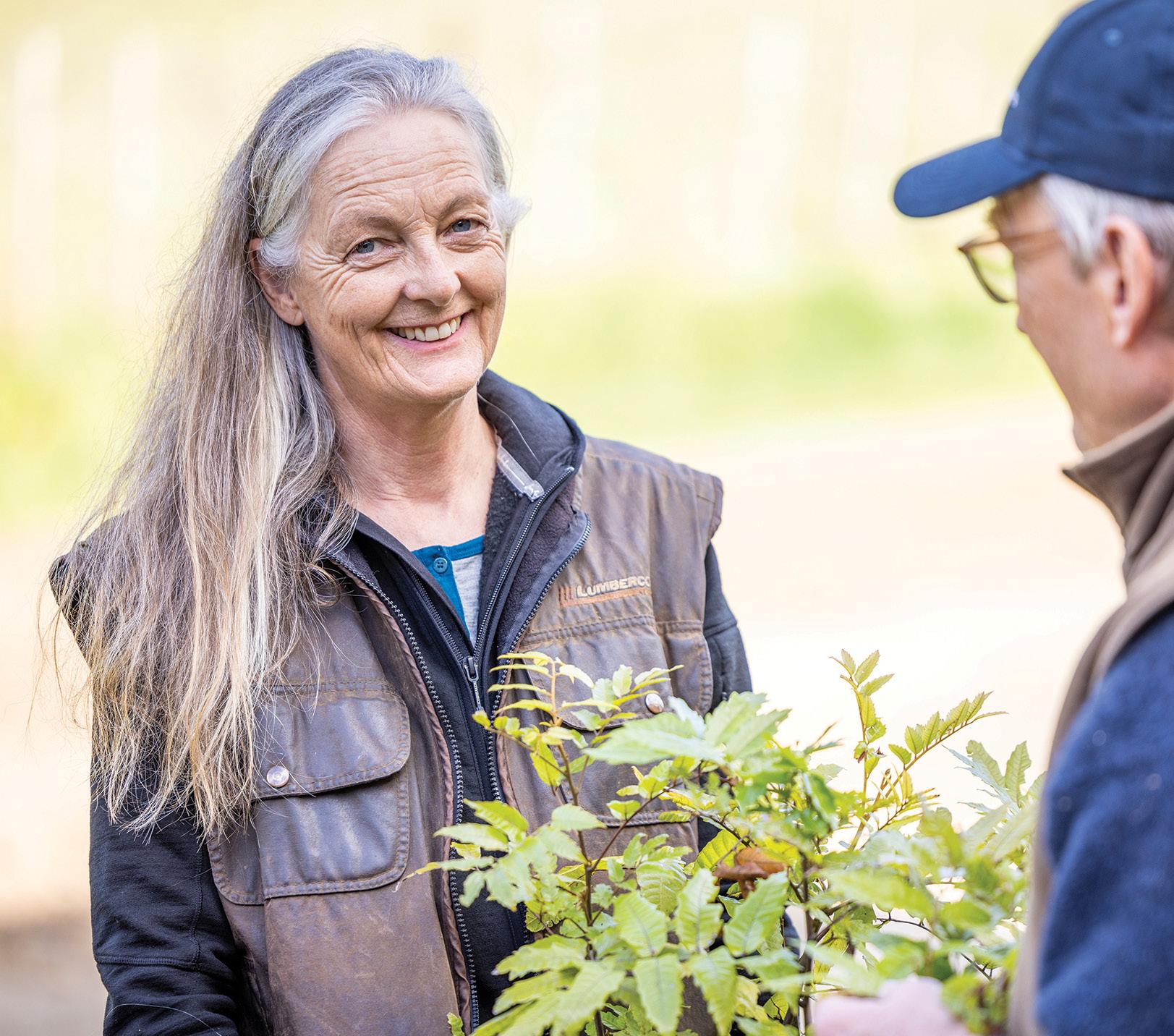
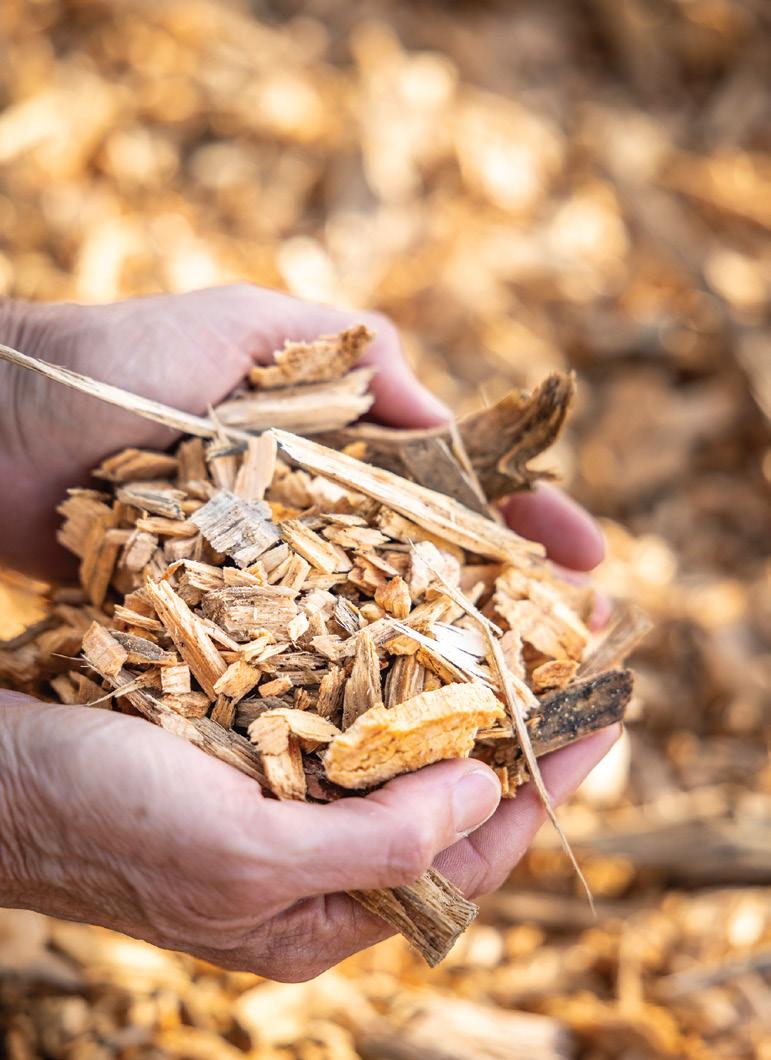
122 Country-Wide | AUGUST/SEPTEMBER 2023
FARMING IN FOCUS
From top left: Shirley-Ann and Rick Mannering inspect native seedlings raised on their Waytemore farm south of Auckland. Top right: Home-cut wood chips for stock bedding. Bottom: Yearling heifers on Waytemore.
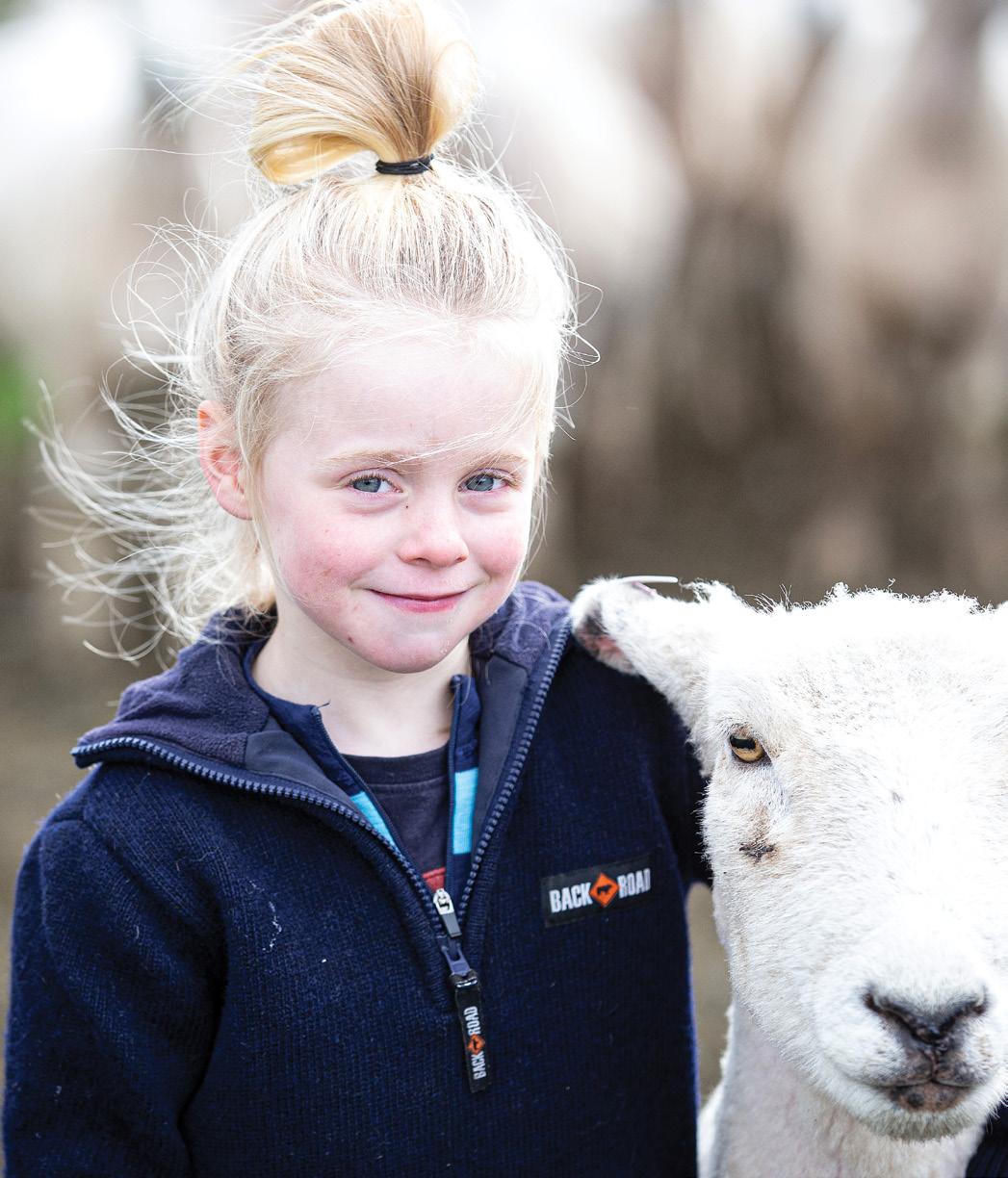
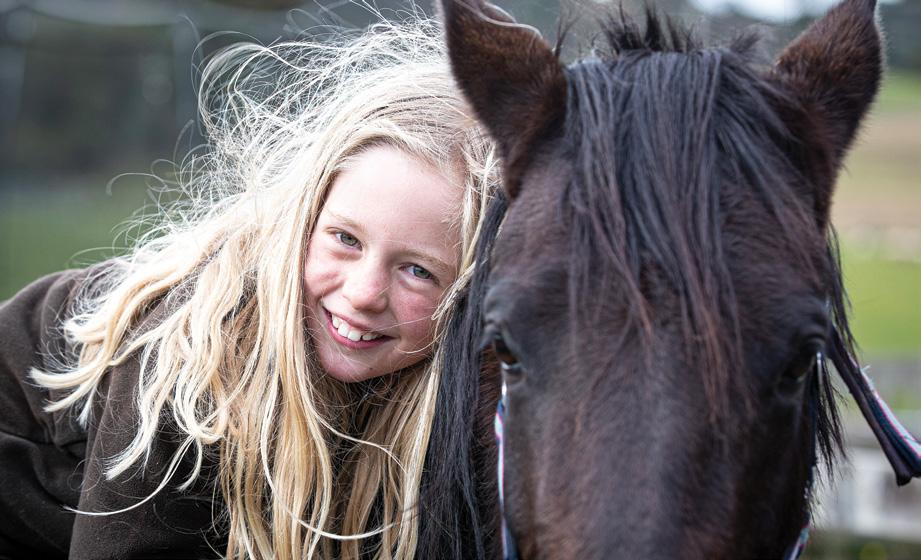
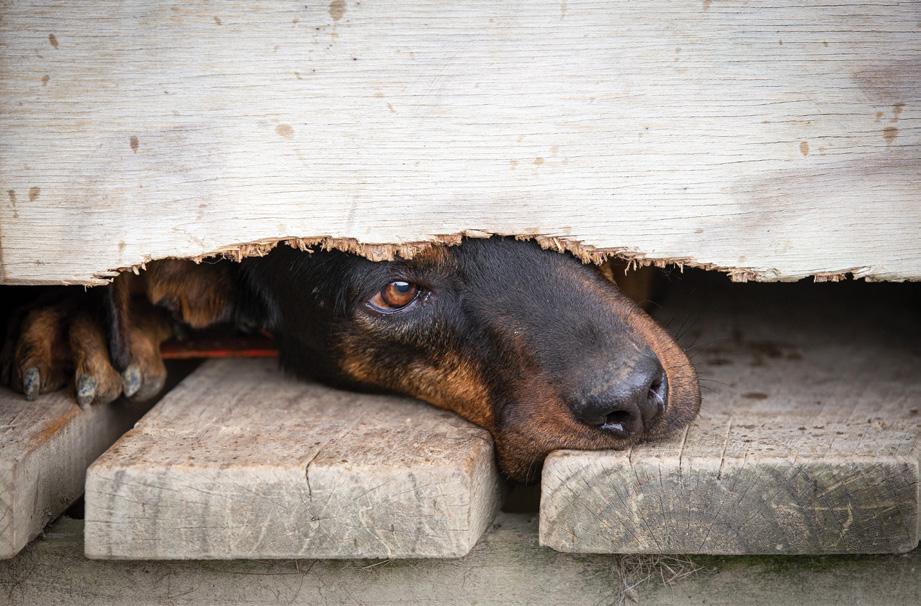

Country-Wide | AUGUST/SEPTEMBER 2023 123
Top left: Derek and Leanne White’s youngest daughter Jess (4) on their Waiouru sheep farm. Top right: A dog’s life. Middle right: Kate (9) with her horse. Bottom: Derek, James, Kate, Jess and Leanne White among toe toe and sedges in riparian planting on their farm which won Wairere Central Districts Red Meat Farm Business of the Year 2023.
MATRIX® Hi-Mineral is back in stock this season, providing a convenient and effective all-in-one triple active sheep drench for your stock.
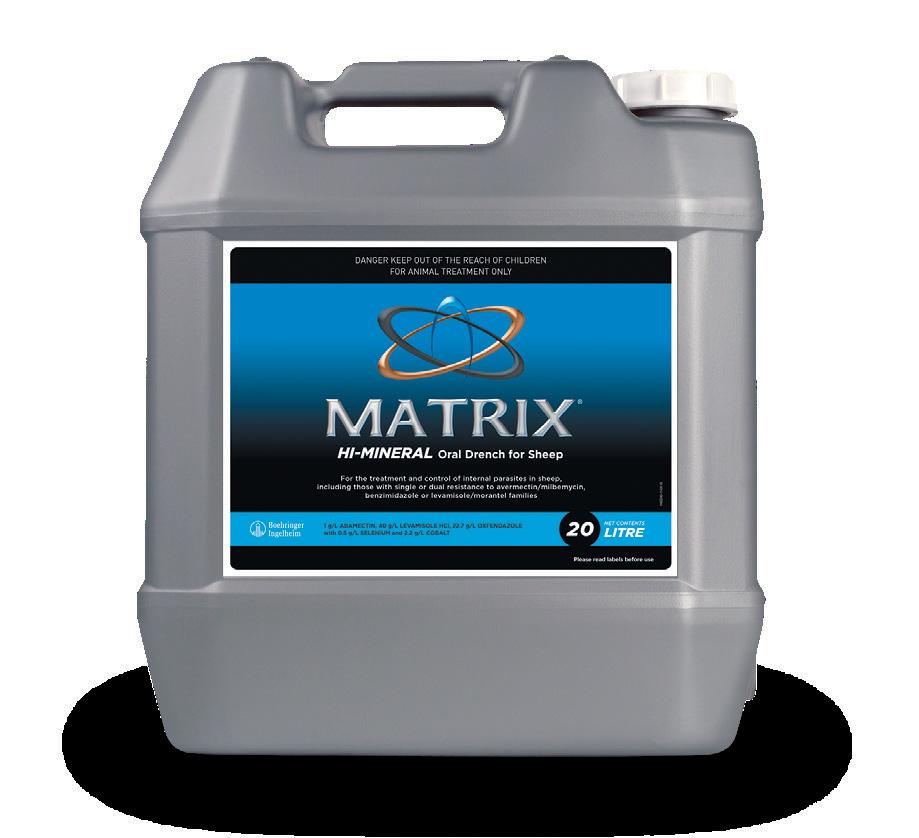
For more information, talk to your vet or visit: futureproducers.co.nz


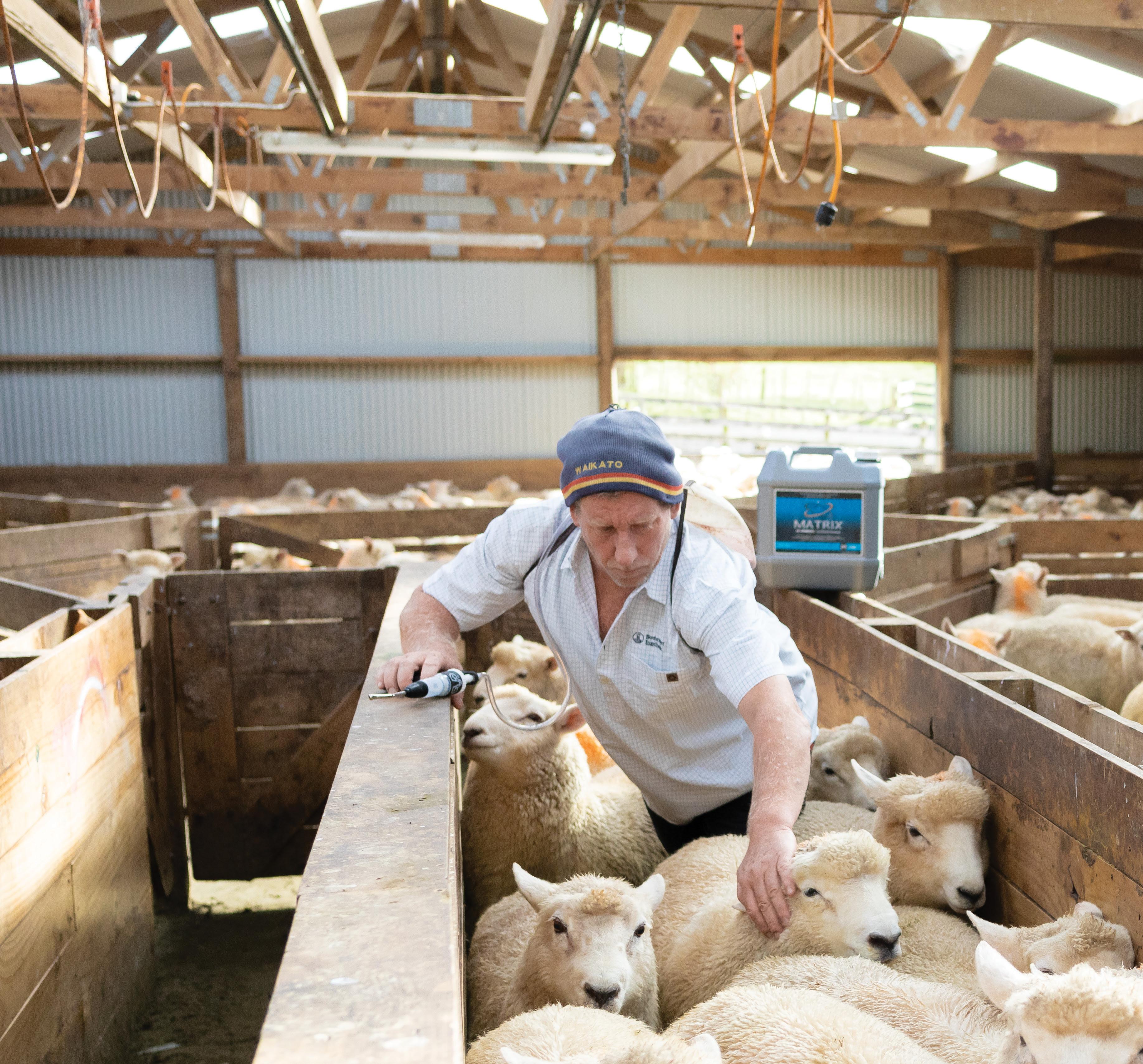
PROUDLY AVAILABLE FROM YOUR LOCAL PARTICIPATING VETERINARY CLINIC. See product label for full claim details and directions for use. Boehringer Ingelheim Animal Health New Zealand Limited. Level 3, 2 Osterley Way, Manukau, Auckland, New Zealand. MATRIX® is a registered trade mark of Boehringer Ingelheim Vetmedica GmbH, used under license. Registered pursuant to the ACVM Act 1997. No’s A009390. © Copyright 2023 Boehringer Ingelheim Animal Health New Zealand Limited. All rights reserved. NZ-OVI-0004-2023. Receive a FREE * Degree Horizon Shirt, with every 20 Litre of MATRIX® Hi-Mineral. *While stocks last.

























































































































































 Derek White walks out a line of standards in his winter crop.
Derek White walks out a line of standards in his winter crop.










































































































 by Annabelle Latz.
by Annabelle Latz.

















































